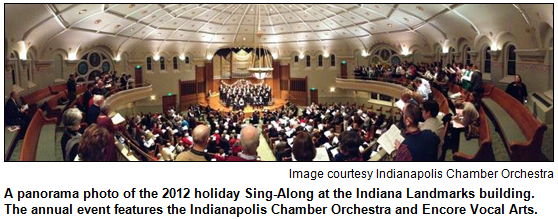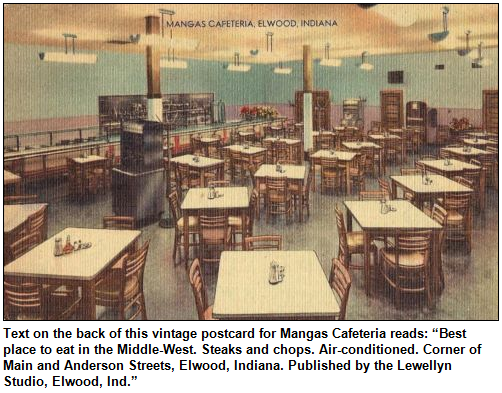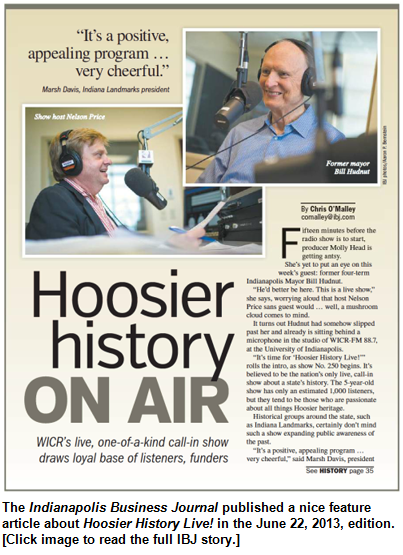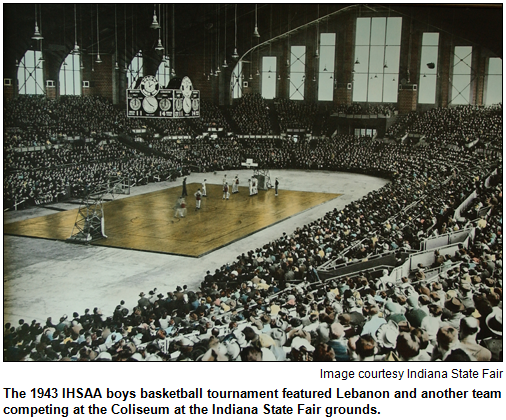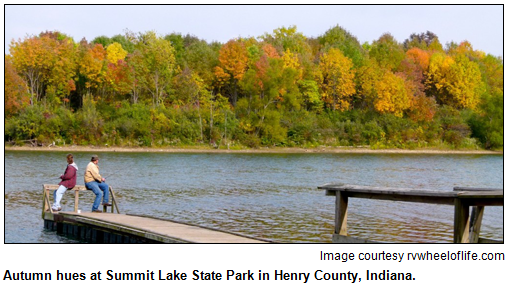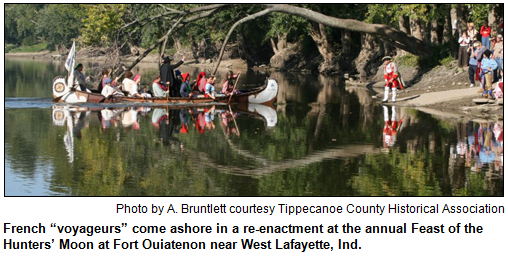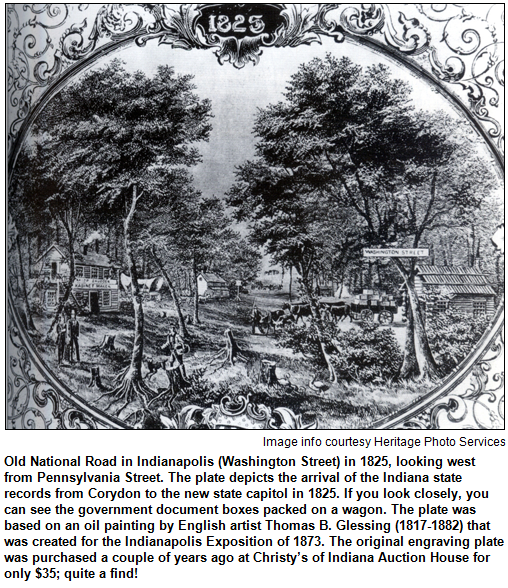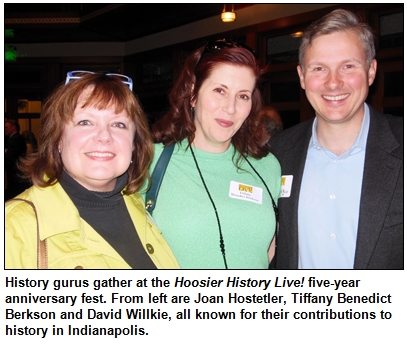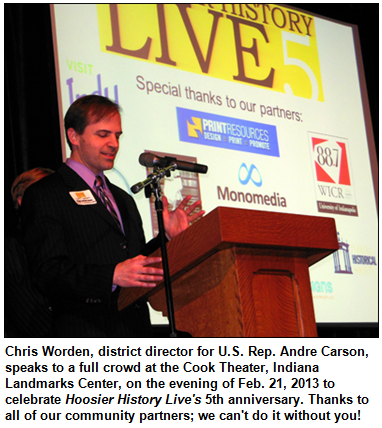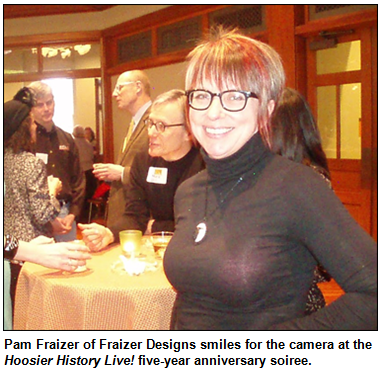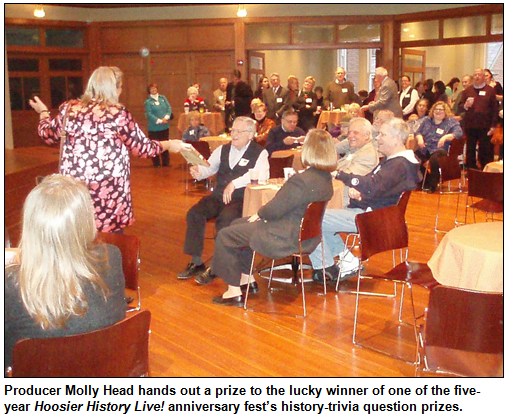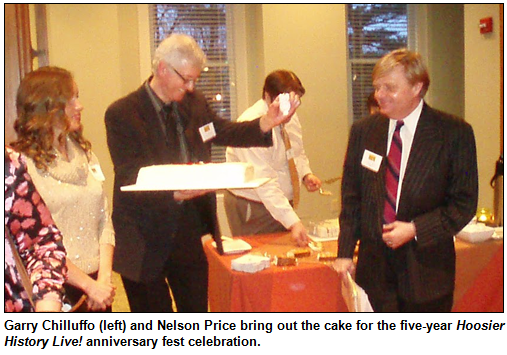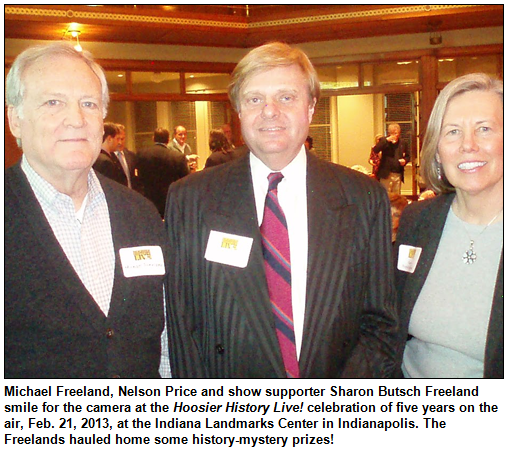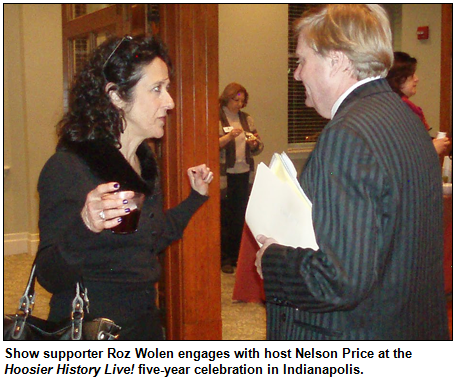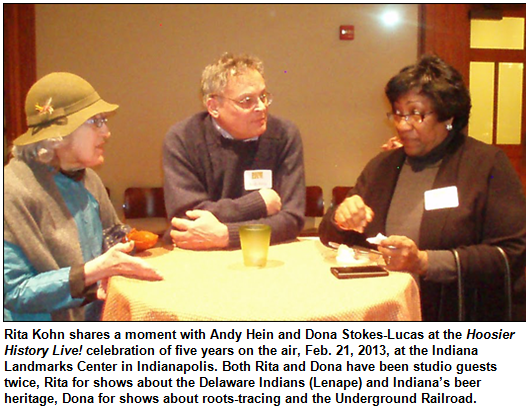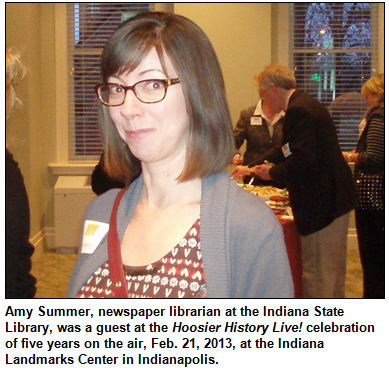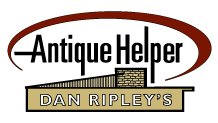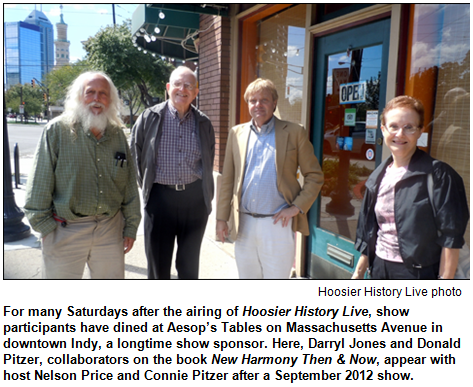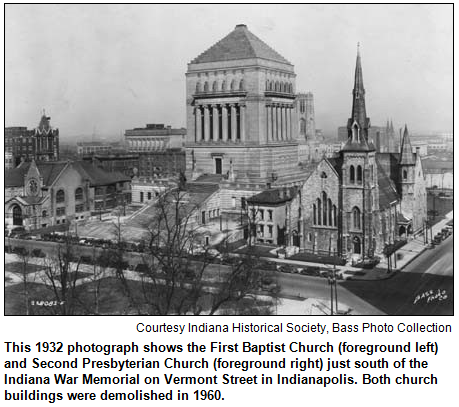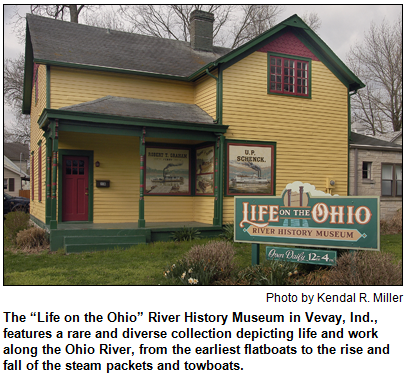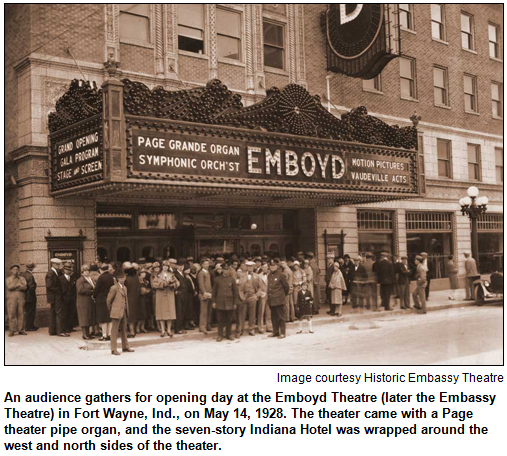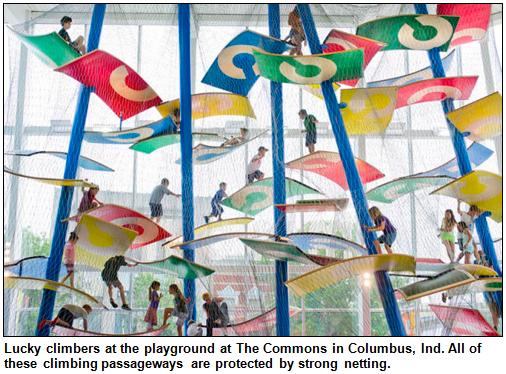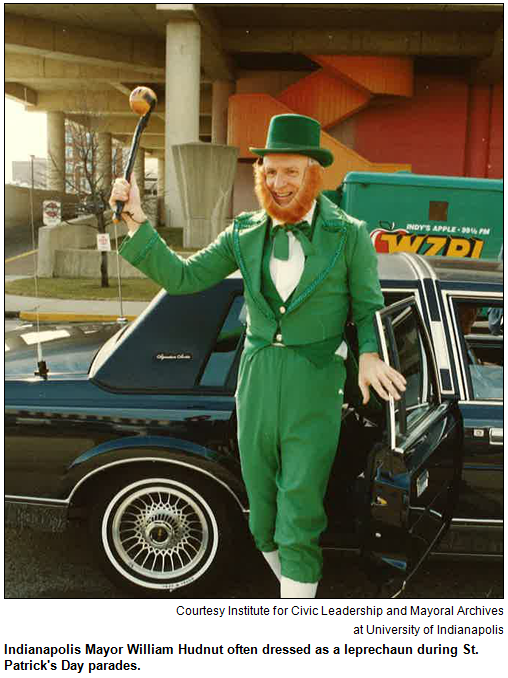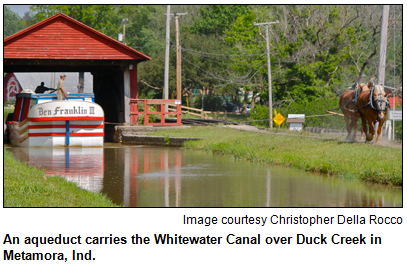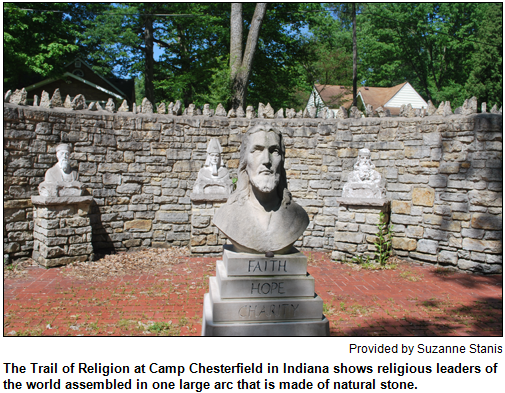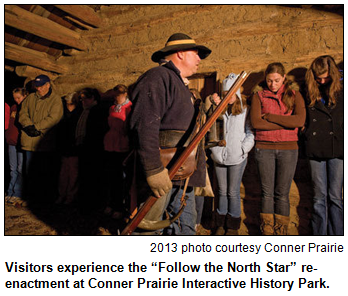Home | About us | Support the show | Contact us | Archives | Listen
2018 | 2017 | 2016 | 2015 | 2014 | 2013 | 2012 | 2011 | 2010 | 2009 | 2008
Archives - 2013
Union Station history in Indy and Political cartoon heritage: Two classic shows
(Dec. 28, 2013 - encore presentations) - For generations of Hoosiers traveling by rail, Union Station in Indianapolis was at its bustling peak during holiday seasons. And iconic images created by political cartoonists (albeit non-Hoosiers) have included Santa Claus and Uncle Sam.
So as a holiday season treat, Hoosier History Live! will broadcast encore shows focusing on those two topics. Instead of a one-hour program, you can enjoy two back-to-back, half hour shows from our archives of more than 270 programs in nearly six years of covering all aspects of our Hoosier heritage.
Union Station history in Indy
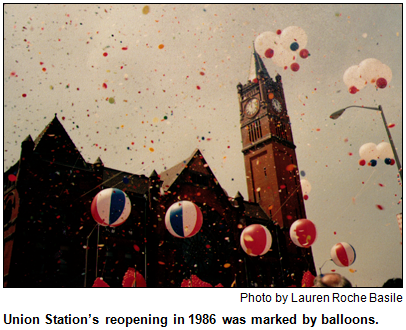 During the first classic show (original air date: March 3, 2012), we explore an aspect our heritage that became a national "first." For the first time in American history, railway lines came together in a single central Indiana train depot, the country's first "union" station. It happened in Indy in 1853, six years after the first railroad reached the Hoosier capital.
During the first classic show (original air date: March 3, 2012), we explore an aspect our heritage that became a national "first." For the first time in American history, railway lines came together in a single central Indiana train depot, the country's first "union" station. It happened in Indy in 1853, six years after the first railroad reached the Hoosier capital.
The opening of Union Depot helped account for explosive growth in Indy and the city's longtime "Crossroads of America" nickname. In the 1880s, the initial depot was replaced by a nearby, majestic Union Station designed in Romanesque Revival architectural style with elegant Rookwood tiles in its interior and a 185-foot clock tower that became a city landmark.
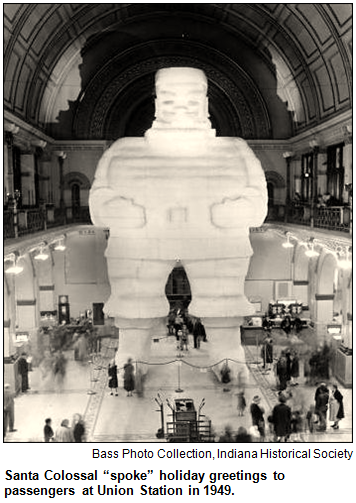 To discuss the history of the station listed on the National Register of Historic Places - as well as the impact of the railroads on Indy - Nelson is joined in studio by architectural photographer Garry Chilluffo of Chilluffo Photography. Garry, who often is a commentator on tours of the station, also is the corporate photographer for Crowne Plaza Union Station.
To discuss the history of the station listed on the National Register of Historic Places - as well as the impact of the railroads on Indy - Nelson is joined in studio by architectural photographer Garry Chilluffo of Chilluffo Photography. Garry, who often is a commentator on tours of the station, also is the corporate photographer for Crowne Plaza Union Station.
.
Today the historic train shed houses a Crowne Plaza luxury hotel, and the restored grand hall is a ballroom, with rooms in the former concourse serving as convention meeting rooms. Hotel guests may stay in historic Pullman cars that have been converted to suites and named after famous people who traveled through the train station, such as Winston Churchill, Cole Porter and Amelia Earhart.
During the show, Garry shares insights about how train travel initially was considered unsafe - with good reason. Even so, its popularity soared, with Indy serving as a major cross-country hub.
Fun holiday history fact: During the late 1940s, a 51-feet-high Styrofoam replica of Santa Claus - known as "Santa Colossal" - was positioned in the train terminal to greet passengers. Santa Colossal "spoke" yuletide greetings and was so popular that postcards with his image were handed out at Union Station for years afterward.
Political cartoon heritage with Gary Varvel
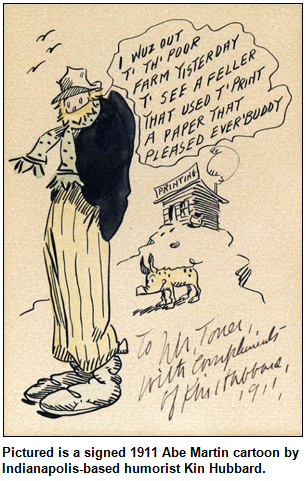 Whether creating visual commentary about tragedies such as the 9-11 terrorist attacks or creating mythical characters such as Brown County's cracker-barrel philosopher Abe Martin and whimsical Raggedy Ann, Hoosier political cartoonists have been at the cultural epicenter.
Whether creating visual commentary about tragedies such as the 9-11 terrorist attacks or creating mythical characters such as Brown County's cracker-barrel philosopher Abe Martin and whimsical Raggedy Ann, Hoosier political cartoonists have been at the cultural epicenter.
To explore the rich heritage of political cartooning - including images that range from lighthearted to poignant to controversial - Nelson is joined in studio on this classic show by Gary Varvel, the award-winning political cartoonist for The Indianapolis Star. (This classic show's original air date was Aug. 13, 2011.) Gary, whose work is syndicated to more than 100 newspapers through Creators Syndicate, has created dozens of images that have made readers' blood boil, provoked them to laugh or inspired them to think.
During the show, Gary explains the derivation of Santa Claus as a newspaper cartoon character.
Nelson and Gary also explore the impact of Abe Martin, the fictional character (sample quip: "You can take a voter to the polls, but you can’t make him think") created in 1904 by Indianapolis News cartoonist Frank McKinney "Kin" Hubbard (1868-1930). His homespun wisdom became enormously popular across the country.
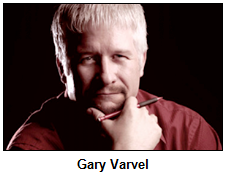 As for Gary, his best-known cartoon probably has been one drawn in reaction to the terrorist attacks on Sept. 11, 2001. A depiction of a weeping Uncle Sam holding a limp firefighter while the smoldering skyline of New York City crumbles in the background, the cartoon resulted in requests for copies from thousands of readers. The Star printed his 9-11 cartoon as a poster for sale and raised $130,000 for relief efforts in New York.
As for Gary, his best-known cartoon probably has been one drawn in reaction to the terrorist attacks on Sept. 11, 2001. A depiction of a weeping Uncle Sam holding a limp firefighter while the smoldering skyline of New York City crumbles in the background, the cartoon resulted in requests for copies from thousands of readers. The Star printed his 9-11 cartoon as a poster for sale and raised $130,000 for relief efforts in New York.
As for Raggedy Ann: The book series and dolls were created by former Indianapolis Star cartoonist Johnny Gruelle (1880-1938), who grew up near the Lockerbie neighborhood in Indy. Names and traits of his famous creation were inspired by blending two of his favorite James Whitcomb Riley poems: "The Raggedy Man" and "Little Orphant Annie."
Victorian-era and ethnic holiday traditions
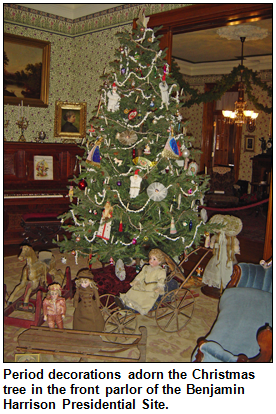 (Dec. 21, 2013) - Buckle up for a time-traveling sleigh ride with Hoosier History Live! as we explore holiday traditions of earlier eras - as well as yule-season and new year customs brought to this country by various ethnic heritage groups.
(Dec. 21, 2013) - Buckle up for a time-traveling sleigh ride with Hoosier History Live! as we explore holiday traditions of earlier eras - as well as yule-season and new year customs brought to this country by various ethnic heritage groups.
Did your family or ancestors ever set out a pair of shoes for St. Nick? That footwear-shuffling Christmas season tradition was an Eastern European custom.
Ever wonder about the evolution of holiday greeting cards and what they would have been like during the Victorian era? An immigrant from an ethnic heritage group started the mass printing in America of holiday cards during the 1870s. (You will have to tune in to learn details.)
To share insights about ethnic immigration holiday traditions - cherished, bygone or transformed in various ways - Nelson is joined in studio by a diverse group of guests. They also share insights about folk traditions associated with the holidays during the Victorian and Edwardian eras stretching from the mid-1800s through the early 1900s.
Nelson's guests are:
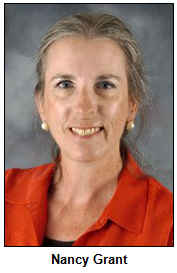 Nancy Grant, a journalist, photographer and speaker based in Louisville. During her career, Nancy has written about a wide range of topics, including the history behind some of the most popular Christmas traditions. Her book Christmas in America (1991) described the evolution of greeting cards, holiday trees decorated with lights and other traditions.
Nancy Grant, a journalist, photographer and speaker based in Louisville. During her career, Nancy has written about a wide range of topics, including the history behind some of the most popular Christmas traditions. Her book Christmas in America (1991) described the evolution of greeting cards, holiday trees decorated with lights and other traditions.- Olga Imperial Keegan of Carmel, whose parents immigrated from the Philippines. A past president of the Association of International Women, Olga is a real estate agent and mother of four. She also has been a volunteer host for the International Center of Indianapolis.
- And Rosaleen Crowley, a Carmel-based artist and poet who immigrated from Ireland in 1990. A painter, Rosaleen has just opened Roscro & Co., a new studio in Carmel, and has had a long career in education, speech and drama. She is a graduate of the National University of Ireland and the London College of Music. For 10 years, she owned a business that helped families adjust to their new communities and adapt to their host culture.
The Christmas and New Year's traditions that we explore range from festive to poignant.
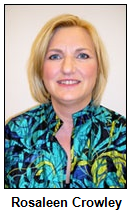 According to Rosaleen, Irish families on New Year's Day often set a place at the table in remembrance of those who have died.
According to Rosaleen, Irish families on New Year's Day often set a place at the table in remembrance of those who have died.
She also describes an Irish twist on the seasonal "kissing under the mistletoe" tradition: On New Year's Eve, some single Irish women slip mistletoe under their pillows. That means they will meet their future husbands during the new year, according to folklore.
Our guest Nancy Grant, whose areas of expertise include energy technology (she writes a monthly “Future of Electricity” column for Kentucky Living magazine), reports that the tradition of putting lights on holiday trees began in 1882.
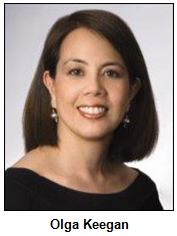 Fun fact: As regular listeners of Hoosier History Live! - or visitors to the Benjamin Harrison Presidential Site - may recall, the only American president elected from the Hoosier state has a yule-season claim to fame. Benjamin Harrison (who served from 1888 to 1892) and First Lady Caroline Scott Harrison became the very first First Family to have a decorated Christmas tree in the White House.
Fun fact: As regular listeners of Hoosier History Live! - or visitors to the Benjamin Harrison Presidential Site - may recall, the only American president elected from the Hoosier state has a yule-season claim to fame. Benjamin Harrison (who served from 1888 to 1892) and First Lady Caroline Scott Harrison became the very first First Family to have a decorated Christmas tree in the White House.
We explored this aspect of their heritage during a holiday season show in 2011 with Jennifer Capps, curator of the presidential site. During the show, Jennifer noted that President Harrison, who had a beard and a slightly stocky frame, portrayed Santa on at least one occasion.
During this show, our guest Olga Kenner describes a five-pointed star that Filipino families often place on their front doors (similar to the way Americans hang wreaths) during the Christmas season.
Noting that the Philippines was under Spanish rule for generations, Olga estimates about 80 percent of the population in her ancestral homeland is Catholic. That means many Filipino traditions, including attending midnight Mass on Christmas Eve, derive from Spanish and/or Catholic traditions.
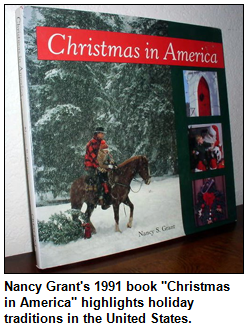 "When I was a girl, we would go to midnight Mass, then come home and there would be our presents," Olga said. "It was late in the evening, but we would open the gifts right then, not wait until morning."
"When I was a girl, we would go to midnight Mass, then come home and there would be our presents," Olga said. "It was late in the evening, but we would open the gifts right then, not wait until morning."
Also during our show, Nancy Grant describes how enterprising merchant F. W. Woolworth began importing glass ornaments from Germany in 1880. Then he sold them across the country.
The Eastern European tradition of setting out shoes happens on Dec. 6, St. Nick's Day.
Our guest Rosaleen, who also is a member of the Association of International Women, describes Irish activities related to St. Stephen's Day (Dec. 26), setting a table with "Christmas crackers" and what typically happens on the Feast of Epiphany (Jan. 6).
Nancy Grant is convinced that various Christmas aromas from the kitchen provide clues about a family's ethnic heritage. Cinnamon: maybe British for figgy pudding. Licorice or anise: German for springerles. Also in terms of seasonal goodies, Olga describes the variety of home-made sweets that Filipinos typically serve this month.
Roadtripper: Jeffersonville
Guest Roadtripper and public historian Glory-June Greiff tells us that it doesn't have to be Christmas time to head to Schimpff's Confectionery in Jeffersonville (347 Spring Street), a candy store, soda fountain, and lunch counter that is more than 120 years old! (Jeffersonville is, of course, just across the Ohio River from Louisville.)
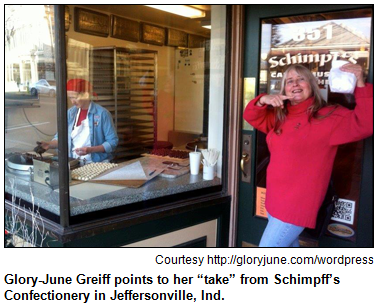 But at Christmas especially, Schimpff's is a fantasy land filled with jars and glass cases of its yummy candy. You can even watch them making it in the adjoining space, which also houses their candy museum. After you consider your many choices of candy for gifts and a few for yourself, have an old-fashioned lunch - maybe an egg salad sandwich and a chocolate phosphate. Then take a stroll down historic Spring Street, with its many interesting shops.
But at Christmas especially, Schimpff's is a fantasy land filled with jars and glass cases of its yummy candy. You can even watch them making it in the adjoining space, which also houses their candy museum. After you consider your many choices of candy for gifts and a few for yourself, have an old-fashioned lunch - maybe an egg salad sandwich and a chocolate phosphate. Then take a stroll down historic Spring Street, with its many interesting shops.
Are needle arts your thing? There is a wonderful yarn shop with the bizarre name of Grinny Possum across the street from Schimpff's.
A little farther south is a novelty shop, with every kind of costume, favor, decoration, etc. you can possibly imagine. Horner Novelty at 310 Spring Street touts itself as the world's largest party store, and it may well be.
A few blocks north at 723 Spring Street is the new location of the Vintage Fire Museum, but currently it is open only on Fridays and Saturdays, so plan accordingly.
If all that isn't enough, not too far off to the southeast is the Howard Steamboat Museum on Market Street along the river. It's a great pile of a house with a fantastic collection of artifacts and ephemera telling the history of steamboats in general and those built in Jeffersonville in particular. It's an easy drive down I-65 from Indy to enjoy this scenic river town.
History Mystery
A nationally known department store that became associated with the holiday season had its beginnings during the 1840s in Vincennes, Indiana's oldest city. Most Americans associate the retailer with New York City, where it opened a flagship store that flourished for generations of shoppers. But the retailer's founder, a Bavarian immigrant, actually began in business with a general store in Vincennes. Eventually, he moved his business to Milwaukee, then expanded it considerably for 40 years and achieved success in other cities.
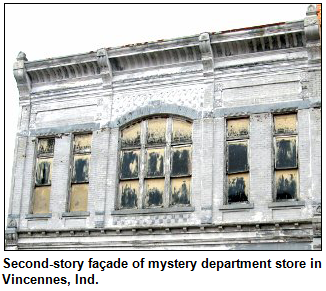 The New York City department store opened in 1910. It had a fierce, decades-long rivalry with another retailer that even became a major aspect of the plot of a classic movie with a Christmas theme. When the department store chain closed during the 1980s, it had 36 stores across the country.
The New York City department store opened in 1910. It had a fierce, decades-long rivalry with another retailer that even became a major aspect of the plot of a classic movie with a Christmas theme. When the department store chain closed during the 1980s, it had 36 stores across the country.
Question: What was the department store chain that traces its beginnings to Vincennes?
The prize is a gift certificate to the Rathskeller Restaurant in Indianapolis and two admissions to the James Whitcomb Riley Museum Home, courtesy of Visit Indy.
By request, we are publishing the answer to the last live History Mystery, in case you didn't catch it on the air. The Dec. 14 show History Mystery: What is the name of the dinosaur, which is also the first name of the paleontologist who discovered it?
Answer: SUE.
Paleontologist SUE HENDRICKSON was born in Chicago in 1949 but grew up in Munster. While working for the Black Hills Institute, Sue Hendrickson discovered the remains of a Tyrannosaurus rex on a Native American reservation in South Dakota. Now known as "Sue" in her honor, the dinosaur remains are considered to be the largest and best-preserved T-Rex ever discovered.
After the entire skeleton was assembled, it was 40 feet long from its nose to its tail. For more than 13 years, "Sue," the T-Rex skeleton, has been exhibited at the Field Museum.
Sue Hendrickson also been credited with discovering other important fossils and artifacts.
Indiana during the Ice Age, when mastodons roamed
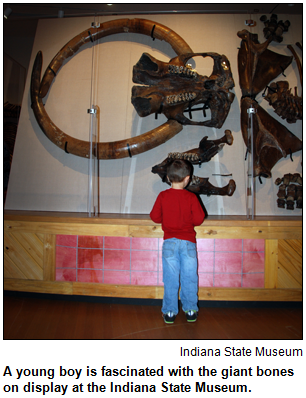 (Dec. 14, 2013) - In this show, we delve into the deepest era of Hoosier history - and the coldest.
(Dec. 14, 2013) - In this show, we delve into the deepest era of Hoosier history - and the coldest.
To explore the Ice Age, including the landscape of - as well as plant and animal life (including mastodons) once found in - the part of Earth that eventually became Indiana, Nelson is joined in studio by two experts from the Indiana State Museum.
His guests are Ron Richards, senior research curator of paleobiology, and Ron's colleague Damon Lowe, chief curator of science and technology. They have been the key figures in putting together the blockbuster exhibit Ice Age Giants: The Mystery of Mammoths and Mastodons that opened in November at the State Museum.
According to Ron, mastodon bones have been discovered in most of Indiana's 92 counties.
The exhibit features actual skeletons, skulls and casts of Ice Age animals as well as fossils. The Indiana State Museum contends its collection of Ice Age bones is the largest in the Midwest. Some of the bones belonged to a mastodon that was discovered on a farm near Fort Wayne and has been named "Fred."
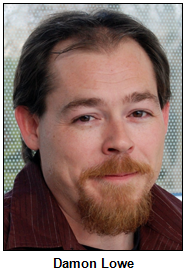 According to our experts, a frigid climate more than 80,000 years ago forced an expansion of the Arctic ice sheets. The largest sheet covered much of North America, including the future state of Indiana.
According to our experts, a frigid climate more than 80,000 years ago forced an expansion of the Arctic ice sheets. The largest sheet covered much of North America, including the future state of Indiana.
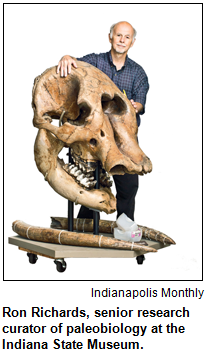 As described by the State Museum, mastodons like Fred were "shorter, stockier cousins" of mammoths, which also roamed prehistoric Indiana about 13,000 years ago. Mammoths were not as plentiful here as mastodons, though.
As described by the State Museum, mastodons like Fred were "shorter, stockier cousins" of mammoths, which also roamed prehistoric Indiana about 13,000 years ago. Mammoths were not as plentiful here as mastodons, though.
"Like modern elephants, mastodons could live 60 years or more, but few made it to retirement (age)," according to an article in Indianapolis Monthly magazine's November issue.
In conjunction with the Ice Age Giants exhibit at the State Museum, the nearby IMAX Theater is showing a movie, Titans of the Ice Age, that depicts the era in 3D. It's an age described as inhabited by "saber-toothed cats, giant sloths, dire wolves and woolly mammoths."
A skeleton of a dire wolf, a type of wolf that co-existed with mammoths and mastodons in Indiana, is displayed at the State Museum.
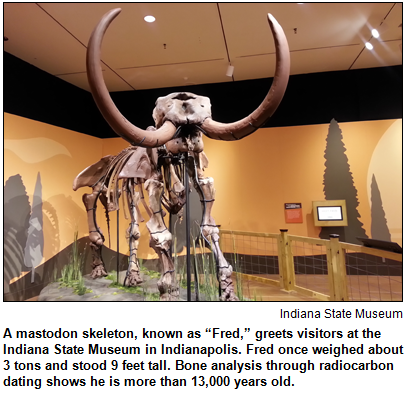 The museum has been involved in what's known as "bone recovery" of prehistoric remains since the late 1970s. The first major excavation site was near Bass Lake in Starke County.
The museum has been involved in what's known as "bone recovery" of prehistoric remains since the late 1970s. The first major excavation site was near Bass Lake in Starke County.
Since then, significant excavations have occurred near Hebron in northwest Indiana and near the city of Plymouth. Mastodon bones also have been found in a bed of the White River in southern Indiana. The average excavation takes two weeks and a crew of about 10 staff members from the State Museum and volunteers.
The skeleton of Fred, the mastodon, is about 9 feet tall and 250 feet long. His skull alone weighs 250 pounds.
Some other Ice Age history nuggets:
- Our guest Ron Richards was involved in the discovery of the nearly complete skeleton of a peccary, a pig-like animal that existed in Indiana during ancient time. The peccary skeleton was unearthed in Crawford County.
- In addition to differing in their size, mammoths and mastodons had different types of tusks. The taller, slimmer mammoths had tusks that were much more curved, projecting downward "like a walrus," according to the State Museum. Mastodons' tusks tended to project straight forward.
- Ice Age Giants: The Mystery of Mammoths and Mastodons exhibit will continue at the State Museum until Aug. 17.
Roadtripper: Sing along with Handel's Messiah
|
Ever affable Guest Roadtripper Garry Chilluffo of Chilluffo Photography suggests we check out one of Indy's newest holiday traditions. It's the opportunity for any and all to sing selections from Handel's Messiah along with the Indianapolis Chamber Orchestra and Encore Vocal Arts. No singing experience needed!
Sit in your section (soprano, alto, tenor, bass) or sit with your friends and family, whatever is most comfortable for you! Grab your score; you can also download one from icomusic.org, borrow or purchase a score for $5 at the performance.
The Sing-Along takes place Monday, Dec. 16 at 7:30 p.m. at Indiana Landmarks Center Grand Hall in Indianapolis. Tickets are $30 for adults and $12 for students.
Indianapolis Chamber Orchestra also performs Handel's Messiah on Dec. 13 at 7:30 p.m. and Dec. 15 at 3 p.m. at Tabernacle Presbyterian Church in Indianapolis.
History Mystery
One of the world's most famous sets of dinosaur fossils - the skeleton of a Tyrannosaurus Rex considered the most complete and best preserved ever found - is exhibited at the Field Museum of Natural History in Chicago. However, there is an Indiana connection to the T-Rex. The specimen has been named in honor of the woman who discovered it. She is a paleontologist who grew up in Munster, Ind.
Although the future discoverer was born in Chicago, her family moved to Munster when she was a young child. She lived in the northwestern Indiana city until age 16.
In 1990, while excavating in South Dakota, she discovered the Tyrannosaurus skeleton, which is considered 90 percent complete. It's been exhibited at the Field Museum since 2000.
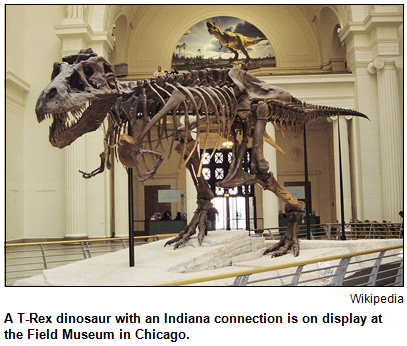 Question: What is the name of the dinosaur, which is also the first name of the paleontologist who discovered it?
Question: What is the name of the dinosaur, which is also the first name of the paleontologist who discovered it?
The prize is a gift certificate to New Orleans on the Avenue restaurant, courtesy of Visit Indy, and admission for four to the Indiana Experience at the Indiana History Center, courtesy of the Indiana Historical Society.
Last live show's answer. By request, we are publishing the answer to the last live History Mystery, in case you didn't catch it on the air. The Nov. 30 show answer was: A STEER.
Known as "Old Ben," the steer has been displayed in Kokomo's Highland Park since before World War II. His weight upon his death in 1910 was estimated at more than 4,500 pounds. Old Ben was born on a farm in 1902 and apparently weighed at least 125 pounds at birth. During his life, the steer became famous and was exhibited at various festivals.
After Old Ben slipped on ice and broke both legs in 1910, he had to be put down. His owners had him stuffed and mounted by a taxidermist to prove to future generations of doubters that an animal of his gigantic size once existed. In the pavilion in Highland Park, Old Ben is exhibited next to a pile of hay.
Old Northside neighborhood in Indy history
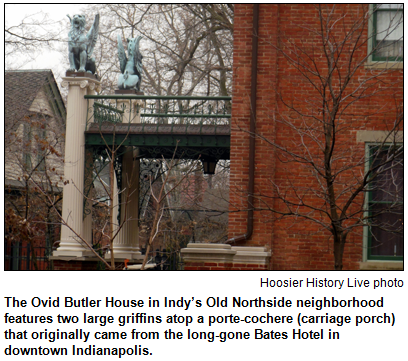 (Dec. 7, 2013 encore presentation) - Thanks to spacious Italianate and Queen Anne-style houses built in the late 1800s, the Old Northside in Indianapolis became the city's posh neighborhood through the World War I era.
(Dec. 7, 2013 encore presentation) - Thanks to spacious Italianate and Queen Anne-style houses built in the late 1800s, the Old Northside in Indianapolis became the city's posh neighborhood through the World War I era.
By the 1970s, when urban pioneers Paul Smith, Rick Patton and their wives moved into two of the historic homes, the neighborhood had become, as Rick diplomatically puts it, "blighted." Paul says his house even was occupied by a drug dealer.
During the 30 years since then, many of the grand homes have been restored to their former glory in the neighborhood, which has been placed on the National Register of Historic Places and now is known as the Old Northside Historic District.
Join us for an encore broadcast of a show about the colorful heritage of the neighborhood that's roughly bounded by East 11th, Pennsylvania, East 16th and Carrollton streets. Paul Smith and Rick Patton are Nelson's guests on the show, which originally was broadcast on Jan. 7, 2012.
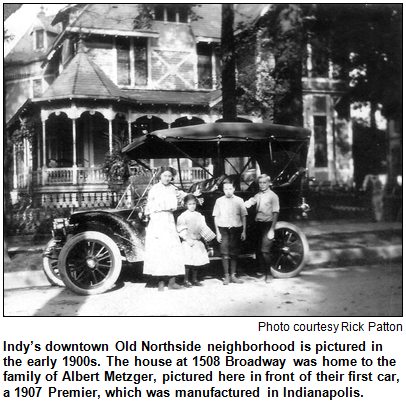 During the decades that the Old Northside struggled, many of the once-fashionable homes (Rick estimates more than 100) were demolished. Others, including his, were converted into apartments.
During the decades that the Old Northside struggled, many of the once-fashionable homes (Rick estimates more than 100) were demolished. Others, including his, were converted into apartments.
By the way, Rick's home was built in 1876 by the son-in-law of civic leader Ovid Butler, a founder of the university that now bears his name. In fact, the Old Northside was the initial site of Butler University, then known as North Western Christian University.
(Fun fact: College Avenue derives its name because that street led to the university, which moved to Irvington during the 1870s. Butler moved, yet again, to its current location in the 1920s.)
Paul Smith, whose house was built in 1892, is a past president of the Old Northside Neighborhood Association and a past board member of Indiana Landmarks, the statewide historic preservation organization. (In 2011, Landmarks itself became an Old Northside "resident" by moving its headquarters into the former Central Avenue University Methodist Church, later known as the Old Centrum.)
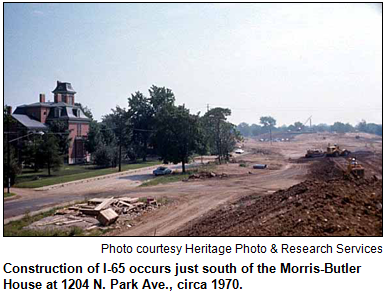 Preservation advocates from across the country - including architects, civic leaders, attorneys, historians and federal officials - toured the Old Northside during last month's conference of the National Trust for Historic Preservation.
Preservation advocates from across the country - including architects, civic leaders, attorneys, historians and federal officials - toured the Old Northside during last month's conference of the National Trust for Historic Preservation.
Most of the Old Northside's historic homes were built between the 1870s and the early 1900s. Before the Civil War, property in what became the Old Northside was regarded as too far away from the bustling Mile Square to be developed for homes.
That changed with the coming of horse-drawn trolleys and the extension of city streets. During the late 1800s and early 1900s, influential residents included Benjamin Harrison (his Italianate home, now known as the Benjamin Harrison Presidential Site, is at 12th and Delaware streets); the Ayres and Wasson families of department store fame (their historic mansions were demolished), novelist Meredith Nicholson, author of the bestselling romance thriller House of 1,000 Candles, and Thomas Taggart, the former mayor who bought the French Lick Springs Hotel.
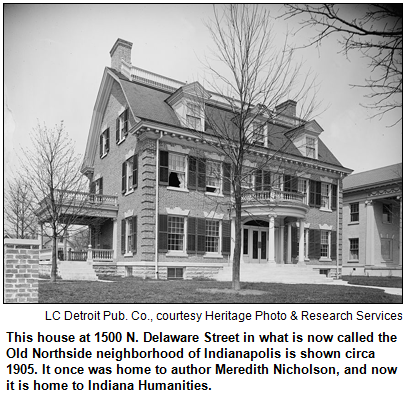 The Old Northside also includes the restored Morris-Butler House, which was built in 1865 and is owned now by Indiana Landmarks. And it includes a Romanesque Revival house built in the 1890s at 1410 N. Delaware owned by the Propylaeum Historic Foundation.
The Old Northside also includes the restored Morris-Butler House, which was built in 1865 and is owned now by Indiana Landmarks. And it includes a Romanesque Revival house built in the 1890s at 1410 N. Delaware owned by the Propylaeum Historic Foundation.
Why were so many homes demolished in the Old Northside? Many, including the mansions of the Ayres and Wasson families, came down during the 1960s and early '70s with the construction of I-65, which cuts through the neighborhood. Other homes were demolished as part of "urban renewal."
Along with spectacular renovations of many historic homes in recent years, new-home construction has occurred, particularly on the east edge of the neighborhood near College Avenue.
As Old Northside residents for more than 30 years - Paul and Rick arrived with their wives shortly after graduating from college - our guests have insights about the changes they have seen in the neighborhood. Paul is real estate manager for the city of Indianapolis; Rick is an executive for a textbook publisher.
As Rick notes with pride, the Old Northside today resembles the neighborhood depicted in historic photographs much more than the "blighted" residential area he encountered as a newlywed.
Interviewing tips for family, church and neighborhood histories
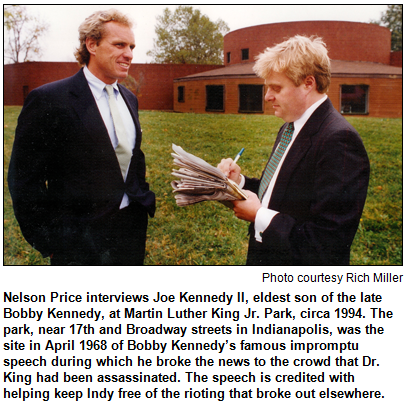 (Nov. 30, 2013) - Family gatherings during the holiday season are, obviously, ideal opportunities to do oral interviewing of grandparents and other relatives for a family histories.
(Nov. 30, 2013) - Family gatherings during the holiday season are, obviously, ideal opportunities to do oral interviewing of grandparents and other relatives for a family histories.
And folks who want to put together histories of their churches, neighborhoods or civic groups also will benefit from tips for getting people to "open up" and share memories, including those that touch on sensitive or painful topics.
To provide techniques and tips for the broad range of our listeners, Hoosier History Live! turns to three veteran interviewers.
They include our host, Nelson, who frequently teaches classes (sometimes called "Making People Talk") for the general public based on his years of interviewing everyone from acrobats to zoo veterinarians - as well as folks in their 80s and 90s who have lived through dozens of historic events.
Nelson, a former feature writer/columnist for The Indianapolis Star, is joined in studio by:
- Ray Boomhower of the Indiana Historical Society. An author/historian like Nelson, Ray has interviewed countless history-makers for his various books and in his capacity as editor of the society's magazine, Traces of Indiana and Midwestern History. Ray currently is working on a biography of John Bartlow Martin (1915-1987), a Hoosier journalist known for his interviewing techniques as well as for his coverage of national stories such as John F. Kennedy's presidential campaign.
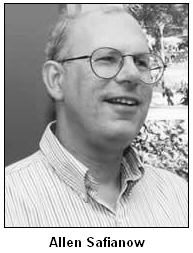 Allen Safianow, a professor emeritus of history at Indiana University-Kokomo who has overseen oral interview projects in Howard County. He has interviewed people on sensitive topics such as the statewide stranglehold that the Ku Klux Klan had in the 1920s (he was a guest for a Hoosier History Live! show on that topic in April 2010) and the controversy surrounding the crusade of AIDS victim Ryan White to attend school in the 1980s.
Allen Safianow, a professor emeritus of history at Indiana University-Kokomo who has overseen oral interview projects in Howard County. He has interviewed people on sensitive topics such as the statewide stranglehold that the Ku Klux Klan had in the 1920s (he was a guest for a Hoosier History Live! show on that topic in April 2010) and the controversy surrounding the crusade of AIDS victim Ryan White to attend school in the 1980s.
Nelson and his guests share tips about their favorite interview questions (and ones that are the least effective in getting people to open up); how to extract decades-old details from interview subjects, and ideal settings for interviews.
In addition, Nelson discusses the importance of asking about sensitive issues (such as a parent's alcoholism or a family tragedy) when doing a family history interview. He shares non-threatening ways to ask questions about painful episodes.
Allen shares suggestions about phrasing questions so they are posed in neutral ways that don't influence interview subjects. When he has trained Howard County residents for oral history projects, Allen has used this example of a leading question:
"Don't you feel that management was antagonistic toward the workers?"
Instead, he recommends: "How would you describe management's attitude toward the workers?"
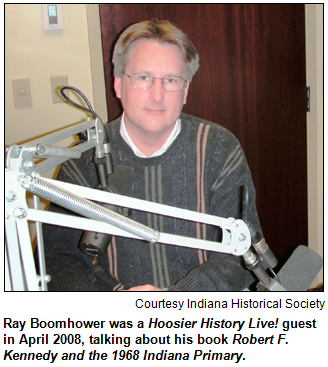 For in-depth interviews, both Allen and Nelson strongly recommend one-on-one sessions, without observers such as spouses, managers and friends - even if the third parties promise to stay silent. (In fact, Nelson is convinced that silent onlookers pose special problems. He will explain why during our show.)
For in-depth interviews, both Allen and Nelson strongly recommend one-on-one sessions, without observers such as spouses, managers and friends - even if the third parties promise to stay silent. (In fact, Nelson is convinced that silent onlookers pose special problems. He will explain why during our show.)
For his various biographies, our guest Ray Boomhower has interviewed Hoosiers ranging from a World War II-era flying ace from northwest Indiana (Alex Vraciu was the focus of his book, Fighter Pilot, which was published in 2010 by the Indiana Historical Society Press) to political leaders such as the late U.S. Congressman Jim Jontz, the subject of The People's Choice (IHS Press, 2012).
With more than 70 other authors with Indiana connections, Ray and Nelson will sign copies of the books about famous Hoosiers from noon to 4 p.m. on Dec. 7 during the annual Holiday Author Fair at the Eugene and Marilyn Glick Indiana History Center.
But both of our guests, like Nelson, have interviewed countless Hoosiers who never made headlines.
Even so, who doesn’t have at least some captivating stories to tell? Tune in for practical advice that will help anyone interested in capturing vivid memories that will add depth and details to histories of families, neighborhoods, churches and civic groups.
Here are some advice books recommended by Nelson, who has taught interviewing classes for the Indiana Writers Center and Indiana University-Purdue University at Indianapolis:
- How to Talk to Anybody About Anything (Citadel Press, 1993).
- Making People Talk (William Morrow & Co., 1987).
- How to Talk to Anyone, Anytime, Anywhere (Crown Publishers, 1994). This book was written by Larry King, the former CNN host. King writes that his favorite question is a three-letter word: "Why?"
- Interviewing America's Top Interviewers (Birch Lane Press, 1991). This features insights from Barbara Walters, Dick Cavett, Diane Sawyer and other famous interviewers.
Roadtrip: Eight holiday open houses across Indiana
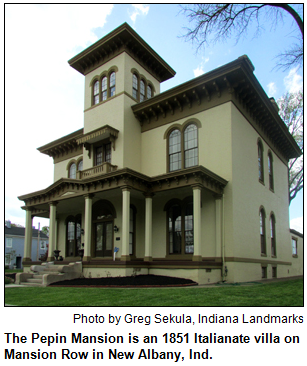 Guest Roadtripper Chris DellaRocco of Indiana Landmarks suggests we add some historic flare to this year's holiday season by visiting some of the spectacular Holiday Open Houses around the state.
Guest Roadtripper Chris DellaRocco of Indiana Landmarks suggests we add some historic flare to this year's holiday season by visiting some of the spectacular Holiday Open Houses around the state.
Eight historic homes will be dressed up for the holidays, and admittance is free for Indiana Landmarks members and their guests. Chris tells us that this is a chance to see some excellent examples of preservation and restoration inside homes not that are not normally open to the public.
Many of the homes are ones have been saved from the Top Ten Endangered List, and others have long held a great significance to their community.
Here is a line-up for this year's Holiday Open Houses.
Chris tells us that Indiana Landmarks has been working to save meaningful places for more than 53 years.
History Mystery
Kokomo, where our guest Allen Safianow has been a history professor and has overseen oral interviewing projects, has a claim to fame in taxidermy. The largest preserved example in the world of a certain kind of animal is displayed in Kokomo.
The animal lived during the early 1900s and set a record for his size that still stands today. The stuffed, mounted figure of the animal stands in a pavilion in Highland Park. The park in Kokomo also is the home of the world's largest Sycamore tree stump.
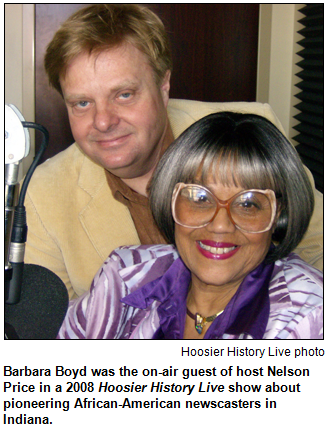 Question: The world's largest example of what kind of animal is displayed in Kokomo?
Question: The world's largest example of what kind of animal is displayed in Kokomo?
The prize is a gift certificate to Iozzo's Garden of Italy, courtesy of Visit Indy, and admission for four to the Indiana Experience at the Indiana History Center, courtesy of the Indiana Historical Society.
Last live show's answer. By request, we are publishing the answer to the last live History Mystery, in case you didn't catch it on the air.
The Nov. 16 show answer: BARBARA BOYD. The well-known TV news personality had been the office manager of Head Start in Indianapolis before being hired as a consumer reporter at Channel 6 in 1969. From 1981 to 1984, Barbara Boyd anchored the noon news, becoming the first African-American woman to anchor a TV news broadcast in Indianapolis.
Still highly visible as a civic leader since retiring from TV news in 1994, Barbara Boyd joined Nelson in February 2008 for a Hoosier History Live! show about her trail-blazing career in local television.
Cafeterias across Indiana
|
Click here to listen to this encore broadcast!
(Nov. 23, 2013 - online-only encore presentation) - Hoosier History Live! will be pre-empted Saturday on WICR-FM so the radio station can broadcast live coverage of the University of Indianapolis football team's playoff game. 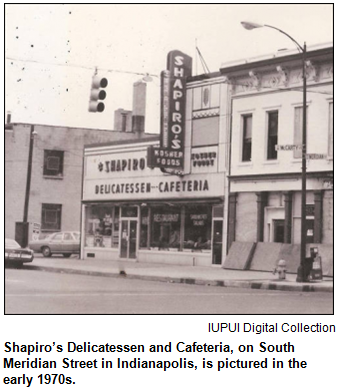 Even though you won't be able to tune in and listen to us over the airwaves, as a special treat we are making available - on our website and by clicking on a link embedded in this e-newsletter - one of the most popular programs from our Hoosier History Live! archives.
Even though you won't be able to tune in and listen to us over the airwaves, as a special treat we are making available - on our website and by clicking on a link embedded in this e-newsletter - one of the most popular programs from our Hoosier History Live! archives.
The featured program is a perfect show for a season known for its focus on food. Rather than feast on Thanksgiving turkey, though, we dig into our state's cafeteria culture in a show originally broadcast on Oct. 27, 2012.
Unaware that Indiana was famous for its cafeterias?
Well, think how many have flourished for generations of hungry Hoosiers. Gray Brothers Cafeteria in Mooresville has received national acclaim for its fresh-made rolls, fried chicken and old-fashioned pies. Indiana-based MCL Cafeterias is described in Tray Chic: Celebrating Indiana’s Cafeteria Culture (Emmis Books, 2004) as "arguably the largest family-owned cafeteria chain in the nation."
Poe's Cafeteria in Martinsville is cherished by devotees of its persimmon pudding, gooseberry pie and other scrumptious fare.
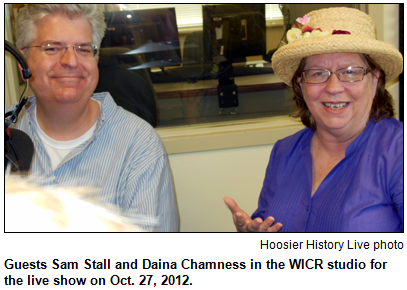 And Shapiro's Delicatessen has been a landmark in downtown Indy for more than 100 years, although fourth-generation owner Brian Shapiro has been quoted as saying he dislikes the term "cafeteria."
And Shapiro's Delicatessen has been a landmark in downtown Indy for more than 100 years, although fourth-generation owner Brian Shapiro has been quoted as saying he dislikes the term "cafeteria."
Even so, all of those beloved cafeterias (and a platter of others) are featured in Tray Chic, and its author is among Nelson's in-studio guests. He is Indianapolis-based writer Sam Stall, who also pens a question-and-answer column in Indianapolis Monthly magazine called "The Hoosierist."
In addition to Sam, Nelson is joined on our exploration of cafeteria culture by a culinary queen who is well-known among Hoosier foodies. Daina Chamness of Greenwood has carved out a long career, thanks to her work both in broadcasting and in the kitchen. Now known for Yours Truly Foods, her wine cake mixes, Daina formerly specialized in single-serving pies of all varieties.
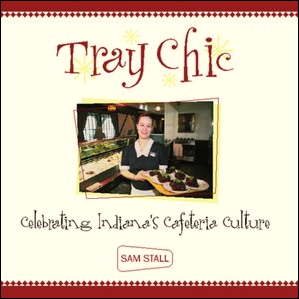 Speaking of pies: As part of our cafeteria conversation, Nelson and his guests discuss sugar cream pie, which has been designated Indiana's "official state pie." It's relevant to our topic because Jonathan Byrd's in Greenwood and other cafeterias are among the few eateries that regularly serve it. (Sugar cream pie also was the focus of a "Hoosierist" column by Sam last year.)
Speaking of pies: As part of our cafeteria conversation, Nelson and his guests discuss sugar cream pie, which has been designated Indiana's "official state pie." It's relevant to our topic because Jonathan Byrd's in Greenwood and other cafeterias are among the few eateries that regularly serve it. (Sugar cream pie also was the focus of a "Hoosierist" column by Sam last year.)
In Tray Chic, Sam describes the sprawling Jonathan Byrd's as the cafeteria version of an "epic, Cecil B. De Mille-style scale" production.
Noting that cafeterias have long been hailed for their comfort food, Sam writes: "Some would say that the long view down the tray line is what heaven looks like."
According to Tray Chic, though, cafeterias are vanishing in many parts of the country.
"Today, they're as state-of-the-art as a brontosaurus, and almost as rare - unless you live in Indiana," Sam writes. In the Hoosier state, he explains, cafeterias are "culinary landmarks."
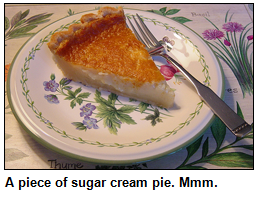 The former Laughner's Cafeteria chain, which traced its beginnings to a storefront restaurant in 1900 in downtown Indy, opened the state's first cafeteria and was on the cutting edge of "food service technology," according to Tray Chic.
The former Laughner's Cafeteria chain, which traced its beginnings to a storefront restaurant in 1900 in downtown Indy, opened the state's first cafeteria and was on the cutting edge of "food service technology," according to Tray Chic.
Expansion of the Laughner's chain included the 1964 opening in Southern Plaza shopping center of a cafeteria in a structure that, as Tray Chic puts it, resembled a "big, Tudor-style house." In 1987, the chain opened a Laughner's Super Cafeteria on the far northside of Indy. After about 100 years in operation, though, the last Laughner's closed in 2000.
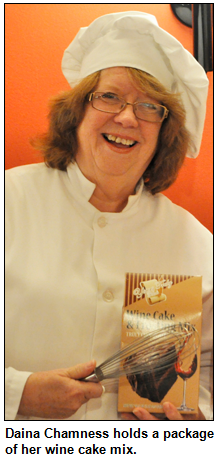 The MCL chain, however, has survived with signature fare, including cloverleaf rolls, carved roast beef, Swiss steak and Irani iced tea. According to Reid Duffy's Guide to Indiana's Favorite Restaurants (IU Press, 2006), the chain resulted from a business relationship between co-founder Charles McGaughey and George Laughner, a son of the Laughner's founder. (The "L" in MCL stands for Laughner.)
The MCL chain, however, has survived with signature fare, including cloverleaf rolls, carved roast beef, Swiss steak and Irani iced tea. According to Reid Duffy's Guide to Indiana's Favorite Restaurants (IU Press, 2006), the chain resulted from a business relationship between co-founder Charles McGaughey and George Laughner, a son of the Laughner's founder. (The "L" in MCL stands for Laughner.)
By 2006, the MCL chain had more than 20 cafeterias, including restaurants in Anderson, Bloomington, Muncie, Richmond, Speedway, Terre Haute and West Lafayette.
In Mooresville, Gray Brothers seats 500 and often feeds 3,000 patrons per day, according to Tray Chic. With homemade dishes that have won praise from national food critics, Gray Brothers has been a landmark on State Road 67 since the late 1960s.
Shapiro's roots go back much farther. In 1905, two years after immigrating from Russia because of anti-Jewish pogroms, Louis and Rebecca Shapiro opened a kosher grocery shop on what's now the south side of downtown Indy, according to Reid Duffy's book.
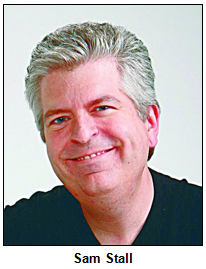 The transition to a restaurant - with cafeteria-style lines - began in the 1930s when Louis delegated the store to his sons Abe, Izzy and Max.
The transition to a restaurant - with cafeteria-style lines - began in the 1930s when Louis delegated the store to his sons Abe, Izzy and Max.
And about 120 years before that, hundreds of Quakers from North Carolina traveled to Indiana to settle. Our guest Daina Chamness noted during a previous show (that also featured Reid Duffy as a guest) that sugar cream pie may have its origins in a dessert made by Quaker farm wives.
Speaking of farms: In Tray Chic, Sam writes that, for Hoosiers, cafeterias often conjure up "ancestral memories of old-fashioned farm dinners, or fond reflections of Sunday after-church suppers at Grandma's."
Typically, he notes, cafeterias serve fried chicken, macaroni and cheese, pecan pies and "pretty much anything else that farm wives set out for their families 150 years ago."
Some fun facts:
- The word "cafeteria" is derived from a Spanish term for coffee shop, according to Tray Chic.
- According to Reid Duffy's book, Louis Shapiro's grandfather had been a primary food supplier for the czar of Russia's naval fleet.
- At Jonathan Byrd's in Greenwood, Sam Stall writes, the serving line is about as long as a tennis court.
Click here to listen to this encore broadcast!
|
Roadtrip: 25 Weird and Wonderful tour
Guest Roadtripper and Hoosier History Live! fan Terri Gorney of Fort Wayne, who listens to the show every week via WICR Online, tells us to check out 25 different real Roadtrips, all highlighted under one roof, and taking up two huge gallery areas.
It's the 25 Weird and Wonderful tour at Minnetrista in Muncie, Ind. Turns out the Minnetrista staff queried lots of Hoosiers about 25 awesome places to visit in east central Indiana. It runs now through March 30.
From famous ice cream shops to glass blowing to the world's largest ball of paint, east central Indiana has it all and much more! Terri tells us that you can explore 25 of the region's best-kept secrets in one intriguing exhibit at Minnetrista, and then visit each location itself.
In the news
IBJ covers Hoosier History Live!
Reporter Chris O'Malley of the Indianapolis Business Journal sat in on a recent program and shared some of the unique ambition and charm of Hoosier History Live! with IBJ's readers.
Ask Nelson and Channel 4 children's shows history
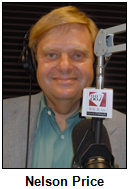 (Nov. 16, 2013) - Once in awhile, we like to take full advantage of our claim to distinction at Hoosier History Live!: Our show is the country's only live radio program with listener call-in about a state's history.
(Nov. 16, 2013) - Once in awhile, we like to take full advantage of our claim to distinction at Hoosier History Live!: Our show is the country's only live radio program with listener call-in about a state's history.
That means we can turn the tables periodically on our host, author/historian Nelson Price, open the phone lines and give our listeners an opportunity to question the interviewer, who calls himself "a garbage can of useless Hoosier trivia."
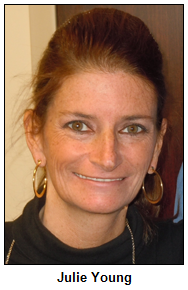 During our "Ask Nelson" shows, listeners are encouraged to call the WICR-FM studio and pose questions to Nelson, whose areas of expertise are famous Hoosiers (both historic and contemporary people) and Indianapolis city history. His books include Indiana Legends: Famous Hoosiers from Johnny Appleseed to David Letterman (Hawthorne Publishing) and Indianapolis Then and Now (Thunder Bay Press), a visual history about his hometown.
During our "Ask Nelson" shows, listeners are encouraged to call the WICR-FM studio and pose questions to Nelson, whose areas of expertise are famous Hoosiers (both historic and contemporary people) and Indianapolis city history. His books include Indiana Legends: Famous Hoosiers from Johnny Appleseed to David Letterman (Hawthorne Publishing) and Indianapolis Then and Now (Thunder Bay Press), a visual history about his hometown.
On this show, Nelson is joined by a special co-host who joins the questioning - and also takes questions from listeners. His co-host is author Julie Young, whose newest book is The Famous Faces of Indy's WTTV-4 (The History Press). It explores the lives, careers and impact on Baby Boomers, Gen Xers and other Hoosiers of TV personalities during the heyday of children's programming on WTTV-Channel 4.
Those personalities include some - such as Janie Hodge, the popular star of the long-running "Popeye and Janie" (the show was later renamed "Janie") and Cowboy Bob (real name: Bob Glaze) - who have been guests on previous Hoosier History Live! shows.
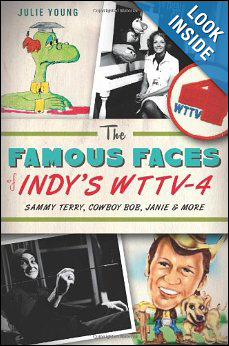 Julie's book also explores the lives and careers of ghoulish Sammy Terry, the host of the cult favorite "Shock Theater," which also had other names, including "Nightmare Theater" and "The Sammy Terry Show," during its various incarnations) and Peggy Nicholson, the host of a children's show in the 1970s on Channel 4.
Julie's book also explores the lives and careers of ghoulish Sammy Terry, the host of the cult favorite "Shock Theater," which also had other names, including "Nightmare Theater" and "The Sammy Terry Show," during its various incarnations) and Peggy Nicholson, the host of a children's show in the 1970s on Channel 4.
Sammy Terry (real name: Bob Carter) died last June at age 83; his son, Mark Carter, now makes appearances as Sammy Terry, a name that, when spoken quickly, is a riff on the word "cemetery."
So with Julie's expertise about, as her book puts it, "a pre-cable era when shows were live, hosts were local celebrities and anything could happen," she is an ideal co-host for Nelson, with his expertise about famous Hoosiers.
His book Indiana Legends, now in its 4th edition and 7th printing, features profiles and vignettes of more than notables. He has interviewed - often several times - contemporary-era famous Hoosiers such as David Letterman, Jane Pauley, Larry Bird, Kurt Vonnegut Jr., Ryan White, Reggie Miller, Florence Henderson, astronaut David Wolf and Rev. Theodore Hesburgh of the University of Norte Dame.
He also has researched the colorful lives of historic notables such as bank robber John Dillinger, composers Cole Porter and Hoagy Carmichael, entrepreneurs Col. Eli Lilly and Madam Walker, novelists Lew Wallace and Booth Tarkington and movie star Carole Lombard.
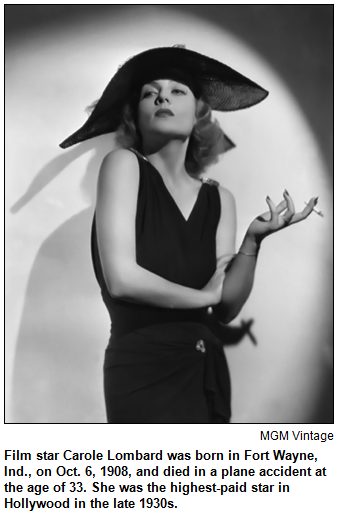 Nelson welcomes questions during our show about any of these famous (or, in a couple of cases, infamous) Hoosiers, as Julie does about any of the Channel 4 personalities.
Nelson welcomes questions during our show about any of these famous (or, in a couple of cases, infamous) Hoosiers, as Julie does about any of the Channel 4 personalities.
During our show, Nelson and Julie also interview each other. Nelson asks his co-host how and why WTTV, which went on the air in November 1949 as only the second TV station in the state, carved out a niche in offering children's programming. (According to Julie's book, the first TV station on the air in Indiana was Indianapolis-based WFBM, which is known today as WRTV-Channel 6.)
In addition, Nelson welcomes questions related to city history of the Hoosier capital. His book Indianapolis Then and Now explores sites such as the Soldiers and Sailors Monument, Garfield Park, Fort Harrison (now Fort Harrison State Park) and the Indianapolis Motor Speedway. It also features neighborhoods with colorful histories such as Lockerbie, Woodruff Place and Broad Ripple.
By the way, his co-host on this "Ask Nelson" show has been a frequent guest on Hoosier History Live! in connection with her other books. In addition to writing The Famous Faces of Indy's WTTV-4, Julie Young is the author of books about the histories of Shelby County and the eastside of Indy. In fact, Nelson, who grew up on the far-eastside, is quoted in Eastside Indianapolis: A Brief History (The History Press, 2009).
Julie also is the author of A Belief in Providence: A Life of Saint Theodora Guerin (Indiana Historical Society Press, 2007), a biography of the first Hoosier to be named a saint. Mother Theodore, as she was known during her lifetime (1798-1856), also is featured in Nelson's Indiana Legends; she was a Catholic nun who traveled from France to the wilderness of far-western Indiana in 1840. As a pioneer, she founded schools, orphanages and frontier versions of pharmacies. So both Julie and Nelson welcome questions about her remarkable life.
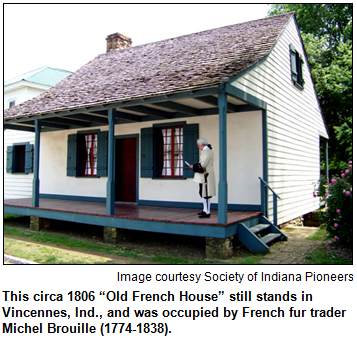 Earlier this year, shows with the "Ask Nelson" format have featured, as co-hosts, Indianapolis-based event planner Gary BraVard and our WICR colleague, attorney Charles Braun, whose Legally Speaking radio show is celebrating its 30th year on the air. During the show with Gary, he shared behind-the-scenes anecdotes about galas that he planned in the Hoosier capital attended by a range of visiting celebrities.
Earlier this year, shows with the "Ask Nelson" format have featured, as co-hosts, Indianapolis-based event planner Gary BraVard and our WICR colleague, attorney Charles Braun, whose Legally Speaking radio show is celebrating its 30th year on the air. During the show with Gary, he shared behind-the-scenes anecdotes about galas that he planned in the Hoosier capital attended by a range of visiting celebrities.
A caller asked Nelson about early French immigrants to the Indiana frontier, including the fur traders who founded Vincennes, our oldest city. Another caller shared memories about the construction of I-465 and I-70 during the late 1960s and early '70s.
And yet another caller asked about the law school years of Dan Quayle. The former vice president also is among the scores of well-known Hoosiers whom Nelson has interviewed.
We always look forward to these lively, insightful shows - with your phone calls as the centerpiece.
Fun fact: Julie and Nelson will be among more than 70 authors who will sign books during the Indiana Author Fair from noon to 4 p.m. on Dec. 7. The annual fair will be at the Eugene and Marilyn Glick Indiana History Center, 450 W. Ohio St. in Indianapolis.
Roadtrip: Sandhill Cranes at Jasper-Pulaski
Guest Roadtripper and public historian Glory-June Greiff tells us that late fall is the time for the annual pilgrimage to Jasper-Pulaski Fish and Wildlife Area (just north of Medaryville off 421) to see the sandhill cranes.
The sight of thousands of these amazing birds flying in from all directions - with their unique bugling cries, then landing, gabbling and dancing in Goose Meadow - is a wonderful experience.
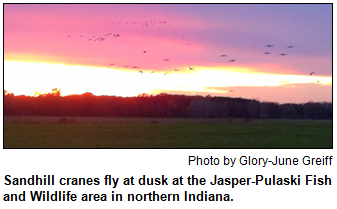 She says to plan to arrive about an hour before sunset to see them come in. Glory recommends trying to go up on a weekday when the crowds are smaller; hearing the cranes is a vital part of the experience, and she reports being recently annoyed by many people babbling about shopping bargains and such. In fact, she wanted to hear those magnificent sounds! (Perhaps those same people talk in movies and at concerts.)
She says to plan to arrive about an hour before sunset to see them come in. Glory recommends trying to go up on a weekday when the crowds are smaller; hearing the cranes is a vital part of the experience, and she reports being recently annoyed by many people babbling about shopping bargains and such. In fact, she wanted to hear those magnificent sounds! (Perhaps those same people talk in movies and at concerts.)
She says if you're heading up from the south, you’ll go up State Road 43 north from Lafayette and continue straight north on US 421. Passing through Brookston, a few miles north of Lafayette, you may want to check out Two Cookin' Sisters/Prairie Street Market for Grannie's Garden Pumpkin Butter and such.
Hungry? Reme's Monon Family Restaurant (in Monon, of course) offers a huge menu of classic family cafe fare. They're open late enough that you can catch them on the way back as well.
For something quick but tasty, on the north side of Monon is The Viking, locally owned - always Glory's preference.
Farther north of Monon is what could be a destination stop in itself - you might want to head up early to check this out. They, too, are open late enough to catch on the way back. It's the Whistle Stop Restaurant and Monon Connection Museum.
Happy crane watching and good eating - and tell everyone that Hoosier History Live! sent you.
History Mystery
In addition to Janie and Cowboy Bob, popular former TV personalities who have been studio guests on Hoosier History Live! include the first African-American woman to be a TV news reporter in Indianapolis. That happened in 1969 on WRTV-Channel 6, which then was WFBM-TV.
A consumer reporter, she went on to become the first African-American woman to anchor a TV news show in Indianapolis. She drew widespread attention in 1973 when, after learning she had breast cancer, she broadcast a report about her mastectomy from her hospital bed. In 1994, she retired after a 25-year career at Channel 6.
Question: Who is she?
The prize is admission for four to the Indiana Experience at the Indiana History Center, courtesy of the Indiana Historical Society, and a gift certificate to LePeep, courtesy of Visit Indy.
By the way, Anna of Indianapolis just won a prize on our Facebook page, so be sure to check us out there as well!
Last live show's answer. By request, we are publishing the answer to the last live History Mystery, in case you didn't catch it on the air.
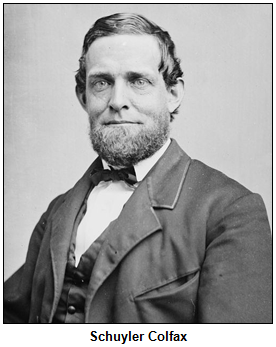 The Nov. 9 show answer: SCHUYLER COLFAX, who served as vice president with President Ulysses S. Grant.
The Nov. 9 show answer: SCHUYLER COLFAX, who served as vice president with President Ulysses S. Grant.
A native of New York City, Colfax moved with his family to northern Indiana at age 13 in the 1830s. Ambitious and gregarious, he advanced through Indiana politics as a Republican and, beginning in 1855, was elected to the U.S. Congress. Colfax served as Speaker of the House during the presidency of Abraham Lincoln, who became a close friend.
His term as vice president was from 1869 to 1873. Colfax died in 1885 and is buried in City Cemetery in South Bend.
The other three deceased vice presidents from Indiana - Thomas Hendricks, Thomas R. Marshall and Charles Fairbanks - are buried at Crown Hill Cemetery.
By the way, Judy from our Irvington Library Listening Group won the prize! So check out that group every Saturday during the live show at the Irvington Library, 5625 E. Washington St. in Indianapolis.
Brazilian immigration with artist Artur Silva
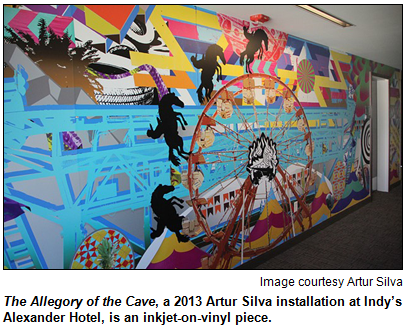 (Nov. 2, 2013 - encore presentation) - Join us for an encore broadcast of a program in our popular series about our ethnic heritage in Indiana. For this show about Brazilian immigration, Nelson's guest is Indianapolis-based artist, clothing designer and cultural organizer Artur Silva, one of several immigrants and visitors from his South American homeland who have been creating a splash on Hoosier soil. (The show's original air date was June 11, 2011 and is a half-hour program. The last half hour in our usual time slot has been pre-empted for U of I football.)
(Nov. 2, 2013 - encore presentation) - Join us for an encore broadcast of a program in our popular series about our ethnic heritage in Indiana. For this show about Brazilian immigration, Nelson's guest is Indianapolis-based artist, clothing designer and cultural organizer Artur Silva, one of several immigrants and visitors from his South American homeland who have been creating a splash on Hoosier soil. (The show's original air date was June 11, 2011 and is a half-hour program. The last half hour in our usual time slot has been pre-empted for U of I football.)
A recipient of the prestigious Efroymson Contemporary Arts Fellowship in 2010-11 and, more recently, of a creative renewal fellowship from the Arts Council of Indianapolis, Artur moved to Indy in 2001 after a few years in New York City.
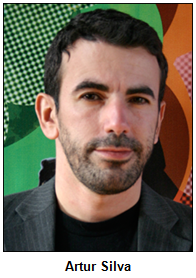 He has helped organize Indy Brazilian Carnaval, a festive celebration that has become an annual event in the Hoosier capital. His artwork has been exhibited at the Harrison Center for the Arts, the Indianapolis International Airport and the Fort Wayne Museum of Art. It also has been exhibited in galleries from Chicago and Los Angeles to the Netherlands and Brazil.
He has helped organize Indy Brazilian Carnaval, a festive celebration that has become an annual event in the Hoosier capital. His artwork has been exhibited at the Harrison Center for the Arts, the Indianapolis International Airport and the Fort Wayne Museum of Art. It also has been exhibited in galleries from Chicago and Los Angeles to the Netherlands and Brazil.
Artur, 37, is a native of Belo Horizonte City (translation: "beautiful horizon"), a city in southeastern Brazil that is surrounded by mountains. During our show, Artur discusses the wide range of reasons that native Brazilians have chosen to settle in Indiana.
Some fun facts:
- The high profile of Brazilian race drivers in the Indianapolis 500 has resulted in increasing enthusiasm for the sporting event in South America. Even casual race fans are familiar with three-time Indy 500 winner Helio Castroneves; the race last May was won by another native Brazilian, Tony Kanaan, who has become extremely popular among Hoosiers.
- The Indiana town of Brazil derives its name only indirectly from the country. According to folklore, the town took its name from a nearby farm called Brazil; the farm, in turn, had appropriated it because the country had been in the news frequently during the 1840s.
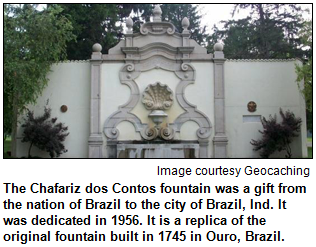 Even so, Forest Park in Brazil, Ind., features a large granite fountain that was a gift from the country; it's a replica of a historic fountain there.
Even so, Forest Park in Brazil, Ind., features a large granite fountain that was a gift from the country; it's a replica of a historic fountain there.- Artur's artwork is exhibited in The Alexander, the boutique hotel that opened in downtown Indy early this year. The hotel is named for Alexander Ralston, the surveyor who laid out the Hoosier capital in the 1820s. Nothing had been named in honor of the city's planner for more than 200 years. His life - and insights about the reasons Ralston assigned names to streets in the Mile Square - was the focus of a Hoosier History Live! show last February.
One more item: Here is video of Artur talking about art at the Alexander Hotel in downtown Indianapolis.
Environmental heritage across Indiana
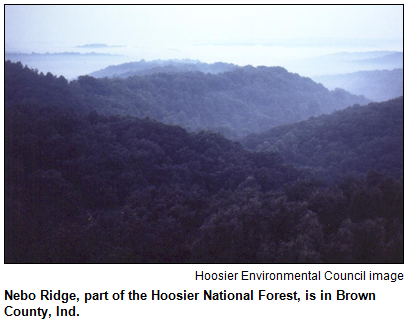 (Oct. 26, 2013) - The way history has unfolded, maybe we should call this show "the good, the bad and the ugly."
(Oct. 26, 2013) - The way history has unfolded, maybe we should call this show "the good, the bad and the ugly."
Early settlers in Indiana and subsequent generations clear-cut the dense, unbroken forest of towering trees that had dominated the Hoosier landscape, resulting in soil erosion and other significant challenges.
But, beginning with work during the Great Depression undertaken by the Civilian Conservation Corps, the Hoosier National Forest was recreated extensively in southern Indiana.
White River in the Indianapolis area has been substantially cleaned up, particularly when contrasted with its previous reputation as a dumping ground and a punch line for jokes. Many experts, though, consider the Grand Calumet River in northwestern Indiana still to be among the top 10 dirtiest in the country.
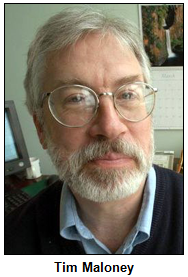 New hotels, businesses and buildings on university campuses in Indiana are winning acclaim for their energy-saving features. Concerns are increasing, though, about factory farms and their impact on nearby communities and havens such as Camp Tecumseh, a retreat near Monticello that has been beloved by generations of Hoosier youth.
New hotels, businesses and buildings on university campuses in Indiana are winning acclaim for their energy-saving features. Concerns are increasing, though, about factory farms and their impact on nearby communities and havens such as Camp Tecumseh, a retreat near Monticello that has been beloved by generations of Hoosier youth.
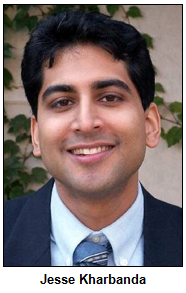 To explore the state's environmental heritage, Nelson is joined in studio by two guests from the Hoosier Environmental Council, a non-profit that is celebrating its 30th anniversary.
To explore the state's environmental heritage, Nelson is joined in studio by two guests from the Hoosier Environmental Council, a non-profit that is celebrating its 30th anniversary.
The HEC, which describes itself as a "science-based advocacy organization dedicated to protecting Indiana's environment," will host one of the state's largest gatherings of environmentalists on Nov. 16 on the campus of Indiana University-Purdue University at Indianapolis.
Nelson's guests are:
- Jesse Kharbanda, the dynamic former Rhodes Scholar who has been HEC's executive director since 2007. Known for his media savvy - Jesse has been a Nuvo Newsweekly cover subject and a familiar interviewee on TV and radio shows - he has emphasized ways that environmentalists can work in concert with business leaders and religious conservatives rather than being seen as perpetually at, well, loggerheads.
- Tim Maloney, HEC's senior policy director. He also has been the chair of Hoosier chapter of the Sierra Club; during the early 1980s, Tim helped found the HEC as a board member.
"A lot of what we're worried about today results from actions taken decades ago and generations ago," Jesse Kharbanda says, referring to what he and others call "legacy waste."
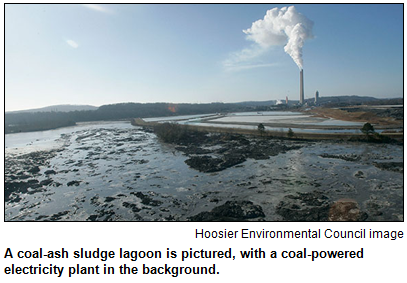 He also says: "Everyone cares about nature. They just care about different facets of it, in different ways, with different approaches to dealing with problems."
He also says: "Everyone cares about nature. They just care about different facets of it, in different ways, with different approaches to dealing with problems."
Specific areas of concern include Blackford County in northeastern Indiana, the site of several abandoned industrial complexes and former factories.
According to several accounts, the county and its county seat, Hartford City, have some of the highest levels of cancer, per person, in the state. The HEC launched a task force to coordinate investigations into the health issues and pollutants in the region, which once was home to automobile, gas, glass and chemical companies. In recent years, local residents have formed Blackford County Concerned Citizens, a grassroots organization that crusades for, as they put it, a "healthier and stronger future."
For the HEC, a galvanizing crusade after the organization was founded in 1983 involved attempts to stop expanded gas and oil leasing in parts of the Hoosier National Forest. The forest had been recreated by the CCC in the 1930s because extensive clear-cutting in Brown County and elsewhere in southern Indiana was causing significant environmental problems.
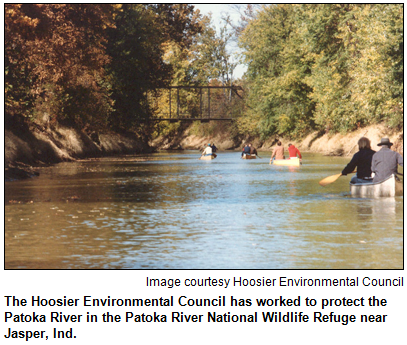 Our guest Tim Maloney, who was involved with the statewide campaign to protect the Hoosier National Forrest, shares details about how it unfolded. He also shares insights about various rivers in Indiana, including the White River and the Grand Calumet.
Our guest Tim Maloney, who was involved with the statewide campaign to protect the Hoosier National Forrest, shares details about how it unfolded. He also shares insights about various rivers in Indiana, including the White River and the Grand Calumet.
"We have a mixed record in Indiana," he says. "Throughout our history, we turned our backs on most of our waterways for many years. We saw them as sewers, with the result that they became badly contaminated."
Our guest Jesse Kharbanda is the son of immigrants from India. He grew up in St. Louis and studied economics at Oxford University in England, where he was a Rhodes Scholar.
Since moving to the Hoosier state, Jesse, 36, has helped lead a collaboration with the Greater Indianapolis Chamber of Commerce on pending legislation regarding public transit. In 2011, he was named by the Indianapolis Business Journal to its "40 Under 40" roster of rising young executives.
Here are some learn-more websites:
- Video documentary series The Natural Heritage of Indiana.
- HEC's Facebook page: facebook.com/hecweb.
- HEC Youtube channel: youtube.com/hecweb1.
- Hiking information for the Hoosier National Forest's Nebo Ridge Trail (pictured above).
Roadtrip - You Are There 1904: Picture This!
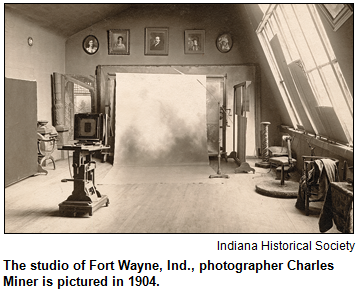 Guest Roadtripper Amy Lamb of the Indiana Historical Society suggests that you be one of the first to see You Are There 1904: Picture This!, which opens Oct. 29. She says visitors can step into the studio of photographer Charles Miner, who is busy conducting a normal day's business taking portraits of his Fort Wayne neighbors in 1904.
Guest Roadtripper Amy Lamb of the Indiana Historical Society suggests that you be one of the first to see You Are There 1904: Picture This!, which opens Oct. 29. She says visitors can step into the studio of photographer Charles Miner, who is busy conducting a normal day's business taking portraits of his Fort Wayne neighbors in 1904.
The Columbia City native turned Fort Wayne resident enjoyed a thriving business in the heart of Fort Wayne's downtown, where he participated in monumental moments in the lives of others.
Guests may also meet Miner's cousin/office manager, his technical assistant, or some Fort Wayne residents who may have visited the studio. And yes, Charles Miner really will take your photograph!
Amy also invites you to visit the IHS website after your visit to download your picture, play with the custom-made software, and morph your image into a vintage photograph to share with your friends and family.
The Eugene and Marilyn Glick Indiana History Center is located at 450 W. Ohio Street in downtown Indianapolis.
History Mystery
During the 1970s, an Indianapolis-based radio station drew widespread attention - and even astonishment - for sponsoring an annual raft race on the White River, then considered far from pristine. Popular among young listeners for playing a wide range of rock music, the radio station organized the raft race on a 2.5-mile section of the White River near the Broad Ripple area.
About 8,000 rafters each year participated in the race, which drew nearly 30,000 spectators to Broad Ripple Park and other areas along the course on the murky White River in the 1970s.
Question: What were the call letters of the radio station?
The prize is a voucher for two tickets to an Indianapolis Chamber Orchestra 2013-14 Masterworks Concert (includes The Messiah as a choice), courtesy of the Indianapolis Chamber Orchestra, and admission for four to the Indiana Experience at the Indiana History Center, where you can experience the new Picture This:1904 exhibit, courtesy of the Indiana Historical Society.
Thanks to all of our wonderful prize partners, including the stalwart Visit Indy, and also to our own Nelson Price, who seems to have a never-ending wealth of ideas for this contest.
Last week's answer
By request, we are publishing the answer to last week's History Mystery, in case you didn't catch it on the air. The Oct. 19 History Mystery answer is: REV. JACQUELINE MEANS.
The issue of ordaining women as priests was highly controversial among Episcopalians during the 1970s. Some protesters gathered in front of All Saints, 1559 Central Ave., on New Year's Day 1977 when Jacqueline Means was ordained as the first woman Episcopal priest.
In the decades since her ordination, Rev. Means served for several years as the parish priest at St. Mark Episcopal Church in Plainfield and continued her work as a prison chaplain, including at the Indiana Women's Prison. She also served in administrative capacities with the Episcopalian Church's prison ministries.
Preservation at the Crossroads kicks off Oct. 29 in Indy
Susan West Montgomery, a senior director at the National Trust for Historic Preservation in Washington, D.C., will do a special call-in to the show to tell us about the trust's upcoming annual conference, which runs Oct. 29 through Nov. 2 in Indianapolis and nearby locales.
She'll tell us a bit about why the "Crossroads of America" is historically significant on a national level, and she will mention a couple of conference highlights.
HHL tidbits
Sweet tweets from Allison, and more
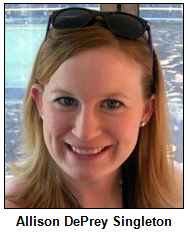 Hoosier History Live wishes to thank Allison DePrey Singleton for being our official Tweeter. Allison told us that we needed to be on Twitter, and producer Molly said, "I can't add one more thing to my list; would you like to do it?"
Hoosier History Live wishes to thank Allison DePrey Singleton for being our official Tweeter. Allison told us that we needed to be on Twitter, and producer Molly said, "I can't add one more thing to my list; would you like to do it?"
Spreading the duties out is a beautiful thing.
Oh, and Allison also can teach you how to trace your ancestry.
![]()
As you may know, we enjoy taking our show guests out to lunch on Saturdays after the show if schedules allow. Many of our guests have traveled quite a distance! We have a new sponsorship arrangement with Fountain Square Theatre Building that makes dining at one of its restaurants possible. And it's just a straight shot up Shelby Street from the UIndy campus! Our guests also get to see a bit of the evolving Fountain Square area.
![]()
We'd also like to thank some of our 2013 contributors, Julie Slaymaker and Jane "Janie" Hodge of Indianapolis and Ann Allen of Akron, Ind. You can help to defray the costs of maintaining our website, our email marketing software, our editing costs, etc. by simply clicking on the yellow "Donate" button on our website. If you would like your contribution to be tax-deductible, visit the "Support us" page on our website. Your support helps us to remain and the air, on the Web and in your inbox.
![]()
The Irvington Library Listening Group continues to meet on a regular basis from noon to 1 p.m. on Saturdays to listen to and discuss the live show. If you think you would enjoy listening with fellow history lovers, just stop by the library at 5626 E. Washington St. in Indianapolis and ask for the listening group.
By the way, it's easy to form your own listening group; all you need is a relatively quiet room with comfortable chairs and either a radio or an online listening device to pick up the show from the live Web stream on Saturdays. We do have listeners all over the world!
If you need any advice on how to get started, please contact molly@hoosierhistorylive.org. Or better yet, just go ahead and get started! A weekly listening group is an easy way to get "regulars" into your organization or place of business, and we will promote your group in our enewsletter. Also, this is a great warm and cozy winter activity. Coffee anyone?
Rabbi Sandy Sasso, pioneer for women clergy
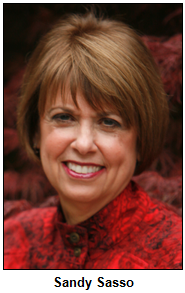 (Oct. 19, 2013) - Nearly 40 years ago, she was ordained as the country's first woman rabbi from the Jewish Reconstructionist movement. When Sandy Eisenberg Sasso and her husband, Dennis Sasso, were hired at Congregation Beth-El Zedeck in Indianapolis in 1977, they also became the world's first husband-and-wife rabbi team to serve a congregation jointly.
(Oct. 19, 2013) - Nearly 40 years ago, she was ordained as the country's first woman rabbi from the Jewish Reconstructionist movement. When Sandy Eisenberg Sasso and her husband, Dennis Sasso, were hired at Congregation Beth-El Zedeck in Indianapolis in 1977, they also became the world's first husband-and-wife rabbi team to serve a congregation jointly.
Earlier this year, Sandy Sasso retired as senior rabbi at the synagogue, but her career continues as an author of best-selling books for children, a civic leader and a speaker known for her storytelling gifts.
She also has become the director of a new program, the Religion, Spirituality and Arts Initiative under the auspices of the Butler University Center for Faith and Vocation.
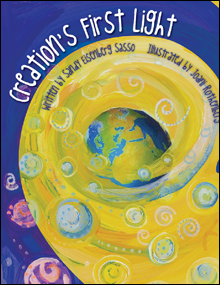 When Sandy became a rabbi in 1974, only one other American woman, from a different Jewish movement, had been ordained.
When Sandy became a rabbi in 1974, only one other American woman, from a different Jewish movement, had been ordained.
Her children's books - beginning with God's Paintbrush (Jewish Lights Publishing) in 1994 - are sold around the world and have been translated into German, Italian, Spanish, Hebrew and other languages. She says she became an author after she could not find faith-oriented books for her son and daughter when they were children.
Now a grandmother, Sandy Sasso joins Nelson in studio for a show about her trailblazing career and multifaceted life as one of the best-known women in central Indiana.
"I read of men's struggles with God, but not women's," Sandy is quoted as saying in 19 Stars of Indiana: Exceptional Hoosier Women (IU Press, 2009), a book of profiles by Michael S. Maurer. "No one was answering my questions. In fact, no one was asking them."
She was referring to her growing interest in becoming a rabbi during her youth in Philadelphia, her home town. 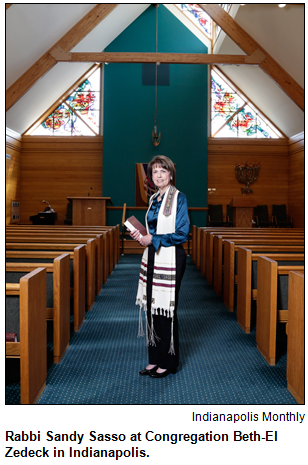 Sandy and Dennis Sasso were both just 31 years old when they were chosen to lead Beth-El Zedeck, 600 W. 70th St., and made history.
Sandy and Dennis Sasso were both just 31 years old when they were chosen to lead Beth-El Zedeck, 600 W. 70th St., and made history.
Sandy went on to earn a doctorate from Christian Theological Seminary and has received honorary doctorates from several Indiana colleges.
Since her ordination, women rabbis are no longer unusual. A total of more than 700 women across the country currently serve as rabbis from the various streams of Judaism, according to an article in The Indianapolis Star when Sandy retired at Beth-El Zedeck. (In Orthodox Judaism, women are not ordained.)
Her newest book, Creation's First Light, has just been published. An illustrated description of the Earth's creation that's inspired by the biblical chapter of Genesis, Creation's First Light been called "a perfect jewel of a book" by another distinguished Hoosier History Live! guest who also is an ordained member of the clergy: Quaker pastor and author Phil Gulley. (Known for his folksy stories about a fictional town that resembles his hometown of Danville, Phil was Nelson's guest for a show last May.)
Her other books for children - many of which cover religious issues in a non-denominational way - include God Said Amen, For Heaven's Sake, Noah's Wife and In God's Name, which invites young readers to come up with their own names for God based on what they value most. Sandy's adult books include Midrash: Reading the Bible with Question Marks.
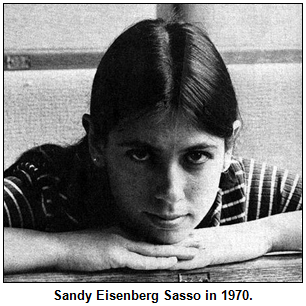 She met her husband, Dennis, who was born in Panama, when they were seminary students. Neither of the Sassos knew much about Indy when they moved to the Hoosier capital for what turned into 36 years of serving together at Beth-El Zedeck.
She met her husband, Dennis, who was born in Panama, when they were seminary students. Neither of the Sassos knew much about Indy when they moved to the Hoosier capital for what turned into 36 years of serving together at Beth-El Zedeck.
"I have come to care deeply about the future of Indianapolis, its problems, and its vision for overcoming them," Sandy wrote earlier this year in an account for Indianapolis Monthly magazine. "There are matters that require attention: hunger, healthcare, transportation, education, caring for those who are marginalized. But there are also people who are trying to create change, who fashion venues for civil conversation, who believe that diversity enriches us, that culture is good for the soul and for business."
Her civic endeavors include serving for three years as the board chair for the Spirit & Place Festival, the annual collaboration in November that celebrates the arts, culture and spirituality.
History nugget: In 2002, Sandy was the editor of Urban Tapestry: Indianapolis Stories (IU Press), a collection of insights and essays about the Hoosier capital. Contributing writers included our host, Nelson.
Learn more: Sandy Sasso has just launched a new website, www.allaboutand.com.
Roadtrip: Duckpin bowling in Fountain Square
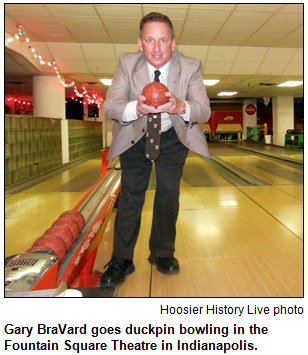 Guest Roadtripper Gary BraVard suggests we take the Roadtrip to play a little duckpin bowling (like regular bowling but everything is smaller!) in the Fountain Square Theatre Building. That's at the intersection of Virginia Avenue at Shelby and Prospect Streets just southeast of downtown Indianapolis.
Guest Roadtripper Gary BraVard suggests we take the Roadtrip to play a little duckpin bowling (like regular bowling but everything is smaller!) in the Fountain Square Theatre Building. That's at the intersection of Virginia Avenue at Shelby and Prospect Streets just southeast of downtown Indianapolis.
And yes, Fountain Square has a replica of its original 1880 fountain, "Lady Spray," back squarely in the square! The statue "Pioneer Family," which had occupied the square for some time, was moved just across the street.
Fountain Square continues to grow as a vibrant and eclectic neighborhood; it grew up around the end of the old Virginia Avenue streetcar line.
But Roadtripper Gary suggests you try a little duckpin bowling at the Fountain Square Theatre Building. The building sports two bowling facilities, Action Duckpin Bowl on the fourth floor and Atomic Bowl Duckpin in the basement.
Building owner Linton Calvert said he started collecting pieces of old duckpin bowling facilities some 20 years ago, all across the country. He says that most of the pieces from the Action Duckpin Bowl on the fourth floor were harvested from a defunct facility in Columbia City, Ind. Tune in Saturday for more!
History Mystery
Amid controversy in 1977, an Indianapolis resident became the first woman ever ordained as a priest in the Episcopal Church. Her ordination on New Year's Day at All Saints Episcopal Church in the Old Northside neighborhood drew national attention, including opposition from other Episcopal priests. Before her ordination, the trail-blazing priest had worked as a licensed practical nurse and as a prison chaplain.
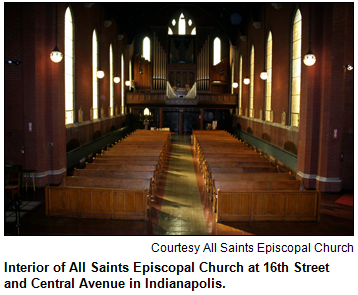 Question: Name the Episcopalian priest whose ordination made headlines in 1977.
Question: Name the Episcopalian priest whose ordination made headlines in 1977.
The prize is admission for four to the Indiana Experience at the Indiana History Center, a gift certificate to Le Peep Restaurants, and two passes to the Crown Hill Cemetery public tours, courtesy of Visit Indy.
Last week's answer
By request, we are publishing the answer to last week's History Mystery, in case you didn't catch it on the air. The Oct. 12 History Mystery answer is: GEORGE McGINNIS.
In 1969, many sports analysts considered him the best high school athlete in the country because of his basketball exploits at Washington High School. He propelled the team to an unbeaten season, then drew headlines with a 35-point scoring "eruption" during the state championship game at Hinkle Fieldhouse.
After leading the Big Ten in scoring at Indiana University, McGinnis - who, at six-feet-eight, became known as "Big Mac" - thrilled fans of the Indiana Pacers. He played for the Pacers for four seasons (1972-75), before leaving to play for teams such as the Philadelphia 76ers, then returned to the Pacers in 1979.
Since retiring as a player three years later, George McGinnis has remained in the public eye as an Indianapolis-based business executive and, for many years, a TV and radio sportscaster.
Coliseum and Clowes Hall histories
|
(Oct. 12, 2013) - The Coliseum at the Indiana State Fairgrounds - site of some of the most joyous and colorful events in Indy history, as well as some of the most tragic episodes - is undergoing a $63 million renovation.
Clowes Hall, which opened in 1963 at Butler University amid great uncertainty about its chances for success, is celebrating its 50th anniversary.
What better time to explore the histories of these two landmark venues?
Chapters in their stories include concerts in 1964 by the Beatles; an explosion during an ice show on Halloween night in 1963 that remains among the most massive tragedies in state history; performances by household names ranging from Bob Hope, Judy Garland and Liberace to the Bolshoi, and public speakers including Coretta Scott King, Robert Kennedy Jr. and Indy native Kurt Vonnegut.
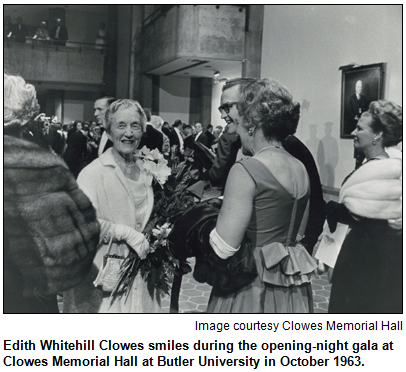 To explore the events, crises, celebrations and backstage stories that have unfolded at the Coliseum and Clowes, Nelson is joined in studio by three guests. They are Justin Armstrong, director of advancement at the Indiana State Fair Foundation, James Cramer, community relations manager at Clowes, and Christine Thacker, the Clowes archivist.
To explore the events, crises, celebrations and backstage stories that have unfolded at the Coliseum and Clowes, Nelson is joined in studio by three guests. They are Justin Armstrong, director of advancement at the Indiana State Fair Foundation, James Cramer, community relations manager at Clowes, and Christine Thacker, the Clowes archivist.
The Coliseum, which opened in the fall of 1939, was constructed under Franklin D. Roosevelt's Public Works Administration. Its 11,000 seating capacity made the Coliseum the largest event facility in Indy then.
Three years later, the venue hosted its first basketball game, during which the Indiana High School All-Stars defeated the Kentucky High School All-Stars by one point. In 1967, the Coliseum became the home court of the Indiana Pacers, then playing in (and, eventually, three-time champions of) the American Basketball Association.
According to guests James and Christine, the opening of Clowes was a "huge gamble - they bet the farm." But the venue went on to host appearances by Barbra Streisand, Whitney Houston, John Travolta and other entertainers who either were (or became) icons.
To celebrate the 50th anniversary of Clowes, artwork by Hoosiers will be displayed as part on an on-going "mosaic of visual art" throughout the 2013-14 season. 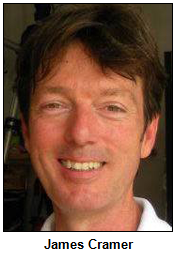 The public is invited to a free open house and mosaic unveiling on Oct. 20 at 4 p.m. For more info about other 50th-anniversary festivities, visit cloweshall.org.
The public is invited to a free open house and mosaic unveiling on Oct. 20 at 4 p.m. For more info about other 50th-anniversary festivities, visit cloweshall.org.
At the renovated Coliseum, which is scheduled to reopen next summer, the Art Deco exterior is being restored. The new interior will include double-tiered seating, a new video scoreboard and a modern sound system.
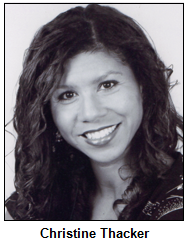 If the Coliseum endured wear and tear over the decades, it shouldn't be a shocker, given some of the events that were staged in the venue. In 1974, the Coliseum was the setting for the first - and largest - indoor tractor pull in the country.
If the Coliseum endured wear and tear over the decades, it shouldn't be a shocker, given some of the events that were staged in the venue. In 1974, the Coliseum was the setting for the first - and largest - indoor tractor pull in the country.
Longtime listeners of Hoosier History Live! will recall that we explored the 1963 Holiday on Ice explosion at the Coliseum during a show in October 2008 with Lawrence "Bo" Connor, a retired managing editor of The Indianapolis Star. He reported from the scene of the tragedy, during which 74 people were killed and about 400 more were injured.
And during another show, we delved into the Beatles appearances with two guests who, as ardent teenage fans of the wildly popular "Fab Four," attended their 1964 concerts at the Coliseum. Both guests recalled they could not "hear a note of music" because of the screaming teens.
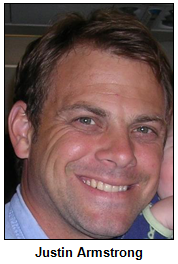 Both the Beatles concerts and the tragic explosion will be explored during our upcoming show. A plaque near the Coliseum's main doors memorializes the victims of the explosion, which occurred 50 years ago this month. Propane - being used to keep popcorn warm - leaked from a faulty valve into an unventilated room beneath the grandstands. The blast hurled a 50-foot section of spectators, chairs and concrete into the air and on the ice.
Both the Beatles concerts and the tragic explosion will be explored during our upcoming show. A plaque near the Coliseum's main doors memorializes the victims of the explosion, which occurred 50 years ago this month. Propane - being used to keep popcorn warm - leaked from a faulty valve into an unventilated room beneath the grandstands. The blast hurled a 50-foot section of spectators, chairs and concrete into the air and on the ice.
That same year of 1963, Clowes Hall opened. Built for $3.5 million and designed by a partnership that included Indianapolis architect Evans Woollen, the performing arts hall became the home of the Indianapolis Symphony Orchestra for 20 years. (The orchestra moved to Circle Theatre on Monument Circle in 1984 following a major renovation of what is now known as the Hilbert Circle Theatre.) As part of the 50th anniversary celebrations, the symphony will return to Clowes with a Pixar in Concert performance on Oct. 27.
As the venue for productions ranging from touring Broadway shows to ballet, opera and pop concerts by the likes of Duke Ellington, Big Bird and the Four Tops, Clowes Hall "ushered in a new era in the city's cultural history," as the Encyclopedia of Indianapolis puts it.
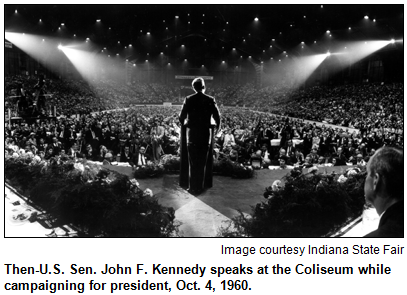 According to a recent Indianapolis Monthly article, the Clowes staff arranged for a Rolls Royce to shuttle opening weekend performer Bob Hope. But the famous comedian was a spokesman for Chrysler and could not be seen in any other vehicle, according to an anecdote that the magazine attributes to our guest Christine Thacker. During our show, Nelson has Christine explain how the awkward situation unfolded.
According to a recent Indianapolis Monthly article, the Clowes staff arranged for a Rolls Royce to shuttle opening weekend performer Bob Hope. But the famous comedian was a spokesman for Chrysler and could not be seen in any other vehicle, according to an anecdote that the magazine attributes to our guest Christine Thacker. During our show, Nelson has Christine explain how the awkward situation unfolded.
We also will explore behind-the-scenes stories associated with the Coliseum, which has been a home of Indy's various pro hockey teams since it opened. Currently, it is the home of the Indiana Ice of the U.S. Hockey League.
During their colorful "ABA years" at the Coliseum, the Pacers won national championships in 1970, 1972 and 1973; they became the most successful team in the history of the former league, which played with red, white and blue balls. Coached by Terre Haute native Bobby "Slick" Leonard, the Pacers captivated crowds at the Coliseum until 1974, when Market Square Arena replaced it as the team's home.
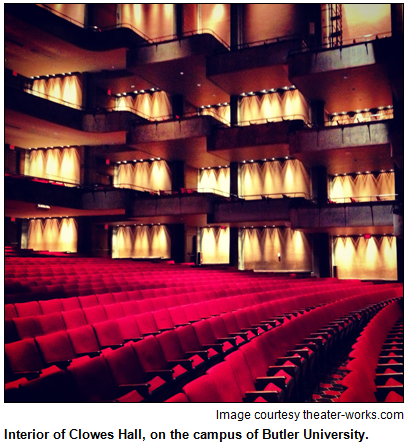 The massive renovation of the Coliseum that's currently underway began in October 2012. Part of the project, the new Youth Arena ice rink, opened this week. After the fully renovated Coliseum reopens next August, it is expected to host everything from major livestock shows and the concert series during the Indiana State Fair to high school graduation ceremonies and touring national concerts.
The massive renovation of the Coliseum that's currently underway began in October 2012. Part of the project, the new Youth Arena ice rink, opened this week. After the fully renovated Coliseum reopens next August, it is expected to host everything from major livestock shows and the concert series during the Indiana State Fair to high school graduation ceremonies and touring national concerts.
Fun facts:
- The Coliseum cost $1.2 million to build in 1939. Initially, its major purpose was to be a livestock pavilion. Construction employed hundreds of Hoosiers, with the federal government picking up 55 percent of the cost because it was a WPA project.
- According to the Indianapolis Monthly article, actress Faye Dunaway made multiple demands before a 1997 performance at Clowes. She also commandeered a dressing room intended for 30 people.
- The largest crowd for a sports event at the Coliseum occurred in 1951. Nearly 13,680 spectators packed the venue to watch the Harlem Globetrotters.
Roadtrip: Crispus Attucks Museum in Indianapolis
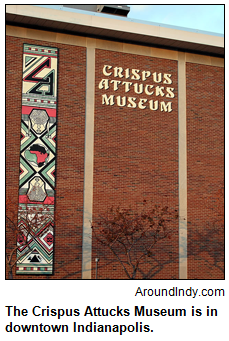 Guest Roadtripper is Kisha Tandy of the Indiana State Museum, who suggests that we take the Roadtrip to the Indianapolis Public Schools Crispus Attucks Museum, located at Attucks High School in downtown Indianapolis.
Guest Roadtripper is Kisha Tandy of the Indiana State Museum, who suggests that we take the Roadtrip to the Indianapolis Public Schools Crispus Attucks Museum, located at Attucks High School in downtown Indianapolis.
Crispus Attucks (c. 1723-1770) was an African American who is believed to be have been the first person shot to death by the British during the Boston Massacre prior to the Revolutionary War.
The Crispus Attucks Museum is located at 1140 Dr. Martin Luther King Jr. St. on the newly renovated campus of the historic Crispus Attucks Medical Magnet High School.
The museum is filled with historic treasures that date back to the late 19th-century African American experience in Indianapolis, and particularly that of the first all-black high school in the state of Indiana.
History Mystery
During the American Basketball Association era, when the Indiana Pacers began thrilling spectators at the State Fairgrounds Coliseum, a future star on the team was causing a sensation at the high school level.
 Born in Indianapolis, he led a local high school team to an unbeaten season and the state championship before being named "Mr. Basketball" of 1969 by the Indianapolis Star.
Born in Indianapolis, he led a local high school team to an unbeaten season and the state championship before being named "Mr. Basketball" of 1969 by the Indianapolis Star.
He went on to hoops triumphs at Indiana University before becoming an outstanding pro player in the 1970s, beginning with the Indiana Pacers of the ABA. The hometown star eventually helped take the team to championship titles in the ABA league.
Question: Who is he?
The prize is admission for four to the Indiana Experience at the Indiana History Center, and a pair of tickets to the Indiana State Museum, courtesy of Visit Indy.
Amish in Indiana
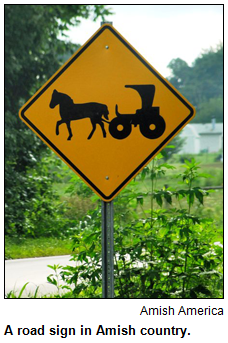 (Oct. 5, 2013) - Only two states, Ohio and Pennsylvania, have larger Amish populations than Indiana.
(Oct. 5, 2013) - Only two states, Ohio and Pennsylvania, have larger Amish populations than Indiana.
The 49,000 Amish residents here live in about 22 distinct communities scattered across the state, from Elkhart and LaGrange counties in northern Indiana to settlements near the towns of Washington in southern Indiana, as well as Berne and Geneva in the northeast.
"What is it about the Amish that both enchants and perplexes us? ... Could a horse-and-buggy people be more satisfied than the rest of us, with all our modern conveniences?"
Those questions are posed in a new book whose co-author, Steven Nolt, a history professor at Goshen College, is Nelson's guest to explore all aspects of the "intensely private and insular" folks, who, as his latest book puts it, are "known for their simple clothing, plain lifestyle and limited technology."
Steve's co-authors of The Amish (Johns Hopkins University Press, 2013) are Donald Kraybill and Karen Johnston-Weiner. In addition, Steve is the author or co-author of several other books about the Amish and has collaborated on multiyear research projects about their religion, history and distinctive culture.
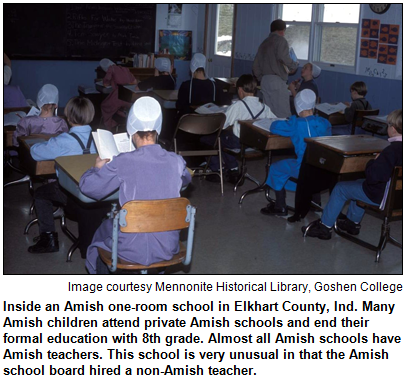 We explore aspects of the ever-increasing population of Amish (the average family has seven children), ranging from their values and schools to their shift from an almost exclusive focus on farming to jobs in factories and businesses such as the RV industry in the Elkhart area - even though the Amish do not own or drive motor vehicles.
We explore aspects of the ever-increasing population of Amish (the average family has seven children), ranging from their values and schools to their shift from an almost exclusive focus on farming to jobs in factories and businesses such as the RV industry in the Elkhart area - even though the Amish do not own or drive motor vehicles.
According to The Amish, about two-thirds now support themselves in Amish-owned small businesses or by working in non-Amish factories and shops.
Steve also addresses misconceptions about the Amish, who recently have become, as his book puts it, "popular culture icons of tourism and reality TV shows, even as they have deftly learned to flourish in a digital world."
He points out that the Amish are not homogeneous. Some communities in Indiana include families who send their children to public schools until the eighth grade; children in other communities almost exclusively attend private schools. 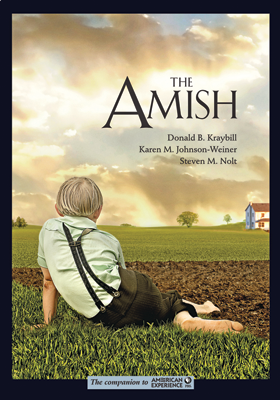 (In Adams County, our host Nelson recently was part of a group that visited a one-room Amish schoolhouse attended by students ranging from 6 to 15 years old, all instructed by a single, bearded teacher.)
(In Adams County, our host Nelson recently was part of a group that visited a one-room Amish schoolhouse attended by students ranging from 6 to 15 years old, all instructed by a single, bearded teacher.)
Founded more than 300 years ago in Europe as an offshoot of the Anabaptist Christians, the Amish Church faced persecution. The first Amish settled in Pennsylvania during the 1730s. According to The Amish, many families headed west - including to Ohio and Indiana - during the 1800s because of rising land prices in the eastern United States.
In northern Indiana, the towns of Nappanee and Shipshewana- both with Amish communities that date to the 19th century - have been popular in recent decades for tourists and shoppers intrigued by products such as quilts and baked goods. The Amish typically refer to outsiders as, simply, "the English."
Steve also is the co-author of Mennonites, Amish, and the American Civil War (Johns Hopkins University Press, 2007). That book documents how many Amish communities strived to remain pacifists and refused military service in the Civil War.
Voting patterns, though, often reflected those of their "English" neighbors. Amish in Holmes County, Ohio, which today has the country's largest concentration, tended to vote Democratic, the dominant political party in that region during the Civil War era. In LaGrange County, where the GOP dominated, Amish tended to vote Republican.
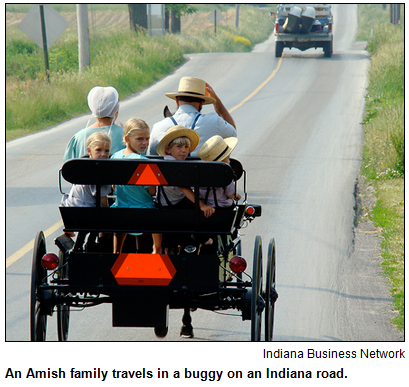 In The Amish, Steve and his co-authors explore Rumspringa (which translates as "running around"), the rite of passage when adventurous teenagers in many Amish communities enjoy the freedom to experiment with cultural influences before deciding whether to be baptized and officially join the church.
In The Amish, Steve and his co-authors explore Rumspringa (which translates as "running around"), the rite of passage when adventurous teenagers in many Amish communities enjoy the freedom to experiment with cultural influences before deciding whether to be baptized and officially join the church.
During our show, Steve and Nelson explore misconceptions about Rumspringa, which drew widespread attention in the late 1990s following a series of alcohol and drug arrests of "wilding" Amish teenagers.
Typically, Rumspringa ends with marriage, according to The Amish. Activities during the rite of passage vary widely among Amish communities, with many youth never engaging in mischief.
"In other communities, some youth own cars, hit the party scene and give their parents anxious nights."
Other insights, courtesy of Steve Nolt and The Amish:
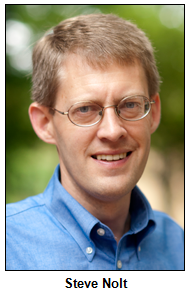 The U.S. Supreme Court in 1972 upheld the rights of Amish parents to end their children's education after the eighth grade. Before that, Amish families were prosecuted in some states.
The U.S. Supreme Court in 1972 upheld the rights of Amish parents to end their children's education after the eighth grade. Before that, Amish families were prosecuted in some states.- The Amish practice "shunning" to shame adult members who violate a community's beliefs. As with Rumspringa, the manner and severity of shunning (social avoidance) varies greatly among Amish groups. "Members may shake hands with offenders, but not accept anything - gifts, payments or money - directly from their hands," according to The Amish.
- About two-thirds of the Amish live in the northern part of the state, with LaGrange and Elkhart counties having the largest concentrations. Nearly 22,000 Amish people live in those two counties. The Amish population in Adams County is 7,200; in Daviess County in southern Indiana, it is 3,805.
- Overall, only about 14 percent of the Amish today are full-time farmers, according to some reports. In contrast, 61 percent were farmers in 1970. In addition to holding jobs in RV factories, many Amish in Indiana work in furniture-making and home construction.
Learn more: Watch the PBS documentary The Amish. Steve Nolt's new book is a companion to the PBS documentary, which is part of the American Experience series.
Roadtrip: Summit Lake State Park
|
Guest Roadtripper is Ken Marshall, an adjunct professor of communications and lifelong Indiana state park lover. He suggests we take the Roadtrip just a little north of New Castle to a hidden treasure, Summit Lake, which he says is never crowded.
The name "Summit Lake" comes from the fact that the area has the highest point of elevation in the immediate region. The area also has excellent fishing -and swimming, boating, hiking and camping - and it's also a great birding area.
Tune in on Saturday for more from Ken!
History Mystery
The Swiss heritage town of Berne in northeastern Indiana is located in Adams County, where some estimates indicate 12 percent of the population is Amish. In late July, Berne hosts a Swiss Days celebration that salutes its heritage. The town, which has about 4,000 residents, also includes Swiss Heritage Village, an outdoor museum.
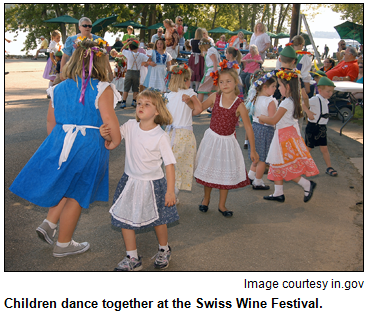 In another region of Indiana, a town on the Ohio River also has a Swiss-themed festival. The 42nd annual Swiss Wine Festival was held during late August in the town, which is celebrating its bicentennial this year. The wine festival is a salute to a Swiss immigrant family whose vineyard in the fertile soil near the Ohio River began in the early 1800s.
In another region of Indiana, a town on the Ohio River also has a Swiss-themed festival. The 42nd annual Swiss Wine Festival was held during late August in the town, which is celebrating its bicentennial this year. The wine festival is a salute to a Swiss immigrant family whose vineyard in the fertile soil near the Ohio River began in the early 1800s.
Question: What is the Ohio River town that celebrates a Swiss Wine Festival?
Hint: The town, and the county in which it's located, were the focus of a recent Hoosier History Live! show.
The prize is a gift certificate to the Hard Rock Café in downtown Indianapolis, two tickets to GlowGolf, a miniature golf course across from the food court at Circle Centre mall in Indianapolis, and admission for four to the Indiana Experience at the Indiana History Center, courtesy of Glow Golf and Visit Indy.
Interurbans: Their rise and fall across Indiana
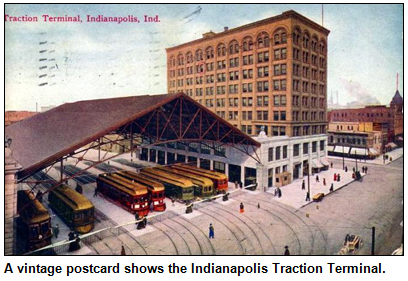 (Sept. 28, 2013) - With the fate of Amtrak service in Indiana making recent headlines, and mass transit always a hot topic, consider this:
(Sept. 28, 2013) - With the fate of Amtrak service in Indiana making recent headlines, and mass transit always a hot topic, consider this:
Interurbans were intercity electric railways popular 100 years ago - and, believe it or not, the Hoosier state had one of the most extensive systems in the entire country.
The first interurban line in Indiana opened in 1898, from Anderson to Alexandria. The first interurban to Indy opened on New Year's Day in 1900 and brought passengers from Franklin and Greenwood to the Hoosier capital.
Interurban lines connected small towns with most of Indiana's big cities and the cities with each other. Lines radiated from Indianapolis to Fort Wayne, Louisville, Lafayette, Peru, Terre Haute and Richmond (and six other routes). These interurbans then connected with others, reaching Chicago, Toledo, Columbus, and even farther. A separate hub centered on Evansville.
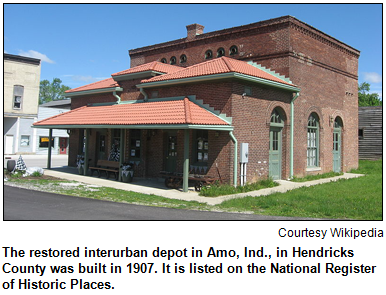 The bygone Traction Terminal in downtown Indianapolis - which opened in 1904 - was easily the nation's largest interurban station. A nine-story building with a train shed, the Traction Terminal was demolished in 1972.
The bygone Traction Terminal in downtown Indianapolis - which opened in 1904 - was easily the nation's largest interurban station. A nine-story building with a train shed, the Traction Terminal was demolished in 1972.
Today, the only remaining passenger interurban in the state - and one of the few left in the country - is the popular South Shore line that links South Bend with Chicago. The final interurban departed from Indianapolis in September 1941, bound for Seymour.
What happened to the electric railways beloved by earlier generations of Hoosiers? Why was Indiana in the national forefront with them? And why did interurbans vanish from the Indiana landscape?
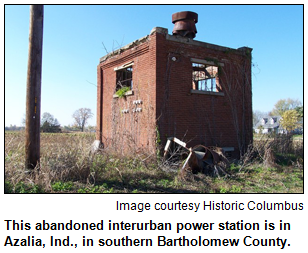 To explore the rise and fall of the interurban system, Nelson is joined in studio by two experts:
To explore the rise and fall of the interurban system, Nelson is joined in studio by two experts:
- Nathan Bilger, the planning director for the town of Whiteland in Johnson County. Nathan grew up in Columbia City, lives in Greenfield, and has extensively researched interurban and railroad lines throughout Indiana. Here is the website about Indiana railroading that Nathan maintains.
- And Craig Berndt of Fort Wayne, the author of The Toledo and Chicago Railway Company (2007), a book about one of the interurban lines that served travelers in northeastern Indiana, including residents of towns in his home turf of DeKalb County.
According to Electric Railroads of Indiana (Hoosier Heritage Press, 1980) by Jerry Marlette, a total of 111 different interurban companies operated more than 3,000 cars in the Hoosier state during the interurban era. 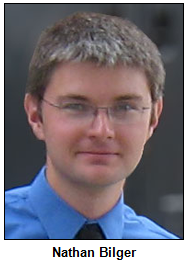 Only Ohio had more miles of interurban lines than Indiana's 2,100 miles under wire.
Only Ohio had more miles of interurban lines than Indiana's 2,100 miles under wire.
Vestiges of the interurbans do still remain. In southern Marion County, the contemporary names of some streets - Stop 11 Road, for example - date to their heritage as stops on an interurban line.
As our guests Nathan and Craig join Nelson, they explore everything from the reliability of the interurban lines to various wrecks, including an accident that involved some of the cars on the final Indy-to-Seymour segment.
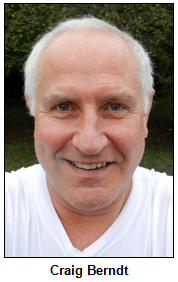 Fun fact: Although the interurban system was designed to shuttle passengers between (not within) towns, travelers in Indy during the early 1900s rode the interurban to Broad Ripple and Irvington. That's because they were distinctively separate villages then, not having been annexed yet into the Hoosier capital.
Fun fact: Although the interurban system was designed to shuttle passengers between (not within) towns, travelers in Indy during the early 1900s rode the interurban to Broad Ripple and Irvington. That's because they were distinctively separate villages then, not having been annexed yet into the Hoosier capital.
Of Indiana's 92 counties, 68 were served by at least one interurban line. In addition to the massive Traction Terminal in downtown Indy, Muncie was known for its impressive interurban station.
Interurbans competed for passengers with steam railroads whose terminals included the majestic Union Station in Indy. Running much more frequently during the day than passenger trains, the electric interurbans were tethered to power lines running above their tracks. According to several sources, few systems of transportation ever developed as quickly as the electric interurbans, and probably none disappeared as quickly.
Could the interurban system be successfully revived? Nelson poses that question to Nathan and Craig.
Roadtrip: Feast of the Hunters' Moon, Oct. 5-6
|
Guest Roadtripper and photo historian Joan Hostetler of Heritage Photo & Research Services suggests we take a Roadtrip to the West Lafayette area for the annual Feast of the Hunters' Moon celebration coming up on Oct. 5-6.
The festival is a re-creation of the annual fall gathering of the French and Native Americans that took place at Fort Ouiatenon, a fur-trading outpost, in the mid-1700s. It is held annually in early autumn on the banks of the Wabash River, four miles southwest of West Lafayette, Ind.
Joan tells us that Historic Fort Ouiatenon Park is a primitive country setting on South River Road, and the grounds stretch across more than 30 acres along the banks of the Wabash River.
Thousands of participants re-enact this event, creating a feast for your senses: Smell the wood smoke, hear the report of the rifles, savor authentic food and more.
History Mystery
Amid much fanfare, the Traction Terminal opened in 1904 at a high-visibility site in downtown Indianapolis. It was by far the nation's largest interurban station. The nine-story building and train shed remained at the site for nearly 70 years.
Designed by the D.H. Burnham & Company architectural firm, the Traction Terminal was a downtown landmark for generations of Hoosiers as the hub of the state's electric rail system.
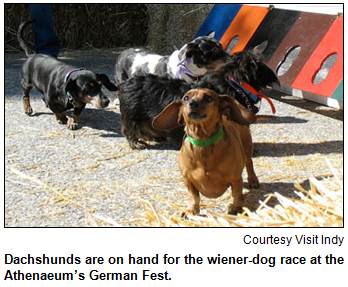 But little attention was paid to its demolition in 1972, decades after the last interurban had departed from the Hoosier capital.
But little attention was paid to its demolition in 1972, decades after the last interurban had departed from the Hoosier capital.
Question: Name the high-visibility site - the downtown Indy street corner - of the bygone Traction Terminal.
The prize is two tickets to the 5th Original and Fabulous GermanFest on Oct. 12, 4 tickets to GlowGolf, a miniature golf course across from the food court at Circle Centre mall in downtown Indianapolis, courtesy of Visit Indy and GlowGolf, and admission for four to the Indiana Experience at the Indiana History Center, courtesy of the Indiana Historical Society.
On the roads: Lincoln Highway and U.S. 40 heritage
|
(Sept. 21, 2013) - Tune in for a history road trip as we cruise through the heritage of two east-west highways that span the entire width of the Hoosier state. Both have a billboard-high heap of other distinctions as well.
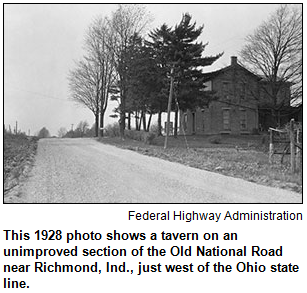 In fact, the Lincoln Highway, which opened in 1913 as a result of a national crusade spearheaded by a famous Hoosier, is celebrating its 100th birthday. Extending from New York to San Francisco - and cutting completely across northern Indiana - the Lincoln Highway became, as USA Today recently put it, "the nation's first truly transcontinental road."
In fact, the Lincoln Highway, which opened in 1913 as a result of a national crusade spearheaded by a famous Hoosier, is celebrating its 100th birthday. Extending from New York to San Francisco - and cutting completely across northern Indiana - the Lincoln Highway became, as USA Today recently put it, "the nation's first truly transcontinental road."
Beginning in the 1920s, U.S. 40 also traversed the entire country, including Indiana, where the highway stretches from Richmond to Terre Haute. For much of Indiana, U.S. 40 follows the route of the Old National Road, which pioneers in covered wagons used to settle in western frontiers after the roadway was created across Indiana in the 1830s.
You can listen to our 2009 show about the Indiana National Road with historic preservationist Jim Glass here.
For this radio road trip, Nelson is joined in studio by two guests:
- Indianapolis-based public historian (and frequent guest Roadtripper) Glory-June Greiff, who grew up near the Lincoln Highway in the northern Indiana town of New Carlisle.
- Joe Frost, executive director of the Indiana National Road Association. Joe also is the community preservation specialist in Cambridge City at the eastern regional office of Indiana Landmarks.
So, who kicked off the national crusade to create the Lincoln Highway?
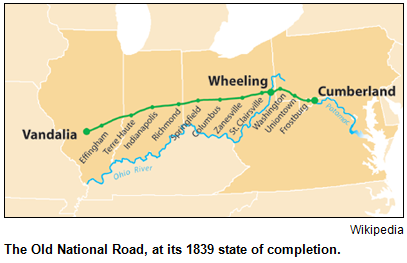 None other than Greensburg native Carl Fisher, the entrepreneur who, with various partners, built the Indianapolis Motor Speedway and launched the Indianapolis 500 in 1911.
None other than Greensburg native Carl Fisher, the entrepreneur who, with various partners, built the Indianapolis Motor Speedway and launched the Indianapolis 500 in 1911.
Glory-June was Nelson's guest in 2009 for a show about Fisher's colorful life; listen to that show here.
As the founder of the Lincoln Highway Association, Fisher advocated the creation of a transcontinental roadway during an era in the automobile's infancy, when long-distance travel almost always was by railroad.
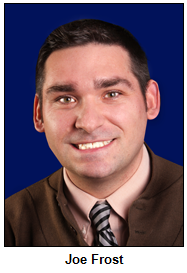 "Paved roads existed only in cities and towns, and auto travel on rutted, unpaved byways was not for the faint of heart," the USA Today article notes.
"Paved roads existed only in cities and towns, and auto travel on rutted, unpaved byways was not for the faint of heart," the USA Today article notes.
Some nuggets:
- The Old National Road was the nation's first federally funded highway. When construction of the dirt road through the wilderness began, starting in Maryland in 1811, civic leaders dreamed it would span the rapidly expanding country. Alas, the pioneer road ended in Illinois - at the town of Vandalia - when funds dried up.
- In Indianapolis, U.S. 40 - and, before its construction, the National Road - takes the name Washington Street.
- In addition to Indy, Richmond, Cambridge City and Terre Haute, Hoosier cities located on U.S. 40 include Centerville, Knightstown, Greenfield, Plainfield and Brazil.
- In some towns, such as Plainfield and Greenfield, U.S. 40 is known by the local name of Main Street. In Brazil, U.S. 40 is called National Avenue.
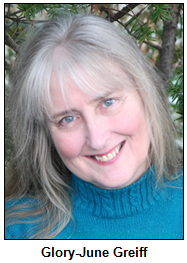 To spotlight the Lincoln Highway, Carl Fisher arranged for statues of Abraham Lincoln to be placed along the route.
To spotlight the Lincoln Highway, Carl Fisher arranged for statues of Abraham Lincoln to be placed along the route.
There is an Indiana Lincoln Highway Association. Hoosier cities located on the Lincoln Highway included Fort Wayne, South Bend, Valparaiso and Elkhart. Beginning in the 1920s, the name "Lincoln Highway" began to disappear as the numbered highway system was established across the country.
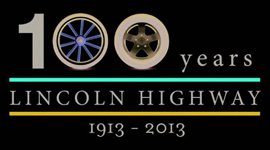 And beginning in the mid-1920s, Indiana had the distinction of offering two "routes" for the Lincoln Highway with the creation of a second option that traversed the state farther south, running from Fort Wayne to Chicago through Columbia City and Warsaw.
And beginning in the mid-1920s, Indiana had the distinction of offering two "routes" for the Lincoln Highway with the creation of a second option that traversed the state farther south, running from Fort Wayne to Chicago through Columbia City and Warsaw.
Contemporary highways in Indiana that reflect the routes of the Lincoln Highway - or portions of them - are U.S. 20, U.S. 30 and U.S. 33.
On U.S. 40 across the Hoosier state, landmarks range from historic farmhouses to skyscrapers and suburban strip malls. 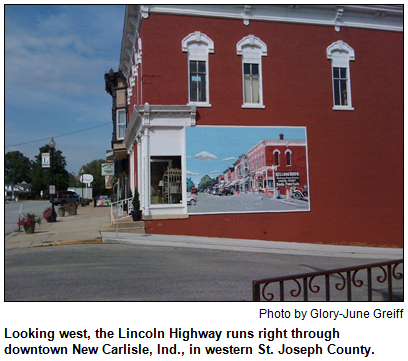 They include the Huddleston Farmhouse in Cambridge City, a brick residence built in the 1840s by a Quaker family with eleven children. The farmhouse, which offered overnight lodging for travelers headed west on the historic National Road, today includes a museum as well as Indiana Landmark's regional office, where our guest Joe Frost works.
They include the Huddleston Farmhouse in Cambridge City, a brick residence built in the 1840s by a Quaker family with eleven children. The farmhouse, which offered overnight lodging for travelers headed west on the historic National Road, today includes a museum as well as Indiana Landmark's regional office, where our guest Joe Frost works.
In Richmond, U.S. 40 passes a monument known as Madonna of the Trail. Dedicated in 1928, the monument at the edge of Glen Miller Park is a memorial to pioneer mothers of the covered-wagon era; it depicts a steadfast woman holding an infant, with a toddler clinging to her long dress.
Other landmarks on U.S. 40 include the James Whitcomb Riley Boyhood Home and Museum in Greenfield; Circle Centre mall and Victory Field in Indy, and the Metropolis shopping mall in Plainfield.
In the Wabash Valley between Brazil and Terre Haute, roadside landmarks include a large billboard for Clabber Girl Baking Powder that has been on the site since the 1930s.
Across much of the state today, U.S. 40 runs nearly parallel to I-70.
|
Roadtrip: Greencastle's buzz bomb and DePauw's Nature Park
Guest Roadtripper and film historian Eric Grayson tells us that just a hop, skip and a jump from the Old National Road west of Indianapolis is the historic town of Greencastle. The hometown of DePauw University has something unique on its courthouse square: an authentic WWII buzz bomb, the V-1 rockets that Hitler used to bomb London.
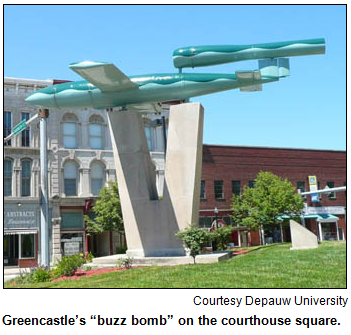 These are the bombs that were used before the silent rockets that were launched by Wernher Von Braun's team. This is the only authentic V-1 that exists in America!
These are the bombs that were used before the silent rockets that were launched by Wernher Von Braun's team. This is the only authentic V-1 that exists in America!
And across from their 1905 courthouse is a really outstanding local restaurant, Almost Home. And if you like desserts, you're a short drive from a 1950s ice cream shop, Dairy Castle.
Eric also tells us that one of the real hidden gems in Greencastle is the DePauw Nature Park, which he says is a great example of outdoor historic re-use. The area was an abandoned gravel pit that had been excavated as close to all the neighboring roads as possible, and the university bought it and turned it into a fascinating nature park. If you like a short hike, you can see places that look like New Mexico, Hoosier swamps, butterfly gardens, frog ponds and two different creek beds. And you can see all kinds of wildlife, even more than you might find at some state parks!
History Mystery
A roadside diner built in the 1950s on U.S. 40 has generated considerable attention in recent years because the once-popular eatery is considered endangered. Designed in the Streamline Moderne style in New Jersey and transported by rail to a town in central Indiana, the diner closed in 2009.
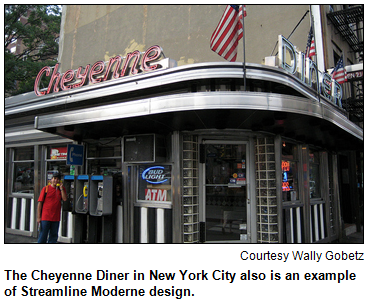 The next year, the vacant diner was named to the "10 Most Endangered Places" list compiled by Indiana Landmarks.
The next year, the vacant diner was named to the "10 Most Endangered Places" list compiled by Indiana Landmarks.
The history and possible fate of the diner - which still has its 1950s interior with pink tiles - has been discussed on two Hoosier History Live! shows and sparked a Facebook crusade to save the landmark. The name of the diner reflects the town where it's located on U.S. 40.
Question: What is the town in central Indiana with the endangered diner?
The prize is a gift certificate to Le Peep Restaurant and two tickets to the NCAA Hall of Champions, courtesy of Visit Indy, and admission for four to the Indiana Experience at the Indiana History Center, courtesy of the Indiana Historical Society.
Party pics!
Lots of smiles at our 5-year anniversary fest
Some nice coverage of our five-year anniversary soiree came from Cathy Kightlinger of the Indianapolis Star, who gave the party a nice writeup:
"When Nelson Price talks history, people listen. That was apparent Thursday when his show, Hoosier History Live!, celebrated its fifth anniversary with a soiree of the state's notables and fans of the show. The event included a few trivia questions (something the Saturday show, which airs at noon on WICR-FM (88.7) is known for) and lots of shoulder rubbing."
Special thanks to Bill Holmes, who took all of the photos below.
Extra thanks to Bill Holmes (who has done photography for five years), Emily Barker, Jeanne Blake, Garry Chilluffo of Chilluffo Media, Mark Szobody, Suzanne Stanis, Hoaglin to Go, Lockerbie Pub, Pam Mitchell (who made the cake), Lorraine Vavul (who made the elegant donation box), Richard Sullivan of Monomedia, Pam Fraizer of Fraizer Designs, Molly Head, Nelson Price, Charlotte Carmichael, Kathy Riester, Mary Kummings, Barbara Goddard, and Lynn Herold. We thank the following new individual donors to Hoosier History Live! Paul J. Fouts, Jr., Rita Kohn, Margaret Sabens, Richard Vonnegut Jr., Margaret Smith, Sharon Butsch Freeland, Don Gorney, Alice Roettger, Maureen Dunlap, Peggy Hollingsworth, Monica Thompson-Deal, Clarke Kahlo, Janet Gilray, Barry Glazer, and Bruce and Julie Buchanan. We thank those whom we count on to keep Hoosier History Live! on the air, on the web and in your in-box! If you’d like to know how to support us, visit our website at Hoosier History Live! We look forward to being around for next year's sixth anniversary - and on into the future with our ever-growing body of history journalism!
|
Cuban immigration to Indiana
Click here to listen to this show!
![]() (Sept. 14, 2013 - online-only encore presentation) - For Sept. 14, Hoosier History Live! was pre-empted on WICR-FM so the radio station could broadcast Yom Kippur services from the Indianapolis Hebrew Congregation. So as a special treat, we made available one of the most popular programs from our Hoosier History Live! archives.
(Sept. 14, 2013 - online-only encore presentation) - For Sept. 14, Hoosier History Live! was pre-empted on WICR-FM so the radio station could broadcast Yom Kippur services from the Indianapolis Hebrew Congregation. So as a special treat, we made available one of the most popular programs from our Hoosier History Live! archives.
The featured program is a show in our rotating series about ethnic immigration to the Hoosier state. We have explored our German, Irish, Italian, Greek, Scottish, Brazilian and even our Sikh heritage in Indiana, among others, during our five-and-a-half years on the air. If you'd like to have a look at our rich archive of past weekly enewsletters, click here.
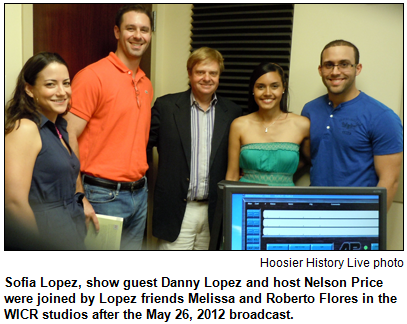 To explore Cuban immigration to Indiana, Nelson is joined in studio by Danny Lopez, who was executive director of the Indiana Commission on Hispanic/Latino Affairs when this show originally was broadcast on May 26, 2012. All four of Danny's grandparents left Cuba in 1960, fleeing political and economic upheavals.
To explore Cuban immigration to Indiana, Nelson is joined in studio by Danny Lopez, who was executive director of the Indiana Commission on Hispanic/Latino Affairs when this show originally was broadcast on May 26, 2012. All four of Danny's grandparents left Cuba in 1960, fleeing political and economic upheavals.
Since he shared intriguing details about our state's Cuban heritage on this show - including identifying Fort Wayne and South Bend as the cities that have had the most concentration of Cuban immigrants - Danny has a new job title, although he remains an administrator with state government. Since the election of Gov. Mike Pence, Danny has been special assistant to the governor.
During our show, he notes that the number of Hoosier with Hispanic/Latino heritage has nearly doubled since the turn of the new century, climbing to 389,000, according to the 2010 U.S. Census. About 85 percent are of Mexican heritage. 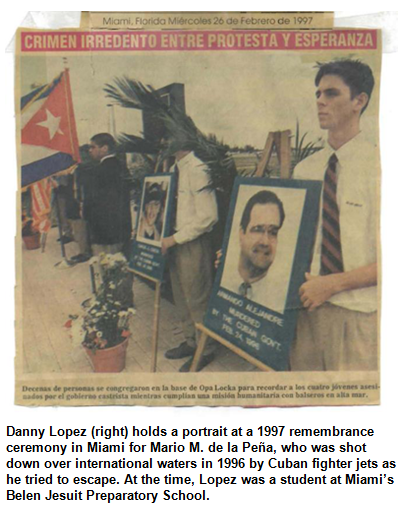 The next largest ethnic groups of Hispanic/Latino heritage in Indiana, according to Danny, are Puerto Ricans, followed by Cubans.
The next largest ethnic groups of Hispanic/Latino heritage in Indiana, according to Danny, are Puerto Ricans, followed by Cubans.
Cuban-Americans here (there are 4,300 of them, Danny reports) differ from their counterparts from other Latin homelands in several ways.
He attributes the concentrations of Cubans (for several generations) in South Bend and Fort Wayne to, respectively, the University of Notre Dame and to Catholic parishes in Fort Wayne that assisted Cuban families, including children during the early 1960s who were evacuated because of the Fidel Castro regime. In terms of the overall Hispanic/Latino population, the largest concentrations are in Indianapolis and in Lake County.
Danny has been a Hoosier since 2008. He grew up in Miami and graduated from an all-male, Jesuit-run preparatory school there that had been attended by his ancestors in Havana. Danny's wife, Sofia, also is Cuban-American; her grandfather graduated from Notre Dame.
Danny's paternal grandfather attended his alma mater, the Jesuit-run prep school, but it had a different setting then. As Danny discusses during the show, the prep school was based in Havana, not Miami, during his grandfather's era.
With increasing waves of Hispanic/Latino immigration to Indiana and other states, concerns have been expressed about "linguistically challenged" children in schools. In some immigrant households, as Danny notes, young children are the only English speakers among the family members.
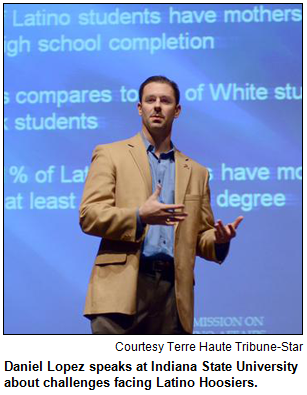 But Danny also emphasizes that a reverse effect has the potential for unnecessarily limiting the advancement and talents of Hispanic and Latino children.
But Danny also emphasizes that a reverse effect has the potential for unnecessarily limiting the advancement and talents of Hispanic and Latino children.
"We have concerns that many Hispanic families are not encouraging their kids to develop, or even keep, their fluency in Spanish," he said. "The parents want their children to assimilate so badly that they are discouraging their Spanish language usage. Obviously, though, fluency in Spanish will be a tremendous asset for professional opportunities later in life."
Unlike surrounding Midwestern states that have experienced only slight population increases or, in the case of Michigan, even lost residents since the turn of the 21st century, Indiana’s population climbed 6.6 percent. According to an Indianapolis Star analysis of 2010 U.S. Census data, Hispanics accounted for 43 percent of the population increase in the Hoosier state.
Click here to listen to this show!
"Learn more" web links:
- A video of an interview with guest Danny Lopez on Newsmakers from WNIN in Evansville, Ind., about Hispanic and Latino affairs.
- An article from the Miami Herald about "Operation Peter Pan" or "Pedro Pan." From 1960 to 1962, about 14,000 Cuban children were flown to Miami as refugees without their parents because their parents feared for their safety under Castro.
- A report from the Kelley School of Business about Indiana's Latino population.
- A Youtube about the history of Operation Pedro Pan.
Thanks to UIndy student Derrick Lowhorn for editing this podcast.
Roadtrip: Ernesto Gonzalez on Indy Latin dance scene
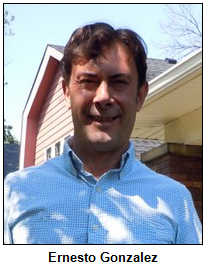 Cuban-born Indy resident Ernesto Gonzalez steps up to talk about one of his personal passions, the Latin and salsa dance scene in Indy. An active dancer himself, Ernesto tells us about the Jazz Kitchen, the Red Room, and other hot spots around town on this online show.
Cuban-born Indy resident Ernesto Gonzalez steps up to talk about one of his personal passions, the Latin and salsa dance scene in Indy. An active dancer himself, Ernesto tells us about the Jazz Kitchen, the Red Room, and other hot spots around town on this online show.
Ernesto came to Indy in 1980 as a 17-year-old, being sponsored by the Indiana Catholic Conference at 1400 N. Meridian St. in downtown Indianapolis.
"I came as a political refugee, completely by myself, speaking no English, with only the clothes on my back," he says.
Ernesto has worked in Indianapolis as a hair designer for 33 years.
"America provides opportunities," he says. "I believe in hard work, and in reaping the rewards of hard work. I also believe that it is very important for everyone coming to this country to learn English."
Ernesto's parents and three siblings still live in Cuba, and 16 years ago Ernesto sponsored one of his brothers in moving to Indianapolis.
History Mystery contest on Facebook
During the 1990s, a city in Indiana elected a Hispanic mayor, one of the first in the state. He won two terms in office as mayor of the Hoosier city, serving from 1996 to 2003. A Democrat, he is the son of Spanish immigrants and was just 35 years old when he first won election as mayor of the city, which has been gaining population for several years.  During his second term in city hall - in 2002 - the mayor launched an unsuccessful campaign for Indiana secretary of state.
During his second term in city hall - in 2002 - the mayor launched an unsuccessful campaign for Indiana secretary of state.
Question: Name the city in Indiana that had a two-term mayor of Hispanic heritage beginning in 1996.
Please do not try to win if you have won any prize on WICR, or on our Facebook contests, within the last two months, so that others can have a chance. By the way, our Facebook winners last week were Wanda and Jane! Be sure to "like" us on Facebook if you haven't yet. And, we're also on Twitter at @hoosierhistlive. A big shout-out to our youthful and beautiful Tweeter, Allison DePrey Singleton; she is a former show guest who told us that we needed to be on Twitter!
Pioneer music in early Indiana
(Sept. 7, 2013 - encore presentation) - The jaw harp was popular. So were the fiddle and dulcimer. Community bands played flutes, whistles and drums.
There even were pianos before 1840 in Indiana, despite the significant challenges of transporting them to frontier communities via horse-drawn vehicles and river boats.
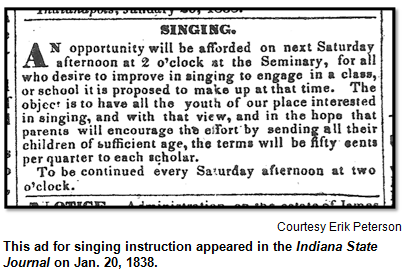 Musical instruments that weren't widely seen (or, in some cases, not present at all) in the Hoosier state of the 1820s, '30s and '40s: the guitar, banjo, harmonica, mandolin, ukulele and accordion.
Musical instruments that weren't widely seen (or, in some cases, not present at all) in the Hoosier state of the 1820s, '30s and '40s: the guitar, banjo, harmonica, mandolin, ukulele and accordion.
To explore all aspects of the music played by pioneer families in Indiana, Nelson is joined in studio by Erik Peterson, an Indianapolis-based musician and historian, on this encore show. (The original air date was Jan. 26, 2013.) Erik has performed at Prairietown at Conner Prairie Interactive History Park and at other history-focused sites.
"Keep in mind that, during the pioneer era, Mozart had not been dead for as long as Buddy Holly has been gone today," Erik says.
He has researched pre-1840 music of central Indiana for a postgraduate degree, thanks in part to a fellowship from the Society of Indiana Pioneers. Adept at various instruments, Erik often performs traditional Irish, American folk and Celtic music with various ensembles, including Hogeye Navvy, an Indy-based band known for sea chanteys.
During our show, he performs a few musical interludes to convey a flavor of the music heard in pioneer Indiana. He has gained insights by tracking down diaries, letters and journals of pioneer families.
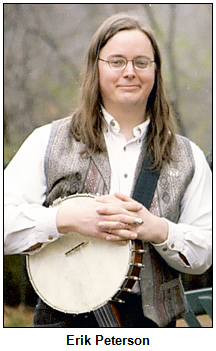 "People in that era were incredibly musical," he says. "Music was a daily part of their lives, and it served as a way to build community among neighbors."
"People in that era were incredibly musical," he says. "Music was a daily part of their lives, and it served as a way to build community among neighbors."
The jaw harp, a hand-held instrument about the size of a harmonica, was played frequently. Erik performs a tune on the instrument during our show, a rare opportunity to hear it. He notes the jaw harp primarily is relegated today to the soundtracks of cartoons.
"The fiddle was king of instruments here during the pioneer era," he says. "It’s loud, and it's portable."
As Hoosier History Live! guests discussed during a show last month about Switzerland County and Life on the Ohio River, the first piano was brought to Indiana in the early 1800s; the historic instrument is exhibited today at Switzerland County Historical Museum in the far-southeastern county on the Ohio River.
The extraordinary efforts undertaken to transport pianos here decades before railroads underscores the importance of music in the lives of pioneers, Erik emphasizes. He points out that many pioneer towns in Indiana even had community bands.
Like later generations, early settlers differed along gender lines when playing musical instruments. But the gender preferences often were reversed from those that unfolded later, Erik says. Many men tended to play flutes and violins, while women played guitars and banjos once those instruments finally made their way to Indiana, primarily after the Civil War.
Before that, advertisements for academies such as the Indianapolis Female Institute touted instruction in piano for young women.
During our show, Erik plays a few verses of a song that would have been played frequently in early Indiana: Hail, Columbia!, the unofficial national anthem of the era. The Star Spangled Banner was not adopted as the official national anthem until 1931, about 100 years after the era that is the focus of our show. Since then, Hail Columbia! primarily has been played to introduce the American vice president.
Roadtrip: Wabash and Erie Canal Park in Delphi
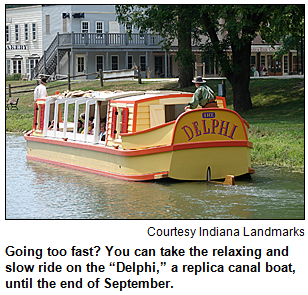 Guest Roadtripper Glory-June Greiff, Indianapolis public historian, has made the day trip several times to the old canal town of Delphi in Carroll County, about 15 miles northeast of Lafayette.
Guest Roadtripper Glory-June Greiff, Indianapolis public historian, has made the day trip several times to the old canal town of Delphi in Carroll County, about 15 miles northeast of Lafayette.
There's plenty of hiking and history at the Wabash and Erie Canal Park in Delphi, which is open year-round and includes an Interpretive Center, lots of trails for hiking and biking, and canal boat rides that continue through the end of September.
Don't miss the Latrrope and Ruffing Opera House and adjacent shops. Glory-June also has an eye for great small-town restaurants; she says Delphi has the Stonehouse Restaurant and Bakery. And for your dining pleasure either coming or going, there is Treece Restaurant in Rossville.
History Mystery contest on Facebook
Harps of all kinds are built in a factory that has become a tourist attraction in a small Indiana town. Located in a former speakeasy, the factory building also includes a venue for concerts of harp music. The family-owned business makes instruments ranging from large symphonic harps to smaller harps, which they call "harpsicles," that are made in an array of colors. The former speakeasy-turned-harp factory is located on Main Street in its scenic hometown.
Question: Name the Indiana town. Since this is an encore show, you won't be able to call in. But if you are the first person to post the correct answer on the Hoosier History Live Facebook page (reference History Mystery in your post), you will win a gift certificate to Le Peep Restaurant, courtesy of Visit Indy, as well as a pass for four to the Indiana Experience at the Indiana Historical Society. You must also be willing to supply your postal address so the prize can be mailed to you.
Winona Lake, Warsaw, orthopedics and Grace College
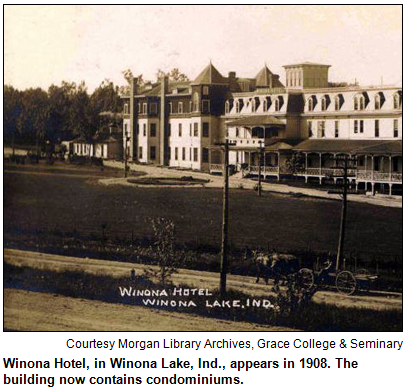 (Aug. 31, 2013) - A scenic county in far-northern Indiana includes a city known as the "orthopedics capital of the country," a lakeside community with a long heritage as a spiritual retreat (one of the country's best-known evangelists of the early 1900s had deep connections to the region) and an evangelical Christian college.
(Aug. 31, 2013) - A scenic county in far-northern Indiana includes a city known as the "orthopedics capital of the country," a lakeside community with a long heritage as a spiritual retreat (one of the country's best-known evangelists of the early 1900s had deep connections to the region) and an evangelical Christian college.
We explore the rich history of Winona Lake, the orthopedics industry and its impact on Warsaw, the heritage of Grace College & Seminary and other aspects related to Kosciusko County, including links to the Potawatomi Indians, colorful evangelist Billy Sunday (1862-1935) and a Bible conference internationally known as the Second Wave.
Nelson is joined in studio by three guests:
- Terry White, co-author of Winona Lake at 100: Third Wave Rising (BMH Books), a book published in connection with the centennial of the resort town of Winona Lake's incorporation in 1913.
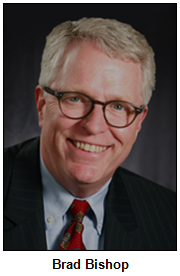 Brad Bishop, executive director of OrthoWorx, a non-profit devoted to ensuring the Warsaw area remains the country's "orthopedics capital." In the 1890s, Warsaw-based DePuy Manufacturing became the world's first manufacturer of orthopedics appliances. Since then, major businesses such as Zimmer and Biomet have been founded in Warsaw, making the city a hub for devices associated with hip and knee replacements.
Brad Bishop, executive director of OrthoWorx, a non-profit devoted to ensuring the Warsaw area remains the country's "orthopedics capital." In the 1890s, Warsaw-based DePuy Manufacturing became the world's first manufacturer of orthopedics appliances. Since then, major businesses such as Zimmer and Biomet have been founded in Warsaw, making the city a hub for devices associated with hip and knee replacements.- And Bill Katip, the president of Grace College & Seminary, which describes itself as "an evangelical Christian community of higher education."
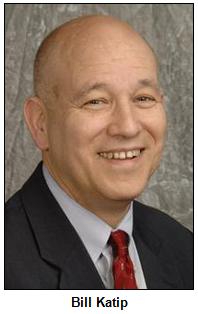 According to Terry's book, the "first wave" of flourishing activity around Winona Lake began during the 1800s with the Potawatomi culture. This wave also included early white settlement and, from 1896 through the 1930s, a Chautauqua Days festival that included secular programs of lectures, recitals and plays often featuring famous Americans. Booker T. Washington spoke at Winona Lake in 1897, as did Helen Keller in 1915 and humorist Will Rogers in 1928.
According to Terry's book, the "first wave" of flourishing activity around Winona Lake began during the 1800s with the Potawatomi culture. This wave also included early white settlement and, from 1896 through the 1930s, a Chautauqua Days festival that included secular programs of lectures, recitals and plays often featuring famous Americans. Booker T. Washington spoke at Winona Lake in 1897, as did Helen Keller in 1915 and humorist Will Rogers in 1928.
The Chautauqua concept - derived from an ongoing cultural festival every summer in western New York - has been revived at Winona Lake in recent years.
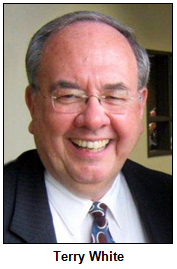 Although Billy Sunday grew up in Iowa and primarily was based in Chicago during most of his preaching years (he first achieved fame as a Chicago baseball player), he settled for part of each year in Winona Lake at a home he called Mount Hood. Built in 1911, the restored home is known today as the Billy Sunday Home Museum.
Although Billy Sunday grew up in Iowa and primarily was based in Chicago during most of his preaching years (he first achieved fame as a Chicago baseball player), he settled for part of each year in Winona Lake at a home he called Mount Hood. Built in 1911, the restored home is known today as the Billy Sunday Home Museum.
The first Bible conference in the area started in 1895, according to Winona Lake at 100; it was begun by Presbyterians. Brethren Church groups also began having general conferences in the resort town in the 1890s.
Subsequently, a corporation was formed to manage Winona Lake's summer Bible conference, which exploded in growth; it was overseen by a board that included household names such as politician William Jennings Bryan and wagon and auto-maker John Studebaker of South Bend. In 1944, Winona Lake also was the setting for the launch of Youth for Christ, an early employer of evangelist Billy Graham. (Historians now often describe Billy Sunday as "the Billy Graham of his era.")
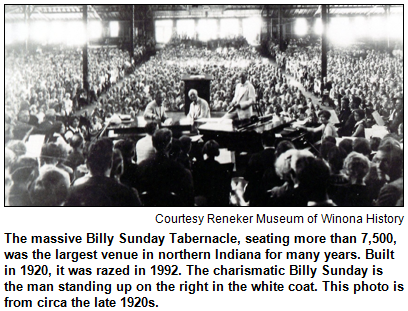 Just like the Bible conference, the orthopedics industry in the region dates to 1895. According to an article in The Indianapolis Star in 2004, entrepreneur Revra DePuy, the founder of DePuy Manufacturing, began a splint-making business "with one key innovation: He used metal instead of wood." One of the company's top employees, J.O. Zimmer, left in the 1920s to form a competing medical device manufacturing company in Warsaw. Our guest Brad Bishop formerly served as Zimmer's director of public affairs.
Just like the Bible conference, the orthopedics industry in the region dates to 1895. According to an article in The Indianapolis Star in 2004, entrepreneur Revra DePuy, the founder of DePuy Manufacturing, began a splint-making business "with one key innovation: He used metal instead of wood." One of the company's top employees, J.O. Zimmer, left in the 1920s to form a competing medical device manufacturing company in Warsaw. Our guest Brad Bishop formerly served as Zimmer's director of public affairs.
According to Winona Lake at 100, Biomet was founded in 1977 by four young entrepreneurs in the orthopedics industry and began pioneering technological advances early on; within three years, it achieved $1.1 million in net sales.
The orthopedics industry now employs more than 6,800 workers in the region, accounting for nearly one in four jobs in Kosciusko County, according to a video on the OrthoWorx website.
For several decades, many students at Grace College in Winona Lake have had internships in the orthopedics industry, according to the Star article. A four-year liberal arts and sciences college with a seminary for masters and doctoral study, Grace College is Brethren-affiliated and began in 1937.
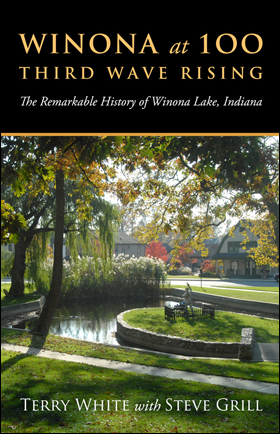 Our guest Bill Katip shares details about Grace College's early days, as well as its recent expansion, through the college's Weber School, to sites in Indianapolis, Fort Wayne and other cities. To celebrate the 75th anniversary of Grace College, its history department will sponsor a seminar Sept. 10 at Westminster Hall on the Winona Lake campus. And as part of Winona Lake's centennial celebrations, our guest Terry White will be among the speakers at a community appreciation dinner Nov. 14, also in Westminster Hall.
Our guest Bill Katip shares details about Grace College's early days, as well as its recent expansion, through the college's Weber School, to sites in Indianapolis, Fort Wayne and other cities. To celebrate the 75th anniversary of Grace College, its history department will sponsor a seminar Sept. 10 at Westminster Hall on the Winona Lake campus. And as part of Winona Lake's centennial celebrations, our guest Terry White will be among the speakers at a community appreciation dinner Nov. 14, also in Westminster Hall.
According to Terry's book, Winona Lake in the 1960s and '70s was a far cry from its earlier heyday. The resort village, he writes, had "declined remarkably, with much of the summer seasonal housing now ramshackle and unsightly."
That era of decline, though, was followed by a resurgence that Terry describes as a "metamorphosis." When he moved back to Winona Lake in 2003 after 26 years away, he discovered a "third wave" that included flourishing arts and culture. The town's historic street, Park Avenue, had become "lined with solid, quaint shops inhabited by artists, photographers, glass blowers, potters and woodworkers."
History Mystery
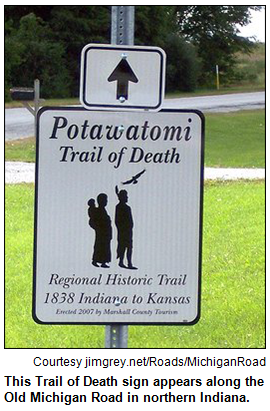 To commemorate the Potawatomi heritage across much of northern Indiana, a Hoosier city hosts a Trail of Courage Living History Festival every September. Like Warsaw and Winona Lake, this "mystery" city has a deep, historic connection with the Potawatomi.
To commemorate the Potawatomi heritage across much of northern Indiana, a Hoosier city hosts a Trail of Courage Living History Festival every September. Like Warsaw and Winona Lake, this "mystery" city has a deep, historic connection with the Potawatomi.
When the tribe was forcibly removed from northern Indiana in 1838 by the forces of Gen. John Tipton, the Potawatomi were marched, single-file, down the city's Main Street. In what became known as the Trail of Death, the Potawatomi were led 900 miles to Kansas.
The Trail of Courage Living History Festival in the "mystery" Indiana city includes Native American music and dance, canoe rides, crafts, historic re-enactments and pioneer food cooked over wood fires.
Question: What city in northern Indiana hosts the festival?
Roadtrip: Glory-June's northern adventure
We’re just going to go with public historian Glory-June Greiff's words here for a few notes about her Roadtrip this Saturday:
"I always love a chance to go to the northern part of our state where the glaciers left behind lots of lakes and rolling terrain. Pokagon State Park in Steuben County is a good excuse. It offers all the activities you'd expect in a state park, but swimming in a real lake is a plus. All this and history, too: The park is listed in the National Register of Historic Places for its many examples of the work of the CCC (Civilian Conservation Corps).
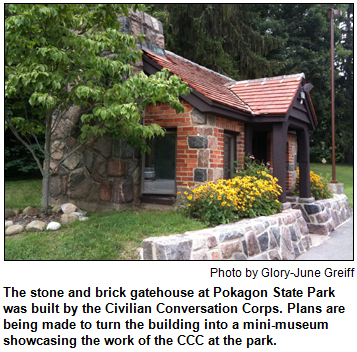 "The park inn is a fine place to eat," says Glory-June, "but I strongly recommend Clay's Family Restaurant (7815 N Old 27, Fremont) just a few miles north of the park, just south of the Michigan state line. Their food is just darned good and their pies are heavenly! Clay's is, after all, the home of the annual Pie Day in June, when, for a fixed price, they offer unlimited samples of every pie they make.
"The park inn is a fine place to eat," says Glory-June, "but I strongly recommend Clay's Family Restaurant (7815 N Old 27, Fremont) just a few miles north of the park, just south of the Michigan state line. Their food is just darned good and their pies are heavenly! Clay's is, after all, the home of the annual Pie Day in June, when, for a fixed price, they offer unlimited samples of every pie they make.
"The area is lovely to explore, what with its lakes, small farms, and small towns. Orland is a very small village, about 10 miles west of Clay's on SR120, but boasts a fish hatchery constructed by the WPA (Works Progress Administration). It, too, is listed in the National Register If you're there on a Tuesday, Wednesday or Saturday, check out the Joyce Library in downtown Orland. It's charming, but ask to see the second floor, where the library first started. Many of us remember when most public libraries looked like this.
"If you’re going up from central Indiana, it's a goodly drive, although you can make Pokagon in less than three hours on I-69. I'd recommend going at least part of the way on the old highways, however, and if you get hungry, stop for a bite at Pembroke Bakery in downtown Fort Wayne.
"Don't let the fact that they offer healthy food deter you - it's really good! But if you’re not convinced, you can always go back in time to Powers Hamburgers at 1402 South Harrison, which was built around 1940. Don't confuse their hamburgers with a certain long-lived chain's sliders. These are meaty and loaded with onions grilled fresh. They also usually have a goodly supply of sweet rolls and doughnuts from the New Haven Bakery (or visit the bakery itself on the old Lincoln Highway! It's at 915 East Lincoln Highway. Enjoy!"
'Ask Nelson' and special-events-in-Indy insights
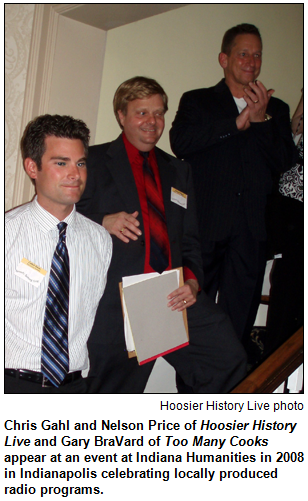 (Aug. 24, 2013) - A couple of times every year at Hoosier History Live!, we like to take full advantage of the fact that we are a live, call-in show - indeed, the only radio show about history in the entire country that offers listener call-in. That means we're able, periodically, to turn the tables on our host, author/historian Nelson Price, open the phone lines and give our listeners an opportunity to question the interviewer who calls himself "a garbage can of useless Hoosier trivia."
(Aug. 24, 2013) - A couple of times every year at Hoosier History Live!, we like to take full advantage of the fact that we are a live, call-in show - indeed, the only radio show about history in the entire country that offers listener call-in. That means we're able, periodically, to turn the tables on our host, author/historian Nelson Price, open the phone lines and give our listeners an opportunity to question the interviewer who calls himself "a garbage can of useless Hoosier trivia."
Along with our invitation to listeners to call the WICR-FM studio - the number is (317) 788-3314 - and pose questions to Nelson, we offer a bonus. In addition to questioning Nelson, who writes books about famous Hoosiers (both historic and contemporary notables) and Indianapolis city history, listeners of this show were able to ask questions of a special guest co-host.
Nelson is joined in studio by special-events impresario Gary BraVard, who has planned scores of the most glittering soirees in Indy for more than 25 years. From private parties to weddings, bar mitzvahs and black-tie fund-raisers featuring visiting celebrities, Gary has been the planner of a staggering array of events in the Hoosier capital.
Gary's credits include events attended by Liza Minnelli, Carol Channing and the late Ted Kennedy.
Nelson's books include Indiana Legends: Famous Hoosiers from Johnny Appleseed to David Letterman (Hawthorne Publishing) and Indianapolis Then and Now (Thunder Bay Press), a visual history about his hometown.
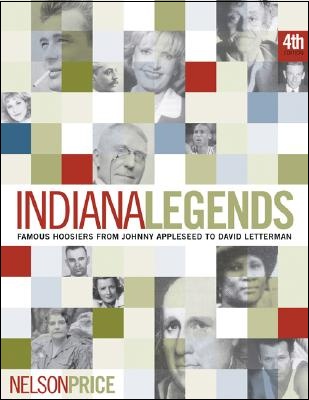 In between phone calls from listeners, Nelson and Gary ask each other questions.
In between phone calls from listeners, Nelson and Gary ask each other questions.
By the way, Gary is no stranger to WICR - or to questions from Nelson. For several years, Gary was the co-host of our "sister" radio show on WICR-FM, Too Many Cooks!, which featured chefs, restaurant owners, dietitians, cookbook authors and foodies as studio guests.
Recently, Gary has been featured on-air as one of the rotating Roadtripper correspondents on Hoosier History Live! Did you catch his report last month about Crown Hill Cemetery, the third-largest private burial ground in the nation? Crown Hill also is one of about 70 sites depicted in Indianapolis Then and Now, which involved a collaboration among Nelson, photo historian Joan Hostetler of Heritage Photo & Research Services and photographer Garry Chilluffo.
Other sites in the book - which may provide fodder for listener questions - include Conseco Fieldhouse, now renamed Bankers Life Fieldhouse (do you know what was on the site 100 years ago of today's arena for the Indiana Pacers and Indiana Fever?), Broad Ripple, the Indianapolis Motor Speedway, Union Station, Lockerbie, Garfield Park and Massachusetts Avenue.
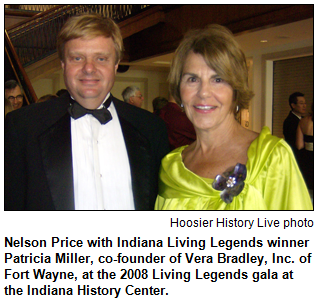 For his books about famous Hoosiers, Nelson interviewed notables such as Kurt Vonnegut Jr., Reggie Miller, violinist Joshua Bell, artist Nancy Noel and former U.S. Sen. Richard Lugar, who just was awarded the Presidential Medal of Freedom.
For his books about famous Hoosiers, Nelson interviewed notables such as Kurt Vonnegut Jr., Reggie Miller, violinist Joshua Bell, artist Nancy Noel and former U.S. Sen. Richard Lugar, who just was awarded the Presidential Medal of Freedom.
Nelson has researched the lives of Little Turtle, Madam Walker, Carole Lombard and popcorn king Orville Redenbacher, who was the focus of a recent Hoosier History Live! show.
Fun fact: When Nelson was a feature writer/columnist for The Indianapolis Star and its bygone sister newspaper, The Indianapolis News, he interviewed Gary BraVard. Twice, in fact.
Two years ago, Gary was shot on the Monon Trail during an attempted robbery. 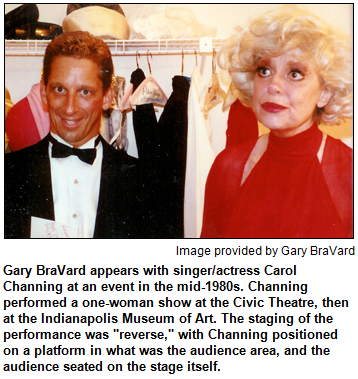 During our show, he shares details about the crime, the trial of the 15-year-old who shot him, and Gary's ongoing recovery. He still has several bullets lodged in his body, including his spine.
During our show, he shares details about the crime, the trial of the 15-year-old who shot him, and Gary's ongoing recovery. He still has several bullets lodged in his body, including his spine.
On a much lighter note, Gary also shares behind-the-scenes details of a posh event - the retirement party of an Indianapolis business leader - that went awry. (A teaser: The disaster involved wet paint.)
Plus, Gary has a parade of anecdotes from Indy events that he planned with a guest list of visiting celebrities. In addition to the previously mentioned notables, including Carol Channing, attendees at his parties have included Lucie Arnaz, who was visiting the Hoosier capital for a theatrical performance.
So, with their trove of anecdotes about Hoosier places, notables and special events, Nelson and Gary field an array of questions from callers, and from one another.
Roadtrip: Indiana Dunes, town of Beverly Shores and South Shore Line
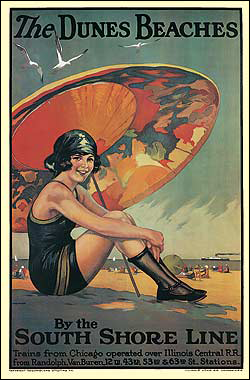 Roadtripper Nikki Martin will call in with a taste of what to expect when traveling up to the Dunes area in northwestern Indiana on Lake Michigan. Did you know that the South Shore Railroad Line historically has brought happy sun worshippers from the Chicago area to the Dunes?
Roadtripper Nikki Martin will call in with a taste of what to expect when traveling up to the Dunes area in northwestern Indiana on Lake Michigan. Did you know that the South Shore Railroad Line historically has brought happy sun worshippers from the Chicago area to the Dunes?
The town of Beverly Shores also has some interesting landmarks, including several "modern" homes that were relocated to the town after Chicago's 1933-34 Century of Progress World's Fair. Tune in Saturday for more!
History Mystery
Several of the famous Hoosiers featured in Indiana Legends, the book by host Nelson Price, also have been guests on Hoosier History Live! They include a jazz musician and educator who is credited with pioneering the use of cellos in jazz music. A native of Indianapolis, he talked on our radio show about his teenage years at Attucks High School when, although under-age, he was able to slip into nightspots on Indiana Avenue during the area's post-World War II heyday as a jazz mecca.
Later in life, the musician and educator primarily has been based in Bloomington. He has enjoyed the distinction of serving as the conductor of the first orchestra funded by the Smithsonian Institution.
Question: Who is he?
Longtime sponsor
A fond farewell to marketing partner Aesop's Tables on Mass Ave.
|
Aesop's Tables will be open for its last day of business on Saturday, Aug. 24, after 20 years in business. It has sold the lease on its stellar location at 600 Massachusetts Ave. in downtown Indianapolis. The landmark independent restaurant will be offering specials on Saturday.
Hoosier History Live has enjoyed a sponsorship trade with Aesop's for many years, which has made it possible for us to treat our fascinating Saturday show guests to lunch after the show, and also to be able to do a little business entertaining. Many loud and lively conversations over great food and drinks have taken place over the years at Aesop's. Thank you!
Christ Church Cathedral, Zion and Second Pres in Indy
|
(Aug. 17, 2013) - Three historic congregations in the Hoosier capital - each with a heritage of more than 150 years and each celebrating a significant milestone - are the focus of this show.
Located on a high-visibility site on Monument Circle, Christ Church Cathedral was built in the 1850s; the Gothic Revival building is considered the oldest religious structure in the city. 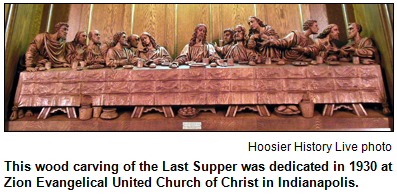 The Episcopalian congregation, though, dates back even further, to the 1830s, and is currently celebrating its 175th anniversary.
The Episcopalian congregation, though, dates back even further, to the 1830s, and is currently celebrating its 175th anniversary.
Sometimes called "the Little Church on the Circle," Christ Church remained at the heart of downtown even as neighboring churches moved or closed. Christ Church is known for its support of the arts, annual Strawberry Festival and renowned choirs, which sang at the Indiana State Capitol when Abraham Lincoln lay in state during a stop on his funeral procession to Illinois.
Rev. Stephen Carlsen, dean and rector at Christ Church Cathedral, join Nelson in studio. So does Rev. Jonathan Basile, senior pastor at Zion Evangelical United Church of Christ, which has a deep German heritage in Indy.
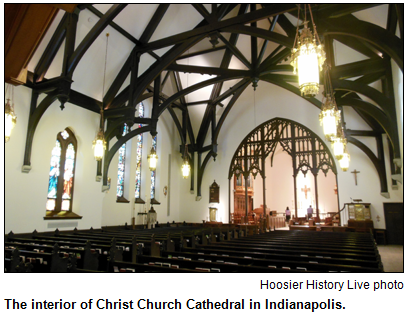 Founded in 1841 by German immigrants and considered to be the city's second-oldest Protestant congregation, Zion is celebrating 100 years at its current building on the corner of New Jersey and North streets. The church's neo-Gothic style building includes a sanctuary with wood sculptures of the disciples (a rendering of Leonardo da Vinci's "The Last Supper") by a German woodcarver. The sanctuary also boasts a 1940 Kimball pipe organ with 3,022 pipes.
Founded in 1841 by German immigrants and considered to be the city's second-oldest Protestant congregation, Zion is celebrating 100 years at its current building on the corner of New Jersey and North streets. The church's neo-Gothic style building includes a sanctuary with wood sculptures of the disciples (a rendering of Leonardo da Vinci's "The Last Supper") by a German woodcarver. The sanctuary also boasts a 1940 Kimball pipe organ with 3,022 pipes.
One of Indy's largest congregations also is celebrating its 175th anniversary. Second Presbyterian Church, which has been known for decades for the "movers and shakers" in its pews, was founded in 1838.
Initially located on Monument Circle, followed by a building near the Indiana War Memorial, Second Pres has been at its current site at 7700 N. Meridian St. since the late 1950s. 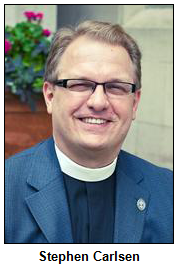 Since then, several wings and other additions have been added to the massive structure, most recently a music and fine arts department addition, youth area and social activities room called McFarland Hall. The church's historian and archivist, Fred Kortepeter, joins Nelson and the other guests in studio.
Since then, several wings and other additions have been added to the massive structure, most recently a music and fine arts department addition, youth area and social activities room called McFarland Hall. The church's historian and archivist, Fred Kortepeter, joins Nelson and the other guests in studio.
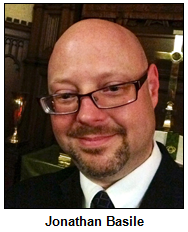 According to a history Fred has put together, the minister at Second Pres in the 1860s galvanized civic leaders to start the Indianapolis Public Library. The crusade began when the minister proclaimed during a Thanksgiving Day sermon that the lack of a public library was "a deficiency that is really fatal to the city's character."
According to a history Fred has put together, the minister at Second Pres in the 1860s galvanized civic leaders to start the Indianapolis Public Library. The crusade began when the minister proclaimed during a Thanksgiving Day sermon that the lack of a public library was "a deficiency that is really fatal to the city's character."
Christ Church Cathedral also has been actively involved in civic affairs. Congregation members helped start public schools in the city during the 1800s and, more recently, have been involved with the Julian Center, the Damien Center and Second Helpings. After the 9/11 terrorist attacks, the cathedral was the setting for a citywide memorial service.
Some history nuggets:
- Bill Hudnut moved to Indy in 1963 to become senior minister at Second Presbyterian, then served a record-setting four terms as Indy's mayor. When former Mayor Hudnut was a guest on our show in June, the History Mystery focused on his well-known predecessor from the 19th century. Rev. Henry Ward Beecher served as the Second Pres pastor beginning in 1839, then moved to New York City and became one of the most famous spiritual and civic leaders in the country.
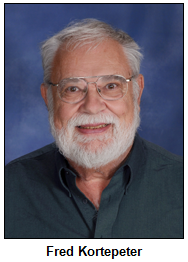 The caller who answered that History Mystery was current civic leader Henry Ryder, a member of Second Pres and retired lawyer who is a well-known re-enactor for his performances as Hoosier poet James Whitcomb Riley.
The caller who answered that History Mystery was current civic leader Henry Ryder, a member of Second Pres and retired lawyer who is a well-known re-enactor for his performances as Hoosier poet James Whitcomb Riley.- At Christ Church Cathedral, the acclaimed Choir of Men and Boys, founded in 1883, has toured Europe, performing at Westminster Abbey in London and Notre Dame in Paris; the Cathedral Girls' Choir also has appeared overseas and performed with the Indianapolis Symphony Orchestra.
- Although there's no longer a regular German-language service on Sundays at Zion, services in German continue to be offered during Lent and Advent.
- Irish immigrants in the 1830s are credited with founding St. John's Catholic Church, the oldest Catholic parish in Indy. The heritage of the church at 126 W. Georgia St. was the focus of a Hoosier History Live! show in October 2010.
- The architectural firm that designed St. John's, which is located near Indiana Convention Center and Lucas Oil Stadium, also had a connection to Zion. D.A. Bohlen & Son designed Zion's current building, which opened in 1913. In addition to the wood carving of the disciples, the sanctuary features 100-year-old stained glass windows.
- Regular worshipers at Christ Church included the late business leader and philanthropist Eli Lilly (1885-1977), who squashed attempts by banks and others to purchase the cathedral's site on Monument Circle.
- Not only is Christ Church the oldest religious structure in Indy, it's the oldest building on Monument Circle. The cathedral is on the National Register of Historic Places.
Learn more: Zion's stained glass window renovation by Conrad Schmidt Associates.
History Mystery
Among several Methodist congregations that founded churches in downtown Indianapolis during the 1800s, one has a special distinction in the city's public-safety history. 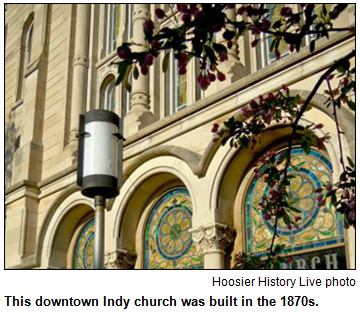 The Methodist congregation initially met in a chapel on the corner of Pennsylvania and Market streets in the 1840s and '50s. The chapel had a tower with a bell that called the congregation to worship; because the city had no fire bell then, the congregation allowed firefighters and other residents to ring the bell if a fire erupted in Indianapolis.
The Methodist congregation initially met in a chapel on the corner of Pennsylvania and Market streets in the 1840s and '50s. The chapel had a tower with a bell that called the congregation to worship; because the city had no fire bell then, the congregation allowed firefighters and other residents to ring the bell if a fire erupted in Indianapolis.
During the 1870s, a new church elsewhere downtown was built for the Methodist congregation, which continues to worship in the building today. Like Christ Church Cathedral, the church building is on the National Register of Historic Places.
Question: What is the Methodist church?
Roadtrip: CCC legacy at McCormick's Creek State Park
Roadtripper Suzanne Stanis of Indiana Landmarks suggests we attend a daylong program coming up at McCormick's Creek State Park near Spencer, Ind., to explore the legacy of the Civilian Conversation Corps.
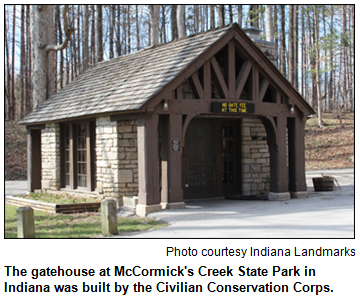 The CCC was President Franklin Delano Roosevelt's New Deal Depression-era employment program that put men to work creating charming structures in Indiana's parks - lodges, picnic shelters, bridges - using locally available materials.
The CCC was President Franklin Delano Roosevelt's New Deal Depression-era employment program that put men to work creating charming structures in Indiana's parks - lodges, picnic shelters, bridges - using locally available materials.
Says Suzanne: "It was a sustainable design program ahead of its time!"
McCormick's Creek State Park, Indiana's first state park, offers several examples of CCC. From 1933 to 1935, Company 589 of the CCC constructed shelter houses, a gatehouse and magnificent stone-arch bridge still visible today.
On Saturday, Aug. 24, Indiana Landmarks is offering a daylong Landmarks Experience exploring the CCC legacy at McCormick's Creek State Park, with tours and lectures by historians, landscape architects and naturalists. You can register online for Landmarks Experience.
This event is co-sponsored by Indiana Landmarks, the Indiana Department of Natural Resources and Owen County Preservations.
Ancient people here - and agricultural beginnings in Indiana
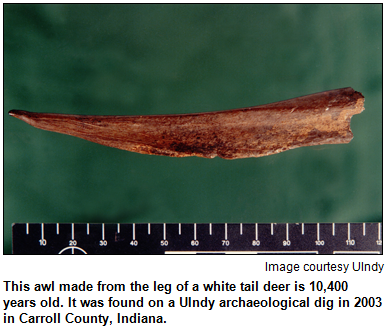 (Aug. 10, 2013 encore presentation) - Never let it be said Hoosier History Live does not dig deep into our rich heritage. As evidence, our focus during this show is on the so-called "Very First Hoosiers," or ancient people who lived more than 10,000 years ago in the densely wooded forests that became the site of Indiana.
(Aug. 10, 2013 encore presentation) - Never let it be said Hoosier History Live does not dig deep into our rich heritage. As evidence, our focus during this show is on the so-called "Very First Hoosiers," or ancient people who lived more than 10,000 years ago in the densely wooded forests that became the site of Indiana.
During this encore broadcast of one of the most popular shows in our archives (its original air date was Sept. 29, 2012), Nelson's guest is Dr. Christopher Schmidt, an archaeologist, biological anthropologist and director of the Indiana Prehistory Laboratory at the University of Indianapolis.
In addition to sharing insights about the ancient people who lived in what became the Hoosier state, Chris also discusses the beginnings of agriculture here. He is credited with discovering the oldest known man-made tool in Hoosier soil, an awl (used for making clothes) found during a dig near the town of Flora in Carroll County. 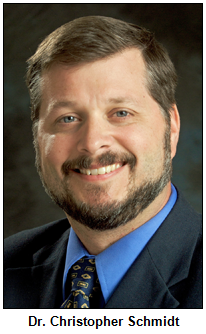 The awl is estimated to be about 10,400 years old.
The awl is estimated to be about 10,400 years old.
During the show, Chris, a popular U Indy faculty member who has overseen excavations across Indiana, shares details about the ancient Hoosiers of nearly 11,000 years ago, as well as information on the animal and plant life that surrounded them.
After many centuries, the ancient people began to develop agriculture, a move that, according to Chris, also meant an increase in various diseases. He discusses the correlation, as well as the origin of maize in Indiana.
Chris describes the ancient people as biological ancestors of Native Americans, although they differed culturally from the Native Americans who were living in the Eastern Woodlands when white settlers arrived.
According to Chris, the first evidence that Eastern Woodlands people manipulated plants - the beginnings of agriculture - occurred about 3,000 years ago. The ancient people, who lived in structures similar to wigwams, initially cultivated four varieties of plants that, according to Chris, today might be dismissed as "weeds."
Conclusions about the ancient people's diet and agricultural cultivations come from analyzing a variety of sources, including fossils found in Indiana.
Referring to the early cultivation of maize - a term Chris says is generally synonymous with corn - he explains that the ancient people often selected floodplains as sites of their fields. Floodplains provided a way to irrigate their crops.
"The actual corn they cultivated to eat was very similar, nearly identical, to the corn we eat today, except smaller," Chris says.
Initially, though, the plant did not produce multiple seeds in cobs. In what Chris describes as a "huge achievement," ancient people selectively bred their maize to produce cobs filled with corn kernels.
Switzerland County and living on the Ohio River
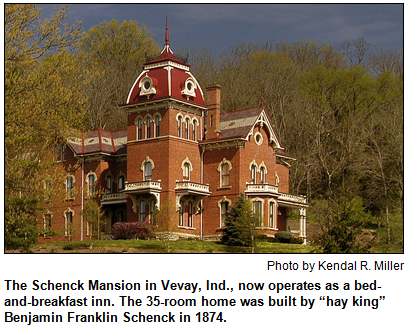 (Aug. 3, 2013) - Even though it's one of our smallest counties, the history is deep and rich, the views are scenic, and Switzerland County, with its county seat of Vevay, turns 200 this year.
(Aug. 3, 2013) - Even though it's one of our smallest counties, the history is deep and rich, the views are scenic, and Switzerland County, with its county seat of Vevay, turns 200 this year.
Not only does Hoosier History Live! explore the county's heritage, which includes Swiss immigration, an entrepreneur known as the "Hay King" and a popular wine festival, we also explore the impact of the Ohio River on towns and farms in the far-southeastern corner of the Hoosier state.
For this journey in advance of the Vevay Switzerland County Bicentennial, Nelson is joined in-studio by three guests:
- Martha Bladen, an artist (she creates collages out of found materials, including canceled postage stamps) who is executive director of the Switzerland County Historical Society. She also oversees museums in the Vevay area. They include the "Life on the Ohio" River History Museum and the Switzerland County Historical Museum, which is located in a former Presbyterian church built in 1860, as well as the Agricultural Museum Center that's being developed at a historic homestead.
 Barry Brown, an expert on the Swiss immigration to the area, which began in the early 1800s with early settlers who intended to introduce grape cultivation to the United States. A history and genealogy specialist at the Switzerland County Public Library, Barry will deliver a presentation titled "Why They Left Switzerland" on Aug. 4 in Vevay.
Barry Brown, an expert on the Swiss immigration to the area, which began in the early 1800s with early settlers who intended to introduce grape cultivation to the United States. A history and genealogy specialist at the Switzerland County Public Library, Barry will deliver a presentation titled "Why They Left Switzerland" on Aug. 4 in Vevay.- And Kendal Miller, a photographer, writer and executive director of Switzerland County Tourism.
Considered to be the home of the country's first commercial winery, Vevay hosts the annual Swiss Wine Festival. The four-day event, which will be Aug. 22-25, features a parade, riverboat cruises, music and a grape stomp.
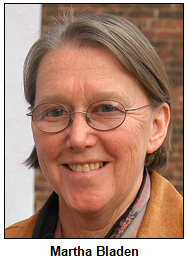 The county's early Swiss settlers, who included John James Dufour Jr., his family and descendants, initially called their land on the river "New Switzerland." They set up vineyards and, in 1813, established the town of Vevay. Thanks to the ease of shipping goods by riverboat, the town and surrounding farms flourished for several decades. Farmers constructed flatboats and keelboats from nearby timber.
The county's early Swiss settlers, who included John James Dufour Jr., his family and descendants, initially called their land on the river "New Switzerland." They set up vineyards and, in 1813, established the town of Vevay. Thanks to the ease of shipping goods by riverboat, the town and surrounding farms flourished for several decades. Farmers constructed flatboats and keelboats from nearby timber.
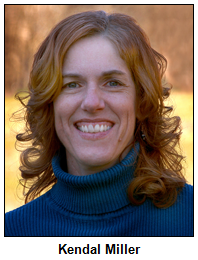 A history nugget, courtesy of bicentennial material: "Due in part to its easy accessibility to the Ohio River, other forms of transportation were slow to develop in Switzerland County." No railroad companies ever laid track in the county. Major roadways also were slow to be built.
A history nugget, courtesy of bicentennial material: "Due in part to its easy accessibility to the Ohio River, other forms of transportation were slow to develop in Switzerland County." No railroad companies ever laid track in the county. Major roadways also were slow to be built.
The result was that later in the 1800s, when railroads trumped river traffic such as steamboats as the primary way to transport products and people, the region's economy declined.
At the "Life on the Ohio" River History Museum, riverboat models and artifacts from the heyday of steamboats are displayed.
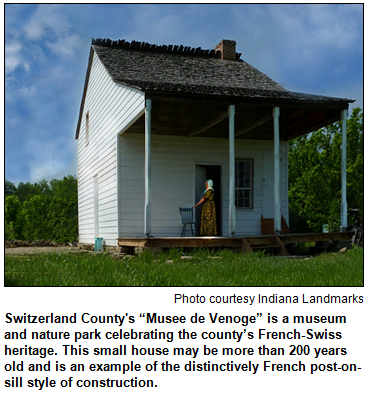 In addition to overseeing the museum and creating artwork, our guest Martha Bladen is a retired elementary school teacher. She also oversees the under-development Agricultural Museum Center, which will showcase a hay press barn. Invented in Switzerland County, the hay press was patented in 1843.
In addition to overseeing the museum and creating artwork, our guest Martha Bladen is a retired elementary school teacher. She also oversees the under-development Agricultural Museum Center, which will showcase a hay press barn. Invented in Switzerland County, the hay press was patented in 1843.
"The hay press was a three-story, animal-powered machine that, using a pulley and screw, pressed 300- to 400-pound bales," Martha explains. "The defining characteristic was the large wood 'driver' that dropped from heights of 20 feet or more into a hay-filled box, thus pressing the hay into large bales."
Switzerland County resident Ulyyses P. Schenck, who became known as the "Hay King," had a fleet of eight steamboats and barges. Even before that, the ancestors of our guest Barry Brown had settled in the county. Both sides of his family, which included Scottish immigrants, as well as Swiss and French, arrived in the early 1800s.
Vintage artifacts from various early settlers displayed at the Switzerland County Historical Museum include the first piano brought down river by flatboat to Indiana.
Roadtrip: Hoosier Theater in Vevay, plus good eats
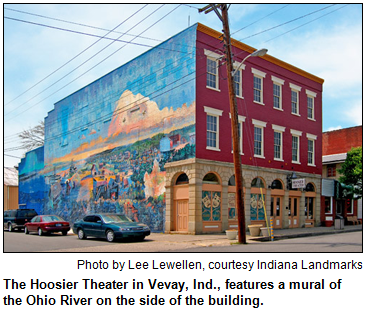 Roadtripper and film historian Eric Grayson will report on adventures to be had in Vevay, Ind., including visits to the famous Hoosier Theater there. Built in 1837, it is notable for its balcony, which is suspended from the ceiling by cast-iron rods.
Roadtripper and film historian Eric Grayson will report on adventures to be had in Vevay, Ind., including visits to the famous Hoosier Theater there. Built in 1837, it is notable for its balcony, which is suspended from the ceiling by cast-iron rods.
The 1974 TV movie A Girl Named Sooner was shot in Vevay, and Eric even ran a showing of the film at the Hoosier last year!
Right next door to the Hoosier Theater is Roxano's Restaurant, a popular local eatery that specializes in pizza and Italian cuisine.
Eric also reports that just up the State Road 156 is Shell's Ice Cream and Grill, which he says is open late and is great for someone who just finished watching a long movie and wants to take a shake home for the road.
Eric also says Vevay has a very strong Main Street program, which we surely will hear more about from our show guests.
History Mystery
|
Switzerland County is one of the state's smallest counties, but it's not the smallest. That distinction goes to another county in the far-southeastern corner of the Hoosier state; it borders Switzerland County. And it's the smallest county in Indiana, both in population and in area.
Question: What is the county?
The prize is a couple of tickets to the Switzerland County Historical Museum and the Life on the Ohio River History Museum in Vevay, Ind., courtesy of the Switzerland County Historical Society, and a gift certificate to Dick's Bodacious Bar-B-Q in downtown Indianapolis, courtesy of Visit Indy.
Historic movie theaters, Act II
|
(July 27, 2013) - Consider this a sequel to a popular show last February that focused on historic Indiana movie theaters that now are in a range of conditions, from lavishly restored to long-deteriorating. 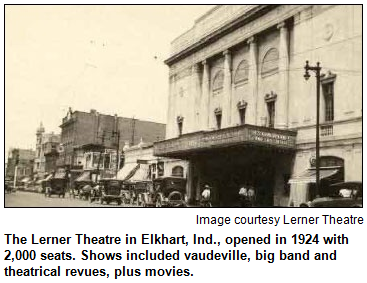 We also touched on a challenge that could imperil single-screen theaters built decades ago: a looming deadline to convert to digital projection, which involves considerable expense.
We also touched on a challenge that could imperil single-screen theaters built decades ago: a looming deadline to convert to digital projection, which involves considerable expense.
To explore additional movie theaters with rich histories, as well as delve further into the digital-era challenges and various issues involved in programming classic or other Golden Age movies instead of contemporary films, Nelson is joined in studio by two guests. They are Indianapolis-based architect Jim Kienle, director of historic preservation at Moody Nolan, and film historian Eric Grayson, who owns a vast collection of rare movies and has preserved and restored many of them.
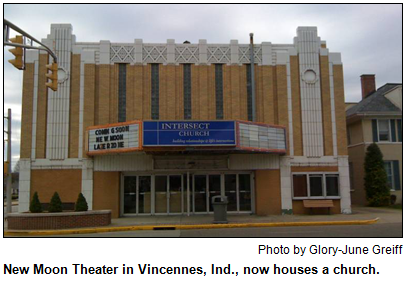 Eric is known across the state for his vintage-film presentations, including the Vintage Movie Nights series at the Garfield Park Arts Center in Indianapolis.
Eric is known across the state for his vintage-film presentations, including the Vintage Movie Nights series at the Garfield Park Arts Center in Indianapolis.
During our show, Nelson and his guests explore the Circle Theatre on Monument Circle in Indianapolis; it was built in 1916 as one of the largest silent-movie palaces west of New York. Despite its highly visible location in the heart of the Hoosier capital, the Circle had deteriorated alarmingly through the 1970s. Our guest Jim Kienle was a key figure in the 1980s renovation of what's now known as the Hilbert Circle Theatre, the concert hall of the Indianapolis Symphony Orchestra.
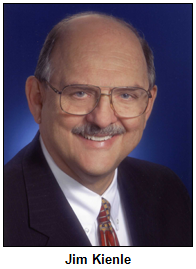 Jim Kienle also shares insights about the Lerner Theatre in Elkhart, which opened in 1924 as a movie house and as a venue for vaudeville shows and big-band concerts. With an auditorium often likened to a European opera house of the 19th century, the Lerner has been the focus of national attention since an $18 million renovation that was completed in 2011.
Jim Kienle also shares insights about the Lerner Theatre in Elkhart, which opened in 1924 as a movie house and as a venue for vaudeville shows and big-band concerts. With an auditorium often likened to a European opera house of the 19th century, the Lerner has been the focus of national attention since an $18 million renovation that was completed in 2011.
But what about the long-deteriorated Rivoli Theatre on the eastside of Indy? We provide an update on the once-lavish theater on East 10th Street that seated 1,500 when it opened in 1927. Its disturbing saga, which included a stint as an X-rated theater, followed by decades of sitting vacant, was spotlighted during our February show.
Nelson and his guests also explore:
- The Artcraft Theatre in Franklin, which was built in 1922 and shows vintage movies year-round.
- The Paramount Theatre in Anderson (now the Paramount Theatre Center and Ballroom) that opened in 1929 and has a restored theater organ and an interior Spanish courtyard.
- The Embassy Theatre in Fort Wayne, which opened as a movie palace in 1928 and is on the National Register of Historic Places.
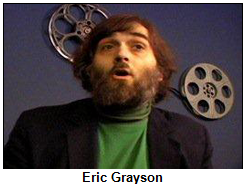 At the Embassy on Aug. 9, our guest Eric Grayson will be involved in a gala to celebrate the 150th anniversary of the birth of famous Hoosier novelist and naturalist Gene Stratton-Porter. The event will include the showing of Laddie (1926), a rare silent movie (with its original score) based on her novel, which was published 100 years ago.
At the Embassy on Aug. 9, our guest Eric Grayson will be involved in a gala to celebrate the 150th anniversary of the birth of famous Hoosier novelist and naturalist Gene Stratton-Porter. The event will include the showing of Laddie (1926), a rare silent movie (with its original score) based on her novel, which was published 100 years ago.
Initially known as the Emboyd Theatre, the ornate Embassy was built with nearly 3,100 seats, according to The Historic Fort Wayne Embassy Theatre (IU Press, 2009). Total seating capacity today is 2,470, including the balcony.
Many historic movie houses are far smaller and have just one screen. Their fate is uncertain as the movie industry quickly eliminates film in favor of all-digital distribution, an issue Nelson and his guests discuss. 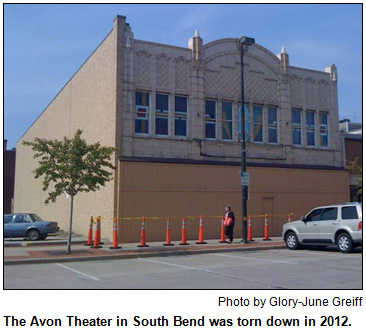 Purchasing and installing digital projectors - estimated to cost more than $70,000 per screen - far exceeds the resources of many historic movie houses in small towns.
Purchasing and installing digital projectors - estimated to cost more than $70,000 per screen - far exceeds the resources of many historic movie houses in small towns.
Some history nuggets:
- Even though the Circle has been the concert hall of the Indianapolis Symphony Orchestra since 1984, the theater occasionally reverts to its original use as a movie house. The Circle was the setting for the world premiere of Hoosiers (1986).
- In the 1970s, the Embassy closed and was threatened with demolition. Outraged activists in Fort Wayne established a foundation that purchased the landmark.
- In a Hoosier History Live! show last year about Tipton County history, we explored the Diana Theater, a movie house built in the 1920s by a Greek immigrant to Tipton. Generations of town residents have had their first dates at the Diana, a single-screen theater that retains its vintage ambience.
Roadtrip: Harrison Memorial at Crown Hill Cemetery
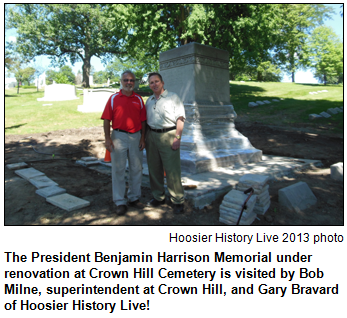 Roadtripper Gary Bravard suggests we take the Roadtrip to one of his favorite bicycling spots as a youth, Crown Hill Cemetery in Indianapolis. Established in 1863, Crown Hill is the country's third largest non-government cemetery, with 555 acres.
Roadtripper Gary Bravard suggests we take the Roadtrip to one of his favorite bicycling spots as a youth, Crown Hill Cemetery in Indianapolis. Established in 1863, Crown Hill is the country's third largest non-government cemetery, with 555 acres.
With its elegant landscaping and beautifully curved roads, and as the final resting place for one U.S. president, three vice presidents, Hoosier poet James Whitcomb Riley and infamous bank robber John Dillinger, Crown Hill is a virtual treasure trove for history lovers.
Gary spoke recently with Crown Hill President Keith Norwalk, who reported that President Benjamin Harrison Memorial (Indiana's only U.S. president) and gravesite at Crown Hill is getting a restoration, courtesy of a grant received through the Indianapolis Garden Club. A new walkway is being installed, with new steps and new landscaping. After the restoration is complete, visitors will be able to walk all the way around the memorial.
The renovation will be complete by the time of the annual Wreath Laying Ceremony for the Harrison Memorial, to be held at Crown Hill on Saturday, Aug. 17, at 10:30 a.m. in celebration of President Harrison's 180th birthday. Benjamin Harrison was elected to the presidency in 1888 and served one term (1889-93). He was the nation's 23rd chief executive. The ceremony is free and open to the public.
History Mystery
An extensively restored, historic movie theater reopened last April in an Indiana town that's a county seat. The theater, located on the town's courthouse square, opened on New Year's Eve in 1928 and drew crowds from surrounding communities for several decades. 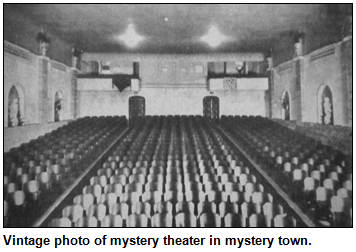 But a few years after a fire, the theater closed in the 1990s and sat vacant.
But a few years after a fire, the theater closed in the 1990s and sat vacant.
The landmark theater's restoration was spearheaded by Cook Group Inc., which is based in Bloomington - just one county away from the town where the theater is located. Cook Group, the medical supply manufacturer, also has a plant in the "mystery" town.
Question: What is the town?
Hint: The town and its theater on the courthouse square were discussed during a Hoosier History Live! show in February about vintage movie houses.
The prize is four entries to the Indiana Experience at the Indiana Historical Society, two tours of the President Benjamin Harrison Presidential Site, and two public tours of Crown Hill Cemetery. These prizes are courtesy of Visit Indy.
Roots-tracing tips and advice
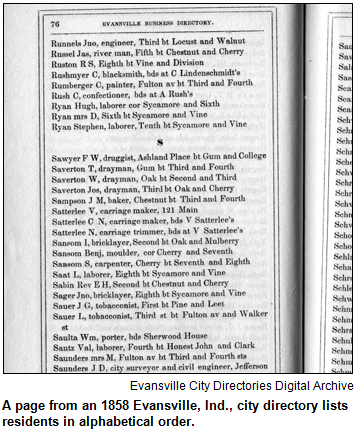 (July 20, 2013) - Maybe it happens more than once in a generation, but ask yourself: How often do you get free tips and advice about tracking down your family history?
(July 20, 2013) - Maybe it happens more than once in a generation, but ask yourself: How often do you get free tips and advice about tracking down your family history?
Knowing that genealogy can be intimidating and overwhelming, Hoosier History Live! brings in some experts. They include an acclaimed Hoosier who not only is considered one of the top genealogists in the state, but among the best in the country as well.
Curt Witcher is manager of the renowned genealogy center at the Allen County Public Library in Fort Wayne; it's generally regarded as the nation's best resource for roots-tracing, except perhaps for the Mormon-affiliated resources in Salt Lake City.
Curt also is former president of the National Genealogical Society and a board member of the Indiana Genealogical Society. Founded in 1989, the Indiana Genealogical Society has more than 500,000 records on its website from all of the state's 92 counties.
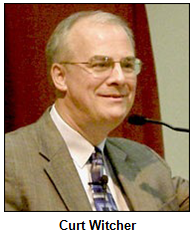 In addition to Curt, Nelson also is joined in studio by two Indiana Historical Society staff members who will be leading an upcoming workshop about beginning genealogy.
In addition to Curt, Nelson also is joined in studio by two Indiana Historical Society staff members who will be leading an upcoming workshop about beginning genealogy.
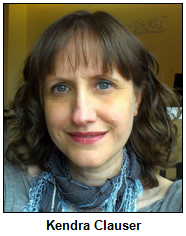 "Start with What You Know" is the title of the workshop with Kendra Clauser, IHS oral history project archivist, and genealogist Allison DePrey, IHS assistant coordinator for education and community engagement, who will be guests on our show. For more information about - or to register for - the July 27 workshop, which will be 10 a.m. to noon at the Eugene and Marilyn Glick Indiana History Center, contact the historical society.
"Start with What You Know" is the title of the workshop with Kendra Clauser, IHS oral history project archivist, and genealogist Allison DePrey, IHS assistant coordinator for education and community engagement, who will be guests on our show. For more information about - or to register for - the July 27 workshop, which will be 10 a.m. to noon at the Eugene and Marilyn Glick Indiana History Center, contact the historical society.
Elsewhere in Indiana, a major opportunity will be available for listeners interested in roots-tracing. The Federation of Genealogical Societies will have a national conference Aug. 21-24 in Fort Wayne. 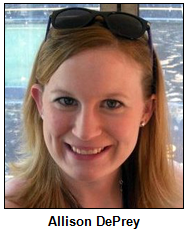 Our guest Curt Witcher is a board member of the Federation of Genealogical Societies; its upcoming conference at the Grand Wayne Convention Center is open to anyone interested in family history.
Our guest Curt Witcher is a board member of the Federation of Genealogical Societies; its upcoming conference at the Grand Wayne Convention Center is open to anyone interested in family history.
During our show, Nelson and his guests explore roots-tracing aspects galore. They include tips on:
- Using ancestry.com and launching your research.
- Assessing the accuracy of diaries and letters, as well as of notations in family Bibles and other family documents.
- Dealing with special challenges that involve ethnic immigration, as well as the ancestry of African-Americans and other minority populations.
- Interviewing relatives.
- Delving into the resources at the Allen County Public Library. A sample: It has the largest collection of city directories in the country. The library also has one of the largest collections of Canadian genealogy material.
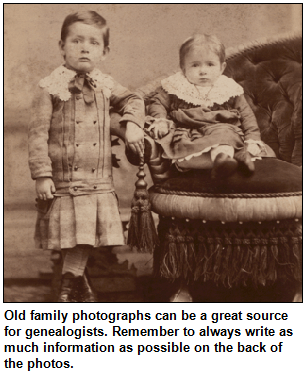 Our guest Curt Witcher has worked at the Allen County Public Library for more than 34 years. And our guest Allison DePrey, an Allen County native, began her roots-tracing research at the library as a teenager. In recent years, Allison has given presentations at several genealogy workshops across the state.
Our guest Curt Witcher has worked at the Allen County Public Library for more than 34 years. And our guest Allison DePrey, an Allen County native, began her roots-tracing research at the library as a teenager. In recent years, Allison has given presentations at several genealogy workshops across the state.
Her colleague at the historical society, our guest Kendra Clauser, specializes in interviewing and "collecting individual life stories" of people who have witnessed significant events in Indiana's recent past.
This is an ideal show for listeners to call in at (317) 788-3314 and ask for advice in exploring family trees.
Learn more:
Roadtrip: Wabash, Ind.
Guest Roadtripper and historian-at-large Glory- June Greiff recommends we head north from Indianapolis to visit the historic town of Wabash, which was founded in 1834 on a high bluff.
Wabash lies above the river of the same name in the county of the same name and also was a port on the Wabash and Erie Canal. It was the first town in the world (!) to be illuminated by electricity, back in 1880. The lights were installed on the dome of the beautiful new courthouse, completed only the year before.
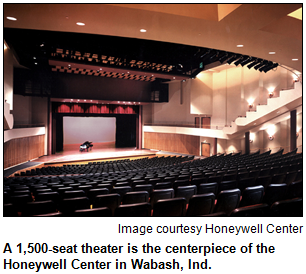 The historic courthouse still stands, and immediately to the west is the old GAR (Grand Army of the Republic) Hall, guarded by two cast-iron Civil War sentries. The building, which until recent years housed the Wabash County Historical Museum, now contains county offices. The museum moved to a new location downtown at 36 E. Market and is well worth seeing. The staff there will be pleased to direct you to the numerous historic sites in the area.
The historic courthouse still stands, and immediately to the west is the old GAR (Grand Army of the Republic) Hall, guarded by two cast-iron Civil War sentries. The building, which until recent years housed the Wabash County Historical Museum, now contains county offices. The museum moved to a new location downtown at 36 E. Market and is well worth seeing. The staff there will be pleased to direct you to the numerous historic sites in the area.
Wabash is filled with many wonderful historic houses, and Glory strongly suggests simply walking, especially north and west of downtown. A very nice house museum is the Dr. James Ford Historic Home. And the Honeywell House is a beautiful bed-and-breakfast that also hosts several arts and educational programs and events throughout the year.
The Honeywell Center, an interesting building with Art Deco influences, is a community center and auditorium that offers top-notch entertainment throughout the year. And if you're hungry, don't miss lunch or dinner at the Charley Creek Inn, a beautifully restored 1920s hotel downtown. You may very well want to stay the night!
History Mystery
In addition to being the site of the renowned Allen County Public Library and its genealogy center, Fort Wayne also hosts one of the largest annual festivals in northeastern Indiana. The festival is held every September to celebrate the life of an American folk hero.
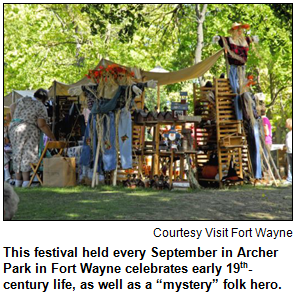 Many historians believe the folk hero died in the Fort Wayne area, probably in 1845. A memorial to the folk hero on his likely gravesite is in Archer Park and listed on the National Register of Historic Places.
Many historians believe the folk hero died in the Fort Wayne area, probably in 1845. A memorial to the folk hero on his likely gravesite is in Archer Park and listed on the National Register of Historic Places.
He has been celebrated in literature as well as pop culture, including Walt Disney cartoons.
Question: Who is the folk hero celebrated at the Fort Wayne festival?
The prize is four entries to the Indiana Experience at the Indiana Historical Society, two tours of the President Benjamin Harrison Presidential Site, and a pair of tickets to the Track Tour at the Indianapolis Motor Speedway. These prizes are courtesy of Visit Indy.
Swedish and Norwegian immigration
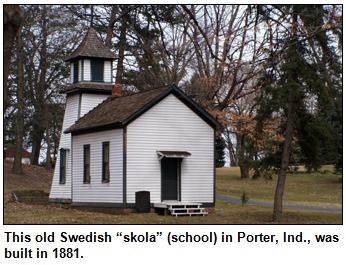 (July 13, 2013) - Much turf remains to be explored in our rotating shows about ethnic immigration to the Hoosier state, even though we already have explored German, Irish, Scottish, Cuban, Italian, Greek, Colombian, Brazilian and even Sikh heritage in Indiana.
(July 13, 2013) - Much turf remains to be explored in our rotating shows about ethnic immigration to the Hoosier state, even though we already have explored German, Irish, Scottish, Cuban, Italian, Greek, Colombian, Brazilian and even Sikh heritage in Indiana.
Now the turf will involve scenic homelands with fjords, the midnight sun, seafood and ship-builders.
That's because Nelson and his guests explore Swedish and Norwegian immigration to Indiana, a topic that involves a legendary football coach at the University of Notre Dame, an organ factory in Chesterton, heritage groups scattered across the state and the Studebaker Brothers in South Bend, even though the wagon- and car-making brothers were of German ancestry themselves.
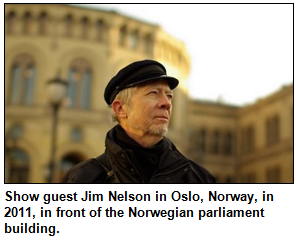 Our show is timely because the Indianapolis-area lodge of Vasa Order of America, which was founded to assist Swedish immigrants, recently celebrated its 100th anniversary. Named in honor of the first king of modern Sweden, King Gustav Vasa, Vasa has broadened its mission to welcome anyone interested in Nordic culture, including Norwegian, Danish, Icelandic and Finnish heritage.
Our show is timely because the Indianapolis-area lodge of Vasa Order of America, which was founded to assist Swedish immigrants, recently celebrated its 100th anniversary. Named in honor of the first king of modern Sweden, King Gustav Vasa, Vasa has broadened its mission to welcome anyone interested in Nordic culture, including Norwegian, Danish, Icelandic and Finnish heritage.
Full disclosure: Our host Nelson is particularly passionate about this topic because his ancestry is Norwegian. His maternal great-grandparents emigrated in steerage on ocean liners, separately, from Trondheim (Norway's third-largest city) and Bergen, a coastal town. Nelson's parents are members of the Circle City Lodge of Sons of Norway, a heritage group that also has lodges in Fort Wayne, South Bend and Chesterton.
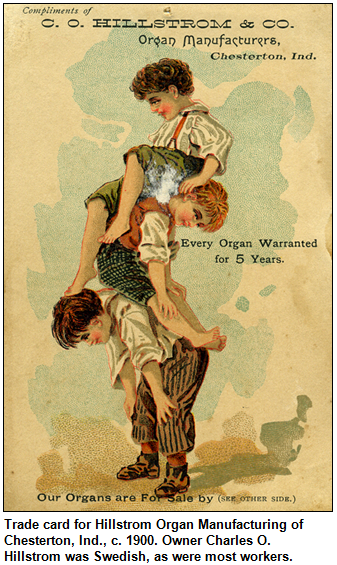 Nelson is joined in studio by three guests, one of whom also is a Sons of Norway member. Jim Nelson, a music teacher in Greenwood, is the descendant of Norwegian immigrants, grew up in Chesterton, lived in Norway for more than 18 years and has taught Scandinavian studies at colleges in Minnesota, Canada and Norway. He has given presentations about Norwegian immigration, as well as about Norwegians in the Civil War.
Nelson is joined in studio by three guests, one of whom also is a Sons of Norway member. Jim Nelson, a music teacher in Greenwood, is the descendant of Norwegian immigrants, grew up in Chesterton, lived in Norway for more than 18 years and has taught Scandinavian studies at colleges in Minnesota, Canada and Norway. He has given presentations about Norwegian immigration, as well as about Norwegians in the Civil War.
To share insights about our state's Swedish heritage, Nelson welcomes an old friend and colleague, Vasa member Jim Lindgren, a Fishers resident whose ancestry is 100 percent Swedish. Now an editor for Strategic Marketing and Research Inc. in Carmel, Jim Lindgren is a former colleague of Nelson from their years at the Indianapolis News and The Indianapolis Star, where Jim was known for propping up a Swedish flag on his desk.
Nelson and the two Jims also are joined by John Bevelhimer of Indianapolis, a retired IT specialist and past chairman of the local Vasa (Lodge Svea No. 253) who extensively researched its history for the recent centennial.
According to Peopling Indiana (Indiana Historical Society Press, 1996), Swedes and Norwegians who eventually came to Indiana tended to settle first in Chicago, then filter into the Hoosier state as a result of a second move.
The grandparents of both Nelson and Jim Lindgren lived in the Chicago area. In fact, Jim's great-grandfather, Nels Lindgren, owned a Swedish tavern in Chicago. The Andersonville neighborhood of the Windy City is historically Swedish.
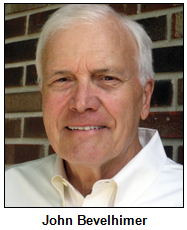 Scandinavian immigrants typically arrived in Indiana decades later than their German and Irish counterparts, often lured by whatever farmland remained unclaimed during the late 1800s and early 1900s. For early groups of Swedes, that often meant farmland in Porter County.
Scandinavian immigrants typically arrived in Indiana decades later than their German and Irish counterparts, often lured by whatever farmland remained unclaimed during the late 1800s and early 1900s. For early groups of Swedes, that often meant farmland in Porter County.
In the 1880s, an organ factory in Chesterton became the town's main industry and employed many Swedes and Norwegians, according to Peopling Indiana.
"Swedes were so dominant in Chesterton that in the 1880s the Chesterton Tribune occasionally ran front-page articles in the Swedish language," the book notes.
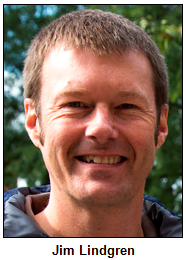 Primarily, early Swedish settlements were in a part of northeast Porter County known as Bailleytown and surrounding areas near the Lake Michigan shore. According to our guest Jim Nelson, Swedish settlements large enough to establish and sustain Lutheran congregations - in addition to Chesterton - were in Plymouth, LaPorte, Donaldson, Michigan City, Porter, Chesterton, Gary, East Gary (later renamed Lake Station), Hobart and Whiting.
Primarily, early Swedish settlements were in a part of northeast Porter County known as Bailleytown and surrounding areas near the Lake Michigan shore. According to our guest Jim Nelson, Swedish settlements large enough to establish and sustain Lutheran congregations - in addition to Chesterton - were in Plymouth, LaPorte, Donaldson, Michigan City, Porter, Chesterton, Gary, East Gary (later renamed Lake Station), Hobart and Whiting.
A section of Michigan City became known as "Swedeville," drawing Scandinavians seeking jobs in shipping and lumber. Peopling Indiana notes that by 1890, three counties in northwest Indiana - Lake, LaPorte and Porter counties - included more than half of the state's Swedish-born residents.
Studebaker Brothers in South Bend actively recruited Swedish workers during the factory's heyday. Several of the mystery novels of contemporary author Jeanne Dams of South Bend focus on a resourceful Swedish immigrant working as a maid in one of the historic Studebaker mansions during the late 1800s.
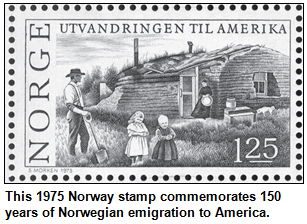 South Bend also became the adopted hometown of an icon in college football history. Knute Rockne, the famous Notre Dame coach who used the "win one for the Gipper" story as a motivational technique, was born in the Norwegian village of Voss. The South Bend Chocolate Company continues to market Knute Rockne lines of chocolates in tribute to "The Rock," who is credited with revolutionizing college football before his tragic death in a plane crash in 1931.
South Bend also became the adopted hometown of an icon in college football history. Knute Rockne, the famous Notre Dame coach who used the "win one for the Gipper" story as a motivational technique, was born in the Norwegian village of Voss. The South Bend Chocolate Company continues to market Knute Rockne lines of chocolates in tribute to "The Rock," who is credited with revolutionizing college football before his tragic death in a plane crash in 1931.
Some other fun facts:
- The movie Song of Norway (1970), a musical about the life of classical composer Edvard Grieg, starred a famous Hoosier. Florence Henderson, a native of Dale, Ind., completed her role in the movie, which was filmed on location in Norway, just before she began the long-running TV series The Brady Bunch.
- The former longtime mayor of West Lafayette is of Norwegian heritage. Sonya Margerum, who served as mayor for 24 years beginning in 1980, also was a longtime board member of her alma mater, St. Olaf College in Minnesota.
- Col. Eli Lilly, the Civil War hero who founded the pharmaceutical business that became an international company, was of Swedish heritage.
- Although the 30-year-old conductor of the Indianapolis Symphony Orchestra is Polish, Krzysztof Urbanski has a strong connection to Norway. Urbanski, the youngest person ever to lead a major North American orchestra, is simultaneously serving as chief conductor of the Trondheim Symphony Orchestra in Norway.
- On his right hand, our host Nelson always wears a family heirloom wedding ring from his Norwegian ancestors. His great-grandmother, Clara Jensen, gave it to his great-grandfather, Olaf Nelson, during their marriage ceremony.
"Learn more" websites include:
- Vasa Archives.
- Rev. Erland Carlsson, Swedish immigrant pastor in Indiana.
- Swedish Churches in Indiana.
- Swedish Emigration to U.S.
- Norwegian Emigration to U.S.
- Museum of Early Indiana Life.
Roadtrip: Zaharakos Ice Cream Parlor and art playground in Columbus, Ind.
|
Guest Roadtripper this week is one of Central Indiana's favorite foodies, Daina Chamness. She'll be reporting on a recent trip she took to Columbus, Ind., to check out the fabulous 1900 ice cream parlor Zaharakos in the 300 block of Washington Street there.
Right across the street is "The Commons," which boasts an elaborate children's playground.
Remember that the Columbus Visitors Center is in walking distance of these downtown attractions.
History Mystery
A well-known former political figure from Indiana is Norwegian-American on his mother's side. Her grandfather - the politician's great-grandfather - emigrated from Norway in the late 1800s.
The Hoosier politician, who won a series of statewide elections over a 20-year period beginning in the 1980s, took a trip with his mother to their ancestral homeland of Norway, as well as to other Scandinavian countries. The mother-son journey unfolded in the summer of 1978, following the son's graduation from Indiana University.
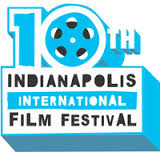 Less than a year later - in April 1979 - the future politician's mother died of cancer. In her final years, she had crusaded to raise awareness of breast cancer.
Less than a year later - in April 1979 - the future politician's mother died of cancer. In her final years, she had crusaded to raise awareness of breast cancer.
Question: Name the former Indiana politician who is of Norwegian heritage in his maternal line.
Hint: His father, who is still living, also had a long political career and won statewide elections over a period of 20 years.
The prize is a pair of tickets to the Indianapolis International Film Festival and a gift certificate to Dick's Bodacious Bar-B-Q. These prizes are courtesy of Visit Indy.
Orville Redenbacher and popcorn heritage in Indiana
(July 6, 2013) - Chew on this: Not only is "Year of Popcorn" the theme at next month's Indiana State Fair, but the farmboy-turned-entrepreneur who became internationally known as "the Popcorn King" was a Hoosier.
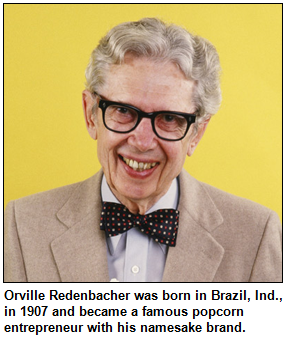 Grandfatherly, bow-tied Orville Redenbacher (1907-95), who became a multimedia advertising icon, is far from Indiana's only link to the perennially, uh, pop-ular product that long ago became a household staple.
Grandfatherly, bow-tied Orville Redenbacher (1907-95), who became a multimedia advertising icon, is far from Indiana's only link to the perennially, uh, pop-ular product that long ago became a household staple.
A farm agent who grew up near Brazil, Ind., Redenbacher studied at Purdue University and experimented for more 40 years with 3,000 hybrids of popcorn. He's credited with making the first significant changes in the treat since Native Americans introduced it to white settlers in the 1600s.
His adopted hometown of Valparaiso, where Redenbacher lived for many years, continues to host an annual Popcorn Festival in his honor. The event, which includes a popcorn parade, typically is attended by 75,000 people.
Another Hoosier town - Van Buren in Grant County - also hosts an annual Popcorn Festival that features a parade. Because so much popcorn is produced from the farms surrounding Van Buren (pop.: 864 in the 2010 U.S. Census), the town bills itself as "the popcorn capital of the world." According to the State Fair, Indiana is one of the country's top popcorn-producing states.
So not only do we explore the colorful life of Orville Redenbacher, the "king of kernels," Nelson and his guests also delve into the product's historic importance to the Hoosier state's economy and heritage.
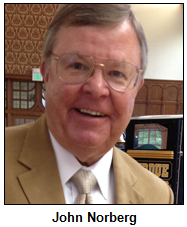 Noblesville-based, family-owned Weaver Popcorn Company makes and distributes popcorn internationally (since 2010, Weaver Popcorn has even been sold at movie theaters in China) and is a leading maker of microwave popcorn.
Noblesville-based, family-owned Weaver Popcorn Company makes and distributes popcorn internationally (since 2010, Weaver Popcorn has even been sold at movie theaters in China) and is a leading maker of microwave popcorn.
To digest all of this popcorn talk, Nelson is joined by Purdue staff writer and historian John Norberg, who interviewed Redenbacher and also was a colleague of the late Robert Topping, author of the definitive biography Just Call Me Orville (Purdue University Press, 2011).
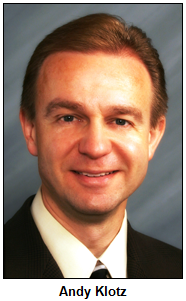 Nelson's guests also include Andy Klotz, public relations director of the State Fair, who shares details about the ways the product will be showcased next month. Andy also shares insights about Weaver Popcorn, which was founded in the 1920s by Rev. Ira Weaver, another beloved Hoosier entrepreneur.
Nelson's guests also include Andy Klotz, public relations director of the State Fair, who shares details about the ways the product will be showcased next month. Andy also shares insights about Weaver Popcorn, which was founded in the 1920s by Rev. Ira Weaver, another beloved Hoosier entrepreneur.
Fun fact: When Nelson was researching Orville Redenbacher's life for his book Indiana Legends, he discovered the popcorn king always preferred his "salted, no butter."
At Brazil High School, Redenbacher captured state championships in 4-H club contests. He paid for his tuition at Purdue (which, as he put it, soon was "on the cutting edge of popcorn research") by scrubbing hog houses and tending chickens. Redenbacher became an agricultural agent in Vigo County, where he apparently was the first county agent in Indiana to broadcast live on radio from fields.
![]() By the time Redenbacher died at age 88, he was a national celebrity, thanks to the use of his name and image on his product's label and in countless magazine ads and TV commercials. Even today, nearly 20 years after the death of Redenbacher (who is often described as popcorn's version of Col. Harlan Sanders of Kentucky Fried Chicken fame), ads and commercials still feature him, often accompanied by his grandson.
By the time Redenbacher died at age 88, he was a national celebrity, thanks to the use of his name and image on his product's label and in countless magazine ads and TV commercials. Even today, nearly 20 years after the death of Redenbacher (who is often described as popcorn's version of Col. Harlan Sanders of Kentucky Fried Chicken fame), ads and commercials still feature him, often accompanied by his grandson.
According to Just Call Me Orville, Redenbacher was named in honor of Orville Wright of the famous Wright Brothers aviators. (Orville Wright's brother Wilbur was born in far-eastern Indiana.)
At age 12, Orville Redenbacher began raising popcorn and selling it in 50-pound sacks to stores in Brazil and Terre Haute. In addition to studying agriculture as a Purdue student, he played the sousaphone in Purdue's renowned All-American Marching Band.
The decades he devoted to experimenting with hybrids are credited with producing a variety that popped significantly larger, lighter and fluffier. It became a marketing sensation as Orville Redenbacher's Gourmet Popping Corn and eventually was sold to California-based Hunt Wesson Foods, which continued to use Redenbacher as the brand's spokesman. (It eventually was swallowed up by ConAgra, the giant food conglomerate based in Omaha.)
At the State Fair, which will run from Aug. 2-18, the world's largest popcorn ball - weighing 5,200 pounds - will be on display. 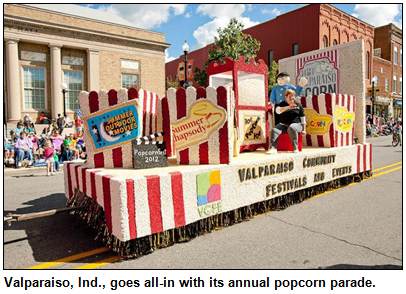 According to a recent article in the Indianapolis Star, Sac City, Iowa currently holds title for the world's largest popcorn ball with its 5,000-pound ball created by town residents in 2009.
According to a recent article in the Indianapolis Star, Sac City, Iowa currently holds title for the world's largest popcorn ball with its 5,000-pound ball created by town residents in 2009.
Other aspects of the "Year of Popcorn" celebration at the fair will include a twist on a traditional corn maze: a popcorn maze that fair-goers can maneuver through.
Final fun fact: According to Just Call Me Orville, the "Popcorn King," who became a hit on the speaking circuit, occasionally would introduce his talk by saying, "My topic tonight is sex."
After his audience reacted with astonishment, he would share insights about "the sex life of a popcorn plant and the breeding methods required to obtain hybrids."
Learn more:
- Hoosier History Live! show, Sept. 29, 2012, "Ancient people here - and agricultural beginnings in Indiana"
- http://www.nativetech.org/cornhusk/cornhusk.html
- http://newsdesk.si.edu/releases/ancient-popcorn-discovered-peru
Roadtrip: Oldenburg, the village of spires
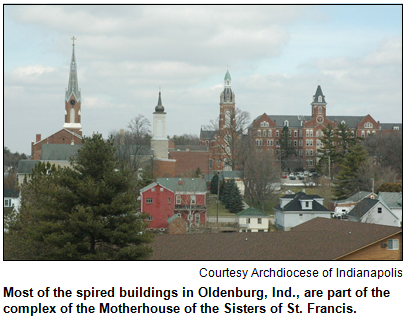 Guest Roadtripper this week is William Selm, architectural historian, adjunct faculty member at IUPUI and expert on German heritage in Indiana. He suggests we visit another of his favorite German-settled small towns in Indiana, Oldenburg, which is right off I-74 going southeast Indianapolis in Franklin County.
Guest Roadtripper this week is William Selm, architectural historian, adjunct faculty member at IUPUI and expert on German heritage in Indiana. He suggests we visit another of his favorite German-settled small towns in Indiana, Oldenburg, which is right off I-74 going southeast Indianapolis in Franklin County.
William tells us that "Oldenburg is one of many towns and villages across Indiana, especially Southern Indiana, founded by and for German immigrants before the Civil War. What makes Oldenburg stand out is its townscape of spired buildings, most of which are part of the complex of the Motherhouse of the Sisters of St. Francis."
Oldenburg was founded in 1837 by two immigrants from the Grand Duchy of Oldenburg at the request of the Catholic priest, Fr. Joseph Ferneding, also an Oldenburger. A later priest, Fr. Franz Josef Rudolf from Alsace, had the vision of spires as he built the c. 1848 onion-domed stone church, the current brick 1860s parish church, and the first convent buildings.
This energetic priest also co-founded the convent and invited Beatus Gehring to establish his brick yard south of the village. He is honored with a crypt tomb in the parish church. Oldenburg's annual Freudenfest is this July 19-20.
History Mystery
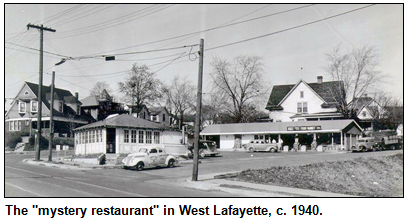 Not far from the Purdue University campus in West Lafayette where Orville Redenbacher majored in agricultural studies is a landmark in Indiana food history.
Not far from the Purdue University campus in West Lafayette where Orville Redenbacher majored in agricultural studies is a landmark in Indiana food history.
Billing itself as the state's oldest drive-in, the restaurant has a memorable name. Known for burgers, shakes and root beer, it serves menu items such as Boilermaker burgers and peanut butter burgers. The restaurant opened in 1929, one year after young Orville Redenbacher graduated from Purdue.
Question: Name the landmark restaurant in West Lafayette.
The prize is a pair of tickets to the Children's Museum, courtesy of Visit Indy, and tickets to the Indiana State Fair, courtesy of the Indiana State Fair.
Underground Railroad reality and myths in Indiana
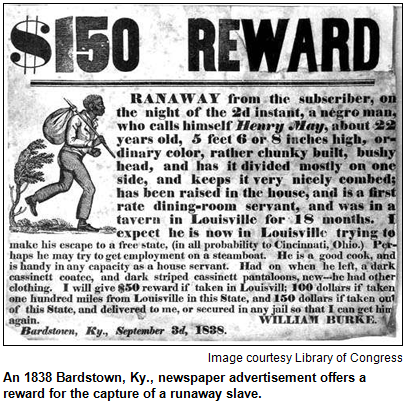 (June 29, 2013) - If you believe folklore across Indiana, just about every historic house, inn and tavern - particularly those with hidden rooms, cellars or attics - were stops on the Underground Railroad.
(June 29, 2013) - If you believe folklore across Indiana, just about every historic house, inn and tavern - particularly those with hidden rooms, cellars or attics - were stops on the Underground Railroad.
Exaggerations and misconceptions abound regarding the movement before and during the Civil War to help escaped slaves, according to experts.
To share insights about the myths and reality regarding the extent and nature of the Underground Railroad network in Indiana - including what is and isn't confirmed - Nelson is joined in studio by two experts. They are historic researcher and genealogist Dona Stokes-Lucas of Indianapolis and Kisha Tandy, assistant curator of social history at the Indiana State Museum.
A board member of Indiana Freedom Trails Inc., a nonprofit established to pull together, verify and preserve information about Underground Railroad history in the Hoosier state, Dona has been a popular guest on Hoosier History Live!, as has Kisha.
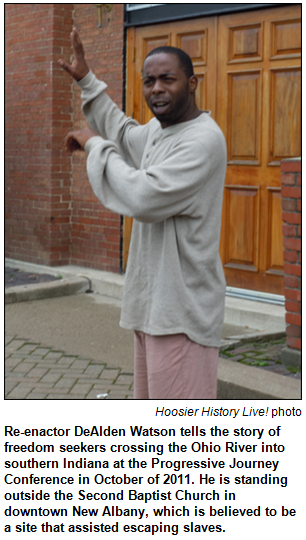 Dona has joined us for shows about roots tracing, as well as about various aspects of Underground Railroad heritage in Indiana. The Underground Railroad era generally is defined as beginning in the mid-1830s.
Dona has joined us for shows about roots tracing, as well as about various aspects of Underground Railroad heritage in Indiana. The Underground Railroad era generally is defined as beginning in the mid-1830s.
Oral histories, diaries, notations in family Bibles and letters have been crucial in figuring out the routes, buildings and people associated with the effort to help runaway slaves - or freedom seekers - as they passed through Indiana.
How, though, do you document something that obviously was kept secret?
In addition to tackling that issue - Nelson asks Dona and Kisha how people can determine the reliability of diary entries or letters - we also explore which regions of the state had frequent stops on the Underground Railroad. And which ones had very few.
Learn more: Clickable map showing Underground Railroad sites in Indiana.
According to several accounts, St. Joseph County, which includes South Bend, served an integral role with fugitive slaves as they headed north. And because of the prevalence of anti-slavery Quakers in Wayne County and other parts of far-eastern Indiana, that region also had a flurry of clandestine activity.
During our show, we also will discuss the frequency with which so-called slave catchers from the South - often mercenaries - combed Indiana in search of freedom seekers.
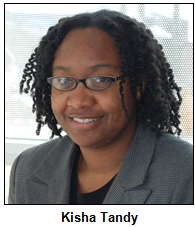 Related to that, we will explore the frequency with which home and business owners were prosecuted for harboring escaped slaves or helping them in other ways. In some cases, abolitionists arranged for medical care. Small groups of Hoosier women secretly gathered to weave blankets and clothes for the refugees, who often fled with scarcely any possessions.
Related to that, we will explore the frequency with which home and business owners were prosecuted for harboring escaped slaves or helping them in other ways. In some cases, abolitionists arranged for medical care. Small groups of Hoosier women secretly gathered to weave blankets and clothes for the refugees, who often fled with scarcely any possessions.
Also during the show, Dona and Kisha share insights about on-going efforts to preserve the Underground Railroad heritage across the state.
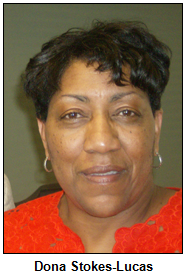 For a program in 2011 with historic preservationist Maxine Brown of Corydon, Hoosier History Live! even explored freedom seekers in Indiana before the Underground Railroad was established - in some cases, several years before statehood was achieved in 1816.
For a program in 2011 with historic preservationist Maxine Brown of Corydon, Hoosier History Live! even explored freedom seekers in Indiana before the Underground Railroad was established - in some cases, several years before statehood was achieved in 1816.
Learn more: Click on these Hoosier History Live! show newsletters (2008 through 2013) with African-American history themes from our trove of 250 shows:
- Early African-American settlements.
- KKK stranglehold in the 1920s.
- Slave trial in 1820s Indiana.
- Jazz history in Indy with Chuck Workman.
- Freedom seekers before the Underground Railroad.
- Negro Leagues baseball and Indy.
- African-American newspapers across Indiana.
Roadtrip: Underground Railroad in Jeffersonville
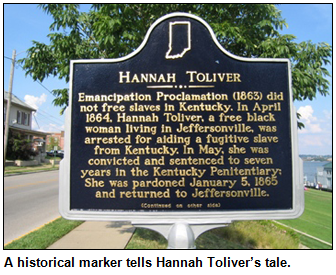 Guest Roadtripper and historic preservationist Maxine Brown of Corydon, founder of the Indiana African American Heritage Trail, suggests we take a Roadtrip to southern Indiana, that part of the state along the Ohio River rich with Underground Railroad activity because of its proximity to the slave state of Kentucky.
Guest Roadtripper and historic preservationist Maxine Brown of Corydon, founder of the Indiana African American Heritage Trail, suggests we take a Roadtrip to southern Indiana, that part of the state along the Ohio River rich with Underground Railroad activity because of its proximity to the slave state of Kentucky.
Hannah Toliver was a free black woman living in Jeffersonville before the Civil War and was an Underground Railroad activist. She was was arrested for aiding a fugitive slave from Kentucky, and she served time in the Kentucky Penitentiary in Frankfort before being released and returned to Jeffersonville. Her historical marker is on Riverside Drive in Jeffersonville.
Maxine Brown, who also known for having restored the Leora Brown Colored School in Corydon, will suggest Underground Railroad spots to visit in "her" part of the state.
History Mystery
In a small town near Richmond during the 1840s, a Quaker couple helped so many escaped slaves in their journeys to freedom that their home became known as the "Grand Central Station" of the Underground Railroad.
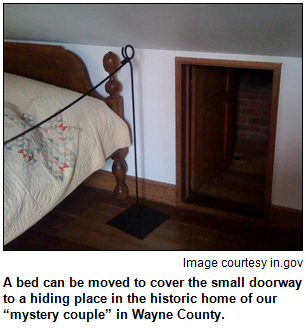 Their red brick, two-story house in Wayne County had a cellar as well as a hidden, second-floor bedroom - actually, a large crawl space - where freedom seekers could hide.
Their red brick, two-story house in Wayne County had a cellar as well as a hidden, second-floor bedroom - actually, a large crawl space - where freedom seekers could hide.
Feeling passionately that slavery was wrong, the couple convinced other Quakers in their town to join their crusade. A prosperous banker, mill owner and merchant, he prevailed on townspeople to help transport and conceal escaped slaves. She persuaded her friends to gather at her spinning wheel and help weave blankets and clothes for the refugees.
Today, their home is a popular destination for school field trips.
Question: Name the Quaker couple.
Please provide their surname and both of their first names.
The prize is a pair of tickets to the Benjamin Harrison Presidential Site, four admissions to the Indiana Experience at the Indiana History Center, and a gift certificate for Greatimes Family Fun Park on Indy’s southside. These prizes are courtesy of Visit Indy.
Centennial in 1916, bicentennial in 2016
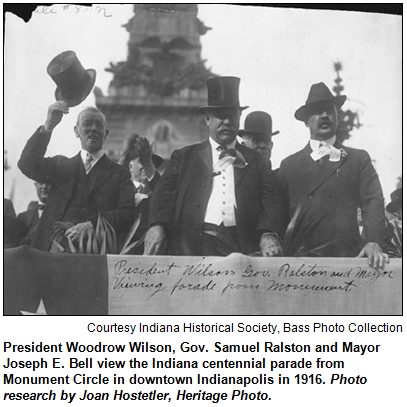 (June 22, 2013) - As Indiana prepares to celebrate a big birthday, Hoosier History Live! look ahead and back. That is, we explore what happened in 1916 when Indiana celebrated 100 years of statehood. And we will explore plans under way for the upcoming bicentennial in 2016.
(June 22, 2013) - As Indiana prepares to celebrate a big birthday, Hoosier History Live! look ahead and back. That is, we explore what happened in 1916 when Indiana celebrated 100 years of statehood. And we will explore plans under way for the upcoming bicentennial in 2016.
In one sense, the 1916 centennial hoopla will be hard to top: It's credited with sparking the process to create Indiana's first state parks.
To share insights about the 100- and 200-year celebrations, Nelson is joined in studio by Indiana's widely admired and award-winning historian, James Madison, a professor emeritus of history at Indiana University and the author of several books about various aspects of the state's history, and by Chris Jensen, executive director of the Indiana Bicentennial Commission.
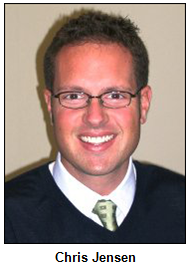 According to an article in Traces of Indiana and Midwestern History magazine, the 1916 centennial was "conducted with great energy and little funding," although it ended up having a "lasting impact" on the 19th state.
According to an article in Traces of Indiana and Midwestern History magazine, the 1916 centennial was "conducted with great energy and little funding," although it ended up having a "lasting impact" on the 19th state.
President Woodrow Wilson spoke at the Indiana State Fairgrounds Coliseum. A weeklong pageant (called the Pageant of Indiana) was held at Riverside Park in Indianapolis. 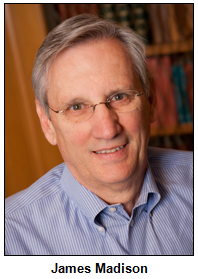 A silent movie (titled Indiana) was filmed in which Hoosier poet James Whitcomb Riley appeared (click link to view a portion of the film commission by the Selig Polyscope Co. All seven reels of this epic may be lost.)
A silent movie (titled Indiana) was filmed in which Hoosier poet James Whitcomb Riley appeared (click link to view a portion of the film commission by the Selig Polyscope Co. All seven reels of this epic may be lost.)
And high school students across the state donned American Indian outfits and feathers.
Enthusiasm generated during the centennial eventually resulted in the purchase of Indiana's first two state parks, Turkey Run in Parke County and McCormick's Creek in Owen County. Civic leader Richard Lieber, who chaired the centennial's park committee, served as a "tireless advocate" of the purchases, as Traces put it.
For the 200th celebration, our guest Jim Madison is one of 15 distinguished Hoosiers who have been appointed to the bicentennial commission, which is overseeing the planning and execution of statewide events. 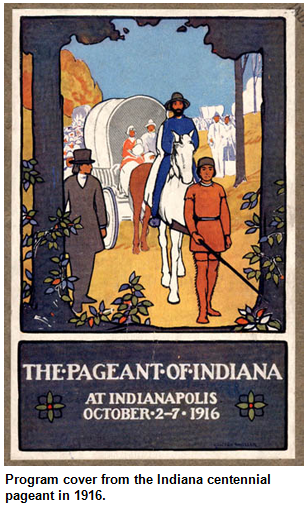 The commission is being chaired by former Lt. Gov. Becky Skillman, a Republican, and former U.S. Rep. Lee Hamilton, a Democrat. The state's first lady, Karen Pence, is serving as the official bicentennial ambassador.
The commission is being chaired by former Lt. Gov. Becky Skillman, a Republican, and former U.S. Rep. Lee Hamilton, a Democrat. The state's first lady, Karen Pence, is serving as the official bicentennial ambassador.
Jim Madison is the author of several books about various aspects of Indiana history, including The Indiana Way: A State History, A Lynching in the Heartland and Eli Lilly: A Life. He also is a trustee of the Indiana Historical Society and a board member of Indiana Humanities.
According to information from our guest Chris Jensen, the goal of the 2016 celebration is to "honor our state's 200 years of history, but to do so in a modern way that engages all Hoosiers and leaves a lasting legacy for future generations."
Plans are being developed for a Bicentennial torch relay that will run through all of the state's 92 counties. The relay will highlight passing the torch from one generation to the next.
The bicentennial commission also hopes to spark "legacy projects" across the state. Specifically, the commission wants to work with communities to identify local projects that are dedicated to the bicentennial, but that also will have a lasting impact. Under a Bicentennial Nature Trust dedicated to nature conservation, 35 projects in 28 counties already have received $8.1 million in grants, according to Chris Jensen. The trust is funded by money from the state and the Lilly Endowment.
In addition to the state park system that was kicked off in 1916, the centennial also spurred the formation of groups such as the Society of Indiana Pioneers, a nonprofit dedicated to preserving and honoring the work of the state's pioneers. 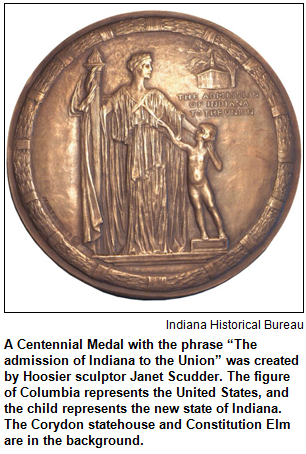 Members are descended from settlers who arrived during the pioneer era, generally defined as before 1840. (Nelson is a board member of the Society of Indiana Pioneers.)
Members are descended from settlers who arrived during the pioneer era, generally defined as before 1840. (Nelson is a board member of the Society of Indiana Pioneers.)
"Local historical societies were forming or reactivating across Indiana," Traces reported, referring to the impact of the 1916 centennial.
But the hoopla took awhile to ignite. According to a booklet published after the 1916 festivities, an initial challenge involved galvanizing Hoosiers about the state’s 100th anniversary.
"The people of Indiana as a whole knew little and therefore cared little about the centennial anniversary. ... There was the usual amount of inertia to overcome."
According to an Indianapolis Star account about the Pageant of Indiana in Riverside Park, its huge cast "nearly matched the number of onlookers," but it was nevertheless a "hit." The pageant, which reviewed the state's history, opened every afternoon for six days and continued after sunset, with electric torches providing the illumination.
Re-enactors - who included adults, as well as 1,500 high school students and children - portrayed French soldiers, Native American warriors, Quaker farm wives and famous Hoosiers such as Gen. Lew Wallace, author of Ben-Hur.
Roadtrip: Danville's Courthouse Square
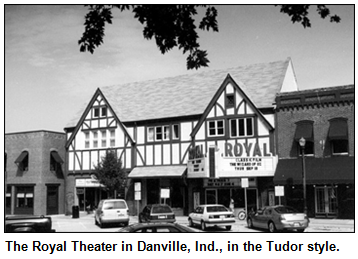 Guest Roadtripper Eric Grayson, film historian, suggests we head just a bit west of Indianapolis on State Road 36 to visit Danville, which has a classic Indiana small-town courthouse square. The square boasts a wonderful 1907 courthouse and is home to one of the most moving Memorial Day displays in the area.
Guest Roadtripper Eric Grayson, film historian, suggests we head just a bit west of Indianapolis on State Road 36 to visit Danville, which has a classic Indiana small-town courthouse square. The square boasts a wonderful 1907 courthouse and is home to one of the most moving Memorial Day displays in the area.
Crowning the square is the historic Royal Theater, which one of Indiana's only movie theaters in the Tudor style. The facility has been lovingly maintained and run by the Shearer family for the past several years.
Next door to the Royal is an outstanding Italian restaurant, Frank's Place, run by a real Italian. It's in a historic building, but the inside is all-new, and the smells are great.
Around the corner, of course, is the legendary Mayberry Cafe, a takeoff on television's classic Andy Griffith Show. The Mayberry Cafe has a 1963 police squad car parked in front, so you can't miss it!
History Mystery
One of Indiana's first counties to be organized already is celebrating its bicentennial this year. Located in far-southwestern Indiana, the county was organized in 1813.
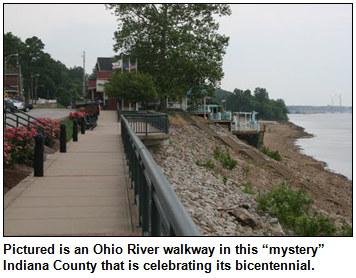 Its county seat is a town to which a teenage Abe Lincoln walked so he could sit in courtrooms and observe cases argued by a local lawyer, who mentored him. (The bicentennial county is located next to Spencer County, where the Lincoln family lived.)
Its county seat is a town to which a teenage Abe Lincoln walked so he could sit in courtrooms and observe cases argued by a local lawyer, who mentored him. (The bicentennial county is located next to Spencer County, where the Lincoln family lived.)
Another town in the county is known for its historic Main Street and scenic "river village" ambience; the town is nestled on the Ohio River. Some of the county is considered to be part of the metro area of Evansville, which is located in another bordering county, Vanderburgh County.
Question: Name the far-southwestern county celebrating its 200th birthday this year.
Hint: It often is listed among the 10 fastest-growing counties in the state.
The prize is a pair of tickets to the James Whitcomb Riley Museum Home and four admissions to the Indiana Experience at the Indiana History Center. These prizes are courtesy of Visit Indy.
Indy Mayor Greg Ballard on Marines history and 'old' Cathedral High
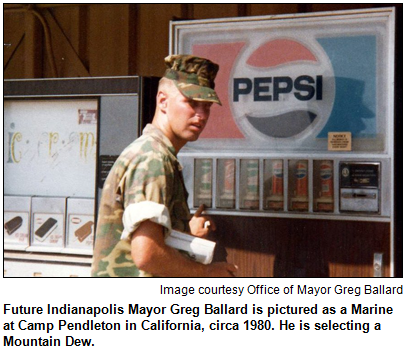 (June 15, 2013) - An Indianapolis native, he grew up on the Eastside, attended the "old" Cathedral High School (when it was located downtown and had all male students) and eventually enlisted in the U.S. Marine Corps.
(June 15, 2013) - An Indianapolis native, he grew up on the Eastside, attended the "old" Cathedral High School (when it was located downtown and had all male students) and eventually enlisted in the U.S. Marine Corps.
So there's much local history to cover with Mayor Greg Ballard of Indianapolis, 58, who was elected to his second term in 2011. As Hoosier History Live! segues from a former mayor of Indy (Bill Hudnut, the June 8 show guest) to his current counterpart, Mayor Ballard is Nelson's studio guest for a show that explores history topics that have been intertwined with his life.
They include the links between the Hoosier state and the Marines. After a 23-year military career, Mayor Ballard, a Republican, retired as a lieutenant colonel from the Marines in 2001 and returned to his home town to enter private business.
He shares insights about who and what influenced him during his youth to join the U.S. Marine Corps. 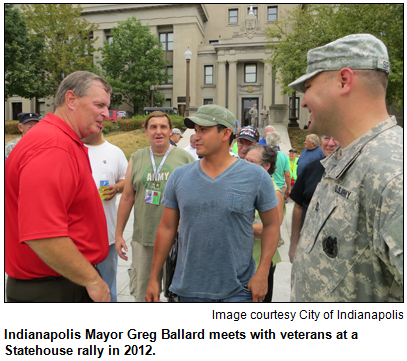 The future mayor joined the Marines after studying economics at Indiana University in the 1970s.
The future mayor joined the Marines after studying economics at Indiana University in the 1970s.
The decision eventually led to assignments in places such as Okinawa, Japan; Saudi Arabia during the first Persian Gulf War; and Stuttgart, Germany, as well as in Michigan, North Carolina and California, where he met his wife, Winnie Ballard, a native of the Philippines. During the first Gulf War, the future mayor was promoted to major.
Other links between the Marines and the Hoosier state:
- Hoosiers who have achieved distinction in the Marines include David Shoup (1904-1983), a Tippecanoe County native who grew up on farms there and near Covington. A Medal of Honor winner during World War II, Shoup led the U.S. invasion during the Battle of Tarawa in the Pacific Theater of the war. He rose to become the 22nd Commandant of the U.S. Marine Corps, serving in the top post during the Eisenhower and Kennedy administrations. Shoup was credited with emphasizing combat readiness and fiscal efficiency; he later became a vocal critic of the Vietnam War and is buried in Arlington National Cemetery.
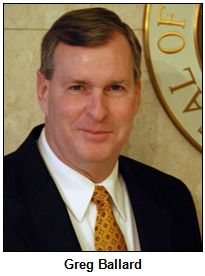 Specifications for many of the weapons, night-vision goggles and other equipment used overseas by the Marines are developed at Crane Naval Warfare Center in southwestern Indiana. (The Marines and the Navy both fall under the Secretary of the Navy.) Created during World War II, Crane Naval Warfare Center consists of 64,000 acres in Greene and Martin counties and employs about 5,000 people. Equipment used by the Marines also is tested at Crane.
Specifications for many of the weapons, night-vision goggles and other equipment used overseas by the Marines are developed at Crane Naval Warfare Center in southwestern Indiana. (The Marines and the Navy both fall under the Secretary of the Navy.) Created during World War II, Crane Naval Warfare Center consists of 64,000 acres in Greene and Martin counties and employs about 5,000 people. Equipment used by the Marines also is tested at Crane.- Well-known living Hoosiers who have served in the Marines include Carol Mutter, a retired lieutenant general who lives in Brownsburg. (She was born in Colorado and became the first woman to receive the rank of lieutenant general in the Marine Corps.) Others include historic novelist James Alexander Thom, a Korean War veteran whose bestsellers include Follow the River, and Julia Whitehead, executive director of the Kurt Vonnegut Memorial Library.
Back in the mayor's hometown, we also will focus on Cathedral High School, where he was a member of the Class of '72.
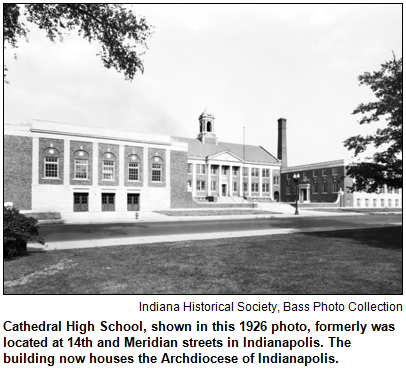 Since its founding in 1918, the Catholic high school had been located at 14th and Meridian streets and attended only by boys. The future mayor's years there were preceded and followed by major changes.
Since its founding in 1918, the Catholic high school had been located at 14th and Meridian streets and attended only by boys. The future mayor's years there were preceded and followed by major changes.
In 1976, four years after he graduated, Cathedral merged with Ladywood, an all-girls Catholic academy located on the northeast-side, a decision that was presented as a financial necessity for both schools. The merged, co-ed school, which took the Cathedral name, is on the former Ladywood site on East 56th Street.
Previously, while the future mayor was attending Cathedral, Ladywood had merged in 1971 with Cathedral's "sister" school downtown, St. Agnes Academy. Located just to the south of the "old" Cathedral, the former academy now is the site of St. Agnes Apartments.
Greg Ballard, who grew up on the Eastside in a family of five children, attended Cathedral on a scholarship. In addition to graduating from IU, he obtained a master's in military science from Marine Corps University in Quantico, Va. His defeat of incumbent Bart Peterson in the 2007 mayoral election has been called one of the biggest upsets in Indy's political history.
Roadtrip: Monument Circle for kids
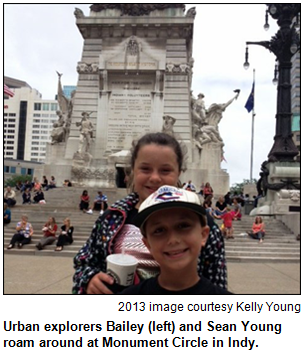 Guest Roadtripper Kelly Young of Baise Communications reports that she took her kids for a recent tour of Monument Circle in downtown Indianapolis, and her children were fascinated by Christ Church Cathedral, with its early gothic revival architecture, Tiffany stained-glass windows and pipe organ.
Guest Roadtripper Kelly Young of Baise Communications reports that she took her kids for a recent tour of Monument Circle in downtown Indianapolis, and her children were fascinated by Christ Church Cathedral, with its early gothic revival architecture, Tiffany stained-glass windows and pipe organ.
Kelly's daughter, age 10, had studied President Lincoln in school this year and was fascinated to learn that the church bells had rung out as Lincoln's body lay in state at the nearly Capitol.
Kelly and crew then crossed the street, headed up the 330 steps (yes, walked!) to the observation level of the Soldiers and Sailors Monument for a great view of the city, and they visited the Civil War Museum in the lower level.
They topped off their Roadtrip with ice cream from the Chocolate Cafe, and then a quick trip back in time for Kelly at Rocket Fizz, a candy shop with nearly every type of novelty candy. Both of these sweet spots are right on the Circle.
History Mystery
More than 25 years before future Mayor Greg Ballard became a Marine, another well-known Indianapolis political figure served in the Marines. 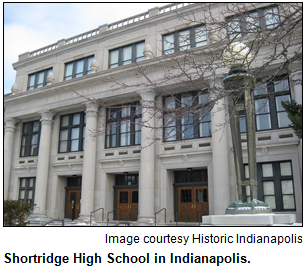 As a Marine from 1950 to 1952, he served during the Korean War, saw combat and endured two fierce winters in Korea.
As a Marine from 1950 to 1952, he served during the Korean War, saw combat and endured two fierce winters in Korea.
The future politician was born in Indy in 1932. He graduated from Shortridge High School in 1949, then served in the Marines. After that, he enrolled in Indiana University. In addition to a long political career - he held public office almost without interruption from 1964 until retiring in 1997 - he worked as a deputy sheriff in Marion County, a lawyer, an author and a college instructor.
Question: Who was he?
The prize is a pair of tickets to the President Benjamin Harrison Presidential Site and four admissions to the Indiana Experience at the Indiana History Center. These prizes are courtesy of Visit Indy.
Former Indy Mayor Bill Hudnut
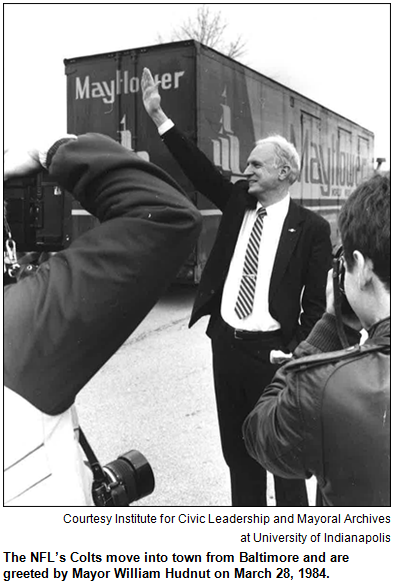 (June 8, 2013) - He served as mayor of Indiana's capital city longer than anyone else in history.
(June 8, 2013) - He served as mayor of Indiana's capital city longer than anyone else in history.
For 16 eventful years - a span of four terms that included unforgettable chapters, many of which have been the focus of previous Hoosier History Live! shows (such as the notorious ![]() Blizzard of '78 and the massive Pan American Games of 1987 - William Hudnut III led Indianapolis and attained national prominence.
Blizzard of '78 and the massive Pan American Games of 1987 - William Hudnut III led Indianapolis and attained national prominence.
Although former Mayor Hudnut and his wife, Beverly Hudnut, primarily have lived in the Washington D.C. area since he left the top Indy office in 1992, he makes a return visit and - for our 250th show - joins Nelson in studio to explore what has become known as "the Hudnut era."
He didn't start out as a Hoosier. Born in Cincinnati in 1932, Bill Hudnut grew up in New Lebanon, N.Y., graduated from Princeton University and, like his father and grandfather, became a Presbyterian minister. He moved to Indy in 1963 to serve as pastor of Second Presbyterian Church, one of the city's most prestigious congregations.
By the time he left Indy, the city's skyline had been transformed - by, among other structures, the domed stadium that initially was known as the Hoosier Dome when it opened in 1984. Mayor Hudnut, a Republican, championed the sports facility's construction, even though the city did not yet have a National Football League team to play in it. 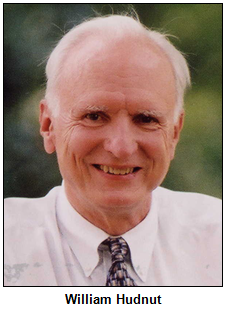 The Hoosier Dome was still not quite finished in late March 1984 when the Baltimore Colts moved to Indy on Mayflower Van Lines trucks late at night. The move beat a looming deadline in Maryland, where the team had been squabbling with lawmakers and civic leaders.
The Hoosier Dome was still not quite finished in late March 1984 when the Baltimore Colts moved to Indy on Mayflower Van Lines trucks late at night. The move beat a looming deadline in Maryland, where the team had been squabbling with lawmakers and civic leaders.
The history of what later was named the RCA Dome was the focus of our third Hoosier History Live! Show after our debut in early 2008, shortly before the stadium's demolition. That program followed a show about the 30th anniversary of the Blizzard of '78, the worst in city history, during which the lanky, 6-foot-4 mayor rode on snowplows and urged residents to persevere.
An unabashed cheerleader known for his willingness to do just about anything to rally his adopted hometown - including donning a leprechaun outfit on St. Patrick's Day - Bill Hudnut particularly advocated the resurgence of downtown and Indy's unofficial designation as the country's amateur sports capital. During his terms as mayor (1976-92), he also served as president of the National League of Cities.
Nelson asks the former mayor to identify his greatest accomplishments, as well as his biggest disappointments. A recent article in the Indianapolis Star about the 25th anniversary of the concert venue initially known as Deer Creek Music Center (now Klipsch Music Center) indicated then-Mayor Hudnut unsuccessfully pushed for it to be built in what became White River State Park, rather than its eventual site in Hamilton County.
"What would you do if you were called to lead a city known as Naptown, India-No-Place or Brickyard in a Cornfield?" Bill Hudnut asks in his book The Hudnut Years (IU Press, 1995). His other books include Minister Mayor (Westminster Press, 1987).
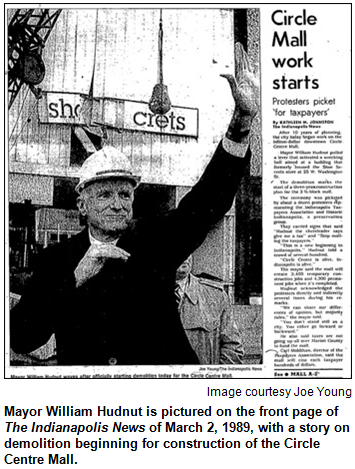 Citing Hudnut's initiatives with downtown rejuvenation and the city's track record as a sports capital, current Mayor Greg Ballard in January renamed a downtown park Hudnut Commons. Formerly known as Capitol Commons, the park is at Maryland Street and Capitol Avenue, across the street from the Indiana Convention Center.
Citing Hudnut's initiatives with downtown rejuvenation and the city's track record as a sports capital, current Mayor Greg Ballard in January renamed a downtown park Hudnut Commons. Formerly known as Capitol Commons, the park is at Maryland Street and Capitol Avenue, across the street from the Indiana Convention Center.
Before his record-breaking mayoral terms, Bill Hudnut served as a U.S. congressman from Indianapolis. In 1972, he defeated his friend, incumbent U.S. Rep. Andy Jacobs Jr. - who, in turn, came back and defeated Hudnut two years later.
During the mid-1970s, in between his stints in public office, Bill Hudnut was on the faculty at the University of Indianapolis (then Indiana Central University), where he taught political science.
As mayor, he oversaw highly touted partnerships between the public and private sectors. In 1990, the Indianapolis News estimated that with "gifts from the Lilly Endowment, millions of dollars in tax abatements and other incentives, and investments from private developers, more than $4 billion worth of construction took place downtown. ... Public and private city leaders placed an unprecedented emphasis on downtown development."
|
Roadtrip: Whitewater Canal State Historic Site
Guest Roadtripper Christopher Della Rocco will call in on Saturday to tell us about current activities at Whitewater Canal State Historic Site, located in the charming 1836 canal village of Metamora, Ind., which is southeast of Indianapolis in the Whitewater Valley in Franklin County.
The site offers a new Whitewater Canal Experience package that allows visitors to experience the best of the site at a discounted rate. And coming up June 29 is a special event called Twilight Time, which features an island-themed catered dinner in Grist Mill Park and twilight cruise on the Ben Franklin III canal boat. Slow and relaxing are the characteristics of this boat ride!
The Whitewater Canal State Historic Site is open for tours of the grist mill and canal boat rides Wednesdays through Sundays. Canal rides are at noon, 1, 2, 3 and 4 p.m. - dependent on canal conditions - the same days. More information can be found online or at (765) 647-6512. Enjoy your summer!
|
History Mystery
One of the best-known men in America from the 1860s through the 1880s had, earlier in his career, served as the minister of Second Presbyterian Church in Indianapolis. A clergyman, abolitionist, social reformer and speaker, he was not a Hoosier by birth or upbringing.
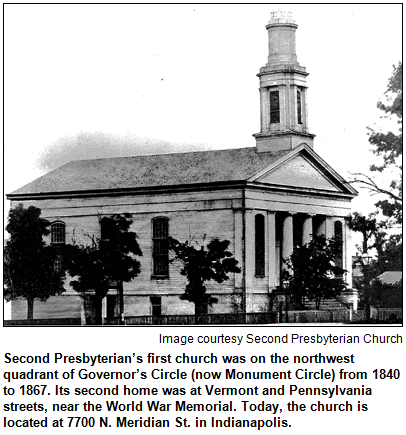 However, he moved to Indianapolis in 1839 and, while preaching at Second Presbyterian Church, held his first revival meetings and, according to historians, solidified his anti-slavery stance. As a result of his dynamic preaching, he built Second Presbyterian into the largest congregation in the Hoosier capital.
However, he moved to Indianapolis in 1839 and, while preaching at Second Presbyterian Church, held his first revival meetings and, according to historians, solidified his anti-slavery stance. As a result of his dynamic preaching, he built Second Presbyterian into the largest congregation in the Hoosier capital.
Before coming to Indianapolis, he had been the pastor at a Presbyterian church in Lawrenceburg, Ind., for two years.
The clergyman left Indiana in 1847 and rose to national prominence on the East Coast.
Question: Who was he?
Hint: His sister wrote one of the country's best-selling novels during the 1850s.
The prize is a pair of tickets to the Eiteljorg Museum and four admissions to the Indiana Experience at the Indiana History Center. These prizes are courtesy of Visit Indy.
Lost cemeteries
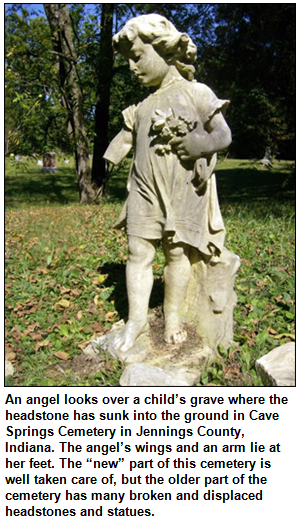 (June 1, 2013) - Lost cemeteries have been in the news since Indianapolis police reported the discovery of a human jawbone in Garfield Park on the city's south side. Could the historic park, the oldest public park in Indy, be the site of a lost cemetery?
(June 1, 2013) - Lost cemeteries have been in the news since Indianapolis police reported the discovery of a human jawbone in Garfield Park on the city's south side. Could the historic park, the oldest public park in Indy, be the site of a lost cemetery?
To explore lost or "nearly lost" cemeteries across the state - and issues associated with the forgotten or neglected burial grounds - Nelson is joined in studio by Jeannie Regan-Dinius, cemetery and burial ground registry coordinator for the Indiana Department of Natural Resources, and pioneer cemetery advocate Theresa Berghoff, an Elwood native who now lives in Indianapolis.
They share details about lost graveyards everywhere from Berne in Adams County and the Madison County community of Leisure, to a site near Kessler Boulevard and Keystone Avenue on the north side of Indy, and Rome in southwestern Indiana.
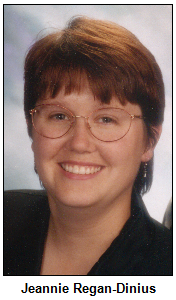 Nelson and his guests also explore Greenlawn Cemetery, which was founded in 1832 near White River and Kentucky Avenue in Indy. More than 1,600 pioneers had been buried in Greenlawn when, because the graveyard was prone to flooding, city leaders initiated a mass reburial about 155 years ago with the creation of Crown Hill Cemetery, the country's third-largest private cemetery. The site for Crown Hill was chosen in part because it was believed to be the highest ground at the time in Indianapolis and thus not prone to flooding.
Nelson and his guests also explore Greenlawn Cemetery, which was founded in 1832 near White River and Kentucky Avenue in Indy. More than 1,600 pioneers had been buried in Greenlawn when, because the graveyard was prone to flooding, city leaders initiated a mass reburial about 155 years ago with the creation of Crown Hill Cemetery, the country's third-largest private cemetery. The site for Crown Hill was chosen in part because it was believed to be the highest ground at the time in Indianapolis and thus not prone to flooding.
In 2008, our guest Jeannie Regan-Dinius helped oversee the move of 33 tombstone and remains of Hoosier pioneers from a mid-1800s cemetery in the Castleton area of Indy to Crown Hill. Shortly after that reburial - which was initiated to allow for the widening of I-69 near its interchange with I-465 - Jeannie joined Nelson for a Hoosier History Live! show during our first year on the air.
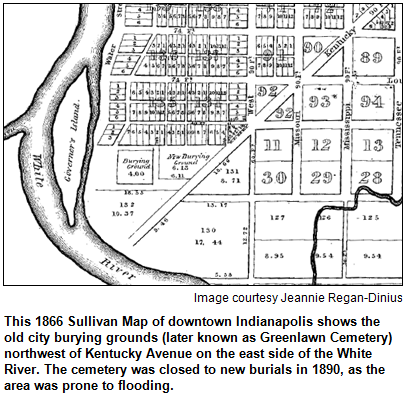 Now, they also are joined by Theresa Berghoff, a cemetery restorer whose ancestors include Revolutionary and Civil War veterans buried in Wayne County. Theresa, who has helped restore tombstones, reports there are lost or "nearly lost" cemeteries in Richmond, and in the Augusta community in Pike Township on the northwest side of Indianapolis. Augusta Cemetery is the burial site of several Civil War veterans.
Now, they also are joined by Theresa Berghoff, a cemetery restorer whose ancestors include Revolutionary and Civil War veterans buried in Wayne County. Theresa, who has helped restore tombstones, reports there are lost or "nearly lost" cemeteries in Richmond, and in the Augusta community in Pike Township on the northwest side of Indianapolis. Augusta Cemetery is the burial site of several Civil War veterans.
In Richmond, Maple Grove Cemetery, which apparently had been the site of more than 500 graves, was closed during the late 1800s. The cemetery's land then became part of Glen Miller Park. Many of Richmond's first settlers were buried in Maple Grove Cemetery.
According to Theresa's research, the first burial ground for white settlers in what became Indianapolis was known as the Plague Cemetery. Established about 1820, the cemetery was the burial site for victims of a malaria epidemic that swept the newly developing state capital, which was partially built on swampland and marshes. 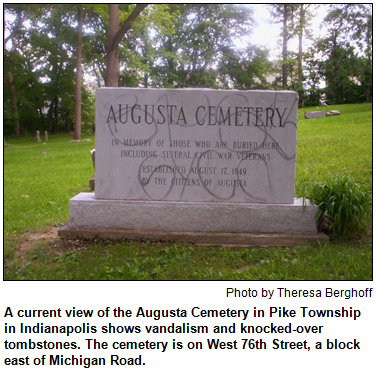 The site of the early cemetery was later marked with a large stone next to the intersections of Barnhill and Michigan streets near the IU Medical Center on the IUPUI campus.
The site of the early cemetery was later marked with a large stone next to the intersections of Barnhill and Michigan streets near the IU Medical Center on the IUPUI campus.
According to Jeannie's research, the lost graveyard in Berne was a Mennonite cemetery. She has copies of notices published in local newspapers in 1908 urging relatives to arrange for reburials of their ancestors to allow for road improvements.
During our show, Jeannie shares insights about the protocol that farmers and other property owners should follow if they discover human bones. Nelson and his guests also explore vandalism of cemeteries, as well as the various reasons some graveyards have become lost or forgotten.
Some "learn more" websites:
- Indiana Pioneer Cemeteries Restoration Project.
- Find a Grave.
- Hoosier Home's Marion County Cemeteries.
Roadtrip: Summer nights on the canal
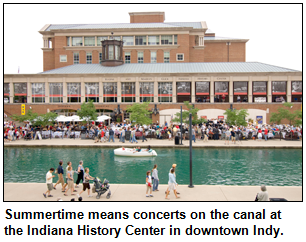 Amy Lamb of the Indiana Historical Society tells us that there are plenty of relaxing summer evenings ahead downtown on the Central Canal with the time-honored favorite, Concerts on the Canal, plus the second year of Museum Nights on the Canal.
Amy Lamb of the Indiana Historical Society tells us that there are plenty of relaxing summer evenings ahead downtown on the Central Canal with the time-honored favorite, Concerts on the Canal, plus the second year of Museum Nights on the Canal.
On Thursday evenings this summer through Aug. 8, the IHS will host some of the area's best performers. Concerts take place from 6 to 8 p.m., with the exception of the annual Independence Day Bash on July 4 (5 p.m. start), and free seating is available on the grassy slope across the canal.
For June and July concert dates, IHS's Museum Nights on the Canal will offer free Indiana Experience admission, as well as hands-on activities and extra entertainment, from 4 to 8 p.m. The Eugene and Marilyn Glick Indiana History Center, home of the IHS, is located at 450 W. Ohio St. in downtown Indianapolis, along the picturesque, historic Central Canal.
History Mystery
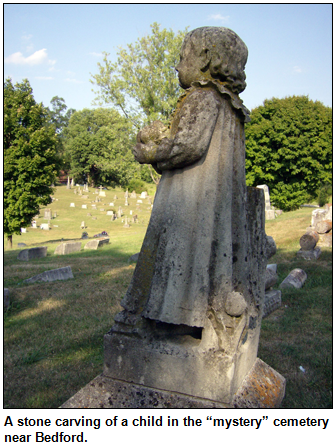 A cemetery in southern Indiana has been called a "tombstone tourist's delight" and an "outdoor sculpture park." The cemetery, which dates to the 1880s and is located near Bedford in Lawrence County, features dozens of personalized monuments that were created for the graves of local residents.
A cemetery in southern Indiana has been called a "tombstone tourist's delight" and an "outdoor sculpture park." The cemetery, which dates to the 1880s and is located near Bedford in Lawrence County, features dozens of personalized monuments that were created for the graves of local residents.
Because the area is known as the "Limestone Capital of the World," generations of highly skilled stone cutters were available to carve sculptures memorializing the deceased. For example, the cemetery, which is on scenic, rolling terrain, includes sculptures of a golfer, a World War I doughboy and the tools of a limestone cutter on various burial sites.
Question: Name the historic cemetery near Bedford.
The prize is a pair of tickets to the Indiana State Museum and four admissions to the Indiana Experience at the Indiana History Center. These prizes are courtesy of Visit Indy.
Historic baseball stadium into apartments
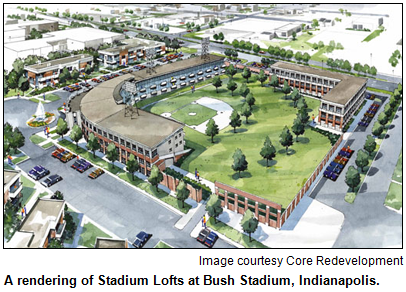 (May 25, 2013) - Apparently it will be the first time in the country that a baseball stadium will be converted into residences. The stadium is historic Bush Stadium in Indianapolis, which was the home ballpark of the Indianapolis Indians for nearly 65 years.
(May 25, 2013) - Apparently it will be the first time in the country that a baseball stadium will be converted into residences. The stadium is historic Bush Stadium in Indianapolis, which was the home ballpark of the Indianapolis Indians for nearly 65 years.
Now the West 16th Street stadium - which had been deteriorating dramatically since the minor-league team left and began playing home games at Victory Field in July 1996 - will be converted into apartments by John Watson of Core Redevelopment LLC.
The Stadium Lofts project - featuring 138 apartments set to open Aug. 1 - has attracted such extensive national interest that the National Baseball Hall of Fame and Museum in Cooperstown, N.Y., has contacted John for a mini-exhibit about the stadium re-use.
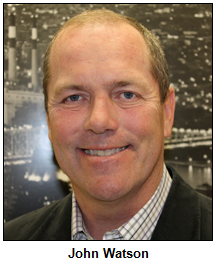 A former board chairman of Indiana Landmarks and a veteran developer known for transforming historic structures into residences, John is Nelson's studio guest. The previously uncertain fate of Bush Stadium, which was built in 1931 and initially known as Perry Stadium, was the focus of a Hoosier History Live! show in 2008, our first year on the air. At that point, the empty stadium was on Indiana Landmarks' list of 10 Most Endangered Places in the state.
A former board chairman of Indiana Landmarks and a veteran developer known for transforming historic structures into residences, John is Nelson's studio guest. The previously uncertain fate of Bush Stadium, which was built in 1931 and initially known as Perry Stadium, was the focus of a Hoosier History Live! show in 2008, our first year on the air. At that point, the empty stadium was on Indiana Landmarks' list of 10 Most Endangered Places in the state.
In addition to the 138 apartments in the $14 million Stadium Lofts conversion project, John Watson plans to build 144 other apartments - to be known as Stadium Flats - just west of the historic ballpark. He also plans to build an office complex in centerfield of the historic stadium.
According to a recent article in the Indianapolis Business Journal, the Stadium Lofts design "retains the outer shell of the Art Deco building and includes the look of an actual baseball field in the courtyard" for residents of the apartments.
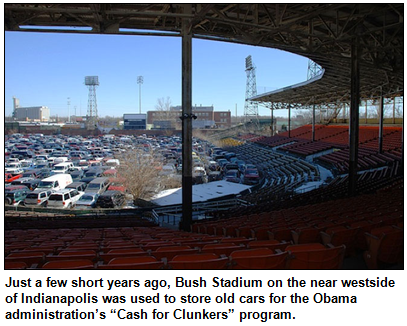 Once beloved, Bush Stadium is listed on the National Register of Historic Places and was considered such an outstanding example of a vintage ballpark that Hollywood took notice and selected it as the setting for the movie Eight Men Out (1988). The movie focused on the notorious Black Sox cheating scandal in the 1919 World Series.
Once beloved, Bush Stadium is listed on the National Register of Historic Places and was considered such an outstanding example of a vintage ballpark that Hollywood took notice and selected it as the setting for the movie Eight Men Out (1988). The movie focused on the notorious Black Sox cheating scandal in the 1919 World Series.
Bush Stadium also served as the venue for the baseball tournaments during the Pan American Games hosted by Indy in 1987.
However, after the Indians, a Triple-A team in baseball's minor leagues, moved to the newly built Victory Field in White River State Park, an attempt fizzled to make Bush the venue for midget auto racing. (A dirt racetrack had been installed.) A long, slow slide downhill followed.
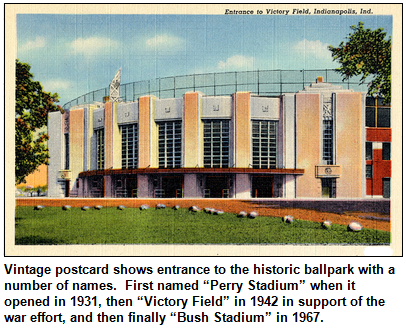 "Many considered Bush Stadium a lost cause," noted Indiana Preservationist, a publication of Indiana Landmarks, in a recent issue.
"Many considered Bush Stadium a lost cause," noted Indiana Preservationist, a publication of Indiana Landmarks, in a recent issue.
A front-page article in The Indianapolis Star in 2008 was headlined "Decaying diamond." Describing the vacant stadium as an "eyesore," the article noted that the concourse and former clubhouse for the Indians were "littered with trash, abandoned equipment and animal droppings." It described collapsed sections of stadium walls, holes in the grandstand roof and cracks in the steel columns and beams.
Even before the Indians moved to Victory Field, the stadium's deteriorating condition had been a major concern. In 1993, the governing body of minor league baseball announced the team would be moved from the city unless Bush Stadium was improved. Instead, the new Victory Field was constructed.
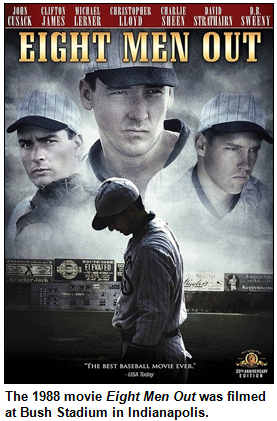 Fun fact: Bush also was known as Victory Field for many years. During World War II, the stadium's name was switched from Perry to Victory Field as a patriotic gesture. Then it was renamed again in honor of Owen Bush, a longtime manager of the Indians.
Fun fact: Bush also was known as Victory Field for many years. During World War II, the stadium's name was switched from Perry to Victory Field as a patriotic gesture. Then it was renamed again in honor of Owen Bush, a longtime manager of the Indians.
In the 1980s and '90s, our guest John Watson, in partnership with developer Carl Van Rooy, redeveloped several historic buildings in downtown Indy into condos or apartments. They included the Real Silk Factory, which opened in the 1920s and manufactured women's silk hose, then parachutes during World War II. John also oversaw the conversion of The Continental at Vermont Place, 410 N. Meridian St., into contemporary apartments.
According to the IBJ article, John is paying "homage" to Bush Stadium's heritage in the apartment development's courtyard by featuring in its design a "permanent baseball diamond made with dirt-colored concrete." He also plans to restore the old scoreboard in right field, which has taken a beating from scores of winters and thunderstorms.
In June 2011, city leaders announced a plan to make the area near Bush Stadium into a magnet for life sciences and high-tech businesses. The area would be known as 16 Tech.
Roadtrip: Chesterfield Spiritualist Camp near Anderson
Suzanne Stanis, director of heritage education and information at Indiana Landmarks, suggests a Roadtrip to historic Camp Chesterfield near Anderson, founded in 1886 and operated by the Indiana Association of Spiritualists.
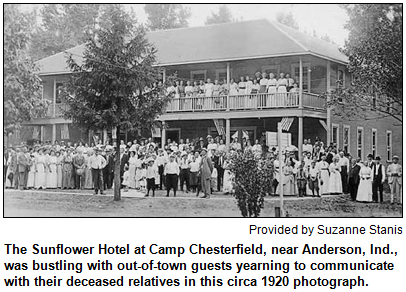 The camp began as a summer tent camp on the banks of White River and is now a permanent 40-acre settlement. Building boomlets followed World Wars I and II, when grief-stricken people found comfort in the possibility of speaking to relatives killed in battle through resident mediums.
The camp began as a summer tent camp on the banks of White River and is now a permanent 40-acre settlement. Building boomlets followed World Wars I and II, when grief-stricken people found comfort in the possibility of speaking to relatives killed in battle through resident mediums.
Spiritualism is a religion based on the belief that the spirits of the dead continue to evolve and can communicate with the living. From the 1840s through the 1920s, Spiritualism attracted a wide following, particularly among the educated elite, many of whom were also devout believers in various Protestant faiths.
Camp Chesterfield welcomes visitors to explore the Trail of Religion, a river rock grotto, and the "Toadstools," a meadow of concrete chairs and mini-pedestal tables where mediums held readings in the old days. The Hett Art Gallery and Museum presents a collection of psychic art, spirit photography and precipitated portraits (paintings of the deceased facilitated by mediums). The camp has a welcome center, and you can even spend the night in the 1940s Western Hotel for a very modest rate.
|
History Mystery
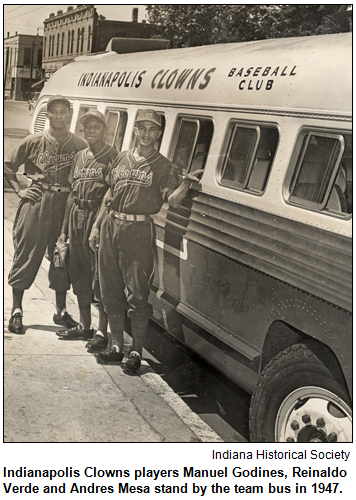 In addition to the Indianapolis Indians, the Indianapolis Clowns of the Negro Baseball Leagues played many of their home games at Bush Stadium. Before the heyday of the Clowns in the 1940s and '50s, an earlier baseball team of African-American players based in Indianapolis gained national prominence.
In addition to the Indianapolis Indians, the Indianapolis Clowns of the Negro Baseball Leagues played many of their home games at Bush Stadium. Before the heyday of the Clowns in the 1940s and '50s, an earlier baseball team of African-American players based in Indianapolis gained national prominence.
The Negro League team, which had a catchy name featuring three letters of the alphabet, was a fan favorite in the 1910s and '20s.
Question: Name the baseball team.
The prize is a gift certificate to California Pizza Kitchen in Circle Centre Mall and a pair of tickets to the Indiana State Museum. These prizes are courtesy of Visit Indy.
Hollywood icons Red Skelton, Robert Wise and Irene Dunne
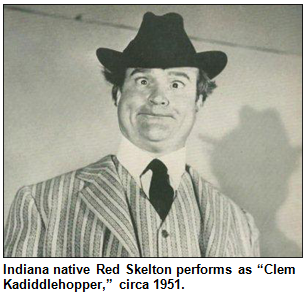 (May 18, 2013 - encore presentation) - Aside from being icons of Hollywood with links to Indiana, what could three luminaries - comedian Red Skelton, acclaimed director Robert Wise (The Sound of Music and West Side Story) and 1930s and '40s movie star Irene Dunne - have in common?
(May 18, 2013 - encore presentation) - Aside from being icons of Hollywood with links to Indiana, what could three luminaries - comedian Red Skelton, acclaimed director Robert Wise (The Sound of Music and West Side Story) and 1930s and '40s movie star Irene Dunne - have in common?
All three are the subjects of biographies written by movie historian Wes Gehring, a film professor at Ball State University who joins Nelson in studio for one of the most popular shows in our Hoosier History Live! archives. (Its original air date was Oct. 6, 2012.)
Wes' most recent book is Robert Wise Shadowlands (Indiana Historical Society Press), a biography of the Academy Award-winning director who was born in Winchester and grew up in Connersville.
 Not only do Wes and Nelson focus on the life and career of Robert Wise (1914-2005) during the show, they also explore the Hoosier roots and careers of Red Skelton, a native of Vincennes, and Irene Dunne, who grew up in Madison.
Not only do Wes and Nelson focus on the life and career of Robert Wise (1914-2005) during the show, they also explore the Hoosier roots and careers of Red Skelton, a native of Vincennes, and Irene Dunne, who grew up in Madison.
Wes delved into their lives in Red Skelton: The Mask Behind the Mask (IHS Press, 2008), which explores, as Wes puts it, the comedian's "hardscrabble beginnings with a shockingly dysfunctional family in southern Indiana" and Irene Dunne: First Lady of Hollywood (Scarecrow Press, 2003). It's a look at the versatile actress, who won critical acclaim for her roles in genres ranging from musicals like Show Boat (1936) to comedies (including The Awful Truth in 1937 with Cary Grant) and dramas such as I Remember Mama (1948).
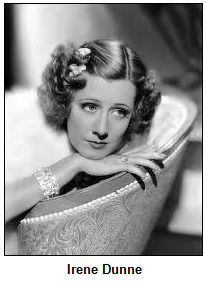 Red Skelton (1913-1997) achieved major stardom in movies, TV, radio and on Broadway after getting his start in vaudeville shows and, before that, in burlesque. Irene Dunne (1898-1990) was nominated five times for an Academy Award but never won. She also served one term as a delegate to the United Nations.
Red Skelton (1913-1997) achieved major stardom in movies, TV, radio and on Broadway after getting his start in vaudeville shows and, before that, in burlesque. Irene Dunne (1898-1990) was nominated five times for an Academy Award but never won. She also served one term as a delegate to the United Nations.
Like Irene Dunne, Robert Wise was known for astonishing versatility. He directed movies ranging from the science fiction cult classic The Day the Earth Stood Still (1951) and the horror movie The Haunting (1963), which is set in a spooky New England mansion to the two musicals for which Wise won Oscars as Best Director, The Sound of Music (1965) and West Side Story (1961).
At Connersville High School, the auditorium has been renamed in Wise's honor. In his biography of the filmmaker, Wes quotes from columns (titled "Wise Crax") he wrote for the high school newspaper.
Phil Gulley on Indiana festivals, summer jobs and other things Hoosier
(May 11, 2013) - As a teenager, Phil Gulley may have had the worst summer job in Indiana history. The popular Hoosier storyteller, humorist and Quaker pastor based in Danville once shared details with Nelson about the distasteful job of his youth.
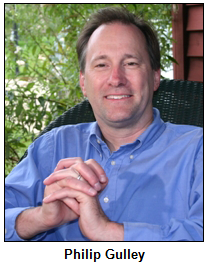 Tune in to our show to hear the unappetizing specifics, as Nelson is joined by Phil, whose bestselling, nationally distributed books include Front Porch Tales (1997) and Home Town Tales (1998), which were inspired by real people and episodes. He's also the author of Home to Harmony (2000) and other books in his acclaimed series of inspirational and humorous stories about the fictional town of Harmony. It seems to have at least a passing resemblance to Danville.
Tune in to our show to hear the unappetizing specifics, as Nelson is joined by Phil, whose bestselling, nationally distributed books include Front Porch Tales (1997) and Home Town Tales (1998), which were inspired by real people and episodes. He's also the author of Home to Harmony (2000) and other books in his acclaimed series of inspirational and humorous stories about the fictional town of Harmony. It seems to have at least a passing resemblance to Danville.
Known for his folksy style, Phil is a popular speaker and a columnist for Indianapolis Monthly magazine. He also has written non-fiction books such as I Love You Miss Huddleston and Other Inappropriate Longings of My Indiana Childhood (2009).
Because Phil has spoken and written about the propensity of Indiana towns to throw festivals and fairs in honor of just about every product or crop - ranging from persimmons and pork to popcorn - Nelson asks about that topic as well. They also explore the importance of porches.
"I believe all that is wrong with our world can be attributed to the shortage of front porches and the talks we had on them," Phil writes in Porch Talk (2007), a collection of stories that won praise from the likes of Charles Osgood, host of CBS Sunday Morning. "Somewhere around 1950, builders left off the front porch to save money, and we've had nothing but problems ever since."
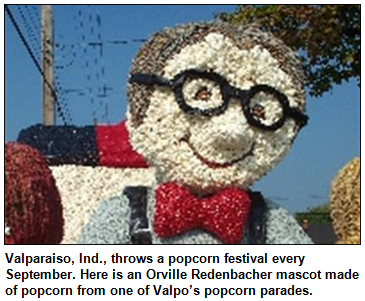 In Danville, Phil and his wife, Joan, live in a home - with a porch - that's filled with antiques, as well as with furniture Phil made himself. They also own a farmhouse in southern Indiana. The Gulleys are the parents of two sons, Spencer and Sam.
In Danville, Phil and his wife, Joan, live in a home - with a porch - that's filled with antiques, as well as with furniture Phil made himself. They also own a farmhouse in southern Indiana. The Gulleys are the parents of two sons, Spencer and Sam.
In addition to his books of vignettes about the quirky characters and life lessons associated with small towns, Phil, a graduate of Christian Theological Seminary, has written several books focused on theology. They include If the Church Were Christian (2010) and The Evolution of Faith: How God is Creating a Better Christianity (2011).
He is pastor of Fairfield Friends Meeting in the town of Camby, which is just southwest of Indianapolis. The protagonist in Home to Harmony and the other books in the Harmony series also is a Quaker pastor.
Phil, 52, who grew up in a Catholic family, once told Nelson he had a one-word explanation for why he became a Quaker as a teenager: "Girls."
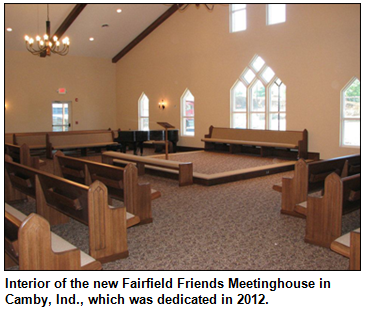 Apparently there weren't many of them among the parishioners at his family's church in Hendricks County. But a local Friends meeting - as Quaker worship services are called - was attended by several young women whom Phil found attractive.
Apparently there weren't many of them among the parishioners at his family's church in Hendricks County. But a local Friends meeting - as Quaker worship services are called - was attended by several young women whom Phil found attractive.
"So I showed up for the wrong reasons," Phil told Nelson. "But you know something? When I started studying Quaker beliefs - the emphasis on simplicity, pacifism and the tolerance for diverse people - they resonated with me."
In Home Town Tales, he wrote: "When I was young and unattached, the women in my Quaker meeting paid me considerable attention. But then Quaker women tend to take an inordinate interest in people who need help. And I needed help. I was six feet tall and weighed 110 pounds."
Phil's career as an author was launched when, while in seminary in the 1990s, he was serving as the pastor of Irvington Friends Meeting in Indianapolis. His musings for the church's newsletter came to the attention of Paul Harvey Jr., the son of the late, legendary broadcaster. The Harveys showed Phil's tales to a national publisher - and book contracts followed.
Like his columns for Indianapolis Monthly, Phil's vignettes in Home Town Tales explore such topics as the arrival of a new Walmart and include wry humor, self-disclosure and insights about human nature. The inclination of Indiana towns to celebrate a product or crop as an excuse for a summer festival has been the focus of one of his popular essays.
Roadtrip: Ferdinand in Dubois County
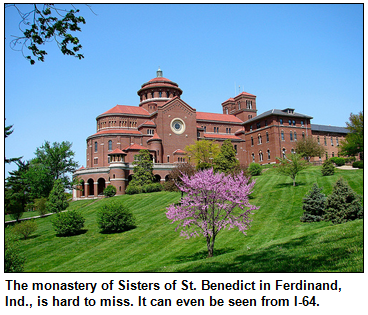 Guest Roadtripper William Selm, architectural historian, adjunct faculty member at IUPUI, and expert on German heritage in Indiana, will suggest we take the Roadtrip to Ferdinand, a small town is located in Dubois County in south central Indiana south of Jasper, the county seat.
Guest Roadtripper William Selm, architectural historian, adjunct faculty member at IUPUI, and expert on German heritage in Indiana, will suggest we take the Roadtrip to Ferdinand, a small town is located in Dubois County in south central Indiana south of Jasper, the county seat.
Ferdinand has real curb appeal, as you can see its main attraction for miles. It's a massive complex atop a hill, the monastery of the Sisters of St. Benedict, first established in 1867.
The town was founded in 1840 by missionary priest, Father Kundek. He named it for Kaiser Ferdinand von Habsburg of the Austrian Empire. Learn more on the show this Saturday!
History Mystery
In addition to Phil Gulley, well-known authors from Indiana who have been guests on Hoosier History Live! include James Alexander Thom, whose books of historical fiction have become national bestsellers. 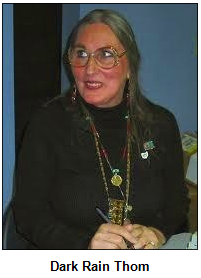 The author of Follow the River, Panther in the Sky and many other books, James Alexander Thom was a guest on this radio show with his wife, Dark Rain, who is of Native American heritage. A tribal historian, Dark Rain also is an author and has collaborated with her husband.
The author of Follow the River, Panther in the Sky and many other books, James Alexander Thom was a guest on this radio show with his wife, Dark Rain, who is of Native American heritage. A tribal historian, Dark Rain also is an author and has collaborated with her husband.
Question: What Native American tribe reflects Dark Rain Thom's heritage?
We will also note that there is an 80th birthday party for James Alexander Thom, as well as for Dark Rain Thom, as part of First Friday at the Vonnegut Library at 340 N. Senate Ave. in Indianapolis on June 7 from 6 to 9 p.m. All are welcome.
The prize is four admissions to the Indiana Experience and two admissions to the Indianapolis Motor Speedway Hall of Fame Museum, courtesy of Visit Indy.
'Ask Nelson' and more county name origins
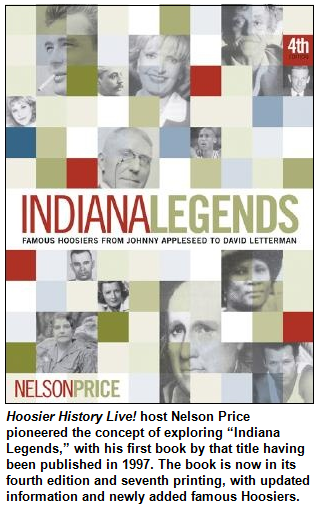 (May 4, 2013) - The last time we turned the tables on our host, author/historian Nelson Price, and let our listeners interview him, callers wanted to know about the late jazz guitarist Wes Montgomery, as well as which famous Hoosier has been Nelson's favorite interview subject.
(May 4, 2013) - The last time we turned the tables on our host, author/historian Nelson Price, and let our listeners interview him, callers wanted to know about the late jazz guitarist Wes Montgomery, as well as which famous Hoosier has been Nelson's favorite interview subject.
He used to dodge that question but 'fessed up that it's Jane Pauley. Nelson grew up about two blocks from the future TV newswoman on the far eastside of Indianapolis. Following in her wake, he attended every school that she did, from Moorhead Elementary School through Warren Central High School and Indiana University.)
To give our listeners another opportunity to question Nelson, who calls himself a "garbage can of useless Hoosier trivia," Hoosier History Live! occasionally opens the phone lines. Listeners are invited to call the WICR-FM studio - the number is (317) 788-3314 - and ask questions of Nelson, who writes books about famous Hoosiers (both historic and contemporary figures) and Indianapolis city history.
As a bonus, Nelson is joined in studio by our attorney friend and WICR colleague Charles Braun, founder and host of Legally Speaking, the longest-running legal advice show on American radio.
Charles, a fellow Hoosier history lover, has extensively researched the origins of county names in Indiana. In September 2010, he joined Nelson for a show about this intriguing topic, but they only scratched the surface of our 92 counties then. (Listeners learned that Marion County is named in honor of Francis Marion, a Revolutionary War hero. Allen County, which includes Charles' hometown of Fort Wayne, derives its name from John Allen, an early American politician, attorney and military leader who was killed in the War of 1812.)
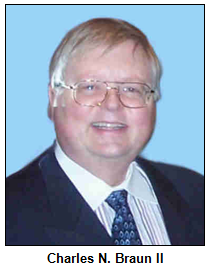 So Charles not only joins listeners in asking Nelson questions, he also responds to queries about our county names. A former state deputy attorney general, Charles is an instructor at the Indiana Law Enforcement Academy, where he helps train police officers from across Indiana. In 1983, Charles launched Legally Speaking, which airs at 10 a.m. Saturdays on WICR.
So Charles not only joins listeners in asking Nelson questions, he also responds to queries about our county names. A former state deputy attorney general, Charles is an instructor at the Indiana Law Enforcement Academy, where he helps train police officers from across Indiana. In 1983, Charles launched Legally Speaking, which airs at 10 a.m. Saturdays on WICR.
After he signs off the air - and just before Hoosier History Live! signs on - Charles and Nelson typically can be found near the studio chatting about history-related topics. Nelson loves to share anecdotes and insights, particularly those derived from his expertise. His books include Indiana Legends: Famous Hoosiers from Johnny Appleseed to David Letterman (Hawthorne Publishing) and Indianapolis Then and Now (Thunder Bay Press), a visual history about the Hoosier capital.
Listeners are encouraged to phone in with questions about famous Hoosiers, including historic figures that Nelson has researched, such as Madam Walker or contemporary notables he has interviewed, including former Indiana Pacers superstar Reggie Miller, astronaut David Wolf and artist Nancy Noel of Zionsville.
Several of the famous Hoosiers featured in Indiana Legends have been Nelson's guests on Hoosier History Live!, including Hoosiers and Rudy screenwriter Angelo Pizzo, jazz great David Baker, novelist Dan Wakefield and former Olympic figure skaters Kim and Wayne Seybold of Marion.
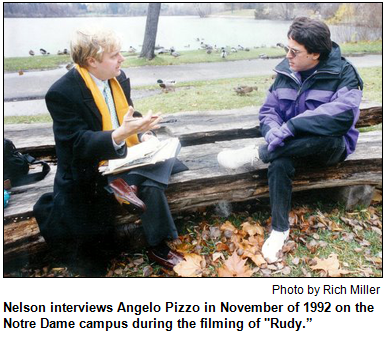 Need more fodder for questions? The histories of sites across the Hoosier capital are the focus of Indianapolis Then and Now, which involved a collaboration among Nelson, photo historian Joan Hostetler of Heritage Photo Services and photographer Garry Chilluffo of Chilluffo Photography.
Need more fodder for questions? The histories of sites across the Hoosier capital are the focus of Indianapolis Then and Now, which involved a collaboration among Nelson, photo historian Joan Hostetler of Heritage Photo Services and photographer Garry Chilluffo of Chilluffo Photography.
Do you know what, 100 years ago, could be found on the site underneath the Artsgarden at Circle Centre mall in downtown Indy? Or what infamous structure was located where the Barnes & Noble is now on the IUPUI campus?
Ever wonder about what flourished on the current site of Butler University in the early 1900s, back when the campus was still located in the Irvington neighborhood? This is your opportunity to call in - the number is (317) 788-3314 - during the live show this Saturday from noon to 1 p.m. ET, and ask Nelson to share insights about the then-to-now changes.
Questions about the derivation of any county names are fair game for Charles, our in-house expert at WICR-FM. Although some county names are easy to figure out - Ohio County in far-southeastern Indiana, for example, or Wabash County in the north - others have names that are much more obscure. Call in and ask about the ones that always have perplexed you.
Roadtrip: 'Morgan's Raid' online video game
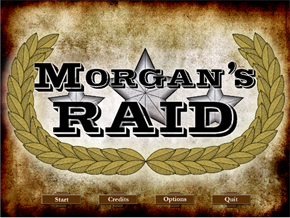 Guest Roadtripper Ron Morris, professor of history at Ball State University in Muncie, suggests that we take an online Roadtrip to https://sites.google.com/site/morgansraidgame/, where we can play a video game simulating Confederate General John Hunt Morgan's Raid across Kentucky, Indiana and Ohio during the Civil War. The video game is free and available to all.
Guest Roadtripper Ron Morris, professor of history at Ball State University in Muncie, suggests that we take an online Roadtrip to https://sites.google.com/site/morgansraidgame/, where we can play a video game simulating Confederate General John Hunt Morgan's Raid across Kentucky, Indiana and Ohio during the Civil War. The video game is free and available to all.
Those playing the game learn Indiana geography and history, and as the game unfolds, players allocate resources in order to continue their raid, and reputation points are earned for successful actions that cause chaos across southern Indiana.
The game was developed by Ball State students under the direction of Paul V. Gestwicki, Ph.D. in computer science, and our guest Roadtripper, Ron Morris, Ph.D. in history, all of Ball State.
This game is a frequent learning tool for fourth- and eighth-grade students in Indiana who are learning about the Civil War.
Our Roadtripper is a former Hoosier History Live! guest. He spoke about Oliver P. Morton, Indiana's Civil War Governor, and he also is renovating and planning to move in to Morton's home in Centerville.
History Mystery
Among the famous Hoosiers featured in Nelson Price's Indiana Legends book is a broadcaster and business leader who became a pioneer in cable TV. A Lafayette native, he attended Purdue University and got his start in local TV in his hometown.
 He went on to become the founder and CEO of C-SPAN, a public affairs network that began on a shoestring budget in 1979.
He went on to become the founder and CEO of C-SPAN, a public affairs network that began on a shoestring budget in 1979.
C-SPAN, which started out focusing on live, gavel-to-gavel coverage of the U.S. House of Representatives, enjoyed dramatic growth. So the Indiana native launched C-SPAN 2 in 2000 and also became the host of shows such as Booknotes, a weekly series of in-depth interviews. He interviewed hundreds of the nation's top politicians, historians, authors and newsmakers, but he always has been known for his calm, low-key demeanor.
Question: Who is the famous Hoosier?
The prize is a gift certificate to Aesop's Tables, courtesy of Aesop's Tables, and four admissions to the Indiana Experience, courtesy of Visit Indy.
Dan Patch, the first superstar racehorse, and True tall tales from Indiana: 2 classic shows
(April 27, 2013 - encore presentations) - According to many sports historians, the greatest athlete of the early 1900s was a Hoosier - and he wasn't a baseball player, a bicyclist, a boxer or even a human being. Dan Patch was a racehorse who became a top national celebrity, never lost a race on the grand circuit of harness racing and was hailed as the "Epitome of Excellence in American Sports."
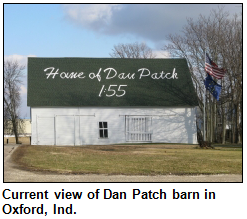 Other Hoosier animals, although far less famous than the renowned racehorse, nevertheless became fodder for folklore. In Howe, Ind., the town character was known as the "Skunk Woman" because she kept skunks as pets. And the talk of Goshen once was a rooster described as "over-hormoned."
Other Hoosier animals, although far less famous than the renowned racehorse, nevertheless became fodder for folklore. In Howe, Ind., the town character was known as the "Skunk Woman" because she kept skunks as pets. And the talk of Goshen once was a rooster described as "over-hormoned."
In Churubusco, generations of residents have debated alleged sightings of a giant turtle. Accounts of the "Skunk Woman", the resilient rooster and the alleged turtle (often called the "Beast of 'Busco") were syndicated across the state during the 1950s.
These two topics - Dan Patch, the first superstar racehorse and True tall tales from 1950s Indiana - are the focus of "encore" broadcasts of two popular Hoosier History Live! shows. Instead of a one-hour broadcast, you can enjoy back-to-back, half-hour shows from our archives.
Dan Patch, the first superstar racehorse
For the first classic show (original air date: April 7, 2012), Nelson is joined in studio by two guests with special expertise about Dan Patch, who had gangly, crooked legs at his birth in 1896. He was foaled in a barn in Oxford, a western Indiana town that continues to celebrate an annual Dan Patch Festival in honor of the famous son; the 2013 festival is planned for Sept. 6-8.
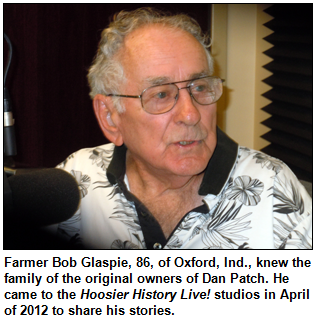 Nelson's guests are Oxford resident Bob Glaspie, who owns a vast collection of Dan Patch memorabilia, and Gerald Waite, a lecturer emeritus at Ball State University who has written extensively about the legendary racehorse.
Nelson's guests are Oxford resident Bob Glaspie, who owns a vast collection of Dan Patch memorabilia, and Gerald Waite, a lecturer emeritus at Ball State University who has written extensively about the legendary racehorse.
The superstar eventually endorsed an array of products ranging from sleds to washtubs, children's wagons, a pocket knife and a clothes ringer. Dan Patch first made headlines by stunning spectators at the Benton County Fairgrounds with an incredible win that was a sign of his unbroken streak of victories. The barn where "the Patch" was foaled and raised still stands in Oxford and is owned by the grandson of the racehorse's initial owner. The wonder horse died in 1916 in Minnesota, where his final owner lived.
Dan Patch's dominance hurt betting at racetracks because, if the undefeated champ was entered, everyone knew who would win. Other prominent owners also didn't want their racehorses "to submit to the humiliation of being beaten every time," according to an award-winning cover story written by our guest Gerald Waite for Traces of Indiana and Midwestern History magazine. So for several years, "the Patch" raced against a stopwatch, essentially competing against himself to set new world records.
Our guest Bob Glaspie, a farmer who grew up in Benton County, owns one of the historic stopwatches, as well as more than 300 other pieces of memorabilia. They include Dan Patch-endorsed billiard chalk, children’s wagons (they came in three different styles) and a straight razor.
In retirement, Dan Patch enjoyed railroad tours to meet adoring fans across the country. He traveled in a specially designed, private railcar with his portrait on the exterior.
True tall tales from 1950s Indiana
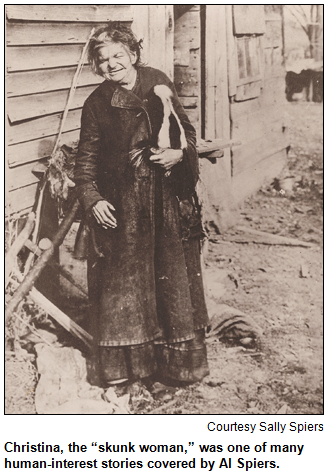 During the second classic show (original air date: April 21, 2012), the focus is on true tales, including the "Skunk Woman" (in addition to keeping skunks as pets, she seldom bathed) that were syndicated across the state during the 1950s by Al Spiers, a Michigan City-based columnist and editor. Although Al died in 1994, his columns about true tall tales have been collected in a book, Hoosier Lore (Brooks Publications), put together by his daughter, Sally Spiers.
During the second classic show (original air date: April 21, 2012), the focus is on true tales, including the "Skunk Woman" (in addition to keeping skunks as pets, she seldom bathed) that were syndicated across the state during the 1950s by Al Spiers, a Michigan City-based columnist and editor. Although Al died in 1994, his columns about true tall tales have been collected in a book, Hoosier Lore (Brooks Publications), put together by his daughter, Sally Spiers.
An Indianapolis civic leader who is retired after a career in city and state governments, Sally joins Nelson in studio to explore the colorful critters, people and towns that her father described.
Sally was growing up in Michigan City during the era when her father was writing the columns, including the one about the "over-hormoned" rooster. During the 1950s, roosters routinely were injected with female hormones so they would shun hens, stop crowing, eat hearty and be tender. Despite numerous injections, a resilient rooster in Goshen named Elco resumed fraternizing with hens as well as emitting "cock-a-doodle-doos" - all in front of a stunned Jaycees event.
Some of the tales in Hoosier Lore had their origins long before the 1950s. The "Skunk Woman" (whose real name was Chrissy Hand), for example, died in LaGrange County in 1925. When Al Spiers visited 30 years later, though, he was able to interview many residents of Howe who had known the "Skunk Woman." She typically kept about half a dozen of the critters ("not de-skunked skunks, but fully equipped specimens," as Al wrote) wandering around in her house.
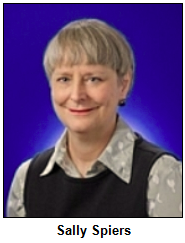 Al Spiers, an inductee into the Indiana Journalism Hall of Fame, was editor of the Michigan City News-Dispatch, as well as a human interest columnist. He wrote about the "turtle tizzy" in Churubusco involving residents who claimed to have seen a giant turtle in Fulks Lake beginning in 1949.
Al Spiers, an inductee into the Indiana Journalism Hall of Fame, was editor of the Michigan City News-Dispatch, as well as a human interest columnist. He wrote about the "turtle tizzy" in Churubusco involving residents who claimed to have seen a giant turtle in Fulks Lake beginning in 1949.
Even though the lake had been partially drained and skin divers deployed (with no confirmations of the turtle's presence) by the time Al Spiers showed up in the mid-1950s, folklore about a massive "Beast of 'Busco" persisted. At dusk, Spiers drove to Fulks Lake, where he noticed, as he put it, a "wild and spooky section - swampy, full of tangled, dead trees and brush, silent and brooding. It looks like ... a set for a movie starring prehistoric monstrosities."
The folklore continues to this day in Churubusco, which celebrates a Turtle Days festival every summer in honor of Indiana's counterpart to the Loch Ness Monster.
Derek Daly on Indy-car fans overseas, son Conor and more
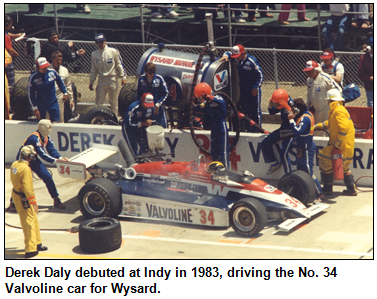 (April 20, 2013) - We're going to varroom back to when former Indy-car and Formula One driver Derek Daly was growing up in Ireland. That's because Dublin native Derek Daly, now 60, joins Nelson in studio to assess how the interest level overseas in the Indianapolis 500 - as well as in NASCAR racing - has evolved during the last half-century.
(April 20, 2013) - We're going to varroom back to when former Indy-car and Formula One driver Derek Daly was growing up in Ireland. That's because Dublin native Derek Daly, now 60, joins Nelson in studio to assess how the interest level overseas in the Indianapolis 500 - as well as in NASCAR racing - has evolved during the last half-century.
Now a popular motorsports commentator on TV and radio - Derek has worked for media ranging from ESPN to Fox, CBS and the Speed Channel - he also has a son who is making headlines and blazing a path. So Nelson asks Derek, who has lived in Noblesville for many years, about Conor Daly, 21, who has been hired by A.J. Foyt Racing as a rookie driver in next month's Indy 500.
Our guest owns Derek Daly Academy, which coaches, evaluates and manages young motorsports drivers. His career as a race driver spanned 17 years and included competing in the Indy 500 six times. He also is the author of Race to Win (Motorsports Publishing, 2008), which features an introduction by his friend Mario Andretti.
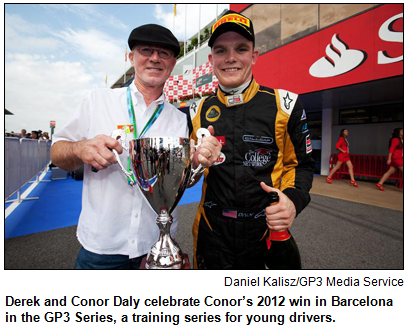 Back in the early 1980s, foreign-born drivers like Derek and Mario were something of a novelty in the Indy 500 - although competitors during the 1960s had included popular Jimmy Clark from Scotland and Graham Hill from England, the winner of the 1966 race. Eventually, the infrequency of foreign drivers changed dramatically, almost reversing itself during the last 20 years. For example, the field of 33 drivers in the 2011 race included four from Brazil alone.
Back in the early 1980s, foreign-born drivers like Derek and Mario were something of a novelty in the Indy 500 - although competitors during the 1960s had included popular Jimmy Clark from Scotland and Graham Hill from England, the winner of the 1966 race. Eventually, the infrequency of foreign drivers changed dramatically, almost reversing itself during the last 20 years. For example, the field of 33 drivers in the 2011 race included four from Brazil alone.
So what has all of this meant to the Indy-car fan base overseas? Do Derek's native land and other European countries still reserve most of their passion for Formula One? Is NASCAR even on their radar yet?
We explore that and more with Derek, including the remarkable rise of his son. Conor, an Indianapolis native and graduate of Heritage Christian High School, wasn't even born in 1985, when Derek had his best finish (12th) in the 500 Mile Race. 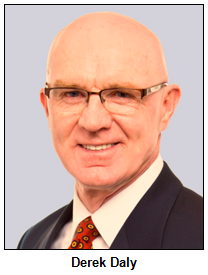 So far, Conor has spent much of this year overseas himself, competing in Europe and Malaysia in lower-level racing series that are considered preludes for advancement to Formula One.
So far, Conor has spent much of this year overseas himself, competing in Europe and Malaysia in lower-level racing series that are considered preludes for advancement to Formula One.
Derek Daly is his son's manager. After retiring from a career as a driver that included starting on the front row with Mario for the Indy 500 in 1984, Derek launched his successful business and broadcasting careers. He's also a popular motivational speaker.
In 1990, Derek began a long relationship with WISH-TV/Channel 8 in Indianapolis, serving as the expert racing analyst for the CBS-TV affiliate. This September, he will celebrate his 20th year as an American citizen.
Derek's racing career began in his homeland, when he won championships in Ireland during the 1970s. His later triumphs included winning the 12 Hours of Sebring, one of the premier endurance races in the U.S., in 1991 and '92.
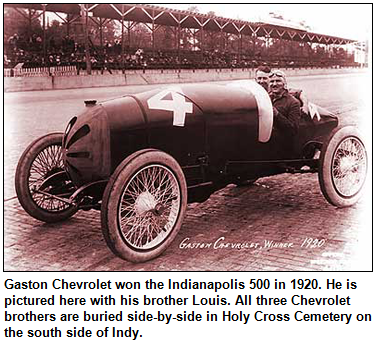 In the early years of the Indianapolis 500, foreign-born drivers like Derek were frequent competitors.
In the early years of the Indianapolis 500, foreign-born drivers like Derek were frequent competitors.
"Striving for the 500 to be a truly international affair from the very beginning, overseas entries always had been sought," Speedway historian Donald Davidson writes in Autocourse Official History of the Indianapolis 500.
He notes, though, that in the first two years of the 500 - 1911 and 1912 - none of the overseas drivers came primarily to compete in the race, "having been either in the country on an extended basis or else on their way to applying for citizenship."
French drivers, however, were the top four finishers in the 1914 race, and various Chevrolet brotherscompeted in the late 1910s and early '20s. (According to Donald Davidson's book, older brothers Louis and Arthur Chevrolet were born in Switzerland, while kid brother Gaston Chevrolet, who won the 500 Mile Race in 1920 at age 23, was born in France.)
With Derek, we explore the extent to which the race intrigued overseas fans during that era - as well as during subsequent eras when foreign drivers were rarities. And we get personal, with Nelson asking our special guest about his evolving awareness of the Indianapolis 500 as a boy in Ireland.
Hoosier History Live! bonus: You can listen online to Nelson's 2011 interview with Donald Davidson about the Speedway's 100-year history.
History Mystery
In the 1980s and early '90s - several years before Juan Pablo Montoya of Colombia and Venezuelan drivers E.J. Viso and Milka Duno made their debuts at the Indianapolis 500 - one of the most popular foreign-born race drivers was a native of Colombia.
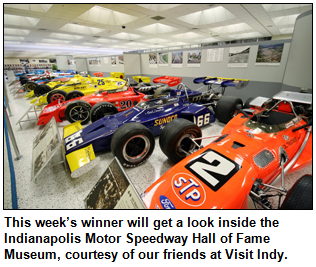 He nearly won the Indy 500 twice during the 1980s but was the runner up both times. In September 1987, he was nearly killed in a wreck during tire testing at the Indianapolis Motor Speedway. He was in a coma for more than two weeks at Methodist Hospital and spent several months in recovery. Even so, the driver from Colombia returned to win the pole position in the 1992 Indianapolis 500. But he had retired from racing in the Indy 500 by 2001.
He nearly won the Indy 500 twice during the 1980s but was the runner up both times. In September 1987, he was nearly killed in a wreck during tire testing at the Indianapolis Motor Speedway. He was in a coma for more than two weeks at Methodist Hospital and spent several months in recovery. Even so, the driver from Colombia returned to win the pole position in the 1992 Indianapolis 500. But he had retired from racing in the Indy 500 by 2001.
Question: Name the Colombian-born race driver.
The prize is a pair of tickets to "500 Track Tours" and a pair of tickets to the Indianapolis Motor Speedway Hall of Fame Museum. These prizes are courtesy of Visit Indy.
Roadtrip: Historic Pendleton in Madison County
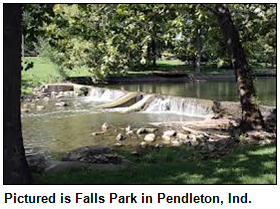 Guest Roadtripper and historian-at-large Glory- June Greiff recommends we take short trip from Indianapolis up the Pendleton Pike (SR 67) to the small historic town of, surprisingly enough, Pendleton! Glory says it's a great place to play hooky for an afternoon.
Guest Roadtripper and historian-at-large Glory- June Greiff recommends we take short trip from Indianapolis up the Pendleton Pike (SR 67) to the small historic town of, surprisingly enough, Pendleton! Glory says it's a great place to play hooky for an afternoon.
Falls Park in Pendleton is lovely, with trails, charming rock features built over 80 years ago, and a large duck pond with a stone "lighthouse" recently restored. On weekends, drop in to the Pendleton Historical Museum that overlooks the falls; it's free. The park is only a couple of blocks from the historic downtown, which is pleasant to stroll and offers nice antique shops, a coffee bistro and many marvelous old buildings. The New Deal-era post office features a mural inside.
Glory recommends lunch or supper at Jimmie's Dairy Bar on the edge of town on Pendleton Pike near Water Street. The sign says they offer the "best barbecue in Indiana." They also offer ice cream sodas, which, as our Roadtripper notes, are hard to find these days!
Jazz recording heritage in Richmond
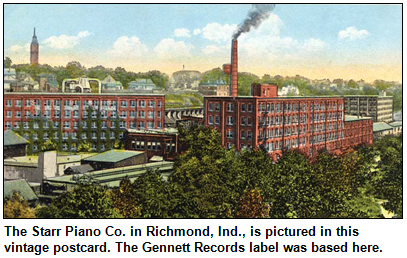 (April 13, 2013) - Memphis, Chicago, New York City and Nashville, Tenn., have long been hailed for the significant roles their recording studios played in the boom of American popular music. Why do some say Richmond in far-eastern Indiana almost should be mentioned in the same breath?
(April 13, 2013) - Memphis, Chicago, New York City and Nashville, Tenn., have long been hailed for the significant roles their recording studios played in the boom of American popular music. Why do some say Richmond in far-eastern Indiana almost should be mentioned in the same breath?
Consider that during the 1920s the parade of future musical legends who traveled to the town - specifically, to the Starr Piano Company and its Gennett Records division - included Louis Armstrong, Indiana native Hoagy Carmichael, cowboy singer Gene Autry and Jelly Roll Morton, who recorded nine piano solos at the Richmond studio in 1924.
"Gennett was among the first record companies to cater to both the segregated white and black record markets," according to Rick Kennedy, author of Jelly Roll, Bix and Hoagy, whose book, first published by IU Press in 1994, is being released in an expanded, revised edition.
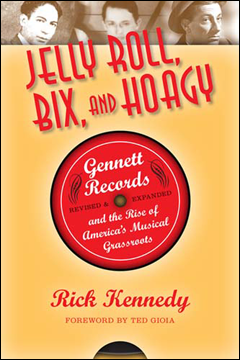 Rick is among Nelson's guests, as are Bob Jacobsen and David Fulton, president and treasurer, respectively, of the Starr-Gennett Foundation, a nonprofit that is helping Richmond reclaim its remarkable heritage in recording jazz, blues and country music. David Fulton also is chancellor emeritus of Indiana University-East in Richmond.
Rick is among Nelson's guests, as are Bob Jacobsen and David Fulton, president and treasurer, respectively, of the Starr-Gennett Foundation, a nonprofit that is helping Richmond reclaim its remarkable heritage in recording jazz, blues and country music. David Fulton also is chancellor emeritus of Indiana University-East in Richmond.
To honor the city's rich but frequently overlooked heritage - which ended with the Great Depression - the Starr-Gennett Foundation has established a Gennett Records Walk of Fame and an annual music festival in September near the Whitewater River.
That's also near where the riverside piano factory and recording studio made so much musical history.
Performers who recorded on the Gennett label - either at its Richmond studio or one in Manhattan - included Duke Ellington, Joe "King" Oliver and legendary cornet and piano player Bix Beiderbecke, who befriended and influenced a young Hoagy Carmichael. The musical director and lead soloist of the Wolverine Orchestra (usually known as the Wolverines by jazz enthusiasts), Beiderbecke died at age 28 in 1931.
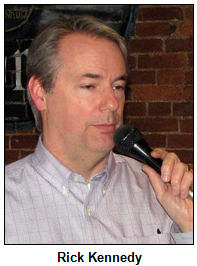 As Rick puts it in Jelly Roll, Bix and Hoagy, Beiderbecke "was immortalized by musicians and journalists as ... the sensitive musical genius who drank himself to death before the world could fully recognize his command of a misunderstood art form." (Beiderbecke's tragic life loosely inspired the 1950 movie Young Man with a Horn, in which Hoagy played a character based on himself.)
As Rick puts it in Jelly Roll, Bix and Hoagy, Beiderbecke "was immortalized by musicians and journalists as ... the sensitive musical genius who drank himself to death before the world could fully recognize his command of a misunderstood art form." (Beiderbecke's tragic life loosely inspired the 1950 movie Young Man with a Horn, in which Hoagy played a character based on himself.)
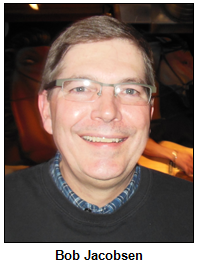 The musical history in Richmond accelerated in the 1890s when piano retailer Henry Gennett bought an interest in Starr, an existing piano company. Henry Gennett had owned music stores in Nashville, Chicago, St. Louis and other cities. Under his leadership, the piano factory also began producing player pianos, piano rolls and, eventually, phonographs.
The musical history in Richmond accelerated in the 1890s when piano retailer Henry Gennett bought an interest in Starr, an existing piano company. Henry Gennett had owned music stores in Nashville, Chicago, St. Louis and other cities. Under his leadership, the piano factory also began producing player pianos, piano rolls and, eventually, phonographs.
The saga that unfolded, according to Rick's book, included a legal fight over patent infringement between Gennett and mighty Victor Records, which in 1917 had produced the world's first jazz records. (They featured the Original Dixieland Jazz Band.) 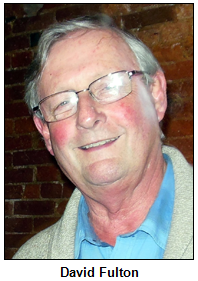 Gennett was joined by other small labels. They prevailed in 1922, breaking Victor's stranglehold, "resulting in new record labels and greater competition," as Rick puts it.
Gennett was joined by other small labels. They prevailed in 1922, breaking Victor's stranglehold, "resulting in new record labels and greater competition," as Rick puts it.
Later in 1922, the New Orleans Rhythm Kings made their recording debut at the Richmond studio.
"Ragtime, jazz, blues, gospel, country and other 'new' sounds swelled the mainstream of popular music with the help of instruments and recordings produced by Starr and Gennett for international distribution," according to the Starr-Gennett Foundation.
Until 1934, the Gennett studio produced thousands of recordings, including some that are considered among the greatest jazz recordings of all time.
According to a history included with vintage recordings re-released in recent years on CDs titled Gennett Records Greatest Hits Collection, Hoagy Carmichael first recorded his classic Stardust at Gennett in 1927; it was released to the public early in the following year.
Although not a hit initially, Stardust eventually became "one of the most recorded songs of the 20th century."
History Mystery
Hoagy Carmichael often composed songs about places across America such as states or cities, including Can't Get Indiana Off My Mind and Memphis in June. For years, debate ensued about whether one of his songs was about a place or about one of his sisters.  She happened to have the same first name as a place.
She happened to have the same first name as a place.
The Hoagy Carmichael song - which evokes a mood of yearning - has been recorded by many top performers.
Question: What was the name of Hoagy's sister?
The prize is a pair of tickets to Conner Prairie Interactive History Park and a pair of tickets to the Eiteljorg Museum. These prizes are courtesy of Visit Indy.
Roadtrip: Levi Coffin House in Wayne County
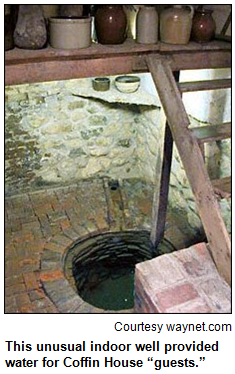 Just up the road from Richmond and its Starr-Gennett sites is the Levi Coffin House, located in what is now Fountain City on U.S. 27. The house is Indiana's most famous "way station" on the Underground Railroad, and before the Civil War, Quaker owner Levi Coffin and his wife, Catharine, helped as many as 2,000 former slaves escape to freedom in the free states and Canada.
Just up the road from Richmond and its Starr-Gennett sites is the Levi Coffin House, located in what is now Fountain City on U.S. 27. The house is Indiana's most famous "way station" on the Underground Railroad, and before the Civil War, Quaker owner Levi Coffin and his wife, Catharine, helped as many as 2,000 former slaves escape to freedom in the free states and Canada.
One of the many formerly enslaved persons who hid in the Coffin house was "Eliza," whose story is told in Uncle Tom's Cabin.
Governors of Indiana
(April 6, 2013) - "Historically, the office of governor in Indiana has been a weak institution compared to the strength of the state legislature and in contrast to the office of governor in some other states. Over time ... the office has been transformed into one with considerably more power."
So begins a book co-edited by two distinguished Hoosiers who are Nelson's studio guests for a show exploring the colorful array of Indiana's chief executives since statehood in 1816 - as well as various patterns among the political leaders who have held the top office.
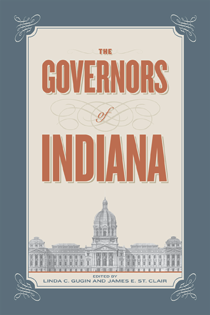 Our guests are Linda Gugin, a professor emeritus of political science at Indiana University Southeast, and James E. St. Clair, a journalism professor at ISU. They co-edited The Governors of Indiana (Indiana Historical Society Press, 2006), an anthology to which dozens of writers contributed profiles of the Hoosier state's leaders.
Our guests are Linda Gugin, a professor emeritus of political science at Indiana University Southeast, and James E. St. Clair, a journalism professor at ISU. They co-edited The Governors of Indiana (Indiana Historical Society Press, 2006), an anthology to which dozens of writers contributed profiles of the Hoosier state's leaders.
Our first governor, Jonathan Jennings, was a longtime foe of slavery who resigned in 1822 after being elected to Congress; he struggled with alcoholism in his later years. During our show, Nelson and his guests explore how Jennings and other early Indiana governors - including William Hendricks of Madison (our third governor) and Paris Dunning of Bloomington (our ninth) - dealt with slavery-related issues.
In their book, Professor Gugin and Professor St. Clair identify the two "most powerful governors" as Civil War-era leader Oliver Perry Morton, a Republican from Centerville, and Franklin native Paul V. McNutt, a Democrat who was the state's chief executive during the Great Depression. (Gov. Morton, an ally of President Lincoln, was the focus of a Hoosier History Live! show last December. Our guest was historic preservationist and Ball State professor Ron Morris, who has purchased Morton's house.)
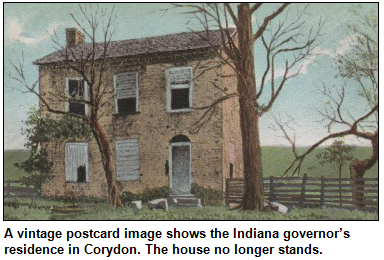 We explore how Morton, McNutt and other governors handled conflicts with the state legislature.
We explore how Morton, McNutt and other governors handled conflicts with the state legislature.
By the way, Morton had lost his first race for governor, in 1856, during a bitter election in which, according to our guests' book, Democrats resorted to "overt appeals to racism." The election demonstrated "the polarized nature of the state at the time," with the Democratic candidate, New Albany lawyer and orator Ashbel Willard, prevailing in almost all of the southern counties and Morton in the north.
In 1860, Willard became the first of four Indiana governors to die in office. The most recent was Corydon newspaper publisher and state legislator Frank O'Bannon in 2003.
During our show, Nelson and his guests explore how various civil rights and social justice issues have been handled by governors. A former first lady, Zerelda Wallace, became a leading suffragist during the 1870s and '80s, lobbying the legislature for women's rights and founding suffrage groups in Indianapolis. She was the second wife of David Wallace, who had served as governor in the 1830s. His sons from his first marriage included Lew Wallace, who went on to write the international bestseller Ben-Hur.
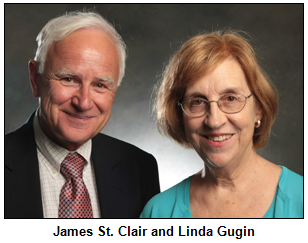 During the 1920s, Gov. Ed Jackson, a Republican lawyer from Lafayette, was generally perceived to have been controlled by the Ku Klux Klan. The notorious Grand Dragon of the KKK, D.C. Stephenson, befriended and endorsed Jackson. The governor refused calls to resign when Stephenson was convicted of second-degree murder in the death of a statehouse worker who had accused him of raping her.
During the 1920s, Gov. Ed Jackson, a Republican lawyer from Lafayette, was generally perceived to have been controlled by the Ku Klux Klan. The notorious Grand Dragon of the KKK, D.C. Stephenson, befriended and endorsed Jackson. The governor refused calls to resign when Stephenson was convicted of second-degree murder in the death of a statehouse worker who had accused him of raping her.
Other governors had opposed the Klan, including Warren McCray of Kentland. In the early 1920s, he vetoed a proposed "Klan Day," which would have featured "a nighttime cross burning at the Indiana State Fair," according to The Governors of Indiana. 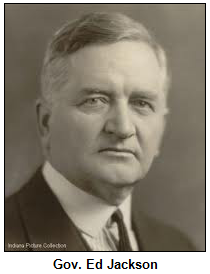 But McCray's reputation was tarnished in 1924 when he was charged with selling and distributing fraudulent promissory notes. He served more than three years in a federal penitentiary in Atlanta but eventually received a full pardon from President Herbert Hoover.
But McCray's reputation was tarnished in 1924 when he was charged with selling and distributing fraudulent promissory notes. He served more than three years in a federal penitentiary in Atlanta but eventually received a full pardon from President Herbert Hoover.
Two governors, both Democrats, went on to become U.S. vice presidents. They were Thomas A. Hendricks of Shelby County, who was elected veep under Grover Cleveland in 1884 (Hendricks died after eight months in office), and Thomas R. Marshall of Columbia City, who served under Woodrow Wilson and is best remembered for his witticisms, including: "What this country needs is a good five-cent cigar."
(Indiana's first territorial governor, William Henry Harrison, decades later was elected president after moving to Ohio.)
In addition to co-editing The Governors of Indiana, our guests Linda Gugin and James E. St. Clair are the co-editors of Justices of the Indiana Supreme Court (IHS Press, 2010).
History Mystery
Ever since Indiana shifted its capital from Corydon to the new city of Indianapolis during the 1820s, the governor's mansion has been located in various sites and in various houses. 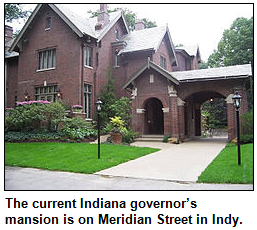 Beginning in the 1970s, a historic mansion at 4750 N. Meridian St. has served as the governor's residence.
Beginning in the 1970s, a historic mansion at 4750 N. Meridian St. has served as the governor's residence.
However, the first governor's mansion in Indy was built during the 1820s at a different site. The mansion was unused by several governors and their wives, who refused to move into it. Finally, the mansion fell into disrepair and was demolished.
Question: Where was it located?
The prize is a pair of tickets to the Indiana Experience at the Indiana Historical Society, and a pair of tickets to the James Whitcomb Riley Museum Home. These prizes are courtesy of of Visit Indy.
Roadtrip: 'Follow the North Star' at Conner Prairie
|
"Rotating Roadtripper" Rosemary Arnold will be calling in on Saturday to tell us about Conner Prairie's "Follow the North Star" program, which enables visitors age 12 and older a nighttime experience of being a fugitive slave on the Underground Railroad, fleeing from captivity and risking all.
Since 1998, nearly 60,000 people have participated in this 90-minute program, which offers a powerful diversity training experience. This month the program will be offered April 12-13, 19-20 and 26-27, and Rosemary Arnold of Conner Prairie Interactive History Park directs the program.
Frank Lloyd Wright and Indiana houses he designed
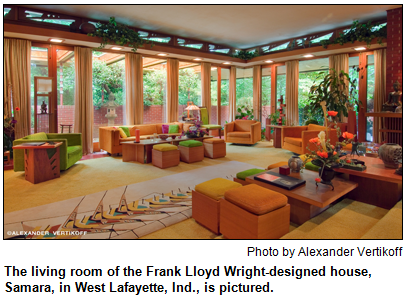 (March 30, 2013) - Probably the best-known is Samara, a single-level "Usonian" house in West Lafayette built in the 1950s for a young faculty couple at Purdue University. But the world's most famous architect of the 20th century - and, arguably, its most flamboyant, influential and imperial - also designed other houses across Indiana, including at least one in his trademark Prairie style.
(March 30, 2013) - Probably the best-known is Samara, a single-level "Usonian" house in West Lafayette built in the 1950s for a young faculty couple at Purdue University. But the world's most famous architect of the 20th century - and, arguably, its most flamboyant, influential and imperial - also designed other houses across Indiana, including at least one in his trademark Prairie style.
Frank Lloyd Wright had other connections to the Hoosier state as well. His son, John Lloyd Wright, designed a building in LaPorte County that's now considered endangered.
In addition to Samara, which now is owned by a private foundation established by the owner of the house (who continues to live in it), Frank Lloyd Wright (1867-1959) designed houses in Fort Wayne, South Bend, Gary, Marion and other Hoosier cities.
To share insights about these homes and Indiana-related aspects of the architect, Nelson is joined by two guests. They are Linda Eales, associate curator of Samara (which was built for Dr. John Christian, a Purdue bio-nucleonics professor, and his late wife Catherine), and Scott W. Perkins, a nationally known Oklahoma-based expert on Wright, as well as on the interiors of the buildings, for many of which the architect designed furniture and textiles.
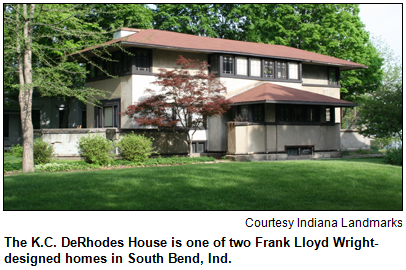 Here's how a PBS documentary by Ken Burns and Lynn Novick summed up Wright:
Here's how a PBS documentary by Ken Burns and Lynn Novick summed up Wright:
"He was an authentic American genius, a man who believed he was destined to redesign the world, creating everything anew. Over the course of his long career, Wright designed over 800 buildings, including such revolutionary structures as the Guggenheim Museum, the Johnson Wax Building, Fallingwater, Unity Temple and Taliesin. Wright's buildings and ideas changed the way we live, work and see the world around us."
He wasn't a Hoosier - and, in fact, never even visited the sites of several of the Indiana houses he designed, including Samara. (The Christians visited the architect at his Wisconsin studios and consulted by phone, photos and mail.) Samara has a sunken living room, cabinets and other furnishings designed by Wright; even the china is patterned after some he designed for the Imperial Hotel in Japan. It's open for group tours by appointment.
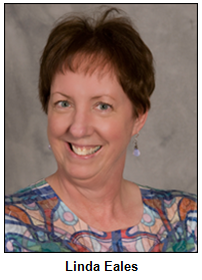 Wright's son, John Lloyd Wright (1892-1972), who also was an architect, lived for more than 20 years in Long Beach, a LaPorte County town (pop. 4,500) on the shore of Lake Michigan. According to a 2005 article in the Indiana Preservationist, a publication of Indiana Landmarks, the younger Wright designed 13 buildings in the town before he moved to California in 1947; some of the structures "brought touches of the Prairie style pioneered by his father."
Wright's son, John Lloyd Wright (1892-1972), who also was an architect, lived for more than 20 years in Long Beach, a LaPorte County town (pop. 4,500) on the shore of Lake Michigan. According to a 2005 article in the Indiana Preservationist, a publication of Indiana Landmarks, the younger Wright designed 13 buildings in the town before he moved to California in 1947; some of the structures "brought touches of the Prairie style pioneered by his father."
Frank Lloyd Wright, a Wisconsin native, established his career while working in a studio in Oak Park, Ill. Known for his intimidating personality, Wright periodically fell out of public favor because of his sensational personal life. His first scandal hit the headlines in 1909 when Wright abandoned his family - including his first wife (John Lloyd Wright’s mother) and several children - to move to Europe with a client with whom he was carrying on a torrid affair. (A second scandal ensued in 1914 when she was murdered by a deranged, ax-swinging servant in Wisconsin, where the couple had re-settled.)
Most of Wright's homes in Indiana - including Samara - were designed in the 1950s when he was enjoying a final, spectacular revival of his career. Wright derived the name Samara from a name for the winged seed of a pinecone.
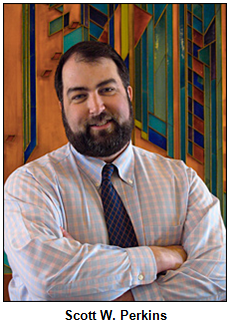 According to the book 99 Historic Homes of Indiana (IU Press), Wright selected Samara's exterior bricks from the Indiana town of Attica. He also designed everything from many of the three-bedroom home's furnishings to its landscaping. Fun fact: Samara does not have a garage. That's because Wright disliked them and insisted the Christians instead have a carport, which he often is credited with inventing, or at least popularizing.
According to the book 99 Historic Homes of Indiana (IU Press), Wright selected Samara's exterior bricks from the Indiana town of Attica. He also designed everything from many of the three-bedroom home's furnishings to its landscaping. Fun fact: Samara does not have a garage. That's because Wright disliked them and insisted the Christians instead have a carport, which he often is credited with inventing, or at least popularizing.
When Samara was finished in 1956, Wright was 88 years old. He was working on several projects when he died a few months before his 92nd birthday.
Some other tidbits:
- Our guest Scott W. Perkins will discuss Indiana's connections to Wright in a presentation April 11 at Indiana Landmarks Center, 1201 Central Avenue. The program is free, but RSVPs are required. The reception is at 5:30 p.m. and the illustrated lecture is at 6 p.m.
- The Wright-designed home in Marion was owned for several years by the late radio-TV writer Madelyn Pugh Davis, an Indy native who helped create I Love Lucy, and her late husband, Dr. Richard Davis.
- Beginning in 1937, Wright often worked at Taliesin West, a design studio he established in Scottsdale, Ariz.
- "Usonian" is a word Wright made up. Shorthand for "United States of North America," it was coined to tout distinctively American architecture.
History Mystery
One of Frank Lloyd Wright's granddaughters was an Indiana native who became a famous movie actress. She was born in 1923 in Michigan City. Her mother, Catherine, was one of Wright's daughters.
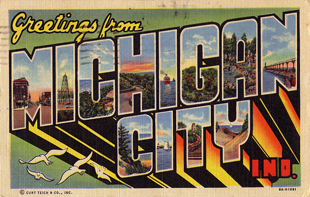 Catherine and her family, including the granddaughter, did not live in Michigan City for very long. By the time the granddaughter was 10 years old, they had moved to the New York City area. The granddaughter made her Broadway debut when she was barely in her teens.
Catherine and her family, including the granddaughter, did not live in Michigan City for very long. By the time the granddaughter was 10 years old, they had moved to the New York City area. The granddaughter made her Broadway debut when she was barely in her teens.
She went on to star in dozens of classic movies during the 1940s and '50s, even winning an Academy Award. Among her movies is a blockbuster frequently shown on TV during the Easter season.
Question: Name the famous actress - and native Hoosier - who was Frank Lloyd Wright's granddaughter.
This week's prize is a pair of tickets to the Indiana Wine Fair in Brown County on April 27, courtesy of the Story Inn, and a pair of tickets to Crown Hill Cemetery tours, courtesy of of Visit Indy.
Roadtrip: 'Preservation at the Crossroads'
The Hoosier History Live! Roadtrip report? Oh yes, that's a live call-in report about a cool place to visit in the Hoosier state, or a festival, or an event coming up.  A fond farewell to Chris Gahl, whose extensive schedule as vice president of marketing and communications at Visit Indy has made it necessary for him to sign off from his additional duties. And our sincere thanks to Visit Indy for continuing to provide prizes for our History Mystery winners.
A fond farewell to Chris Gahl, whose extensive schedule as vice president of marketing and communications at Visit Indy has made it necessary for him to sign off from his additional duties. And our sincere thanks to Visit Indy for continuing to provide prizes for our History Mystery winners.
Coming up next, the Rotating Roadtrippers! Yes, we are asking several of you to step up and report your favorite spots and activities around the state.
Up this Saturday is Garry Chilluffo of Chilluffo Photography, who chairs the Hospitality Committee for Preservation at the Crossroads. The annual preservation conference for the National Trust for Historic Preservation will be holding its annual conference in Indy this fall, from Oct. 29 through Nov. 2. Hear more on the show this Saturday, and click here to watch a video that puts Indy in a whole new light!
Amelia Earhart and her Indiana connections
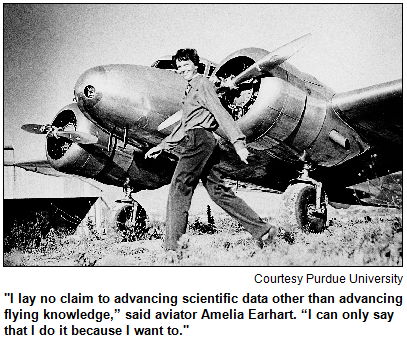 (March 23, 2013 - encore presentation) - She vanished more than 75 years ago over the South Pacific while attempting to fly around the world in a Lockheed Electra 10E twin-engine airplane sponsored by Purdue University. That's just one of the connections between famous aviator Amelia Earhart and the Hoosier state.
(March 23, 2013 - encore presentation) - She vanished more than 75 years ago over the South Pacific while attempting to fly around the world in a Lockheed Electra 10E twin-engine airplane sponsored by Purdue University. That's just one of the connections between famous aviator Amelia Earhart and the Hoosier state.
She was particularly associated with Purdue, which has the world's largest and most comprehensive collection of artifacts associated with the famous aviator, whose disappearance in 1937 remains a mystery.
To explore the sky-high stack of Earhart links to Indiana, Purdue staff writer and historian John Norberg, an aviation expert, joins Nelson in studio for one of the most popular shows in our Hoosier History Live! archives. (Its original air date was Sept. 15, 2012.) Our salute to Women's History Month makes a re-broadcast of this show particularly appropriate.
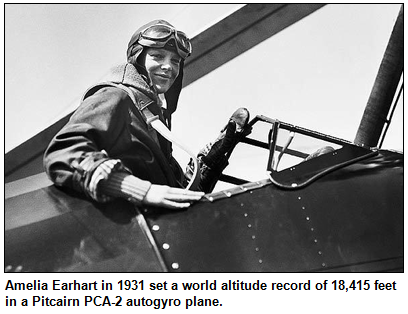 During the final two years before Amelia Earhart vanished, she was a sort of visiting celebrity-in-residence on the West Lafayette campus, where she was a career counselor for women students, and where she lectured and conducted conferences. She also was an adviser to the university’s department of aeronautics.
During the final two years before Amelia Earhart vanished, she was a sort of visiting celebrity-in-residence on the West Lafayette campus, where she was a career counselor for women students, and where she lectured and conducted conferences. She also was an adviser to the university’s department of aeronautics.
Despite her fame, "Lady Lindy" chose to stay in a women's dorm (then known as South Hall, today it's part of Duhme Hall) and eat with students in the cafeteria.
In 1935, the same year she joined the Purdue faculty, Earhart visited the Indianapolis Motor Speedway. She became the first woman to receive an official position during the Indianapolis 500. serving as a race official. Earhart also demonstrated a parachute training device before the race began.
The pioneer aviator was just 39 years old when she disappeared with her navigator, Fred Noonan, while flying from New Guinea to the Howland Islands.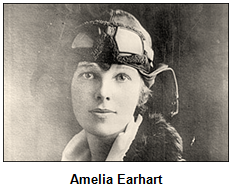 She was attempting to become the first woman to circumnavigate the globe.
She was attempting to become the first woman to circumnavigate the globe.
Purdue's sponsorship of her Lockheed Electra included arranging for financial assistance from Indianapolis business leader J.K. Lilly and other donors. The huge collection of Earhart memorabilia at Purdue includes some of her flight suits, logs and diaries, lecture notes, poems and even a pre-marital agreement with her husband, George Putnam.
Amelia Earhart wasn't a native Hoosier. Born in Atchison, Kansas, in 1897, Earhart earned her pilot’s license in 1922 and within a month set an altitude record (14,000 feet) for a woman aviator.
 Subsequently, her list of record-breaking achievements included becoming the first woman to fly across the Atlantic Ocean in 1928, and two years later setting a speed record (181 mph) for a woman in flight.
Subsequently, her list of record-breaking achievements included becoming the first woman to fly across the Atlantic Ocean in 1928, and two years later setting a speed record (181 mph) for a woman in flight.
Invitations to establish a relationship with Purdue apparently were appealing for several reasons. She liked the fact that engineering and mechanical training were fully open to women students, and she was appreciative that, in 1935, Purdue was the only university in the country with its own airstrip.
Our guest John Norberg has written extensively about Earhart's colorful life. During our show, he confirms various accounts about the impact of her stay on the Purdue campus. They include an appeal by women students to administrators after they observed the celebrity aviator in slacks. Under a dress code enforced in the mid-1930s, women students at Purdue were prohibited from wearing slacks.
Birds across Indiana
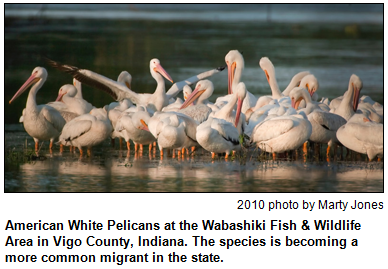 (March 16, 2013) - Have you heard birds chirping?
(March 16, 2013) - Have you heard birds chirping?
Anticipating the arrival of spring, Hoosier History Live! will swoop into all things related to birds across the state. Our show will feature the return appearance of a guest who is making his own history.
Don Gorney, a longtime volunteer board member of Amos Butler Audubon Central Indiana who is known for his bird hikes that often are based at Fort Harrison State Park, has just become the first full-time staffer in the 75-year history of the nonprofit.
Don joined Nelson in studio to share insights about our bird heritage in late November 2009 for a show that primarily focused on winter-related aspects of our feathered friends. This time around, with spring imminent, there is much more turf to cover.
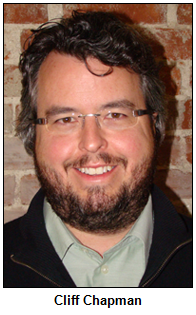 Nelson also is joined by Cliff Chapman, conservation director of the Central Indiana Land Trust and a board member of Amos Butler Audubon.
Nelson also is joined by Cliff Chapman, conservation director of the Central Indiana Land Trust and a board member of Amos Butler Audubon.
During the show, we explore the Goose Pond Fish and Wildlife Area in Greene County near the town of Linton. According to our guest Don Gorney, about 8,000 acres of restored marsh and prairie were drained in the 1800s for the site. It has become a "hot spot" for bird watching because of the sheer numbers of species and individual birds.
"In late February and early March, there were thousands of geese, over 15,000 Sandhill Cranes, 200 American White Pelicans, 25,000 ducks and nesting bald eagles" seen at the Goose Pond Fish and Wildlife Area, Don reports.
In his new post as Amos Butler Audubon's director of bird conservation and education, Don will be an advocate for bird conservation and lead the Lights Out Indy initiative designed to prevent the nighttime deaths of birds as they migrate over the Hoosier capital. He also will oversee a Wings Over Indy project that's designed to benefit - hold on to your hat - chimney swifts.
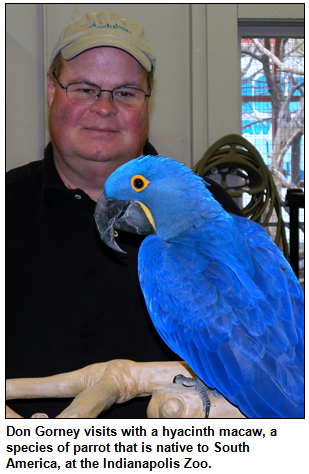 In addition, Don will be working with the city of Indy to increase awareness of the Indianapolis Birding Trail. Expected to be unveiled later this spring, the non-linear trail will highlight existing sites in Marion County where birds can be found.
In addition, Don will be working with the city of Indy to increase awareness of the Indianapolis Birding Trail. Expected to be unveiled later this spring, the non-linear trail will highlight existing sites in Marion County where birds can be found.
"Trail sites," he says, "will be designated by signage, and narrative text will be available via a website and smartphone app."
Our guest Cliff Chapman, who oversees land management for the Land Trust's preserves located throughout central Indiana, lives in Indy on a nature preserve on the White River. He describes himself as "passionate about birds," noting he has traveled across the country to seek out "rare birds in sometimes beautiful and sometimes difficult areas."
Amos Butler Audubon describes itself as a "grassroots chapter" of the National Audubon Society. Don, a naturalist who has worked as a bank examiner, began serving on the chapter's board in 2009. He recommends www.ebird.org as a convenient way to keep bird checklists and provide important data to researchers.
During our show, Don, Cliff and Nelson also explore:
- The Indiana "Big Year". The "big year" concept in birding - which involves seeing large numbers of different species in a specific geographical area - came to widespread public attention thanks to the movie The Big Year (2011). According to Don Gorney, the Indiana Big Year record is 313 species seen in 2008. Only about eight people, including Don, have "broken" the 300 barrier in Indiana. (He saw 301 species in 2005.)
- Eagle Creek Park Ornithology Center. It's probably the only municipal center in the country dedicated only to birds, Don reports.
- Human-induced hazards to birds. They include, in Don's words, "free-roaming cats, urban lighting, loss of habitat, pesticides and wind turbines."
Roadtrip: Urban Homestead at Flower and Patio Show
 Roadtripper Chris Gahl of Visit Indy will be calling in with a live report from the 55th annual Indiana Flower and Patio Show, which runs through March 17 at the Indiana State Fairgrounds in Indianapolis.
Roadtripper Chris Gahl of Visit Indy will be calling in with a live report from the 55th annual Indiana Flower and Patio Show, which runs through March 17 at the Indiana State Fairgrounds in Indianapolis.
Amidst the lush flowers, landscaping and innovative building materials you get to see every year, new this year is the "The Urban Homestead" - an on-site primer for adopting and living a sustainable (think small house!) lifestyle.
The "Eco Cottage" on display sits on a 10,000-square-foot "city lot" inside Expo Hall, complete with rain gardens, rain barrels, wind turbines, wood-burning boiler, chicken coops with live chickens, raised-bed gardens and beehives. Learn more when you tune in this Saturday!
History Mystery
Birds - majestic, colorful or wise - serve as the mascots for sports teams at some Indiana high schools. At one high school, the sports teams are known as the Owls. At another, they are the Cardinals, in honor of our state bird. Other high schools have as their mascots the Blackhawks, the Eagles and the Golden Eagles.
Question: Name just ONE of the Indiana high schools with one of these bird-themed mascots.
This week's prize is a gift certificate to the Kurt Vonnegut Memorial Library, courtesy of Visit Indy, as well as two tickets to You Are There, where you can see the new 1913: A City Under Water interactive exhibit that opens March 26, courtesy of the Indiana Historical Society.
Flood of 1913, worst in state history
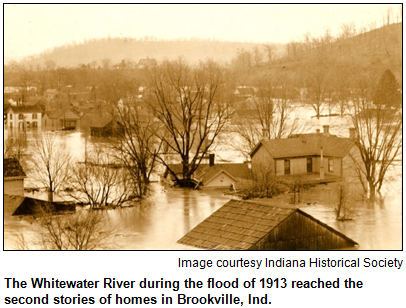 (March 9, 2013) - "How could a disaster that claimed 1,000 lives be forgotten?"
(March 9, 2013) - "How could a disaster that claimed 1,000 lives be forgotten?"
So asks Trudy E. Bell, a science writer and author based in Ohio, in a recent blog post in advance of the 100th anniversary of what is generally considered to be the greatest flood in Indiana history. Almost every Hoosier town near water - whether a river, lake or even a pond - found itself overwhelmed by the catastrophic Flood of 1913, which occurred on Easter weekend in late March.
Even worse, Terre Haute had just been hit by a tornado that caused an estimated $1 million to $3 million in damage (in 1913 dollars), according to an article Trudy wrote for Traces of Indiana and Midwestern History magazine.
"Levees," she reports, "burst all over the state - on the Mississinewa River in Marion, on the White River in Muncie, on the Wabash River in Lafayette, and on the Ohio River in Lawrenceburg - flooding the cities they were supposed to protect."
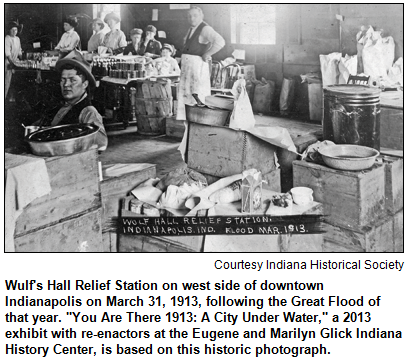 Indianapolis became "the single largest city ... badly devastated by the flood," Trudy notes.
Indianapolis became "the single largest city ... badly devastated by the flood," Trudy notes.
She is among Nelson's guests for this show about the natural disaster, which usually is remembered - if at all - because of the deaths of nearly 500 caged lions, tigers and other circus animals who drowned in Peru.
Others know about the horrific flood because of accounts about cadets from Culver Military Academy who undertook search and rescue operations in Logansport and other Hoosier communities.
In addition to Trudy, Nelson is joined in studio by Eloise Batic and Angela Giacomelli, two historical researchers with the Indiana Historical Society. They are helping put together an upcoming exhibit, titled "You Are There 1913: A City Under Water," that opens March 26 at the Eugene and Marilyn Glick Indiana History Center.
Re-enactors at the exhibit will portray historic Hoosiers, including Frederick Ayres, the president of the department store founded by his father; he was a key figure on the Indy relief committee for the Flood of 1913.
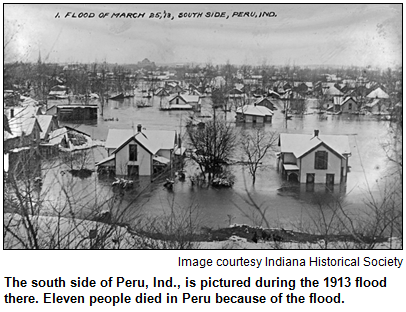 Another re-enactor will portray a bicycle-bound postal carrier on the city's west side who took photos of the flood that indicate he was in the middle of the chaos when a levee broke on the Morris Street Bridge.
Another re-enactor will portray a bicycle-bound postal carrier on the city's west side who took photos of the flood that indicate he was in the middle of the chaos when a levee broke on the Morris Street Bridge.
Amid the torrential rain and flooding in Peru, according to Trudy's article in Traces, more than 3,000 "instantly homeless" residents tried to jam into the hilltop Miami County Courthouse. It became a relief center akin to the Superdome in New Orleans decades later during Hurricane Katrina. Inside the courthouse, 12 people suffocated to death from the overcrowding. Outside, other Peru residents endured a night of pelting rain as they huddled in hopes of gaining entry - and watched in terror as the floodwaters crept ever higher.
By the end of the horrific flood, about 200 Hoosiers had died, with 200,000 others left homeless. (The total fatality count of nearly 1,000 includes deaths in other states.)
A note about the description of the 1913 flood as the state's worst:
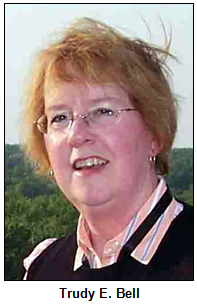 According to several sources, some areas of the state - particularly in central and southwestern Indiana - actually endured worse flooding in June 2008. For example, Columbus experienced a flood then that was more than 6 inches higher than the March 1913 record. The flood in June 2008 forced the evacuation of 250 patients and employees at Columbus Regional Hospital, where total damage estimates exceeded $210 million.
According to several sources, some areas of the state - particularly in central and southwestern Indiana - actually endured worse flooding in June 2008. For example, Columbus experienced a flood then that was more than 6 inches higher than the March 1913 record. The flood in June 2008 forced the evacuation of 250 patients and employees at Columbus Regional Hospital, where total damage estimates exceeded $210 million.
Even so, the consensus of most experts is that the Flood of 1913 (which occurred on Easter weekend) has been the worst statewide, particularly in terms of deaths, loss of homes and the extent of the impact on daily lives. In Indiana, the full devastation began on Maundy Thursday and Good Friday in March of 1913, following what Trudy describes in her Traces article as a winter that had been "unusually warm and wet."
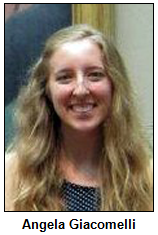 She writes that record, "hurricane-force" winds began sweeping across the state, blowing down barns, uprooting trees, whisking the roofs off buildings and downing power lines. Next came relentless, driving rains for days.
She writes that record, "hurricane-force" winds began sweeping across the state, blowing down barns, uprooting trees, whisking the roofs off buildings and downing power lines. Next came relentless, driving rains for days.
Gov. Samuel Ralston of Indiana appealed for help to the American Red Cross, which Trudy points out was rather small in 1913 and "still relatively unknown in the field of disaster relief." The governor's wife, Jennie Ralston, helped create a women's committee that provided relief for flood sufferers in Indianapolis.
At the Indiana History Center, the "You Are There" exhibit will focus on Wulf's Hall Relief Station, a saloon on the west side of downtown Indy that was quickly converted into a relief center. A re-enactor will portray the head rabbi of the Indianapolis Hebrew Congregation, which also was heavily involved with relief efforts.
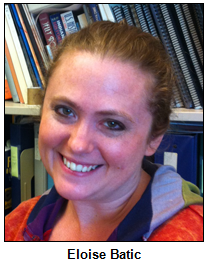 On Trudy's website, she recounts how Indiana Reformatory inmates became heroes by helping save the town of Jeffersonville. Temporarily granted freedom by the reformatory's superintendent, the convicted felons battled "night and day for more than a week" to bolster two levees against the Ohio River's surging floodwaters. After the ordeal, Jeffersonville residents honored the prisoners with a lavish banquet.
On Trudy's website, she recounts how Indiana Reformatory inmates became heroes by helping save the town of Jeffersonville. Temporarily granted freedom by the reformatory's superintendent, the convicted felons battled "night and day for more than a week" to bolster two levees against the Ohio River's surging floodwaters. After the ordeal, Jeffersonville residents honored the prisoners with a lavish banquet.
In addition to the upcoming exhibit at the History Center, other exhibits related to the Flood of 1913 include:
- At the Hamilton East Public Library in Noblesville, an exhibit opened March 1 of original photos of the White River's flooding. The exhibit, which also includes enlarged 1913 newspaper articles, will continue through April 30.
- The West Lafayette Public Library is displaying photos of the flood from the collection of the Tippecanoe County Historical Association. This exhibit also will continue through April 30.s
Roadtrip: Historic New Carlisle on Lincoln Highway
Public historian Glory-June Greiff will be Roadtripping for us this Saturday. Her pick is New Carlisle in northern Indiana. It was established in 1835 on the Michigan Road and is also crossed by another scenic byway, the Lincoln Highway, so this trip will get take you to two historic roads for the price of one.
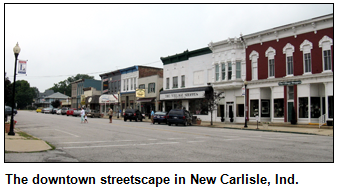 The Old Republic on the hill is the town's signature home and is headquarters of Historic New Carlisle, Inc. The home also houses a small museum of local artifacts and displays. New Carlisle also boasts a historic district of six blocks, including a picturesque downtown, and offers a great variety of historic styles of architecture.
The Old Republic on the hill is the town's signature home and is headquarters of Historic New Carlisle, Inc. The home also houses a small museum of local artifacts and displays. New Carlisle also boasts a historic district of six blocks, including a picturesque downtown, and offers a great variety of historic styles of architecture.
Glory-June also tells us that New Carlisle has a slew of interesting restaurants, including Moser's Austrian Café, a real Irish pub, Millers Home Cafe for old fashioned comfort food, or The Diner for, well, your basic diner.
Our Roadtripper tells us if you're looking for more vigorous walking or communing with nature, nearby is Bendix Woods County Park (which formerly was the Studebaker Proving Grounds!) or the lovely Spicer Lake Nature Preserve. Enjoy!
History Mystery
In March 1913, just before the great flood that overwhelmed the entire state of Indiana, the town of New Castle was the setting for a tragedy that became a national media sensation for years and remains a mystery to this day. 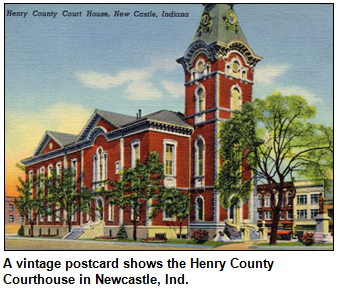 A 9-year-old girl suddenly vanished in a mystery that some have called Indiana's equivalent of the case of JonBenet Ramsey in a subsequent era.
A 9-year-old girl suddenly vanished in a mystery that some have called Indiana's equivalent of the case of JonBenet Ramsey in a subsequent era.
The disappearance of the girl in New Castle in broad daylight - at about noon on March 20, 1913 - resulted in a national search, far-fetched theories about who might have abducted her, suspicion against her parents and massive media coverage.
Her mysterious disappearance even inspired two popular songs of the era. For decades, many parents would warn their children to take precautions while walking to school, playing outdoors or running errands - or else they could end up like the girl from New Castle who was never found.
Question: Name the girl who vanished in March 1913 in New Castle.
This week's prize is two tickets to the Indiana Wine Fair on Saturday, April 27, in Brown County, courtesy of Story Inn, as well as two tickets to You Are There, where you can see the new 1913: A City Under Water interactive exhibit, courtesy of the Indiana Historical Society.
Hoosier women pioneers in media
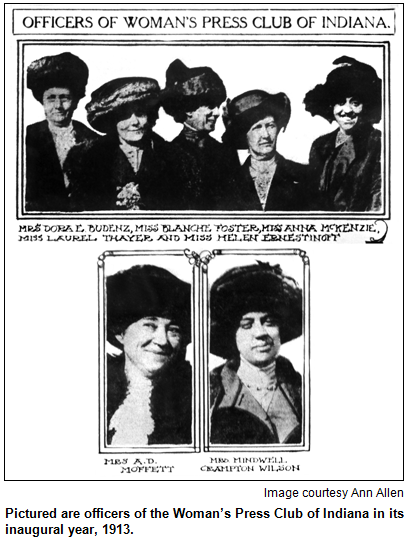 (March 2, 2013) - The state's first statue erected to honor a woman is in Turkey Run State Park and pays tribute to a journalist. The Woman's Press Club of Indiana celebrates a milestone, its 100th anniversary, this year. And the challenges confronted by women in Indiana media - from reporters and radio newscasters to newspaper owners - have been researched by their counterparts today.
(March 2, 2013) - The state's first statue erected to honor a woman is in Turkey Run State Park and pays tribute to a journalist. The Woman's Press Club of Indiana celebrates a milestone, its 100th anniversary, this year. And the challenges confronted by women in Indiana media - from reporters and radio newscasters to newspaper owners - have been researched by their counterparts today.
So, as Hoosier History Live! salutes Women's History Month, we will focus on women journalists who blazed trails in our state, including some who attained national renown more than 100 years ago.
Nelson is joined in studio by two past presidents of the Woman's Press Club who have won multiple awards for their media work:
- Julie Slaymaker, an Indianapolis-based freelance writer with an extensive background in print and radio. Her credits range from covering the rape trial of Mike Tyson to writing profiles of such Hoosier newsmakers as Susan Bayh and Judy O'Bannon.
- And Ann Allen, a former newspaper owner based in the town of Akron in far-northern Indiana. Now a magazine and newspaper writer, Ann is the former owner and editor of the Akron News (later the Akron/Mentone News), the author of six books and a correspondent for the Rochester Sentinel.
In addition to discussing the challenges that they have confronted (as a staff member at an Indy radio station in the 1960s, Julie says she was told she could not be a news reader because women did not have "credibility" delivering newscasts), Julie and Ann also will share insights about Hoosier women of earlier media eras.
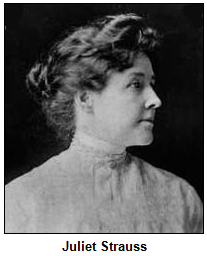 They include Juliet V. Strauss (1863-1918) of Rockville in Parke County, who eventually became one of the country's best-read magazine writers. She wrote a monthly column called "The Ideas of a Plain Country Woman" for The Ladies Home Journal after beginning her career at The Rockville Tribune newspaper. Juliet Strauss, a founder of the Woman's Press Club, also fought to save Turkey Run from developers. That explains why women journalists across the state arranged for her statue to be placed there.
They include Juliet V. Strauss (1863-1918) of Rockville in Parke County, who eventually became one of the country's best-read magazine writers. She wrote a monthly column called "The Ideas of a Plain Country Woman" for The Ladies Home Journal after beginning her career at The Rockville Tribune newspaper. Juliet Strauss, a founder of the Woman's Press Club, also fought to save Turkey Run from developers. That explains why women journalists across the state arranged for her statue to be placed there.
Julie, Ann and Nelson also discuss Kate Milner Rabb (1866-1937), a columnist for The Indianapolis Star who became a president of the Woman's Press Club, and Hortense Myers (1913-1987), a legendary political reporter for United Press International who was the first woman inducted into the Indiana Journalism Hall of Fame.
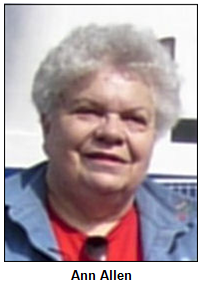 Julie and Nelson are board members for the Hall of Fame, which inducted Rabb posthumously last year. They also share details about their late, cherished friend, Bettie Cadou, an Indianapolis-based writer known for breakthroughs in sports journalism who also was inducted posthumously into the Hall of Fame.
Julie and Nelson are board members for the Hall of Fame, which inducted Rabb posthumously last year. They also share details about their late, cherished friend, Bettie Cadou, an Indianapolis-based writer known for breakthroughs in sports journalism who also was inducted posthumously into the Hall of Fame.
In 1971 - six years before Janet Guthrie became the first woman driver to compete in the Indianapolis 500 - Bettie Cadou shattered a barrier at the Indianapolis Motor Speedway. She is considered to have been the first woman, in any professional capacity, to gain coveted silver-badge credentials to Gasoline Alley, allowing her access to the pits and garage areas. 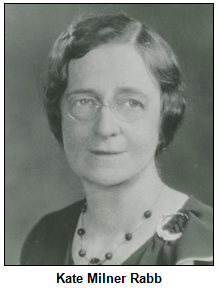 (A few other women, including some journalists and sponsors, occasionally had been allowed in Gasoline Alley for brief visits. In general, though, women had been barred from the pits and garage areas ever since the opening of the world-famous racetrack in 1909.) Bettie's entry followed a lawsuit against the Speedway filed by Mari McCloskey, a staff member of Women's World magazine,
(A few other women, including some journalists and sponsors, occasionally had been allowed in Gasoline Alley for brief visits. In general, though, women had been barred from the pits and garage areas ever since the opening of the world-famous racetrack in 1909.) Bettie's entry followed a lawsuit against the Speedway filed by Mari McCloskey, a staff member of Women's World magazine,
Bettie Cadou, who died at age 66 in 2002, also covered the Indianapolis Colts during the 1980s as a stringer for The New York Times and Sports Illustrated. She once told Nelson: "I'm probably the only grandmother covering an NFL team in the country."
Nelson and his guests also explore the challenges confronted by the first woman photographer to cover the state high school basketball tournament. Ruth Chinn, now 88, is a Muncie-based photojournalist who, as our guest Ann Allen puts it, "broke into sports reporting with a bang" in the mid-1940s. Lugging 55 pounds of camera equipment into Hinkle Fieldhouse (then Butler Fieldhouse), she covered the tournament during an era when fewer than 20 women in the country were staff photographers for daily newspapers.
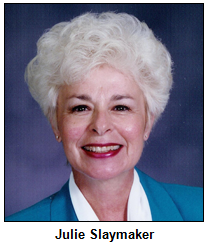 Ann Allen, who has written an article about the Woman's Press Club of Indiana for an upcoming issue of Traces of Indiana and Midwestern History magazine, notes: "Lest we forget, founding members had to overcome their editors' fears that they might become, horror of horrors, suffragettes. Many were called into their editors' offices to see just what they had in mind with this new club."
Ann Allen, who has written an article about the Woman's Press Club of Indiana for an upcoming issue of Traces of Indiana and Midwestern History magazine, notes: "Lest we forget, founding members had to overcome their editors' fears that they might become, horror of horrors, suffragettes. Many were called into their editors' offices to see just what they had in mind with this new club."
Some history facts:
- The Woman's Press Club of Indiana was founded in 1913 at a famous, bygone site that we explored on a recent radio show: the L.S. Ayres Tea Room.
- Our guest Ann Allen's recent newspaper work has included a first-person account of putting herself on a food stamp budget for one week, and also a story about the disappearance of an Akron man that remains an unsolved mystery.
- During World War II, Hortense Myers was recruited to handle the sports desk for a wire service. She resorted to a byline ("M.H. Powner") that disguised the fact that a woman was writing about sports.
Roadtrip: Mauxferry Road, Indiana's 'Mother Road'
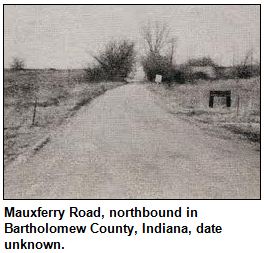 We had a listener tell us that not enough attention has been paid to Indiana's "Mother Road," the Mauxferry Road, which originally ran from Mauckport on the Ohio River and ended in Indianapolis. The name Mauxferry Road has pretty much disappeared in most parts of the state; for example, in Bartholomew County the name of the road was changed to 500 West, but the name "Mauxferry" remains on the much of the road in Johnson County.
We had a listener tell us that not enough attention has been paid to Indiana's "Mother Road," the Mauxferry Road, which originally ran from Mauckport on the Ohio River and ended in Indianapolis. The name Mauxferry Road has pretty much disappeared in most parts of the state; for example, in Bartholomew County the name of the road was changed to 500 West, but the name "Mauxferry" remains on the much of the road in Johnson County.
In 1824, the road was completed, and in the fall of that year, the state's treasury and other tools of government were moved from Corydon to the new capital of Indianapolis. Learn more when you tune in this Saturday.
History Mystery
In 1971, Indianapolis-based journalist Bettie Cadou made a breakthrough for women at the Indianapolis Motor Speedway. Six years before Janet Guthrie became the first woman driver to compete in the Indianapolis 500, Bettie Cadou is considered to have been the first woman, in any professional capacity, to gain coveted silver-badge credentials at the Speedway, allowing her access to the pits and garage areas.
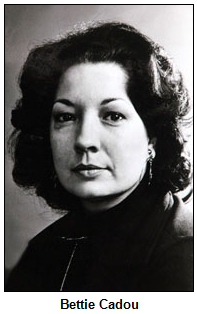 Although a few other women, including some journalists, occasionally had been allowed in Gasoline Alley for brief visits, three things had been considered bad luck in the pits and garage areas since the Speedway opened in 1909. They were women, peanuts and a certain color.
Although a few other women, including some journalists, occasionally had been allowed in Gasoline Alley for brief visits, three things had been considered bad luck in the pits and garage areas since the Speedway opened in 1909. They were women, peanuts and a certain color.
In fact, when Janet Guthrie made international headlines in 1977 by becoming the first woman driver in the Indy 500, she deliberately showed up with a race car painted in this long-unseen color as a gesture of defiance against antiquated traditions.
Question: What was the color that was considered bad luck for so many decades in Gasoline Alley at the world-famous racetrack?
This week's prize is two tickets to the Indiana Wine Fair on Saturday, April 27 in Brown County, courtesy of Story Inn, as well as two tickets to the Indiana Experience at the Indiana History Center, courtesy of Visit Indy.
What do you do with vacant, historic movie theaters?
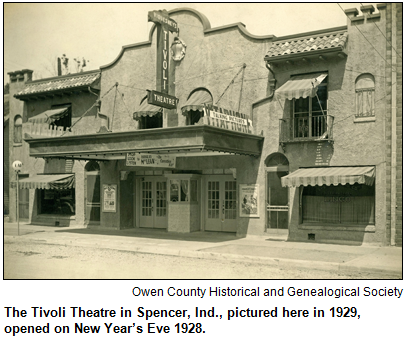 (Feb. 23, 2013) - On this Academy Awards gala weekend, Hoosier History Live! spotlights an aspect of our movie heritage. Specifically, we focus on the challenges that confront towns and neighborhoods with historic movie theaters that, while glorious in their heyday and built with marquees, balconies and platforms or pits for organs and pianos, have fallen on hard times.
(Feb. 23, 2013) - On this Academy Awards gala weekend, Hoosier History Live! spotlights an aspect of our movie heritage. Specifically, we focus on the challenges that confront towns and neighborhoods with historic movie theaters that, while glorious in their heyday and built with marquees, balconies and platforms or pits for organs and pianos, have fallen on hard times.
That's particularly been the case for many vintage theaters built with only one screen, limiting their ability to compete with newer, multiscreen cinemas in shopping centers.
Among the historic theaters that have been in the news recently - and that we will explore during the show - is the once-lavish and beloved Rivoli Theatre on the near eastside of Indianapolis. Built in 1927 on East 10th Street, the Rivoli had a seating capacity of 1,500. Its sad post-heyday fate has included a long stint as an X-rated theater, then an even longer stretch of sitting vacant and deteriorating alarmingly.
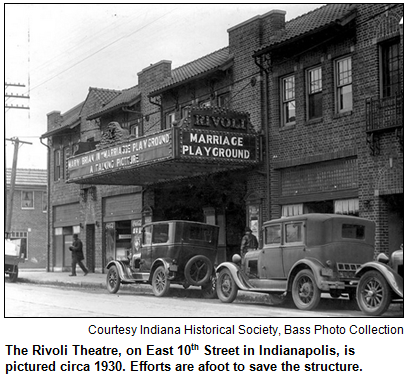 Our in-studio guests include Mark Dollase of Indiana Landmarks, who in his off-duty life has been a key organizer of the Rivoli Center for the Performing Arts, a non-profit that now owns the theater. (The city of Indy recently announced that a $300,000 federal grant will be used to repair a portion of the Rivoli's roof, merely one of a long list of needs for the vacant theater.)
Our in-studio guests include Mark Dollase of Indiana Landmarks, who in his off-duty life has been a key organizer of the Rivoli Center for the Performing Arts, a non-profit that now owns the theater. (The city of Indy recently announced that a $300,000 federal grant will be used to repair a portion of the Rivoli's roof, merely one of a long list of needs for the vacant theater.)
Mark and Nelson also are joined by Jeannie Regan-Dinius of the Indiana Department of Natural Resources, who, with her husband, once owned the historic Huntington Theatre in Huntington. In her capacity as the DNR's director of special initiatives in historic preservation, Jeannie has been assisting a range of landmark theaters across the state, some with uncertain fates and others undergoing restoration.
The latter include the Tivoli Theatre in Spencer, which opened on New Year's Eve in 1928. Located on the town's courthouse square, the Tivoli drew crowds from surrounding communities and featured stage shows and concerts, as well as movies. A few years after a fire, the Tivoli closed in the 1990s and has been vacant.
Last summer, though, a restoration of the Tivoli began, thanks to funding from the Cook Group. 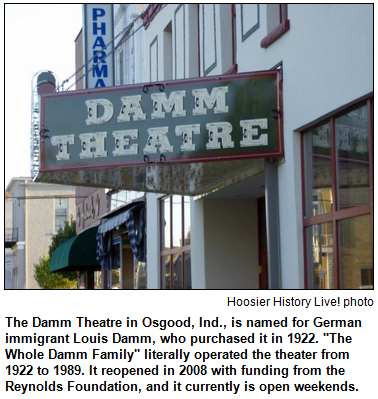 Details of the Tivoli, past and present, are shared by a third guest on our show, Spencer resident Jason Kinney, a board member and the historian for Owen County Preservations Inc., which owns the Tivoli.
Details of the Tivoli, past and present, are shared by a third guest on our show, Spencer resident Jason Kinney, a board member and the historian for Owen County Preservations Inc., which owns the Tivoli.
Jason, who also is the president of the Owen County Historical and Genealogical Society, has been researching and providing historical photos for the extensive restoration of the Tivoli's auditorium.
Nelson and his guests also explore the vintage Fowler Theatre, which has been restored in the Benton County town of Fowler, and a bygone movie palace, also called the Rivoli, that was torn down in Muncie.
In Bloomington, though, the Buskirk Chumley has been restored; during its Act One life, it was known as the Indiana Theatre for decades after it opened as a silent movie house in 1922.
Among the single-screen survivors and success stories are the Devon Theatre, an Art Deco-style theater in Attica that opened in 1932, and, perhaps one of the best-known, the historic Artcraft Theatre in Franklin.
In Indianapolis, the Rivoli initially was owned by Universal Studios and cost $250,000 to build during the 1920s. Located in a sprawling building with four storefronts, the Rivioli featured a decorative lobby with terrazzo floors made of marble, balconies, an orchestra pit and state-of-the-art acoustics. 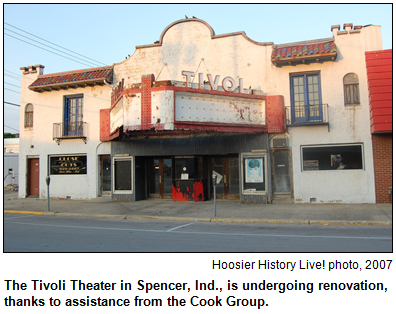 During the late 1970s, the Rivoli became a venue for live music, then an adult movie theater.
During the late 1970s, the Rivoli became a venue for live music, then an adult movie theater.
Since its closing in 1992, the Rivoli's once-ornate interior has deteriorated to a state of "advanced decay," according to a recent Indianapolis Star article. In addition to the grant money for a new roof over the auditorium, Mark and others involved with the Rivoli Center for the Performing Arts are seeking more than $3 million to renovate the landmark.
In Fowler, the town's historic movie theater also had deteriorated. When the community learned in 2001 that artifacts from the theater's interior - and even its marquee - might be sold separately, a nonprofit, the Prairie Preservation Guild, formed. The Fowler Theatre reopened, with an all-volunteer "army" that continues to undertake tasks ranging from ticket taking to running the projector and selling concessions.
An issue expected to confront many vintage, single-screen theaters concerns the upcoming distribution of first-run movies only in digital formats. Many lovers of historic theaters worry that owners in small towns won't be able to afford the steep costs of converting their projection areas to digital.
Roadtrip: 'America's Music' in Vincennes opens March 4
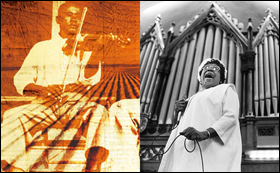 Chris Gahl of VisitIndy will suggest that we take the Roadtrip to Vincennes for the kickoff of "America's Music: A Film History of our Popular Music, from Blues to Bluegrass to Broadway."
Chris Gahl of VisitIndy will suggest that we take the Roadtrip to Vincennes for the kickoff of "America's Music: A Film History of our Popular Music, from Blues to Bluegrass to Broadway."
The opening film and discussion, presented by Tribeca Film Institute and Vincennes State Historic Sites, will take place Monday evening, March 4, at 6:30 p.m. in the Shircliff Auditorium at Vincennes University Campus and is free.
On the following day, March 5, Greg Gilpin will perform in the Skelton Center on the university campus at 7 p.m. For more information about the entire series featuring documentary film screenings and scholar-led discussions of 20th-century American popular music, visit America's Music or Indiana State Historic Sites.
History Mystery
On the north side of Indy, the Vogue Theater opened in 1938 and was a popular neighborhood movie house for decades. Later, it became even better known with its recreation as a nightclub. The Vogue is now one of the most popular venues in the Indy metro area for dancing and contemporary music, with its movie-style marquee serving as a landmark on North College Avenue.
Farther south on College Avenue, a neighborhood movie house once was a popular destination near East 42nd Street. The movie theater opened in 1926 and was designed by the architectural firm that also created the Circle Theatre in downtown Indy. The movie house near College and 42nd closed during the 1970s. Unlike the Vogue and the Circle, it was demolished.
Question: Name the bygone movie theater that was a familiar site for decades at College and 42nd on the north side of Indy.
This week's prize is two tickets to the Indiana Wine Fair on Saturday, April 27 in Brown County, courtesy of Story Inn, as well as a gift certificate for The Sanctuary, the Art of Nancy Noel in Zionsville, courtesy of Visit Indy.
Wine heritage in Indiana
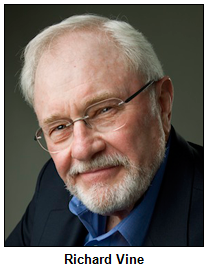 (Feb. 16, 2013) - When you put together a mix of wine, broadcasting and Indiana, doesn't one person's name pop to mind? Indy's own Jill Ditmire, a nationally known wine expert who also is a radio and TV veteran, joins Nelson to co-host this show about various aspects of our state's wine heritage.
(Feb. 16, 2013) - When you put together a mix of wine, broadcasting and Indiana, doesn't one person's name pop to mind? Indy's own Jill Ditmire, a nationally known wine expert who also is a radio and TV veteran, joins Nelson to co-host this show about various aspects of our state's wine heritage.
Jill is the owner of Mass Ave Wine Shoppe in downtown Indy, a member of the American Wine Society and a popular speaker about food and wine. She also is a judge at international wine competitions. Nelson and Jill explore Indiana's wine heritage with two guests who are household names among Hoosier connoisseurs.
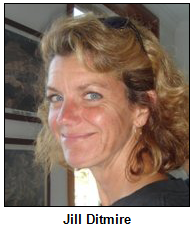 They are joined in studio by Richard Vine, a professor emeritus at Purdue University of enology (that's the study and making of wine) and the author of a new book, The Curious World of Wine: Facts, Legends and Lore About the Drink We Love So Much (Perigee Books).
They are joined in studio by Richard Vine, a professor emeritus at Purdue University of enology (that's the study and making of wine) and the author of a new book, The Curious World of Wine: Facts, Legends and Lore About the Drink We Love So Much (Perigee Books).
Deeply knowledgeable about Indiana wineries, Richard is the namesake of the wine library at Purdue, the Richard P. Vine Enology Library, which includes his collection of hundreds of books about wine and wine-making. 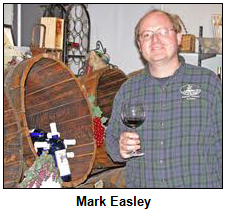 He has been knighted by three international wine brotherhoods and is the retired chairman of the Indy International Wine Competition.
He has been knighted by three international wine brotherhoods and is the retired chairman of the Indy International Wine Competition.
Also joining us are Mark Easley, who with his wife Meredith owns Easley Winery in downtown Indianapolis. They are second-generation owners of the winery, 205 N. College Ave., which was founded by Mark's parents, Jack and Joan Easley.
(More than 40 years ago, Jack Easley, an attorney, was a key member of a group that formed to change Indiana's laws, which greatly restricted wine-making in the Hoosier state. The elder Easleys opened the winery in the 1970s in a former ice cream factory; they had their first "grape crush" in 1974.)
We're grateful to Mark because he joins our show by phone from a remote location in the Caribbean! That's even relevant to the topic because the Easleys apparently came up with the idea for a "reggae" wine when they visited an exotic locale near the site where he'll be calling in.
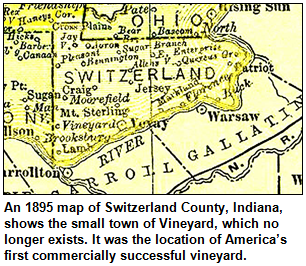 Some more fun facts:
Some more fun facts:
- The Indiana Wine Fair, one of the largest wine festivals in the state, will be April 27 in Brown County.
- According to a recent article in Nuvo Newsweekly, Indiana currently has about 60 wineries.
- In addition to being the author of his new book about wine, our guest Richard Vine has written four wine textbooks. He also was hired for many years by American Airlines to select the wines to be served aboard their flights.
Jill Ditmire's co-hosting gig with Nelson is something of a return to WICR-FM (88.7). Regular listeners will fondly remember Jill's sparkling segment - called "So Many Wines" - that was featured on Too Many Cooks!, the former "sister" show of Hoosier History Live!
"Learn more" websites:
- Indiana Wineries.
- Indiana Wines: A History, by James Butler.
- Vintage Winery Consultants.
Roadtrip: Toboggan at Pokagon State Park
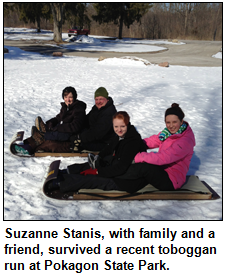 Guest Roadtripper Suzanne Stanis of Indiana Landmarks recently took the Roadtrip up to Pokagon in the far-northeast corner of Indiana, where she and her family survived a run on the famed refrigerated toboggan run.
Guest Roadtripper Suzanne Stanis of Indiana Landmarks recently took the Roadtrip up to Pokagon in the far-northeast corner of Indiana, where she and her family survived a run on the famed refrigerated toboggan run.
Pokagon State Park is located near Angola, just off I-69, and, although its original name was Lake James State Park, in 1925 its name was changed to acknowledge the rich Native American heritage of the state and region.
Leopold and Simon Pokagon were father and son and the last two most notable leaders of the Potawatomi, who made their home in the area. Other winter activities at Pokagon include cross-country skiing, sledding and ice fishing.
History Mystery
In 2005, a famous Hoosier announced that he was teaming with a California winery to produce a line of wines.  Apparently the famous Hoosier, a former star athlete, had been dabbling in growing grapes for several years. Even so, he was not usually associated with California. In addition to owning homes in Indiana, the famous Hoosier in recent years also has lived in Naples, Fla.
Apparently the famous Hoosier, a former star athlete, had been dabbling in growing grapes for several years. Even so, he was not usually associated with California. In addition to owning homes in Indiana, the famous Hoosier in recent years also has lived in Naples, Fla.
Question: Who is the famous Hoosier?
This week's prize is four tickets to the Indiana Wine Fair on Saturday, April 27 in Brown County, courtesy of Story Inn, as well as a $25 gift certificate for merchandise at the Kurt Vonnegut Memorial Library, courtesy of Visit Indy.
Long-forgotten man who designed Indy
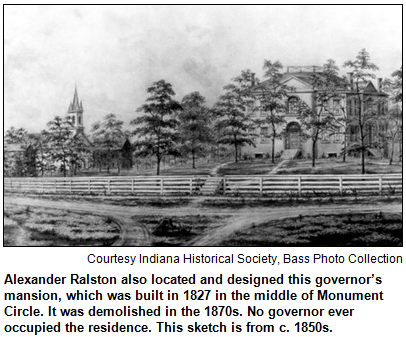 (Feb. 9, 2013) - Finally and at last, the surveyor who traveled to the Indiana wilderness and laid out the state's new capital is getting some respect.
(Feb. 9, 2013) - Finally and at last, the surveyor who traveled to the Indiana wilderness and laid out the state's new capital is getting some respect.
A boutique hotel that just opened in downtown Indianapolis is named in honor of Alexander Ralston. So is a pub-restaurant that opened last year on Massachusetts Avenue, one of the dozens of streets designed by the planner who even had slipped into obscurity by the time he died in 1827.
Hoosier History Live! not only will explore the unheralded life of the surveyor (Ralston also helped design Washington D.C.) who had such an enormous impact on the Hoosier capital, we also will analyze issues that historians have debated for decades: The reasons Ralston gave various names to specific streets in the new city.
For this show about Ralston (1771-1827), Nelson is joined in studio by Ratio Architects founder Bill Browne, who has delved into the pioneer surveyor's street-naming process. Other guests are Indianapolis historian Sheryl Vanderstel and Joan Hostetler, co-owner of Heritage Photo & Research Services, both of whom have researched Ralston's colorful life.
A Scottish expatriate, Ralston was an assistant to French architect Pierre L'Enfant when he laid out the nation's capital. But Ralston came to the "west" - the Indiana frontier - at least partially because he was linked to controversial politico Aaron Burr. With surveyor Elias Pym Fordham, Ralston was hired to design the new state capital that was created in marsh and swampland during the 1820s.
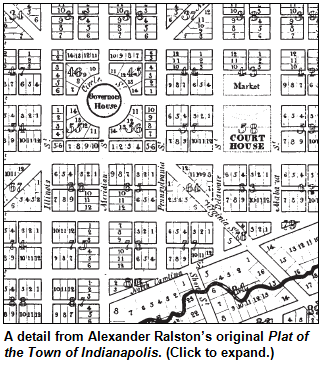 For nearly 200 years, though, virtually nothing in Indianapolis was named in his honor, although some Hoosiers advocated naming I-465 for Ralston. (Do you remember when Indy native David Letterman led a mock crusade to have I-465 named after himself?)
For nearly 200 years, though, virtually nothing in Indianapolis was named in his honor, although some Hoosiers advocated naming I-465 for Ralston. (Do you remember when Indy native David Letterman led a mock crusade to have I-465 named after himself?)
Now, though, Alexander Ralston is becoming "a bit of a rock star," as Urban Times editor Bill Brooks put it in a recent column in the monthly newspaper that serves Indy's historic neighborhoods.
The Alexander, the boutique hotel (with extensive, urban artwork) that recently opened as part of the large CityWay development on the south end of downtown, is named in tribute to Indy's initial designer. The hotel's bar, Plat 99, takes its name from the site's location on Ralston’s grid.
And Ralston Draft House on Massachusetts Avenue also is named in honor of the long-unheralded city designer.
In addition to sharing his insights into Ralston's street-naming process on our show, our guest Bill Browne, who is board chairman of the Indiana State Museum, will share his conclusions in an upcoming article in Traces of Indiana and Midwestern History, the magazine published by the Indiana Historical Society.
Our guest Sheryl Vanderstel researched and wrote the Encyclopedia of Indianapolis (Indiana University Press, 1994) entries for Ralston, who planned Indy's original Mile Square plat, as well as for surveyor Fordham.
Our guest Joan Hostetler, who specializes in local historic research and in preserving, digitizing and archiving historic photos, collaborated with Nelson and photographer Garry Chilluffo on the Indianapolis Then and Now (Thunder Bay Press, 2004) visual history book.
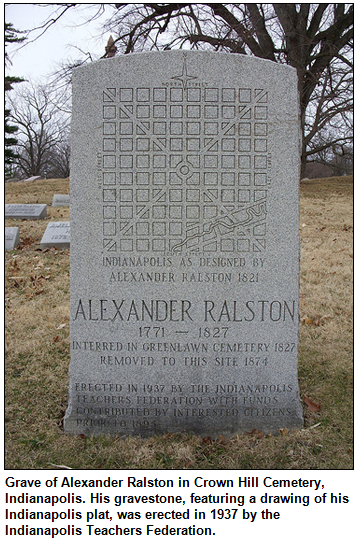 With her deep knowledge of Hoosier history, Joan has been a studio guest on our show several times, including a program in October 2011 during the controversy about whether to rename Georgia Street in downtown Indy. (Joan launched and led the Facebook crusade to retain the Georgia Street name.)
With her deep knowledge of Hoosier history, Joan has been a studio guest on our show several times, including a program in October 2011 during the controversy about whether to rename Georgia Street in downtown Indy. (Joan launched and led the Facebook crusade to retain the Georgia Street name.)
Not only did Ralston come up with the Georgia Street name, Ralston assigned state names to most of the thoroughfares in the city's original Mile Square, including Pennsylvania Street and Massachusetts Avenue. He made exceptions for Meridian Street, Market Street (which was designed with the idea of having a City Market on it) and Washington Street.
Like many residents of early Indy, Ralston never expected the city to grow beyond the Mile Square, which is bounded by North, South, East and West streets.
In his native Scotland, Ralston had been an engineer. After the Revolutionary War, he immigrated to the new United States and assisted L'Enfant with the city plan for Washington D.C. Ralston also was at least somewhat involved with Aaron Burr, the vice president who later was charged with (but subsequently acquitted of) treason.
In his new hometown of Indy, Ralston was influenced by the Washington D.C. design. He planned the central circle (what eventually became known as Monument Circle) in the center of the Mile Square grid, with four diagonal, radiating avenues, including Indiana Avenue and Virginia Avenue.
But the city's designer even was forgotten during his lifetime for reasons that Nelson will explore with his guests.
Like former world champion bicyclist Major Taylor, who was the focus of last week's show, Ralston was buried in an unmarked grave. More than 100 years later, he received a headstone on his burial site at Crown Hill Cemetery.
Even so, nothing in the Hoosier capital was named in his honor until the new hotel and the pub. Ralston Avenue on the northside of Indy was named in honor of Samuel Ralston, who was elected governor in 1913 and was not related to the city planner.
Roadtrip: Black History picks with Dona Stokes-Lucas
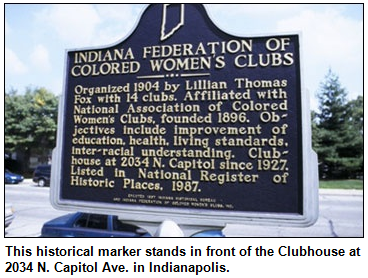 Guest Roadtripper Dona Stokes-Lucas will be calling in with a live report from the inaugural Sankofa Black Heritage Festival, which will be going on from 10 a.m. to 3 p.m. on Saturday at the Great Hall at the Indiana State Museum. Admission to the Great Hall is free (parking is $3 for the first three hours), and regular admission costs apply to the other exhibits at the museum, including the just-opened blockbuster Lincolns: Five Generations of an American Family.
Guest Roadtripper Dona Stokes-Lucas will be calling in with a live report from the inaugural Sankofa Black Heritage Festival, which will be going on from 10 a.m. to 3 p.m. on Saturday at the Great Hall at the Indiana State Museum. Admission to the Great Hall is free (parking is $3 for the first three hours), and regular admission costs apply to the other exhibits at the museum, including the just-opened blockbuster Lincolns: Five Generations of an American Family.
Dona has a couple of other downtown Indianapolis Black Heritage picks, including the Crispus Attucks Museum and the Indiana Federation of Colored Women's Clubs Clubhouse.
Then at 5:45 p.m. you can head over to Central Library for the Meet The Artist reception, where the African American History committee of the Indianapolis Public Library is celebrating its 25th anniversary. The reception is free and runs from 5:45 to 10 p.m., with free parking. You'll experience a showcase of visual artists, music and spoken word, along with a fashion show with commentary by Indianapolis designer Alpha Blackburn.History Mystery
Like most of the other major streets designed by Alexander Ralston in the original Mile Square of Indianapolis, Capitol Avenue initially was named after a state. 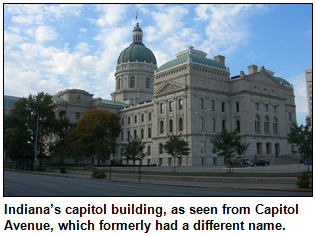 Many thoroughfares continue to have their original "state" name to this day: Illinois Street, Indiana Avenue, Pennsylvania Street, Massachusetts Avenue and Ohio Street are examples.
Many thoroughfares continue to have their original "state" name to this day: Illinois Street, Indiana Avenue, Pennsylvania Street, Massachusetts Avenue and Ohio Street are examples.
The current Indiana Statehouse - or Indiana State Capitol Building - was built for $2 million in the late 1880s on a street that still carried its original "state" name. But not too many years later, during the 1890s, the Indianapolis City Council voted to rename the street "Capitol Avenue," dropping the state name.
Question: What was the state that Capitol Avenue initially was named for?
This week's prize is a gift certificate of $70 to go toward tickets to a performance at the Cabaret at the Columbia Club, as well as a $25 gift certificate for merchandise at the Kurt Vonnegut Memorial Library. These prizes are courtesy of Visit Indy.
Major Taylor, world's greatest bicyclist of early 1900s
(Feb. 2, 2013) - Amid the international controversy swirling around Lance Armstrong, Hoosier History Live! explores the dramatic life of the Indianapolis native who was the world's top bicyclist during the 1890s and early 1900s - and whose amazing victories were accomplished without performance-enhancing drugs.
Even so, Major Taylor (real name: Marshall W. Taylor) coped with a mountain of challenges, including extensive racial prejudice in Indiana and elsewhere. 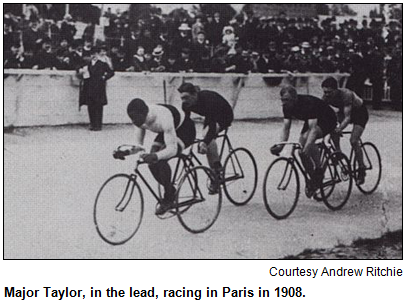 Despite achieving wealth - and meeting the kings and queens of Europe - Major Taylor (1878-1932) died in poverty and was buried in a grave without a marker.
Despite achieving wealth - and meeting the kings and queens of Europe - Major Taylor (1878-1932) died in poverty and was buried in a grave without a marker.
This show about one of the first African-Amerian athletes to become famous around the world kick-starts our salute to Black History Month.
Nelson is joined in studio by guests including Kisha Tandy, assistant curator of social history at the Indiana State Museum, which has an extensive collection of Major Taylor artifacts. They include lettters, rare photos, postcards and nine scrapbooks kept during his heyday by family members.
Kisha has been the local escort for Major Taylor's descendants, who live in Massachusetts but have visited sites in Indy connected with their legendary ancestor. Those sites include a historic marker erected on the Monon Trail near East 38th Street, the location of a bygone track where Taylor had been banned after setting a record.
Of course, the best-known Hoosier site named in honor of the former world champion is the Major Taylor Velodrome, a cycling track on Indy's westside. Built for $2.5 million, the velodrome opened in 1982 and helped accelerate belated recognition for Taylor, who died in obscurity in the charity ward of a Chicago hospital.
Our studio guests also include:
- Judy Keene, an Indy-based editor and writer who, beginning in the 1970s when Major Taylor's triumphs had been forgotten, started writing articles about the athlete who once had been internationally acclaimed. Judy also did local research for California-based author Andrew Ritchie, whose biography Major Taylor: The Extraordinary Career of a Champion Bicycle Rider (Johns Hopkins University Press), helped call belated attention to the cyclist.
- And Keith Cruz, organizer of Indiana Bicycle Polo Cooperative.
Coincidentally, Keith and his family live in a 100-year-old house in the Mapleton-Fall Creek neighborhood of Indy that sits on the site of the bygone Newby Oval, a spectacular track that was said to be matched only by Madison Square Garden in New York City for excellence as a bicycle racing venue. Major Taylor competed at the Newby Oval in 1898, 1899 and 1900.
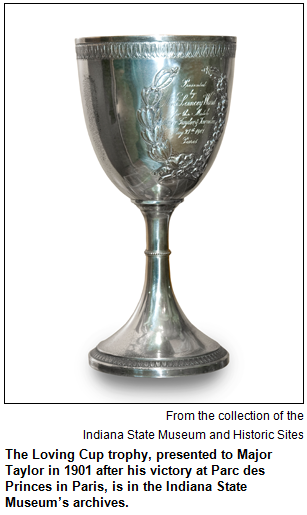 Taylor was just 16 when he won his first significant race, in 1895, even though spectators yelled racial slurs as he pedaled the 75 miles from downtown Indy (the route took the cyclists northbound up Massachusetts Avenue) to the Grant County town of Matthews.
Taylor was just 16 when he won his first significant race, in 1895, even though spectators yelled racial slurs as he pedaled the 75 miles from downtown Indy (the route took the cyclists northbound up Massachusetts Avenue) to the Grant County town of Matthews.
During that era, many bicycle tracks in Indiana were open to whites only. Even when Major Taylor was setting world records in other countries, he was not spared from prejudice. Gangs of white cyclists often worked together during races to box him in or force him to wreck. In many American cities on the racing circuit, he had to hunt to find places to eat and sleep.
In addition to exploring Major Taylor's dramatic life, Nelson and his guests also will delve into the Newby Oval and other Hoosier cycling venues and competitions during an era before the ascendancy of the car, when bicycle racing was a wildly popular sport.
The northeast turn of the Newby Oval is now the site of Keith's house. A year-round bicycle commuter, Keith works as a designer and draftsman in the parks and greenway department of BF&S, a civil engineering firm.
Major Taylor, whose father was a Civil War veteran, was born in rural Marion County. (According to foklore, his "Major" nickname derived from his habit, beginning at 13, of wearing a military cap and uniform while performing bicycle tricks on local sidewalks.)
He moved to Massachusetts in 1896, seeking greater opportunities with sponsors and on the bicycle race circuit. Taylor reaped national, then international, fame, competing everywhere from France to Australia and winning the world sprint championship in 1899.
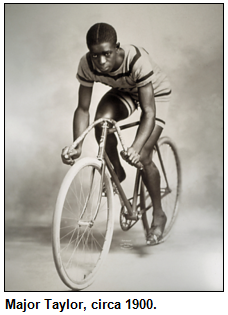 Throughout his life, Taylor, known as the "Ebony Streak," refused to compete on Sundays because of his promise to his mother to "lead an upright Christian life."
Throughout his life, Taylor, known as the "Ebony Streak," refused to compete on Sundays because of his promise to his mother to "lead an upright Christian life."
Unfortunately, he confronted almost overwhelming problems, particularly once Americans rapidly lost interest in bicycle racing with the popularity of cars. A combination of factors, including bad financial investments and a divorce, left him destitute.
When he died in 1932, Major Taylor was buried in an unmarked pauper's grave in Chicago. (Years later, a bronze tablet was erected in a ceremony organzied by Frank Schwinn of the Schwinn Bicycle Company, who never forgot Taylor's heroics.)
Long before then, the Newby Oval had been torn down. Built on 15 acres near 30th Street and east of Central Avenue, the quarter-mile track had cutting-edge electrical lights and grandstand seats; it regularly drew crowds of nearly 20,000 bicycle racing fans.
But the track's developer, Arthur Newby, eventually joined partners who were car enthusiasts, including Carl Fisher and Jim Allison, to focus on the new Indianapolis Motor Speedway.
Some recommended "learn more" websites:
- Andrew Ritchie blog.
- Indiana Historical Bureau.
- Major Taylor Association.
- Historic Indianapolis article Biking Indianapolis, 1899 by Nathan Bilger.
Roadtrip: Love Your Heart/You Are There 1939: Healing Bodies
With Roadtripper Chris Gahl of Visit Indy out on assignment, our guest Roadtripper will be statuesque Amy Lamb of the Indiana Historical Society. On the heels of Valentine's Day and in celebration of American Heart Month, Amy will tell us about the "Love Your Heart" program on Saturday, Feb. 16, at the Eugene and Marilyn Glick Indiana History Center in downtown Indianapolis. Free admission will be offered to guests, and the day includes presentations and heart-healthy activities.
To learn more about early heart health in Indianapolis, guests will also be able to step back in time with You Are There 1939: Healing Bodies, Changing Minds to learn the story of Dr. Harvey Middleton, a black physician who was one of Indianapolis' early heart specialists.
"Love Your Heart" at IHS is a program of 2013 Indy Talks, which has the theme of Indy's Kids. IHS's daylong program will focus on heart and general health - especially for youths. Other participants will include the JCC with presentations about food choice, and energizing and educational activities will be offered by IUPUI's Schools of Physical Education and Tourism Management. Kroger also will be on hand to offer healthy food samples.
History Mystery
In the three "B" sports that captivated Americans from the 1890s through the 1920s - baseball, bicycle racing and boxing - Indianapolis was the hometown of two African-American superstars. Bicycling champion Major Taylor was the first to attain fame.
The other athlete was a baseball star - a slugger, pitcher and outfielder in the early era of the Negro Leagues who became known as "the black Babe Ruth."
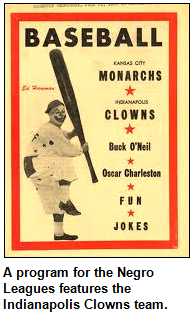 Beginning in 1915, his rookie year with the Indianapolis ABCs team, he spent 33 seasons playing for or managing various Negro League teams. Several baseball analysts have called him one of the greatest players who ever lived, although his achievements are hard to pin down because early record-keeping in the Negro Leagues was sketchy.
Beginning in 1915, his rookie year with the Indianapolis ABCs team, he spent 33 seasons playing for or managing various Negro League teams. Several baseball analysts have called him one of the greatest players who ever lived, although his achievements are hard to pin down because early record-keeping in the Negro Leagues was sketchy.
After a stellar career as a player, the Indy native became the manager in the 1930s of the Pittsburgh Crawfords, a team considered one of the greatest in Negro Leagues history. Later in life, the former player returned to his hometown to manage the Indianapolis Clowns.
Question: Who was the Indy native who became an early superstar of the Negro Leagues?
This week's prize is two tickets to the James Whitcomb Riley Museum Home and two tickets to the Indiana Experience at the Eugene and Marilyn Glick Indiana History Center. These prizes are courtesy of Visit Indy.
Pioneer music in early Indiana
 (Jan. 26, 2013) - The jaw harp was popular. So were the fiddle and dulcimer. Community bands played flutes, whistles and drums.
(Jan. 26, 2013) - The jaw harp was popular. So were the fiddle and dulcimer. Community bands played flutes, whistles and drums.
There even were pianos before 1840 in Indiana, despite the significant challenges of transporting them to frontier communities via horse-drawn vehicles and river boats.
Musical instruments that weren't widely seen (or, in some cases, not present at all) in the Hoosier state of the 1820s, '30s and '40s: the guitar, banjo, harmonica, mandolin, ukulele and accordion.
"Keep in mind that, during the pioneer era, Mozart had not been dead for as long as Buddy Holly has been gone today," says Erik Peterson, an Indianapolis-based musician and historian who has performed at Prairietown at Conner Prairie Interactive History Park and at other history-focused sites.
Erik has been researching pre-1840 music of central Indiana for a postgraduate degree, thanks in part to a fellowship from the Society of Indiana Pioneers. Adept at various instruments, Erik often performs traditional Irish, American folk and Celtic music with various ensembles, including Hogeye Navvy, an Indy-based band known for sea chanteys.
To share insights about the music cherished by early Hoosier settlers - and to perform a few musical interludes to convey a flavor - Erik joins Nelson in studio for what is certain to be a lively, memorable show. Erik has been gaining insights by tracking down diaries, letters and journals of pioneer families.
"People in that era were incredibly musical," he says. "Music was a daily part of their lives, and it served as a way to build community among neighbors."
 The jaw harp, a hand-held instrument about the size of a harmonica, was played frequently. Erik, who notes that the jaw harp primarily is relegated today to the soundtracks of cartoons, will play a rendition on the instrument during our show.
The jaw harp, a hand-held instrument about the size of a harmonica, was played frequently. Erik, who notes that the jaw harp primarily is relegated today to the soundtracks of cartoons, will play a rendition on the instrument during our show.
"The fiddle was the king of instruments here during the pioneer era," he says. "It's loud, and it's portable."
According to Erik, reliable accounts indicate the presence of a piano in Switzerland County in 1814, two years before Indiana even became a state. The extraordinary effort undertaken to transport pianos here decades before railroads underscores the importance of music in the lives of pioneers. Many towns in early Indiana, Erik notes, even had community bands.
Like later generations, early settlers differed along gender lines when playing musical instruments. But the gender preferences often were reversed from those that unfolded later, Erik says. Many men tended to play flutes and violins, while women played guitars and banjos once they finally made their way to Indiana, primarily after the Civil War.
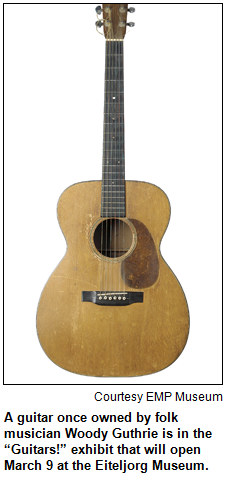 Before that, advertisements for academies such as the Indianapolis Female Institute touted instruction in piano for young women.
Before that, advertisements for academies such as the Indianapolis Female Institute touted instruction in piano for young women.
In analyzing journals and letters of early settlers, Erik has combed through the extensive diaries of Calvin Fletcher, an attorney, banker and civic leader in Indianapolis. Fletcher (1798-1866) wrote about hearing an Irish bagpiper in the Hoosier capital early in the city's history. Fletcher moved to the newly developing city during the 1820s.
During our show, Erik will play a few verses of a song that would have been played frequently in early Indiana: Hail, Columbia!, the unofficial national anthem of the era. (The Star Spangled Banner was not adopted as the official national anthem until 1931, about 100 years after the era that will be the focus of our show. Since then, Hail, Columbia! primarily has been played to introduce the American vice president.)
In addition to researching Indiana pioneer music for a master's degree at IUPUI, Erik is serving as a historical music consultant for an upcoming "Guitars: Roundups to Rockers" exhibit at the Eiteljorg Museum. He also has worked at the Children's Museum.
Erik also recommends the following "learn more" websites:
- There are a few pages on the history of the banjo. Music Folk, a guitar shop in St. Louis, has a nice and readable summary.
- About.com's music education project has a pretty good page on the history of Hail, Columbia!, as well as a sound sample of its melody.
- There are pages upon pages of material on music from the Civil War, but the University of Houston's Digital History project has one of the few summaries of pre-Civil War American music. UNC-Pembroke also has a page on the subject.
Roadtrip: Hiking and history in Delphi
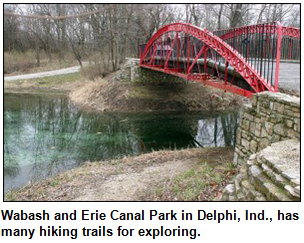 With Roadtripper Chris Gahl of Visit Indy really on the road this week, our Guest Roadtripper will be the glorious Glory-June Greiff, Indianapolis public historian. She has made the day trip more than once up to the old canal town of Delphi in Carroll County, which is about 15 miles northeast of Lafayette.
With Roadtripper Chris Gahl of Visit Indy really on the road this week, our Guest Roadtripper will be the glorious Glory-June Greiff, Indianapolis public historian. She has made the day trip more than once up to the old canal town of Delphi in Carroll County, which is about 15 miles northeast of Lafayette.
There's plenty of hiking and history at the Wabash and Erie Canal Park in Delphi, which is open year-round and includes an Interpretive Center, lots of trails for hiking and biking, and canal boat rides (in season, however!).
Don't miss the Latrrope and Ruffing Opera House and adjacent shops. Glory-June also has an eye for great small-town restaurants; she says Delphi has the Stonehouse Restaurant and Bakery, and for your dining pleasure either coming or going, there is Treece Restaurant in Rossville. If you go, tell them Hoosier History Live! sent you!
History Mystery
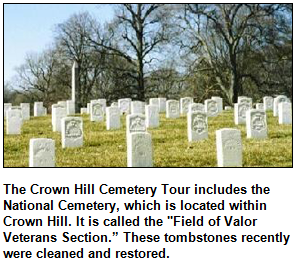 Harps of all kinds are built in a factory that has become a tourist attraction in a small Indiana town. Located in a former speakeasy, the factory building also includes a venue for concerts of harp music. The family-owned business makes instruments ranging from large symphonic harps to smaller harps, which they call "harpsicles," that are made in an array of colors. The former speakeasy-turned-harp factory is located on Main Street in its scenic hometown.
Harps of all kinds are built in a factory that has become a tourist attraction in a small Indiana town. Located in a former speakeasy, the factory building also includes a venue for concerts of harp music. The family-owned business makes instruments ranging from large symphonic harps to smaller harps, which they call "harpsicles," that are made in an array of colors. The former speakeasy-turned-harp factory is located on Main Street in its scenic hometown.
Question: Name the Indiana town.
This week's prize is two tours of Crown Hill Cemetery presented by Crown Hill Heritage Foundation, and two tours of the Benjamin Harrison Presidential Site. These prizes are courtesy of Visit Indy.
L.S. Ayres & Company history
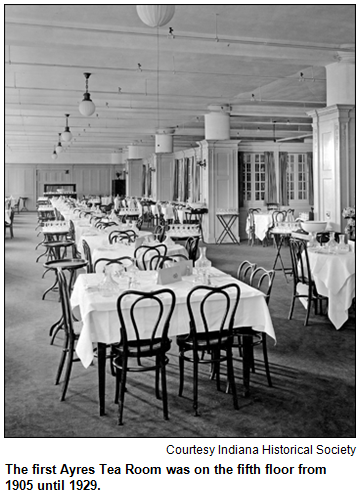 (Jan. 19, 2013) - The marketing slogan for its women's fashions: That Ayres Look. The eighth-floor dining spot beloved by generations: The Ayres Tea Room. The signature dish: Chicken velvet soup.
(Jan. 19, 2013) - The marketing slogan for its women's fashions: That Ayres Look. The eighth-floor dining spot beloved by generations: The Ayres Tea Room. The signature dish: Chicken velvet soup.
The holiday-season attractions: The lavish display windows and the Santaland Express children's train. The exterior landmark: The clock, which still perches in downtown Indy above the sidewalk at Meridian and Washington streets, once the site of the flagship L.S. Ayres & Company store.
Here's how a new, lavishly illustrated book sums up the impact of the legendary retailer on Hoosiers for more than 100 years: "Ayres was as much a part of Indianapolis as Monument Circle or the Indianapolis 500."
Ken Turchi, who has devoted years to researching and writing L.S. Ayres & Company: The Store at the Crossroads of America (Indiana Historical Society Press), joins Nelson in studio to explore all aspects of the company that grew to include Ayres department stores in suburban Indy neighborhoods such as the Glendale area, as well as in Fort Wayne, Muncie, Bloomington, Terre Haute and other Indiana cities. Ayres also opened chains of retailers such as Ayr-Way discount stores and Sycamore Shops, which catered to youthful preppies.
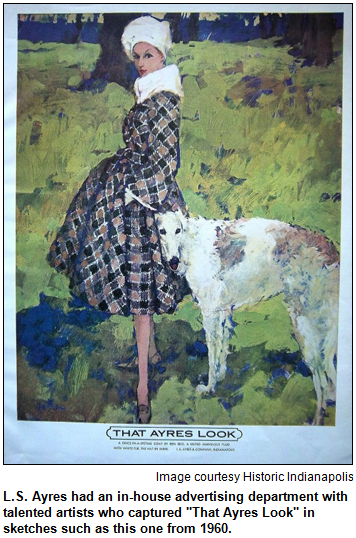 With origins dating to 1872, when founder Lyman S. Ayres Sr. acquired a controlling interest in a dry-goods store called the Trade Palace in Indy, L.S. Ayres & Company (this link includes Ayres Storybook and Magic Mirror videos) was overseen by three generations of family members.
With origins dating to 1872, when founder Lyman S. Ayres Sr. acquired a controlling interest in a dry-goods store called the Trade Palace in Indy, L.S. Ayres & Company (this link includes Ayres Storybook and Magic Mirror videos) was overseen by three generations of family members.
As our guest Ken Turchi puts it, they "took the store from its early silk-and-calico days to a diversified company with interests in specialty stores and discount stores - before Target and Wal-Mart."
The Trade Palace had just 27 employees when Lyman S. Ayres Sr. acquired control. By 1922, more than 2,000 employees worked for his son, Frederic Ayres, in Indianapolis. According to Ken Turchi's book, both Lyman Sr. and Frederic were modest, work-focused men who shunned the limelight and treated their employees with a nurturing style.
Lyman Sr., who had been a retailer in Geneva, N.Y., before moving to Indy, died in 1896. At that point, the opening of a department store at the corner of Meridian and Washington. an intersection then known as the "crossroads of America," was a dream. (The initial Ayres store was located elsewhere on Washington Street.) Frederic oversaw building of the flagship store, which opened in 1905 amid great fanfare.
The store's commitment to women's fashion gave Ayres, as our guest Ken Turchi puts it, "the same cachet as its larger competitors in New York and Chicago."
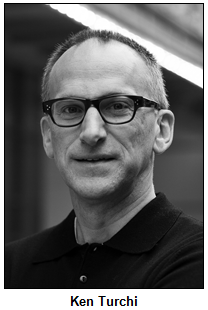 Ken, a former board member of Indiana Landmarks, grew up in Crawfordsville, worked at an Ayres store while attending college and has spent most of his career in aspects of marketing and strategic planning. Today he lives in Indy and commutes to Bloomington, where he is the assistant dean at the Indiana University Maurer School of Law. His home, built in 1954 in the northside Indy neighborhood of Arden, was featured on last June's Mid-Century Modern Home Tour. It is decorated with photos and memorabilia from Ayres and its major competitor, the locally owned William H. Block department-store chain.
Ken, a former board member of Indiana Landmarks, grew up in Crawfordsville, worked at an Ayres store while attending college and has spent most of his career in aspects of marketing and strategic planning. Today he lives in Indy and commutes to Bloomington, where he is the assistant dean at the Indiana University Maurer School of Law. His home, built in 1954 in the northside Indy neighborhood of Arden, was featured on last June's Mid-Century Modern Home Tour. It is decorated with photos and memorabilia from Ayres and its major competitor, the locally owned William H. Block department-store chain.
He describes the flagship Ayres as "a traditional department store where you could spend the day browsing for everything from furniture to sheet music to sewing machines to typewriters."
In many ways, though, Ayres was more than just a store, Ken writes. "It was an experience."
During the 1980s, Ayres was acquired by May Company. A series of local blows followed, beginning with the closing of the Tea Room and the Top of the Stairs restaurants in the flagship Ayres store in the early 1990s. In 1991, the May Company announced that Ayres would not be part of the planned Circle Centre mall, which then was in a fragile state of development.
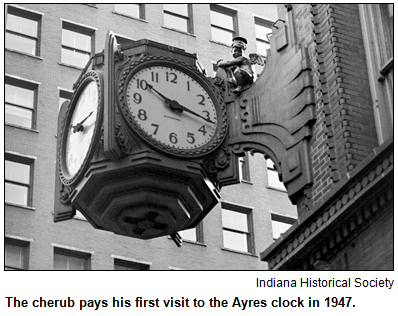 By the mid-2000s, the Ayres name had vanished from retailing after a local presence of more than 100 years. A portion of the sprawling, flagship Ayres building is now Carson Pirie Scott in Circle Centre, although the landmark clock continues to adorn the exterior. Part of Oceanaire restaurant is in the area where Ayres kept men's designer suits.
By the mid-2000s, the Ayres name had vanished from retailing after a local presence of more than 100 years. A portion of the sprawling, flagship Ayres building is now Carson Pirie Scott in Circle Centre, although the landmark clock continues to adorn the exterior. Part of Oceanaire restaurant is in the area where Ayres kept men's designer suits.
Some fun facts:
- The "S" in L.S. Ayres actually was an abbreviation for nothing, according to Ken's book. He quotes the founder's great-granddaughter, Indianapolis civic leader Nancy Ayres, as revealing that the family patriarch did not have a middle name and created an "S" because "a store called L. Ayres wouldn't look or sound right."
- The Ayres clock was designed by Kurt Vonnegut Sr., father of the famous novelist, and was installed in the 1930s. Decades earlier, the architectural firm of Kurt Sr.'s father, Bernard Vonnegut , had designed the Ayres building.
- Fashion models strolled among diners in the Tea Room, a popular destination for well-dressed women and children, who could pick out a toy from a treasure chest when exiting.
Roadtrip: Henry Louis Gates Jr. to speak in Kokomo Jan. 25
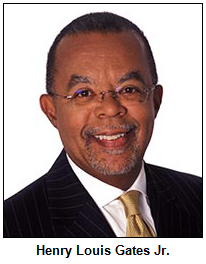 Chris Gahl of Visit Indy suggests that we take the Roadtrip to Kokomo to hear a presentation about genealogy titled "Finding your Roots." The speaker is the acclaimed Harvard professor, author and literary critic, Dr. Henry Louis Gates Jr., who also is host of the popular PBS television series Finding Your Roots.
Chris Gahl of Visit Indy suggests that we take the Roadtrip to Kokomo to hear a presentation about genealogy titled "Finding your Roots." The speaker is the acclaimed Harvard professor, author and literary critic, Dr. Henry Louis Gates Jr., who also is host of the popular PBS television series Finding Your Roots.
This event commemorates the celebration of Ivy Tech Community College's 50th anniversary on March 15, 2013. Tickets for this event are available online at the Ivy Tech website.
While in Kokomo, you can also take the Wildcat Creek Walk of Excellence, which winds its way through several of Kokomo's city parks and historic areas. Auto buffs can also visit the Kokomo Automotive Museum, which houses more than 100 classic cars, including the first gasoline-powered car built in 1894 by Kokomo native Elwood Haynes.
History Mystery
Beginning in 1919, Fort Wayne residents patronized an upscale department store that became the equivalent of L.S. Ayres for shoppers in the state's second-largest city. Generations of Fort Wayne families enjoyed the store's holiday season windows and visited Santa Claus in the downtown retailer.
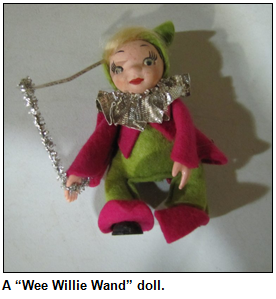 The store's Christmas mascot was a four-inch Wee Willie Wand doll, according to Ken Turchi's new book. In addition to the flagship store in downtown Fort Wayne, the retailer eventually opened a store in the city's Southtown Mall.
The store's Christmas mascot was a four-inch Wee Willie Wand doll, according to Ken Turchi's new book. In addition to the flagship store in downtown Fort Wayne, the retailer eventually opened a store in the city's Southtown Mall.
But Indianapolis-based L.S. Ayres, a competitor, opened a large branch store in Glenbrook Shopping Center on the north side of Fort Wayne in 1966. About three years after that, Ayres went a step further and bought the Fort Wayne stores run by the beloved retailer.
Question: Name the department store that, for more than half a century before its purchase by Ayres, was cherished by generations of Fort Wayne shoppers.
This week's prize is admission for two to the Eiteljorg Museum, two admissions to the Indiana Experience and two admissions to the Crispus Attucks Museum. These prizes are courtesy of Visit Indy.
A Hoosier amid the British royals
(Jan. 12, 2013) - How did a slice of Queen Elizabeth II's childhood birthday cake from the 1920s end up in the home of a Hoosier? How did he witness the post-wedding kiss on the balcony between Prince William and Duchess Kate?
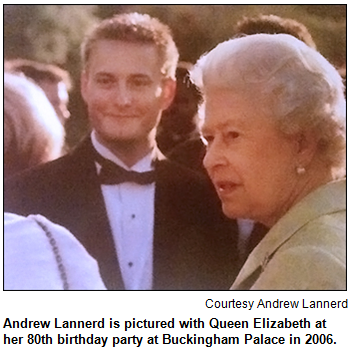 And how has Andrew Lannerd, general manager of the Indianapolis Symphonic Choir, been able to mingle with the royals at Buckingham Palace garden parties, present the queen with bouquets of flowers, speak to her half a dozen times and see her on about 40 occasions?
And how has Andrew Lannerd, general manager of the Indianapolis Symphonic Choir, been able to mingle with the royals at Buckingham Palace garden parties, present the queen with bouquets of flowers, speak to her half a dozen times and see her on about 40 occasions?
Fresh from spending the holiday season in England - where he stays near Sandringham Estate, the country retreat where the royal family is in residence for Christmas - Andrew joins Nelson in studio to share insights, anecdotes and the links between this young, energetic Hoosier and the world-famous Brits.
An avid collector of all things royal, Andrew estimates he owns about 500 books about British monarchs, plus countless artifacts and curiosities such as the birthday cake, a marble bust from 1860 of Queen Victoria and a chair from Queen Elizabeth's coronation in 1952.
A couple of years ago, Andrew even lived in London and did commentary on royal-themed tours.
He's been the general manager of the 150-voice Indianapolis Symphonic Choir since 2010. Andrew, a native of Anderson, Ind., also enjoyed a five-year stint as house manager for the Indianapolis Symphony Orchestra.
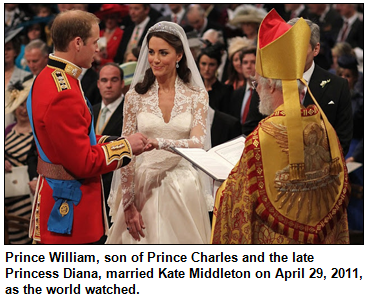 As a fund-raiser for the symphonic choir, he will lead a group of Hoosiers on a "Britten in Britain Tour" to celebrate the 100th anniversary of the birth of English composer Benjamin Britten. The travelers from Indiana also will enjoy special visits to sites associated with the royals. (For more details about the tour, visit indychoir.org).
As a fund-raiser for the symphonic choir, he will lead a group of Hoosiers on a "Britten in Britain Tour" to celebrate the 100th anniversary of the birth of English composer Benjamin Britten. The travelers from Indiana also will enjoy special visits to sites associated with the royals. (For more details about the tour, visit indychoir.org).
Even though well-known protocol is involved when interacting with the royals - "you never extend your hand to the queen," Andrew notes - he emphasizes the royals are far from stuffy.
"Queen Elizabeth has a great sense of humor," he says. "She has a wonderful way of putting people at ease."
He's fond of all of the royals, including Queen Elizabeth's husband, Prince Philip, who has a reputation as cold.
"He's just no-nonsense," replies Andrew, who was seated near Prince Philip and his son, Prince Charles, during a historic service at Westminster Abbey in November 2011. The event, with the Archbishop of Canterbury presiding, celebrated the 400th anniversary of the King James Bible.
"History came to life for me there," Andrew says.
The Hoosier's interest in British nobility was sparked by news coverage of the tragic death of Princess Diana in 1997. He began collecting memorabilia and traveling to England.
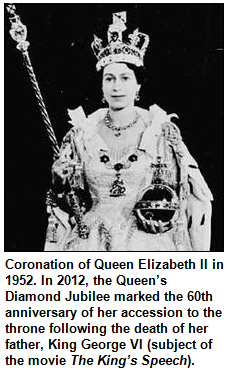 Some of his entrees to exclusive events have unfolded because he has established and nurtured contacts within the royal household and staff. Others have come because Andrew camped outdoors to get the perfect vantage point to observe proceedings such as the post-nuptials kiss between William and Kate.
Some of his entrees to exclusive events have unfolded because he has established and nurtured contacts within the royal household and staff. Others have come because Andrew camped outdoors to get the perfect vantage point to observe proceedings such as the post-nuptials kiss between William and Kate.
During Queen Elizabeth's visit to the United States in 2009, Andrew arranged to present her a bouquet when she toured the historic settlement of Jamestown, Virginia. (Jamestown, the first English settlement in what became the United States, was celebrating its 400th anniversary.)
In addition to a slice of the Queen's cake from her second birthday in 1928 - as well as cake from the wedding of her daughter, Princess Anne, in 1972 - Andrew's vast collection of artifacts includes:
- Gloves owned by Wallis Warfield Simpson, the American divorcee for whom Prince Edward, the Duke of Windsor, abdicated the throne in 1936.
- Dozens of documents and letters signed by various royals.
- A chair from the coronation of Queen Elizabeth in 1952.
Andrew's first visit to England and interaction with nobility was in 2001.
"It was," he says, "magic."
Roadtrip: Jackie Robinson play premieres at IRT
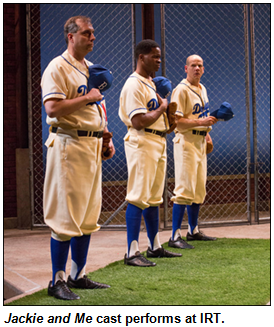 Chris Gahl of Visit Indy suggests that we take the Roadtrip to the Indiana Repertory Theatre in downtown Indy to check out a compelling new play about Jackie Robinson, the first African-American baseball player to play in the major leagues. Jackie and Me, written by Steven Dietz, is based on the popular young adult novel by Dan Gutman. In this theatrical presentation, a young boy's school report on Jackie Robinson finds him traveling back in time to meet one of the most influential baseball players in history. Now through Feb. 16.
Chris Gahl of Visit Indy suggests that we take the Roadtrip to the Indiana Repertory Theatre in downtown Indy to check out a compelling new play about Jackie Robinson, the first African-American baseball player to play in the major leagues. Jackie and Me, written by Steven Dietz, is based on the popular young adult novel by Dan Gutman. In this theatrical presentation, a young boy's school report on Jackie Robinson finds him traveling back in time to meet one of the most influential baseball players in history. Now through Feb. 16.
History Mystery
Queen Elizabeth's second son, Prince Andrew (the Duke of York), came to Indiana in 2002. He visited the Hoosier state as part of the festivities leading up to a major sporting event. Prince Andrew, a former helicopter pilot, did not stay for the actual sports competition. But he visited businesses and helped build excitement for the upcoming sports event, which had many European competitors.
Question: What was the sports competition?
Hint: It's no longer held in Indiana.
This week's prize is a gift certificate to Mikado Japanese Restaurant in downtown Indianapolis, courtesy of Visit Indy.
By the way, you'll notice that our questions are getting a little more difficult. Why? Because the number of listeners and fans is steadily increasing (as well as the number of visits to our website), so there is a larger pool of listeners who are well-versed in Indiana history!
Sharing memories in captivating ways
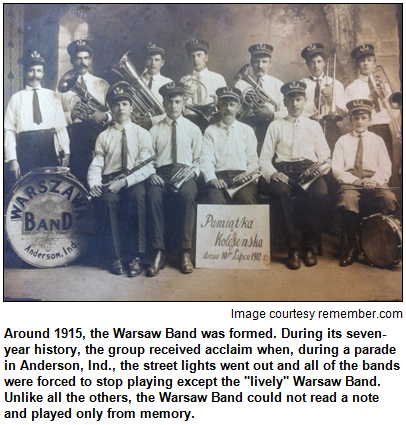 (Jan. 5, 2013) - It's the dawn of a new year, and you have history - personal history - to share. But how do you package your memories and reflections in ways that will interest other people?
(Jan. 5, 2013) - It's the dawn of a new year, and you have history - personal history - to share. But how do you package your memories and reflections in ways that will interest other people?
This is the show for you, whether your memories are about Labor Day on Lake Monroe, the Pan Am Games of 1987, the Indianapolis Motor Speedway or the crowd sensations inside Lucas Oil Stadium during the Super Bowl last February. Click for more!
Memories about several of these places, milestones and events have been posted on remember.com, a website founded by two native Hoosiers that's intended to be a "global memory bank" for people to share common experiences.
One of the co-founders of remember.com, Indianapolis entrepreneur Jason Becker, joins Nelson in studio to offer tips and advice about how to spark interest among other people (particularly total strangers) in verbal snapshots of your experiences.
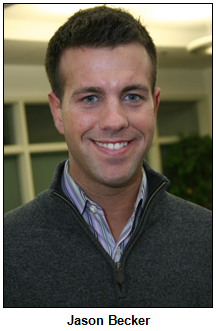 Another expert in studio on the topic of sharing memories is Lyn Jones, an assistant professor of English at Ball State University who has taught a wide range of Hoosiers - from at-risk youth to war veterans, mothers of children with disabilities and senior citizens - how to write memoirs. Lyn helped launch the Memoir Project at the Writers' Center of Indiana.
Another expert in studio on the topic of sharing memories is Lyn Jones, an assistant professor of English at Ball State University who has taught a wide range of Hoosiers - from at-risk youth to war veterans, mothers of children with disabilities and senior citizens - how to write memoirs. Lyn helped launch the Memoir Project at the Writers' Center of Indiana.
A sampling of Lyn's tips: Talk to someone who can help you cue a memory. And hunt up photos, objects and mementos that will help you remember.
Jason, a 2004 economics graduate of DePauw University, advises: "Re-immerse yourself totally in the experience, in what it felt like - what you saw, heard, smelled and felt."
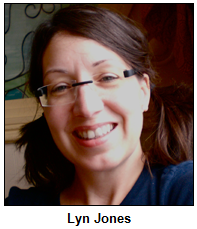 He shares some of the most compelling memories that have been posted on remember.com since its debut in 2010. If the collaborative memory website develops as planned, noted an article in the Indianapolis Business Journal, it could become "the one-stop kind of site (for memories) that Wikipedia is for knowledge or Facebook is for friends."
He shares some of the most compelling memories that have been posted on remember.com since its debut in 2010. If the collaborative memory website develops as planned, noted an article in the Indianapolis Business Journal, it could become "the one-stop kind of site (for memories) that Wikipedia is for knowledge or Facebook is for friends."
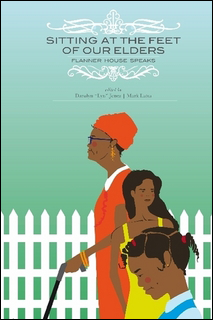 Jason founded remember.com with DePauw classmate Brandon Sokol, who grew up in Anderson, Ind., and now lives in New York City. The two co-founders are assisted on remember.com by about half a dozen friends and colleagues.
Jason founded remember.com with DePauw classmate Brandon Sokol, who grew up in Anderson, Ind., and now lives in New York City. The two co-founders are assisted on remember.com by about half a dozen friends and colleagues.
For the Writers' Center, our guest Lyn has been the co-editor of two anthologies of memoirs. They are Flanner House Speaks: Sitting at the Feet of our Elders and I Remember: Creative Writing by Indianapolis Youth. She also is the author of two editions of Painless Reading Comprehension.
"Memoir is the best search mechanism we are given," she notes. "Memoir is how we try to make sense of who we are, who we once were, and what values and heritage shaped us."
Jason, who has "day jobs" with two Indy-area software companies, says he has been surprised to notice that collaborative memorials - memories about people who have died - have become among the most popular entries on remember.com.
Whether writing a memorial or another type of short memory, he offers this suggestion: "Don't try to mimic someone else's voice. Do it in a way that's authentic to you."
Roadtrip: Cross-country skiing and sledding in Indy
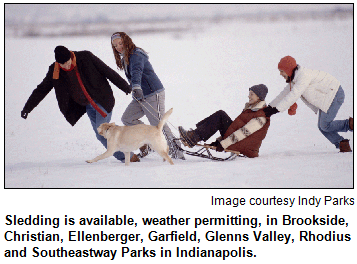 Chris Gahl of Visit Indy suggests that we take advantage of snow on the ground (though will it last?) to explore cross-country skiing and sledding opportunities in Indy. The Indy Parks website tells us that there is great skiing at Eagle Creek Park, Northwestway Park, Southeastway Park Trails, and of course on the Indy Park Greenways if conditions permit. Provide your own equipment.
Chris Gahl of Visit Indy suggests that we take advantage of snow on the ground (though will it last?) to explore cross-country skiing and sledding opportunities in Indy. The Indy Parks website tells us that there is great skiing at Eagle Creek Park, Northwestway Park, Southeastway Park Trails, and of course on the Indy Park Greenways if conditions permit. Provide your own equipment.
And remember, if you'd like to leave the Circle City and escape for a couple of snuggly winter nights, you can get “two nights for the price of one” at many of the state park lodges around the state through Feb. 28.
Winter is the perfect time for quietrelaxation! And if you do like snow, you can always look at the e-newsletter for last February's "Snow history with weatherman Chris Wright" show from the Hoosier History Live! archives.
History Mystery
A memoir by an Indiana-born entertainer begins with this quote: "Please, can I go home?"
She made the request to return to the Hoosier state for her father's funeral on the eve of her big break. As an 18-year-old in the early 1950s, she had been cast in the leading role in a national touring company of a popular musical.  The show was scheduled to open the next night, there was no understudy, and she had endured a complex relationship with her deceased father, an impoverished alcoholic.
The show was scheduled to open the next night, there was no understudy, and she had endured a complex relationship with her deceased father, an impoverished alcoholic.
Although the native Hoosier opens her memoir with the dilemma about her father's funeral - and despite other challenges that she recounts - she went on to achieve early success on Broadway, followed by a leading role in a TV series that has been seen in reruns almost continuously ever since its premiere more than 40 years ago.
Question: Name the entertainer from Indiana.
This week's prize is a gift certificate to MacNiven's Restaurant and Bar on Massachusetts Avenue in Indy, and two tickets to Benjamin Harrison Presidential Site, courtesy of Visit Indy.
By the way, you'll notice that our questions are getting a little more difficult. Why? Because the number of listeners and fans is steadily increasing, and there's a larger pool of listeners out there who are well-versed in Indiana history. When we started the show five years ago, we had to make the questions a lot easier so we wouldn't eat up a lot of air time with wrong answers!

